THE OFFICIAL PUBLICATION OF THE BERNESE MOUNTAIN DOG CLUB OF AMERICA

GCHS Swiss Stars Gun Fight At The OK Corral SIN CGC BG# 178937
Multi Group Winning/Placing
Wyatt
THE ALPENHORN
SPRING 2024 PUPPIES / ACTIVITIES / TRAINING
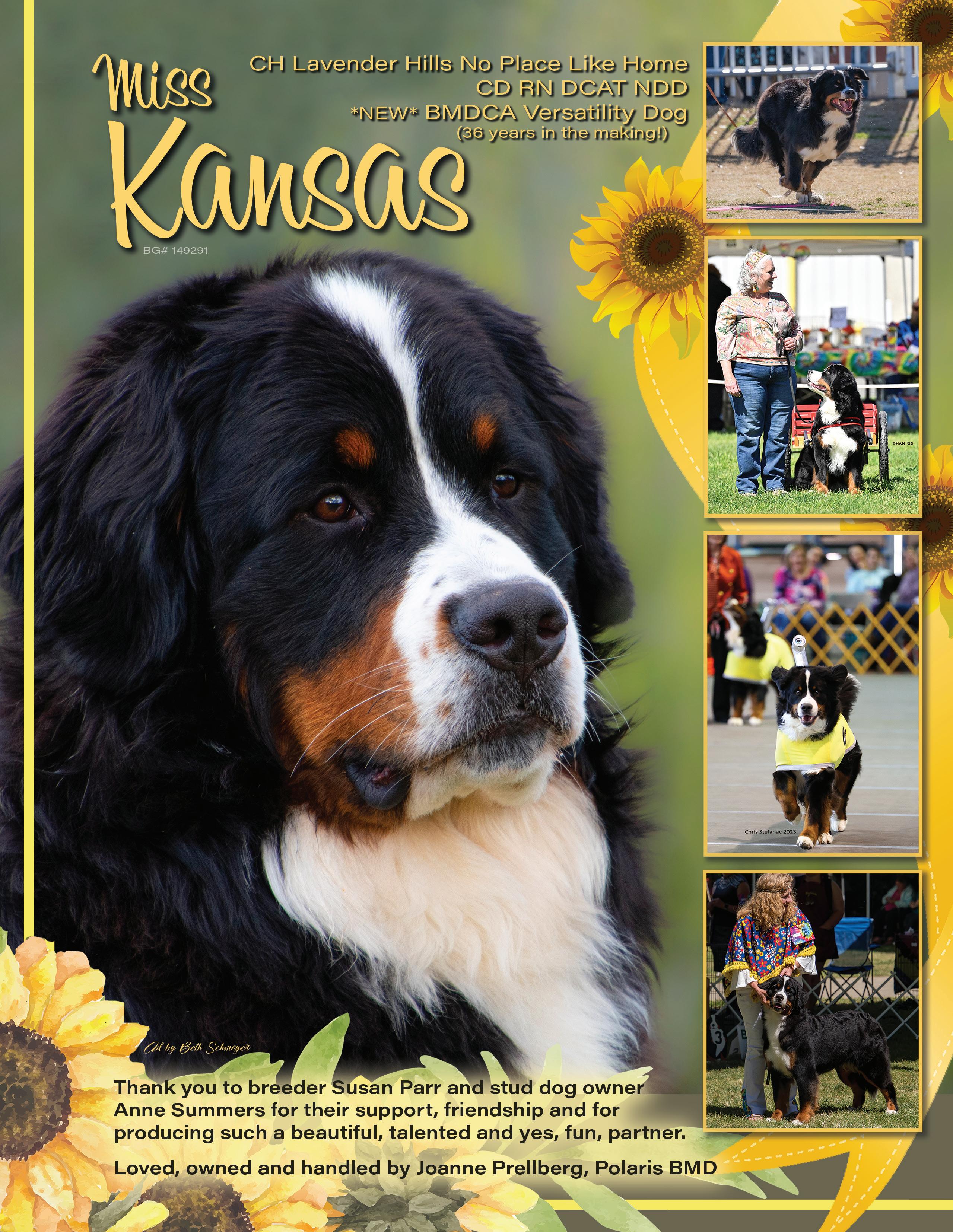
Thank you to our instructor, Beth Howland
Zanna Owner/Handler: Barb LeTourneau
Mangus Owner/Handler: Margaret Jezek
Moet Owner/Handler: Marti Simons
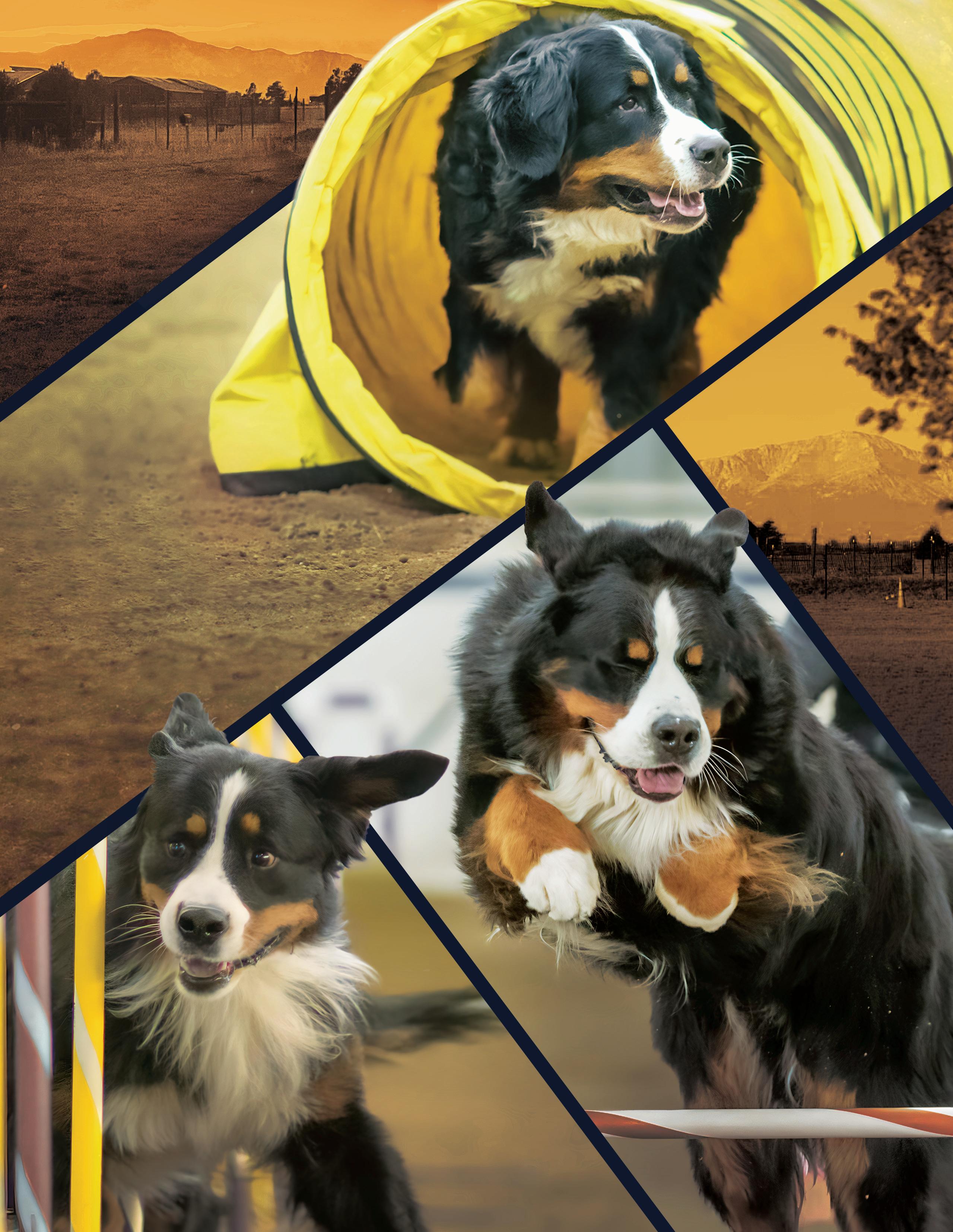
COLORADO BERNERS
HIT THE PEAK
ZANNA MOET MANGUS
GCH Jura’s American Beauty China Cat Sunflower RI CD PT NJP OAP SWN SEA HRD-1 TKI FDC RATN NDD AD VD WD GCH CH Mamemo’s Moet CD RA HT AXP AJP NFP CGC NDD ANBDD DD BDD GCh Ch Nashems Diamond In The Ruff TKI FDC PT RE HSAs CD SWN SIA SEA OAP XJP HRD-1s HTAD -1s
BG# 153904 BG# 154705 BG# 159118 TOP NOVICE AGILITY DOG TOP OPEN AGILITY DOG TOP EXCELLENT AGILITY DOG
DESIGNED BY MICHAEL PINEDA
THE ALPENHORN
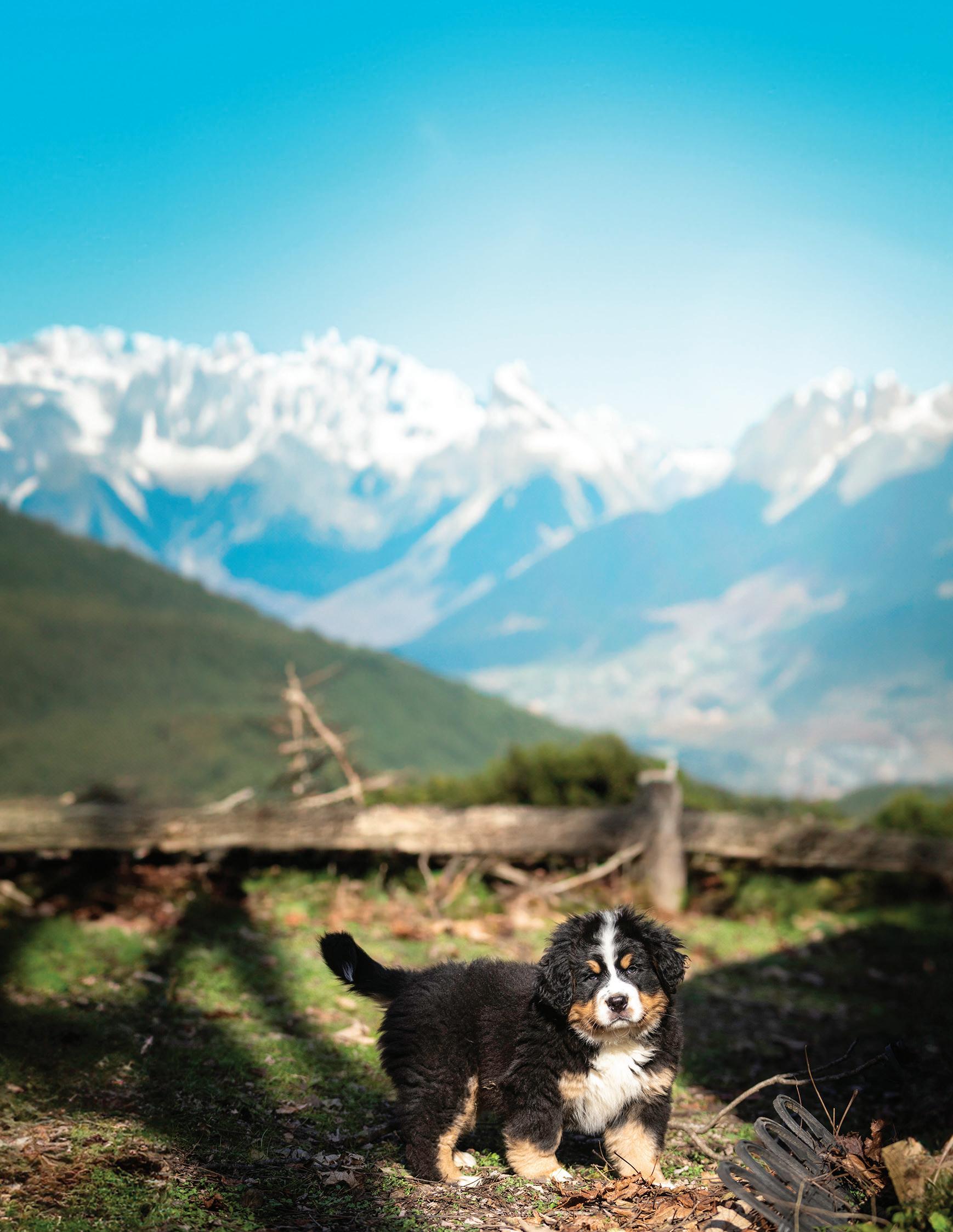
All content herein reflects the views of the authors or committees who prepared it and does not necessarily represent the official position of the BMDCA, the editors, or staff. Publication of advertising does not imply endorsement by the BMDCA or the editors. Neither the BMDCA nor its committees nor the individual authors make any warranties, expressed or implied, nor representations of correctness of any content including, but not limited to, methods of diagnosis or recommendations of treatment. None of the articles or information provided is in any way a substitute for appropriate professional veterinary medical care and treatment for your dog. The editors reserve the right to edit or refuse material. The Alpenhorn publishing decisions are subject to the discretion of The Alpenhorn staff and BMDCA Board. We do not accept anonymous editorial or advertising submissions. No portion of the magazine may be reprinted without prior written permission of the editors and proper credit to The Alpenhorn.
BRACIKOWSKI, MEMBERSHIP APPLICATIONS CHAIR
Patricia Marler Greenville, SC
Kayla Prunier Waltham, MA
Rose Gonzalez-Mashuk Cape Coral, FL
Lexie and Tim Lau Kaukauna, WI
Elizabeth Morris Covington, WA
Barrett and Barb Grath Arden, NC
Laurie Weigel Eagan, MN
Gaylynn Janzen
Tony Vollmer New Albany, IN
Huntersville, GA
Arlene Adrian Georgetown,
Mary and Roger Boltz Black Mountain, NC
Kim Ravida Groveland, MA
Julie Keller Muskego, WI
Samantha Judge George, VA
Raven Key Canton, OH
Candace Brewer Brooklyn, MN
Susan J. Schmidt Spokane, WA
Kim Groves Frankford, Ontario (CAN)
Tressina Manning Barnard, VT
Elizabeth Kinser Street, MD
Sue Dischner Tucson, AZ
Kristen Harman Puyallup, WA
WELCOME NEW BMDCA MEMBERS NEW MEMBERS
BY ANDREA
APPROVED
St.
Catherines, Ontario (CAN)
Erin Stephens
TX
ISSN 1946-2255 © 2024 Bernese Mountain Dog Club of America, Inc.
Lara Usilton
Sales and Design Beth Schmoyer Content Team Dee McDuffee, Content Manager Production and Subscription Manager Kim Caronia Magazine Design Michael Pineda Printer Modern Litho, Jefferson City, MO Business Manager Joye Neff
Photographers Editorial Assistants Stephanie Biksacky Jennifer Brightbill Robin Hamme Debra Jones Kim McIntyre Andrea Bracikowski Annette McLaughlin Annie McDannold Beth Schmoyer Blakely Dillard Charlotte Van Horn Chris Stefanac Clicking to Capture Dann Shively DanPearsonPhoto.com Dee McDuffee Ethel Robles Gail Garand Images by Kit Jerry Jackson Jessica Moore Jordan Fortier Kerri Montgomery Lara Usilton Laura Rose Humes Layal Bouaoun Lori Jodar Marg Geiger Mark Bogdan Photos by Elaine Robin Hamme Stacy Temples Susan Harrison Tatum Wenzel The Dog Sport Photographers Andrea Bracikowski Beth Brookhouse Robin Hamme Renee Meriaux Ruth Nielsen Georgeann Reeve Mary-Ann Sontag, Ph.D. Suzy Weibel Tom Atkian Adrienne Lee Joye Neff Dottie Tyson
Editor-in-Chief
Advertising
Contributing
4 ∙ THE ALPENHORN
BG# 71897
BG# 190014. Photo by Beth Schmoyer.
CORRECTIONS
Please note, the full title for Vasca, BG# 99065, in the senior section of the winter issue should have read: CH Keilissa’s Picking Up the Pieces, CGC RA CD FDC BMDCA Versatility and TDI with over 350 visits.
The BMDC of the Rockies and Southeastern Wisconsin results were incorrectly listed in the winter issue. The correct winners were:
BMDC OF THE ROCKIES #1
Best of Breed or Variety
Best of Opposite Sex
Select Dog
Select Bitch
Best of Winners
Best Owner-Handled in Breed or Variety
Winners Dog
Reserve Winner Dog
Winners Bitch
Reserve Winner Bitch
Best Junior
Best of Breed or Variety
Best of Opposite Sex
Select Dog
Select Bitch
Best of Winners
Best Owner-Handled in Breed or Variety
Winners Dog
Reserve Winner Dog
Winners Bitch
Reserve Winner Bitch
Best Junior
CH Powder Keg Farm's Commanche (D), P Young
GCHB CH Bernergarden's Point Break TD PT (B), C Toupin/C Carroll
GCH CH Lavish's Ragnar The Fearless L Bouaoun/C Petersen
GCH CH Red Rocks Into The Mystic HT FDC A Porter/S Karl
Canton Sur Quasar Berning Bright (D), S Dunaway/A Murphy Daily/D Sirabo
GCH CH Lavish's Ragnar The Fearless (D), L Bouaoun/C Petersen
Canton Sur Quasar Berning Bright S Dunaway/A Murphy Daily/D Sirabo
Sandbarr's Nose For Tennessee Whiskey S Hernandez/L Weakland
Brighteye The Biskit Eater D Hotze/G Hotze
Lavish's Spared No Expense L Bouaoun/M Eslick
Briella Godlevsky
GCH CH
M Dalzell/s dalzell/M Hommel
CH Nashem's Lone Sentinel At Sun
Smith/S Karl
GCHB CH Bernergarden's Point Break TD PT C Toupin/C Carroll
Zenith's Perfect Pearing Zephirin PT FDC CGC (B), B LeTourneau
GCH CH Blumoon's Long Black Veil CD BN CA CGC (B), N Galaba
Tanzanite's The Sky's No Limit L Homa
Hickory's A Kind Of Magic J Voelker/A Tucker
Zenith's Perfect Pearing Zephirin PT FDC CGC B Letourneau
Brighteye The Biskit Eater D Hotze/G Hotze
Briella Godlevsky
BMDC OF SOUTHEASTERN WISCONSIN #3 (D)
Best of Breed or Variety
Best of Opposite Sex
Select Dog
Select Bitch
Best of Winners
Best Owner-Handled in Breed or Variety
Winners Dog
Reserve Winner Dog
Winners Bitch
Reserve Winner Bitch
AKC PUPPY RESOURCES
GCHG CH Bernergardens Look To The Stars CD BN RE THD CGCA CGCU TKN (D), C Carroll/P Munter
GCHB CH Shersan's Prima Donna At Acclaim (B), C Kinley/B Kinley-Blewett
GCHB CH Wintergreen's Every Sailor's Dream BN CGC S VanOcker
GCHB CH Singing Sands A Song Of My Own A Carlson
Highland’s Racing to the Last Drop at Veritas RI BCAT CGC TKN (B), L Farrell
Washburn/B Cramer Hammann
GCHB CH Wintergreen's Every Sailor's Dream BN CGC (D), S VanOcker
Hugo Silna Druzyna C Matey/S Wolfgang Windfall's Triple X! K Hayko/M Knicely, DVM
Highland’s Racing To The Last Drop At Veritas RI BCAT CGC TKN L Farrell
Washburn/B Cramer Hammann
Long Lake Rudipitutti Garmischt M Komar
Looking for more information on raising and training a puppy? Check out the AKC’s website and sign up for the Pupdate newsletter and learn what those frenetic bouts of activity are all about!
https://www.akc.org/expert-advice/puppy-information/ https://www.akc.org/expert-advice/lifestyle/what-are-zoomies/
BMDC OF THE ROCKIES #2
GCH CH Blumoon's Long Black Veil CD BN CA CGC (B),N Galaba
Rainier's North Face Of Eiger CD RI AXP OJP CA CGC TKA (D),
RN PT FDC CGC TKN
Mountain
J Smith/M
SPRING 2024 ∙ 5

Our guest editorial belongs to new president Marjorie Geiger, but I couldn’t let this issue pass by without a heartfelt thank you to Beth Schmoyer. For over 15 years, Beth has used her creative talent, organizational prowess and endless tenacity to both sell and design hundreds of ads for The Alpenhorn. Her expertise and experience have been an immeasurable asset to the entire Alpenhorn team and her advice and friendship has been a godsend to me. Thank you for going above and beyond in service to the BMDCA and The Alpenhorn, Beth. We wish you nothing but success and happiness in your next pursuit!
Lara Usilton Editor-in-Chief
COMMON THREADS
BY MARG GEIGER
So, who is the new BMDCA President? I’m a farm girl at heart, raised in rural Michigan; the third daughter of two teachers with six brothers. As a family we were surrounded by animals. Some provided partnership and companionship, while others were raised for sustenance. The early lessons taught responsibility and appreciation for the gifts each animal provided. My name has always been misspelled because of its old fashioned roots. Although my formal name is Marjorie, I was taught to write using the informal Margie. Then, as a fifth grader, I shortened it to Marg. Unfortunately, most people shorten it to Marge or Marj. A happy twist of fate validated my spelling choice. Forty-five years ago I had the good fortune to marry a man whose name happened to start with “G.” I am Marjorie Ann Rogers Geiger. So, my initials spell Marg, my name. Margie works too.
Music education was important in my family, and I have played guitar and violin since childhood. I was introduced to dance when my young daughters were taking classes at a dance studio. I was there so much I became the receptionist and, when the studio became a dance company, I became the president. Love of movement grew into becoming a cheerleading coach and dance choreographer. Then I saw canine freestyle and realized music, dance and dogs could come together!
I love the excitement of choreographed obedience work set to music. Few things are more pleasing to my eye and heart. In addition to competing, I am a judge in the World Canine Freestyle Organization.
Individual commitment to a group effort — that is what makes a team work, a company work, a society work, a civilization work.
– Vince Lombardi
I am an AKC evaluator for the Canine Good Citizen, Trick Dog, Farm Dog and Attitude Temperament tests. I am a judge for Junior Showmanship and AKC’s newest sport, Fetch. I am an AKC ambassador and a Berner ambassador. I volunteered to teach freestyle at Berner University in 2013. I have been involved in Berner U ever since. That has been a happy niche and a passion because of my love of training and education.
Training is a rewarding and creative pursuit, and an extension of my formal degree, a Bachelor of Science in Education. Growing up on the farm gave me opportunities to start training very young. As an adult I have enjoyed attending seminars to improve tactics and strategies. However, my greatest growth, success and satisfaction came when I was introduced to clicker training. My first Berner girl, Noelle, was smarter and more determined than I was, and I was desperate to learn new ways to work with her. I found a trainer that was experimenting with clicker training. Learning the art of clicker communication opened many opportunities for my dog and me who participate in Obedience, Rally, Draft, Freestyle and Conformation.
The long cold Michigan winters of childhood gave me a love for the written word. I enjoy writing and have had the privilege of being published in The Reader’s Digest, The Journal of Hospital Librarianship and other professional publications. One of my recently published pieces, “A Dog’s View of Dog Training,” is a training memoir and resource compilation written by Noelle and me. She inspired me to write the lessons she helped me learn. My dogs are still training me and inspire me to write the Bernese Mountain Dog column for the AKC Gazette.
6 ∙ THE ALPENHORN
I have been active in dog clubs wherever I have lived. I was the president of Arizona White Mountain Kennel Club and Double Deuce Dancers, a canine freestyle club. While in the Carolinas I served on the board of the Piedmont Bernese Mountain Dog Club and was a member of the Piedmont Kennel Club. Currently, I am the vice president of the Longview Kelso Kennel Club and a member of the BMDC of Oregon. I am a member of two training clubs: the Portland Obedience Club and the Sherwood Dog Training Club.
In Kalama, I participate in our local General Federation of Women’s Club. It was established in 1912 and locally is called Amalak. I have the honor to say that I have been the president since 2020. The club assists on most big events in town. When the chief of police needs help with a dinner to raise money for Shop With A Cop, it is Amalak that steps in to serve. When the music program at the junior high needed a new piano, it was Amalak that put together a network of businesses to get a beautiful grand piano purchased and delivered. One of our essential contributions is scholarships to graduating seniors. I am one in a long line of committed women that cherish the community connections and take responsibility for encouraging cooperative projects.
The BMDCA has some similarities to my women’s club. Both clubs exist to support and create places and events for others to flourish. We join together for the good of our respective communities and companionship. The Berner club has the added difficulties of size and distance that separate us. Those issues are mitigated by the regional clubs. I look forward to this new area of service because Berner people are
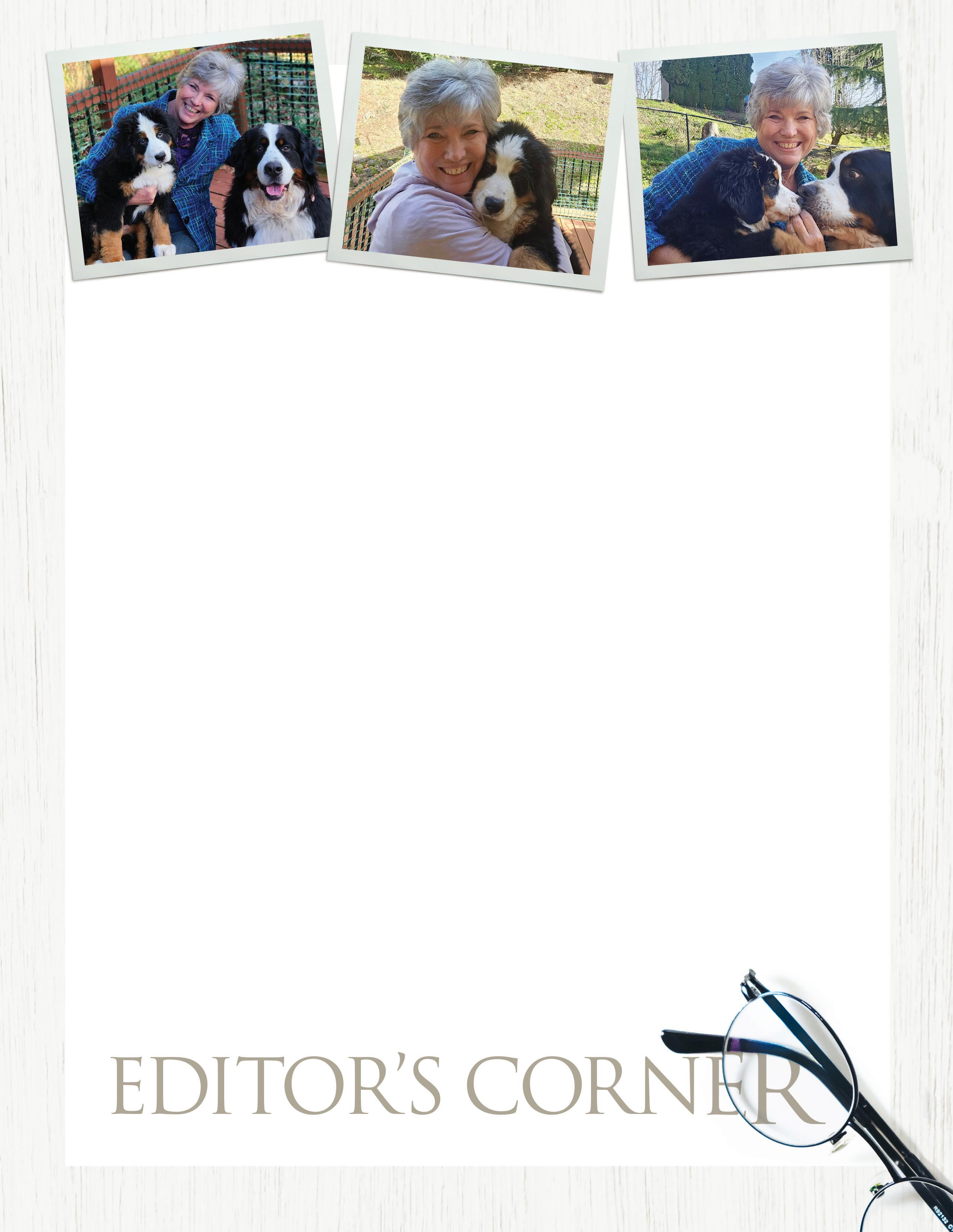
much like our dogs — willing to work, eager to communicate and ready for the next challenge.
That willingness is the element of the Berner community that is different from other groups. While in Show Low, Arizona my organizations flourished on fundraisers that relied on community donations. Soliciting donations with cold calls is frequently time consuming with multiple callbacks to talk with the right person. That was a norm I was familiar with. To my delight and surprise, I discovered that Berner people call back! When I call needing a donation of an object, time and talent Berner people respond. What a pleasure that discovery has been. Berner people want to help and use their skills.
What is your passion? There is a job within the club that needs your skills and passion. There are always chores to be done in an organization. One goal is to encourage established committee heads to recruit a mentee that can assist/job shadow and be groomed for succession. Less experienced members need friendship and encouragement so that they can step into roles when others are aging out. New and old together, it takes both to succeed. This is reminiscent of the children’s song, “make new friends, but keep the old, one is silver and the other gold.”
The common threads that weave through my life are community connections, teamwork and education. I am committed to the ideals of making connections and encouraging cooperation. The BMDCA fits those passions for me. The Berner network is a massive team. What team are you a part of? Where do you connect? There is always room for more on the Berner team. Together we’re stronger. Berner strong.
Marjorie with Deerpark Genesis (BG# 219950). Photo courtesy of Marg Geiger.
In the backyard with Marjorie, Deerpark Genesis (BG# 219950) and Algrand Berni Bond James Bond (BG# 156081). Photo courtesy of Marg Geiger.
SPRING 2024 ∙ 7
Marjorie with Deerpark Genesis (BG# 219950) and Algrand Berni Bond James Bond (BG# 156081). Photo courtesy of Marg Geiger.
IN THIS ISSUE
Lara Usilton with Layal Bouaoun, Lavish BMD
Blakely Dillard, Blakener BMD
Cranial Cruciate Ligament Disease and Rupture in Bernese Mountain Dogs
Conversation with Three Professional Trainers on Training BMDs and Choosing the Right Trainer for Your Dog
ESSENTIALS FEATURES SPRING 2024 | VOL 16 | NUMBER 2 | ISSN 1946-2255 14 Picking the
By
and
20 Backpacking
By Jessica Moore 22 Is
By Suzie Weibel 29 Is
35 Words
Series Top Winners 42 When
Understanding
By
58
By Kerri Montgomery 60
By Lara Usilton 66 To Flea or Not to Flea: Choosing Flea and Tick Protection By Susan Harrison, Ph.D. 72 Is your
Noise? An Overview
Noise
By Annie
and
74 Spirit’s Story Part 2: Atypical Addison’s Disease and IBD By Robin Hamme 78 Atypical Addison’s Disease By Doug Brum 80 What Do the Judges Want to Know? By Nancy Stewart 82 Canine Heat Stroke Prevention, Symptoms and Treatment By Lisa Kaufman 04 New Members 06 Editor's Corner Guest editorial by Marg Geiger 09 On the Cover/ About the Back Cover 10 Junior Spotlight: Getting to Know Addison and Audrey
84 International
Health
By Pat Long 90 BMDCA
Piedmont
Status By Carol Lynn Fox and Dawn Hitchcock 93 Health
By Barb
93
By
95
Media Reviews by Lori Friedli, MSLIS 98 From the Archives: Reflections on Our Working Past By April Rifenburg 101 Events Calendar 102 New Titles By
112 The Alpenhorn Contributors, Advertisers and Subscribers 113 Directory 114 Advertiser's Index 8 ∙ THE ALPENHORN
Keeper
with your Berner
Pet Insurance Worth the Investment?
One the Loneliest Number? Raising a Singleton
from National Owner-Handled
You Have a Knee(d) to Know:
Nancy Melone, Ph.D.
Berner Buddies: Lucy and Sutton Montgomery
A
Berner Afraid of
of
Aversion in Dogs
McDannold
Andrea Bracikowski, M.D.
Stabenow
Spotlight: World Union of Bernese Mountain Dogs
Symposium
Regional Club Spotlight:
Club Achieves AKC Licensed
Beat: Anchor’s Experience with Retrobulbar Abscess
Gibson
Health Beat: Retrobulbar Abscess
Toby Erlichman, V.M.D.
The Book Berners
Nicole Stonitsch
ON THE FRONT COVER
BY KAMIRON BELCHER
Type, temperament, health and longevity — Wyatt offers it all and then some. He is not only a beautiful example of the breed standard, but sound on his feet in motion and his temperament is outstanding. All BMDCA recommended health tests have been completed, establishing a BRT designation and a subsequent gold star on his Berner-Garde profile.
We would like to thank his wonderful breeder, Bobbie Hefner, for her commitment to the breed for so many years, the outcome of which is obvious in Wyatt. As always, we greatly appreciate his terrific owner, Linda Baumbach, for allowing us to present him to the fancy.
It was an incredible 2023, winning and placing in multiple groups and ending the year ranked so highly among so many beautiful dogs. We are excited to see what 2024 has in store!
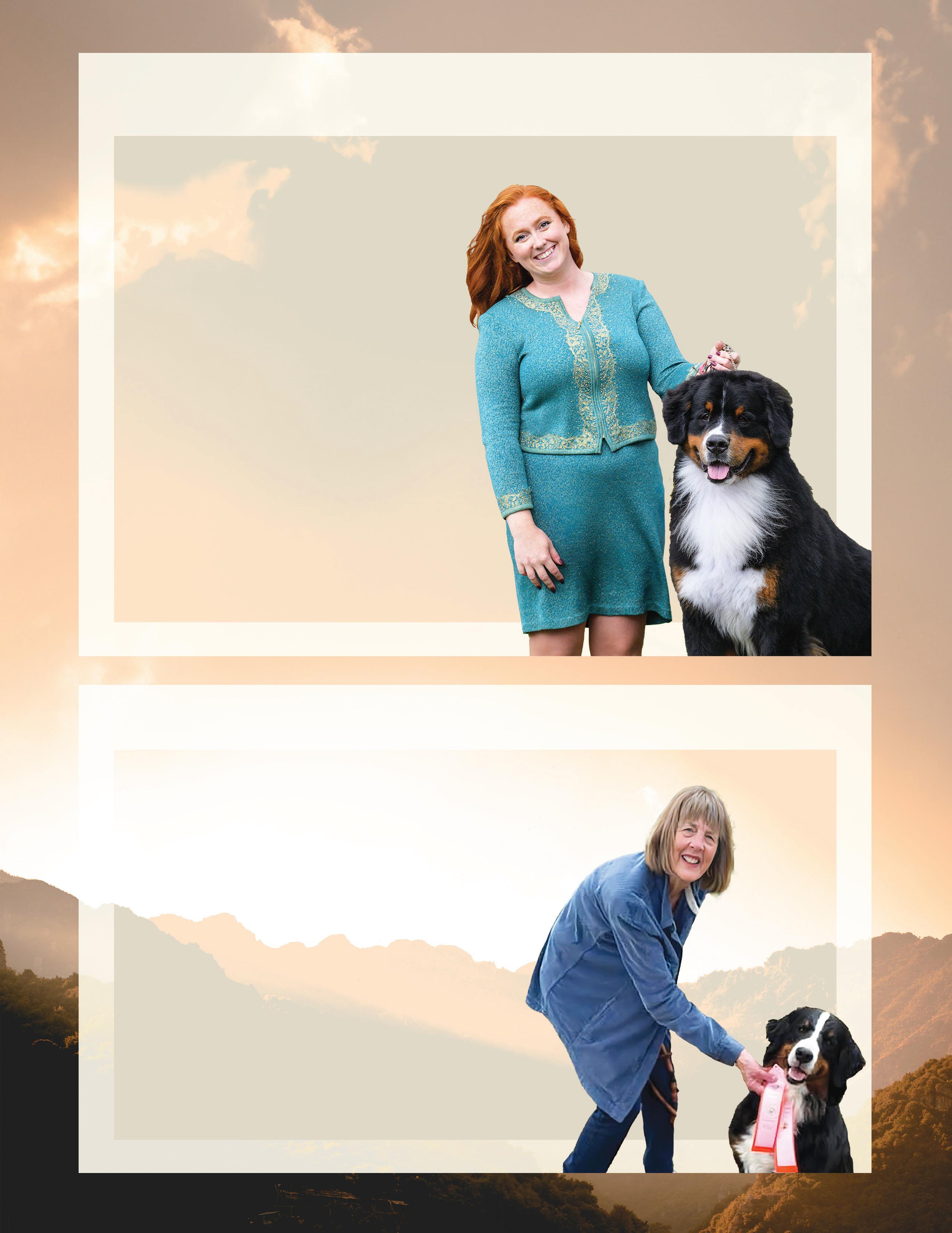
ABOUT THE BACK COVER
Aprils Legacy
April Rifenburg joined the BMDCA in 1979 and was a beloved member, competitor, breeder, mentor and friend to all who knew her.
• Four-time recipient of High in Trial in Obedience at the National Specialty, three times with her girl Heidi, resulting in the High in Trial perpetual trophy being renamed “Heidi’s Legacy” in their honor.
• Over 20 years of service as chair of BMDCA’s Obedience and Tracking Committee.
• Breeder of Bernese under the Starbourne kennel name.
• Advocate for all performance activities, most recently Nose Work/Scent Work, where she earned too many titles to list.
• Recipient of BMDCA’s highest honor, the Outstanding Service Award in 2005.
yatt Multi Group Winning/Placing GCHS Swiss Stars Gun Fight At The OK Corral SIN CGC BG# 178937
W
SPRING 2024 ∙ 9
’
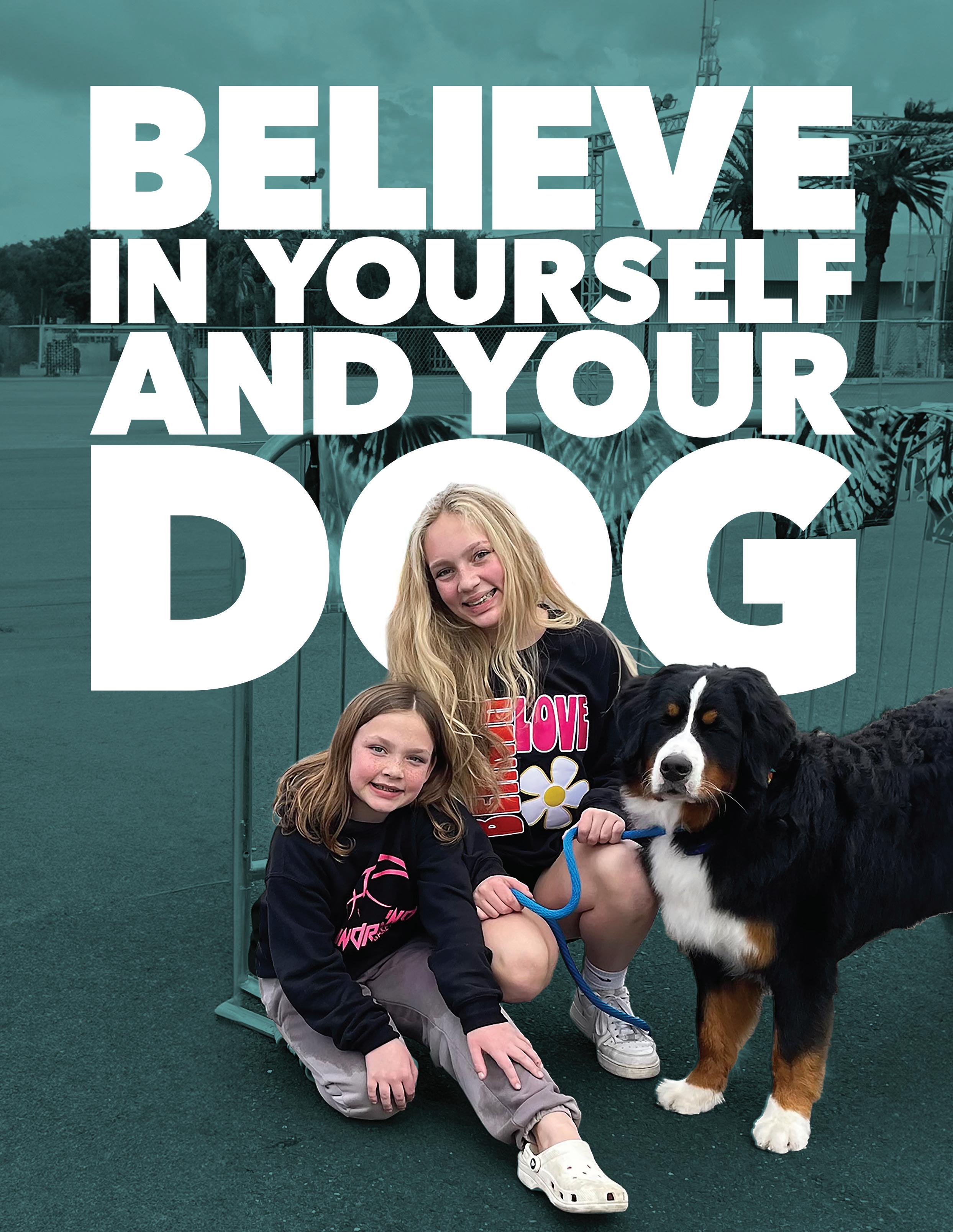
JUNIOR SPOTLIGHT
GETTING TO KNOW ADDISON AND AUDREY STABENOW
Addison and Audrey with Astra (BG# 207344). Photo by Charlotte Van Horn.
Tell us about yourself.
Addison: I am 14 and I live in Milwaukie, Oregon. Basketball and softball are my other favorite sports, plus I really like to get good grades; I have had a 4 point average for the past two years. I have been around my Grandma’s (Charlotte Van Horn) Berners since I was a baby. Tanji (Werlwind’s Tremendous Heart Celebrates It All, BG# 205156) and Astra (Werlwind’s Everlasting Faith In A Curious Universe, BG# 207344) are our current girls and I have been teaching and practicing with them since they were puppies.
Audrey: My name is Audrey Stabenow. I am 9 years old. My dog is named Astra. She is a year and a half and I have been working on dog show stuff for one year. I play basketball and softball as well.
How did you get started handling dogs?
Addison: When I was eleven my grandma wanted to show her veteran, Sugar (Werlwind’s Life Of The Party BG# 83785) in our regional specialty and I asked if I could do it. She won BOS and then I was hooked!
Audrey: My sister and grandma were always going to dog shows and practicing ring stuff and it made me want to do it, too. So, we just started practicing.
What do you love most about handling?
Addison: I love competition and being able to do a sport with my furry friend is awesome!
Audrey: Spending time with my dog and showing people what she can do.
What is the most challenging part about handling?
Addison: Sometimes my sister and I have had to share one dog because one of them went in season; we had to decide who got to take her in Best of Juniors, so we did Rock Paper Scissors and then the next show just traded. And if I am in regular classes also, sometimes it can be crazy getting to the other ring on time.
Audrey: Sometimes it is hard stacking my dog because I can’t reach the back leg easily.
How do you feel entering the ring? Have there been any moments that stood out to you?
Addison: I feel pretty confident in the ring because I have practiced a lot and I really trust my dog to work well with me.
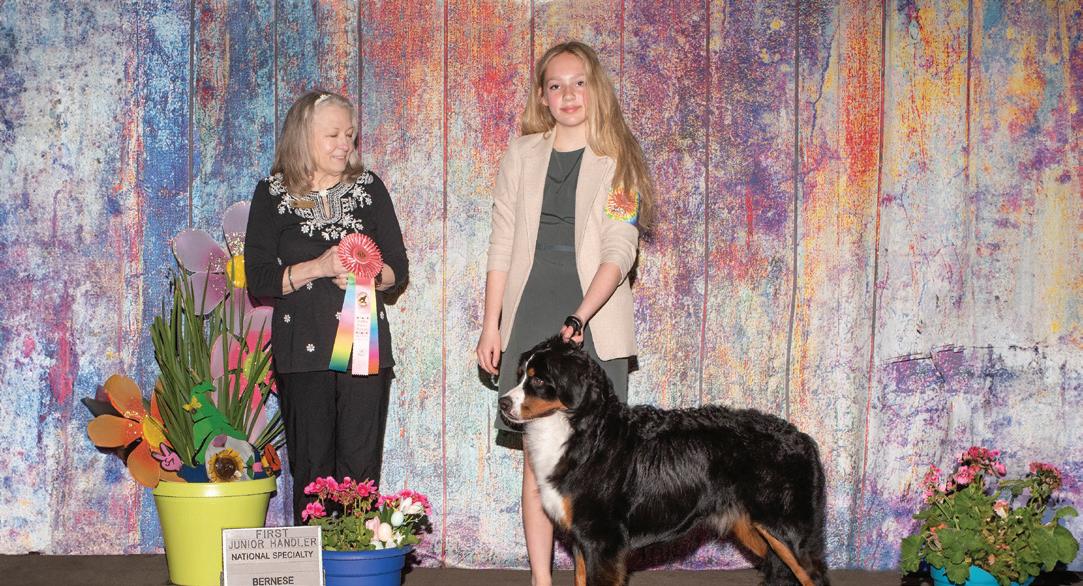
At the 2023 BMDCA Specialty some other people asked me to handle their dog in different classes than mine; it was an honor and definitely a highlight!
Audrey: The first time I went in the ring I felt shaky and nervous, but it turned out to be fun, so I am not too nervous any more. The first time I won a ribbon with Vegas (Lavender Hill’s Sin City BG# 139954) was amazing; it made me so happy! I am so grateful to Susan Parr for letting me show her!
Do you have a favorite show or event you attend each year?
Addison: So far, the National Specialty was the most fun because it had a lot of activities for Juniors, and it was fun traveling to it.
Audrey: The Specialty was the most fun; it had cool prizes, plus there were so many Bernese Mountain Dogs! And I found a lot of hearts!
What are you most proud of in your Junior career?
Addison: I feel proud that I have learned to be a handler.
Audrey: I feel most proud of my puppy — she has really learned how to be a show dog.
What advice would you give other young handlers?
Addison: Believe in yourself and your dog. And know something that will keep your dog entertained if you have to spend a lot of time in the ring.
Audrey: I would say practice with your dog a lot before you go in the ring. And try to make sure your dog is happy. Pay attention to what the judge says.
What is the most important thing that dogs have taught you?
Addison: Dogs have taught me how important it is to think of your dog as a teammate, and how to communicate with body language.
Audrey: Don’t give up if you can’t figure out what to do, just keep trying to think of how it can work.
Anything else you would like our membership to know about you or your experience as a junior?
Addison: If I think of my dog first, the ribbons will follow.
Audrey: Thanks, Grandma, for teaching me. And always have pockets!
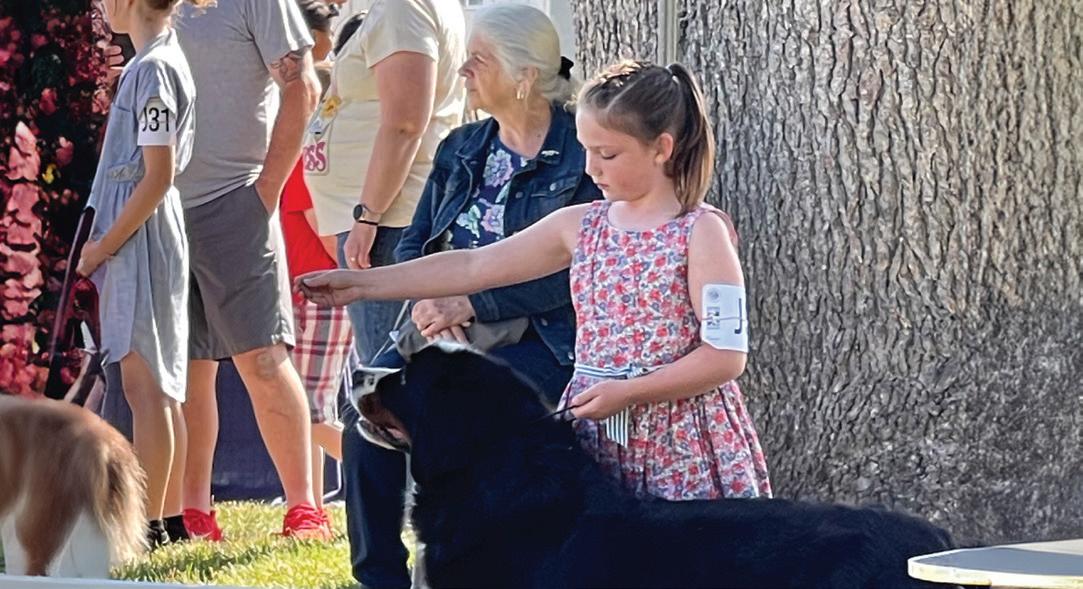 Addison with Astra (BG# 207344). Photo by Images by Kit.
Addison with Astra (BG# 207344). Photo by Images by Kit.
SPRING 2024 ∙ 11
Audrey with Vegas (BG# 139954). Photo by Charlotte Van Horn.
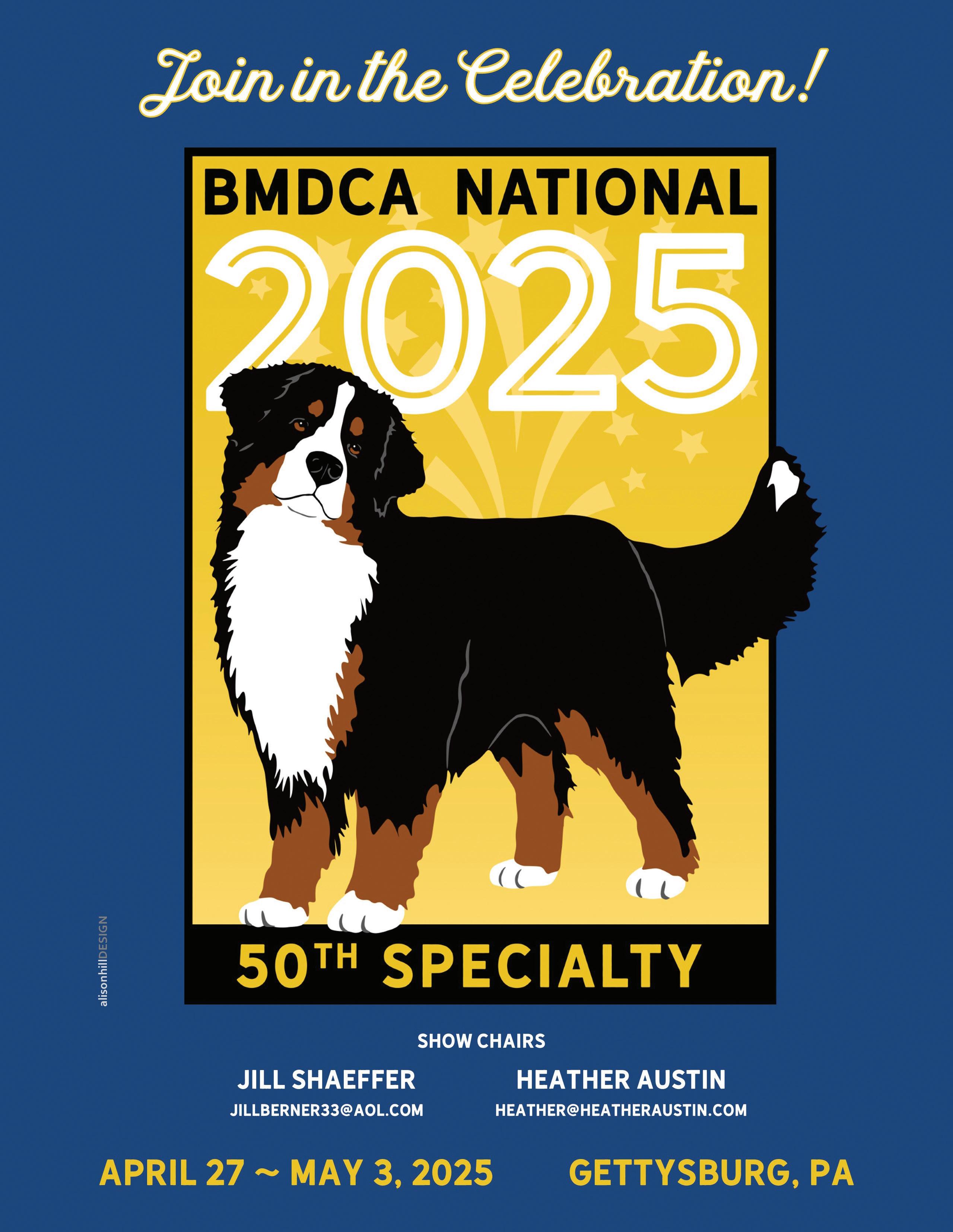

PICKING KEEPER the
BY LARA USILTON WITH LAYAL BOUAOUN, LAVISH BMD AND BLAKELY

You spent a year studying pedigrees and videos and attending dog shows to find just the right stud dog. You nourished your bitch with all the proper nutrition and care, checking progesterone levels as the time drew near. You paid a hefty sum to make the breeding happen and you monitored the mother-to-be with check-ups and ultrasounds for two months waiting for the whelp. Now, you have a healthy, robust litter of potential competitors nursing happily, grunting and nuzzling and growing overnight. One of these pups will remain with you, but which one? How do you decide? Layal Bouaoun of Lavish BMD and Blakely Dillard of Blakener BMD share their expertise on evaluating a litter and picking the keeper.
While, at birth, all the neonates may seem very similar, distinguished only by their sex and markings, Bouaoun starts examining them right away. “I do a hands-on evaluation twice: once within the first 24 hours of birth and again at eight weeks, give or take two days.” Understanding that puppies can change dramatically as they grow, she says, “Any notable virtues or areas of concern are mentally noted initially and watched carefully throughout development until the 8-week evaluations are done.”
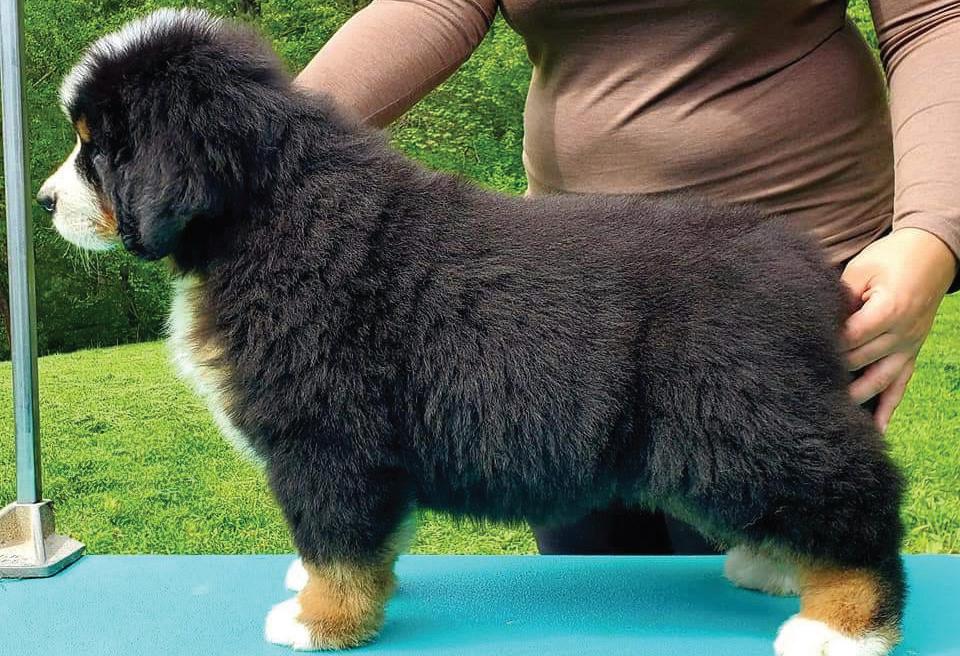
What characteristics are considered at the ripe old age of 1 day? “At birth, I measure all the bones and look for correct shoulder layback, length of upper arm, rear pastern length, neck length, tail length, thickness of tail at base, loin versus rib cage length, texture and thickness of coat. To visualize the measurements taken at birth I will “hang stack” each puppy, carefully suspending them with my fingers supporting them under the jawbone and between the rear legs. When the puppy is relaxed, balance of angles and positioning of front and rear legs is noticeable. If they toe out at this age, they will toe out as an 8-weekold. If they lack angle now, they’ll lack angle later.”
Not surprisingly, much more can be assessed at the 78 week mark, however, temperaments can and should be considered much earlier. “As temperament is one of my top priorities, if not the number one priority in my breeding program, I evaluate temperament from the moment they’re 3 weeks old. I want to see puppies that are stable, affectionate, confident and able to recover from startling situations easily. I don’t mind a needy puppy and I love a sassy puppy! Energy level can be lazy to moderately active. I don’t look to produce
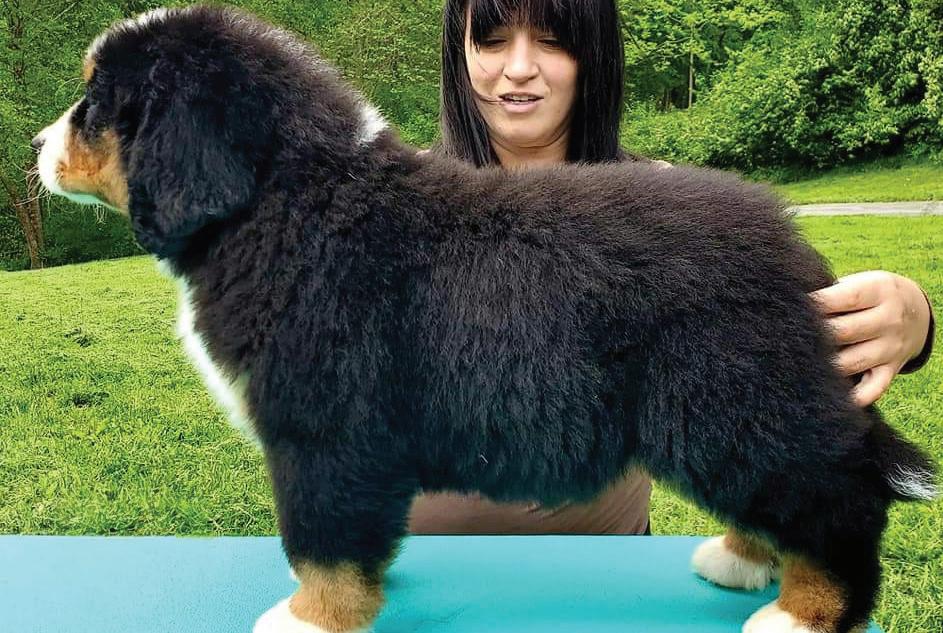
14 ∙ THE ALPENHORN
DILLARD, BLAKENER BMD
BG Litter 60520. Photo by Dee McDuffee.
Sleepy puppies can be easier to keep still for pictures. CH. Lavish's Glory Or Valhalla "Uhtred" (BG# 175292). Photo courtesy of Layal Bouaoun.
Using a formal evaluation form makes it easier to assess and note everything about the puppy. GCH. Lavish's Ragnar The Fearless "Ragnar" (BG# 175291). Photo courtesy of Layal Bouaoun.
wild, high-energy dogs that cannot learn to settle. High drive is fine, as long as they are containable. I do not use tense or reactive dogs in my breeding program. Aloof dogs are absolutely acceptable. My dogs tend to be a bit on the emotional side and I don’t mind that. The Bernese temperament is a massive part of breed type, in my opinion, and focusing on this is something that my repeat buyers consistently appreciate in their puppies.”
Dillard says, “I always consider temperament when deciding if a puppy is a show-quality puppy or a pet puppy. I consider this because to have a good show dog, it also has to have the attitude to go with it. When outside playing with the puppies, I am looking for the puppies with tons of attitude and confidence. The puppy that shies away, or does not play as much as its littermates, may not be cut out for the show dog life.”
Once the litter reaches 7-8 weeks old, it is time to start seriously sorting the wheat from the chaff. So, while watching the pups move and interact during play is beneficial, both Bouaoun and Dillard recommend formal evaluation standards at this stage. Dillard explains her process, “As an 8-week-old, I assess everything per the breed standard — general impression, followed by the head, front assembly, rear assembly, balance, coat, topline, tail and off-lead movement viewed from all angles.
During the evaluation process, I am looking for the puppy that most closely resembles the AKC standard for a Bernese Mountain Dog. I look at how the puppy looks stacked on the table and ask myself questions such as, ‘How does this puppy hold itself while stacked?’ ’Does this puppy hold its topline well?’ ‘Is this puppy proportioned correctly?’ ‘How does this puppy place its front/back feet when stacked (i.e. Do they hold their front correctly or are they turning in or out at all?).’ I also like to have them on flat ground to watch how they move. I will have someone video me moving them as I would in a show ring, to critique their trot. I feel that movement best shows any faults a puppy may have.

The puppy that shies away, or does not play as much as its littermates, may not be cut out for the show dog life.
– Blakely Dillard
Although I always take pictures of them stacked on a table, my preferred method is videoing them stacked, moving around in a circle, as well as a down and back, all in one video. I will usually retake pictures and videos later on to track any possible changes, as well as make any critiques.
To get the puppies to cooperate during an evaluation, I feel it is best to let them play before the evaluation or bathe and blow dry them to tire them out. It is hard to stack and move a puppy for an evaluation if the puppy is full of energy and cannot keep its feet still. I also like to use Happy Legs for training. Happy Legs stilt training devices are a great tool to use to teach the puppies to keep their feet still and in the place you want them. I feel this way of training also helps build confidence in puppies. For final evaluation pictures, I use a grooming table to stack the puppies along with the help of their favorite treat. I have found cream cheese or peanut butter usually does the trick and they can stand while licking the spoon, instead of pulling on a piece of cheese or beef jerky.”
Bouaoun uses a formal process, including a written evaluation sheet. As an observer at one of her litter evaluations, I found this process a methodical way to keep track of the faults and virtues of a pack of busy little Berner pups, “At 8 weeks, I follow a pointby-point evaluation form that I have developed over the years both from other breeders and the late AKC judge Pat Hastings’ evaluation form, in addition to my own prioritized areas of evaluation. This is done with the puppy on a grooming table and free moving on the ground.”
To get active puppies to cooperate during the evaluation Bouaoun recommends starting early and using plenty of praise, patience and positive
SPRING 2024 ∙ 15
Putting puppies on the table at an early age is beneficial in the long term. GCH. Lavish's The Flame Bearer "Sigrid" (BG# 192677).
Photo courtesy of Layal Bouaoun.
“Don’t make excuses for faults, they won’t go away just because you really want them to.”
– Layal Bouaoun
reinforcement. “Start manipulating their little bodies from day one! The hand stacking routine of moving their legs into place starts at 2 weeks, even though they can’t hold their stance. Putting them on a table by 3-4 weeks will pay off in the long run. Don’t struggle with them, move slowly and praise them softly. Use keywords like “stand” to condition them to a training atmosphere. Working when they’ve been asleep for a few minutes will keep them from trying to take a flying leap off the table! Never get firm with a puppy and never work more than a few seconds each session. Always end with lots of praise and kisses.”
Neither breeder shies away from getting the opinions of mentors and other respected breeders, “When I evaluate puppies, I always have my dad help me. My dad is a Rottweiler breeder of 35 years. He has also judged many sweepstakes classes at regional specialties and national Seiger shows in Rottweilers. His expertise in structure and movement is a huge asset when it comes to evaluating puppies. Occasionally, once I have narrowed my choices to one or two puppies, I will send pictures and videos to a mentor to get an outside opinion,” says Dillard.
Similarly, Bouaoun commented, “I also enjoy videoing the process to share with fellow breeders around the country.”
Determining the show prospect after all of this scrutiny though is really what it comes down to when looking for the pick puppy. Bouaoun advises, “Of course, they have to meet the basics of structure and type per the breed standard. Puppies without obvious faults aren’t necessarily strong show prospects — lacking faults isn’t the same as possessing virtues. I want to see a puppy that catches the eye from day one, develop into a head turner at 8 weeks. The conformation, movement, type must all meet together in a puppy that possesses the
confidence and willingness to show — a spark, a look at me attitude, a go-getter. Bernese aren’t push-button show dogs like some other breeds, and a love of the rigorous show dog life combined with the physical attributes to make a star is a rare combination. When you see it, it is unmistakable.
Be brutally honest with yourself. The puppy that gives you pause isn’t the puppy, no matter how much you want it to be. Don’t make excuses for faults, they won’t go away just because you really want them to. Don’t be surprised if your keeper puppy falls apart as they grow — sometimes they come back around, sometimes they don’t.”
When more than one puppy is an eye-catcher, making the decision even more challenging, some breeders will retain multiples to watch them as they grow into mature puppies and reassess at that time.
Dillard believes this is a smart idea. “I think it is wise to keep puppies longer if need be, to see how they mature before placing them in a show home. I also feel if the puppy meets my standards for a show puppy at 7-8 weeks old, it is okay to go ahead and place them in a show home. I think some bloodlines mature at a slower pace than other bloodlines, so with some of my litters I prefer to sit on my keeper puppies until they are a little older before deciding to place them in a show or pet home.”
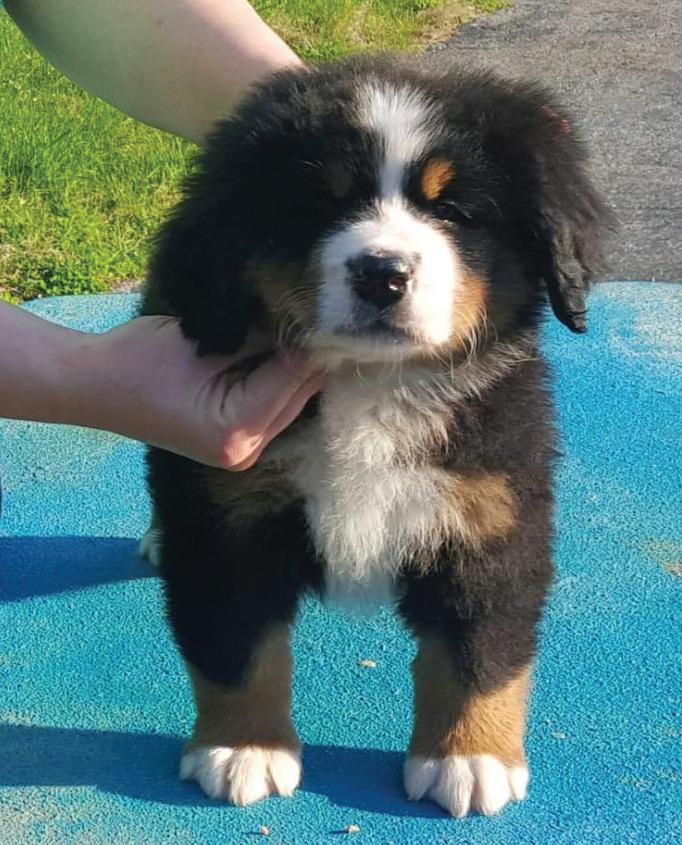
16 ∙ THE ALPENHORN
Assessing fronts with GCH. Lavish's As You Wish "Florin" (BG# 129103).
Photo courtesy of Layal Bouaoun.
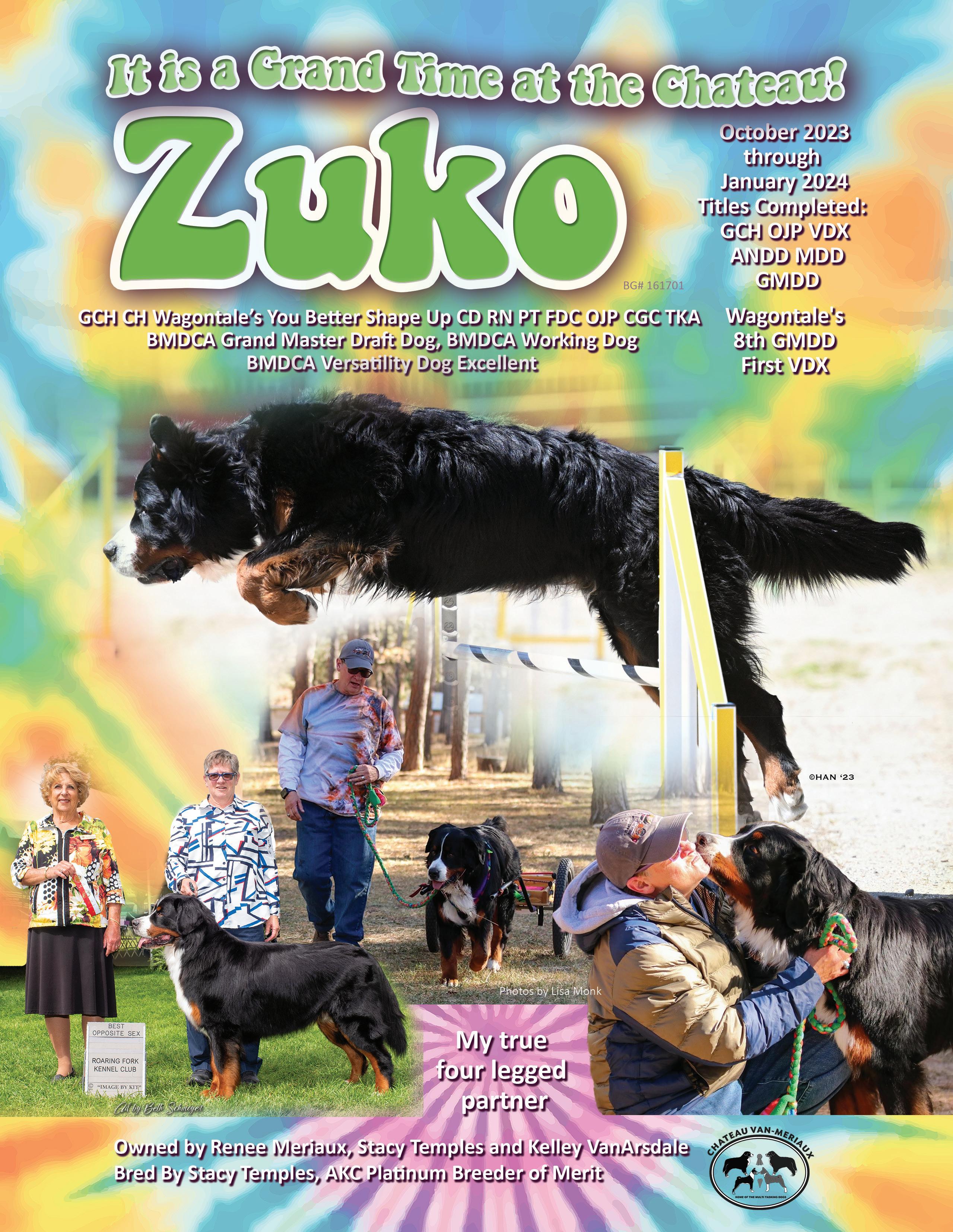
When asked if she recommended keeping show prospects until they mature and rehoming if they don’t turn out or placing them in show homes in hopes that they do, Bouaoun stated, “Both options have good and bad points to them. My breed mentor and dearest friend, Fara Bushnell once told me, ‘You can’t keep all the pretty ones!’ I do not enjoy selling show prospects to established show homes that aren’t willing to place them if they don’t turn out. I don’t want a puppy to be in a home that doesn’t want it. I love helping new show homes start out with something really nice when I can. And I’ve placed plenty of show potential puppies in pet homes, as it was the right home for that dog.”
While there are certainly never any guarantees when choosing the next puppy to represent your kennel in a show ring, watching carefully, implementing a formal evaluation method and remaining unemotional and painfully honest during the selection process are key. It’s easy to get swept up in the excitement of what the future could hold, but remaining true to the standard, engaging the opinions of other respected, successful breeders and being patient, will likely reap the most rewards.
About the Experts: As a third-generation breeder/ exhibitor of purebred dogs, Layal Bouaoun began showing Bernese Mountain Dogs in 2004. She bred her first litter in 2010 and, to date, has produced nearly two dozen AKC champions and grand champions under the prefix Lavish, in addition to those sired by her stud dogs. She has been blessed enough to produce a BMDCA Top Conformation Dog, a BMDCA Best in Futurity Winner, a #1 Bernese Mountain Dog, MBISS winners, five Group winning and placing Berners, and Best of Winners at the BMDCA National to date.
Blakely Dillard grew up with show dogs her whole life. As a youngster, she attended Rottweiler regional specialties and national specialties with her parents who are longtime Rottweiler breeders, owners and handlers. In 2014, with her parents, she imported her first Bernese Mountain Dog from Canada, and was instantly in love with the breed. She welcomed her first litter in November 2017 and in 2018, skipped her dental hygiene school graduation to attend the BMDCA National in Sturbridge, MA so eager was she to see the potential future stud dogs, learn more about pedigrees and meet the breeders of these wonderful dogs. She loves this breed and strives to improve it in health, structure and longevity with every breeding. In her six years of breeding Bernese Mountain Dogs, she has produced a dozen AKC Champions, as well as owned a Top 10 dog and two-time AKC National Championship BOB winner. She has also handled her own dog to two Best in Specialty Show wins.
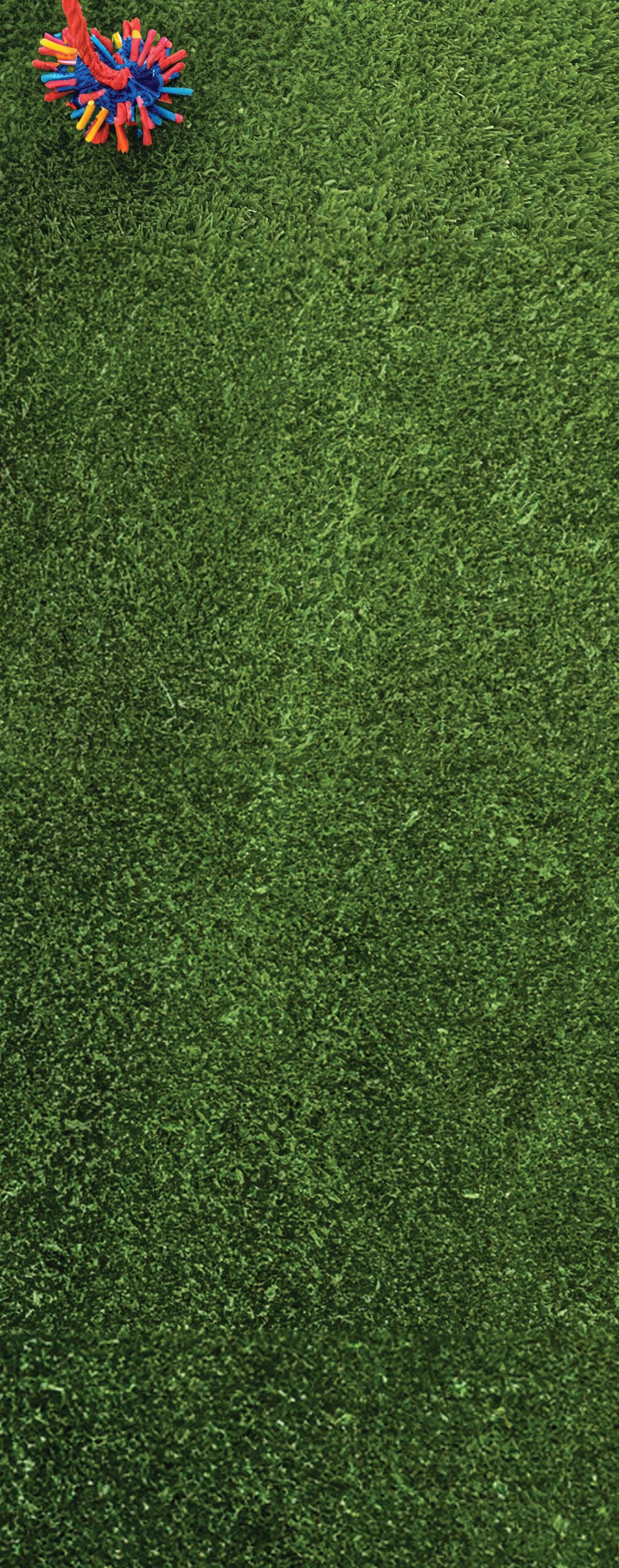
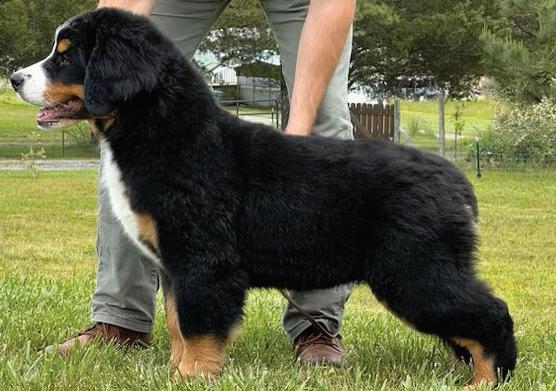
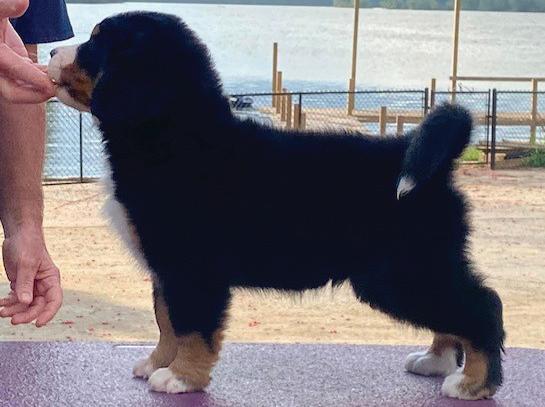
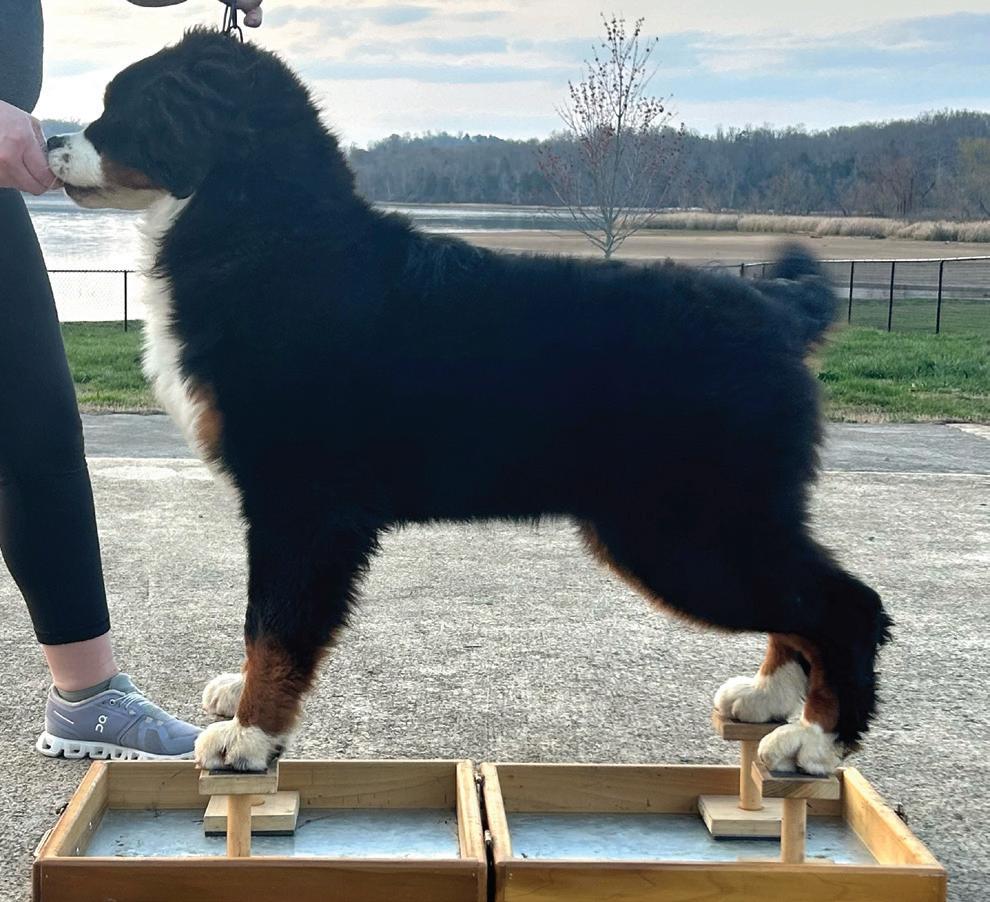
18 ∙ THE ALPENHORN
Assessing a pup on the ground is beneficial. Blakener’s Grand Slam “Serena” (BG# 212262). Photo by Blakely Dillard.
Use cream cheese or peanut butter to capture pups attention during evaluation. Blakener’s Femme Fatale “Femme” (BG# 206443). Photo by Blakely Dillard.
Blakener’s Apple Jack (BG# 217671) demonstrating Happy Legs. Photo by Blakely Dillard.
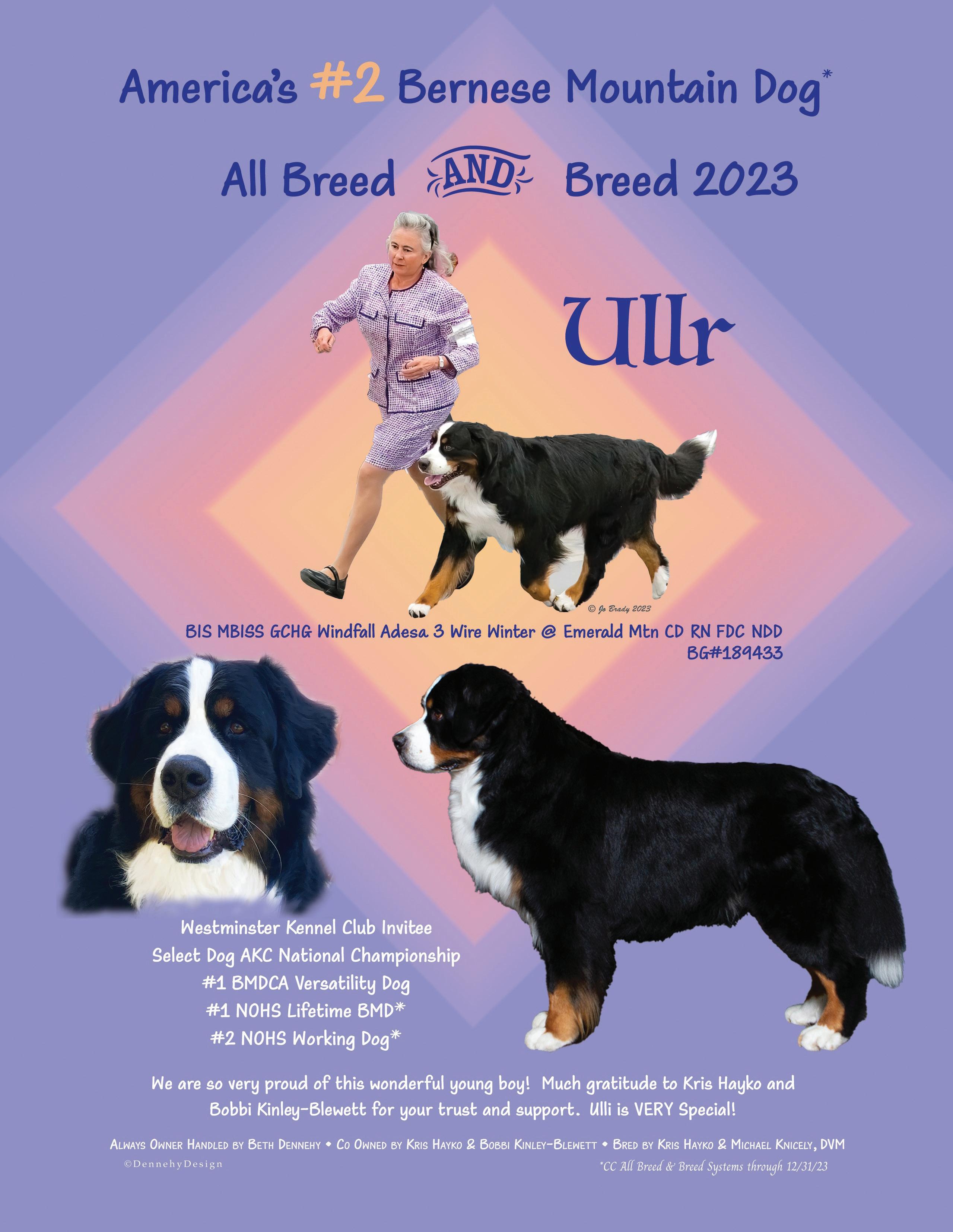
WITH YOUR BERNER
BY JESSICA MOORE
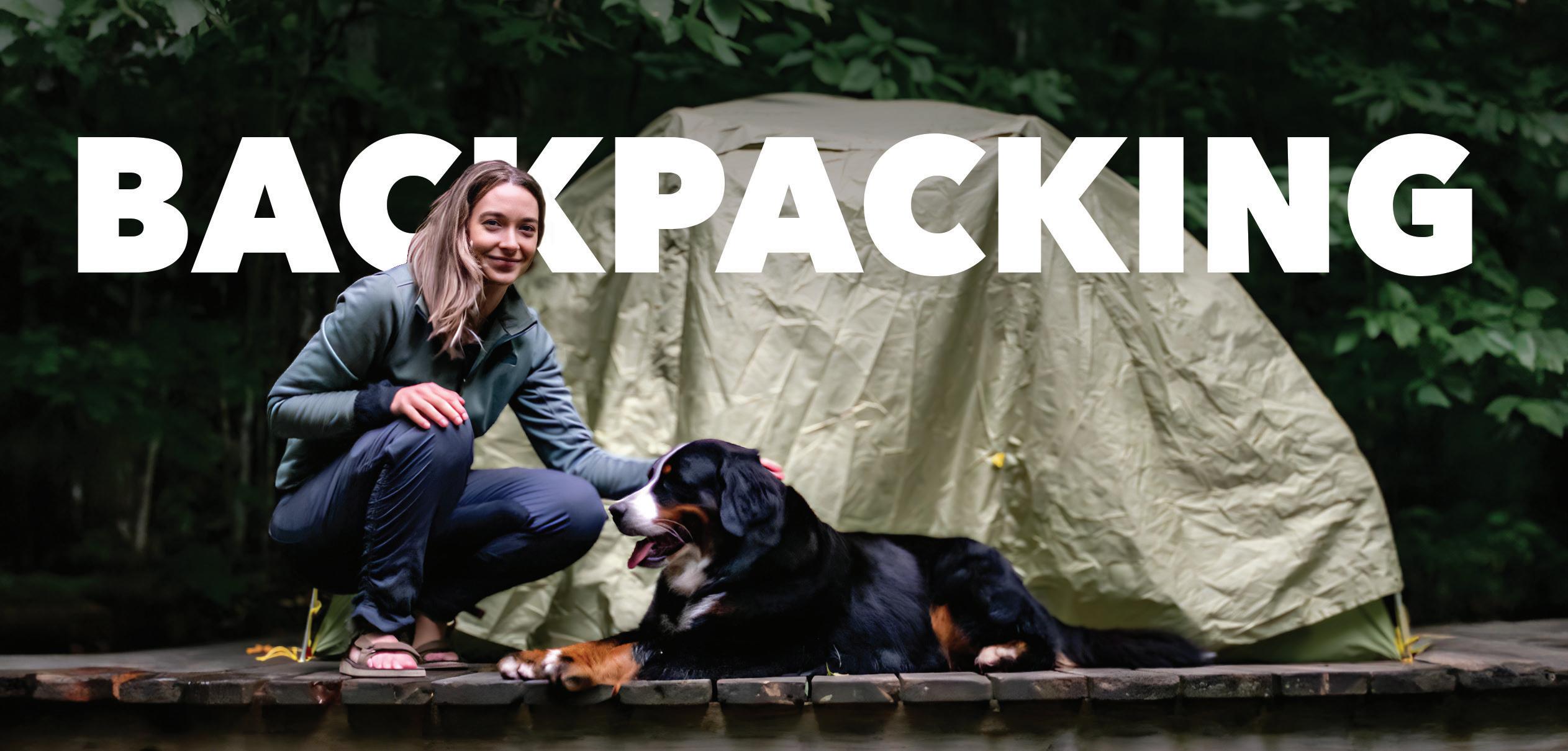
Berners can make wonderful hiking and camping companions. Hiking is one of my favorite things to do with my dogs. Over time, our hiking trips have evolved into overnight backpacking endeavors. These adventures not only have given me many cherished memories with my dogs, but also earned Violet and me our AKC FitDog Gold title in 2023. I certainly don’t claim to be an expert backpacker, but there are some important considerations I’ve learned about backpacking with dogs that I think could be helpful to anyone who would like to try it. I hope to provide some tips, as well as inspiration, to get out and have fun with your dog in the great outdoors.
HEALTH AND FITNESS
The number one priority on your hike is not to make it to the summit, or to your campsite, or to get pretty photos. It is always the health and safety of you and your dog. Before you plan your trip, make sure your dog is in good health.
• Have they had a recent vet visit?
• Are they up to date on vaccinations?
• Are they up to date on tick prevention?
• Are they microchipped?
You will need to work your dog up to longer hikes. Start out by doing shorter, flatter walks and hikes with your dog wearing an empty, properly fitted backpack. Work your way up to longer and steeper hikes. Slowly add weight to the backpack, making sure the backpack’s weight is evenly distributed. Don’t ever force your dog to hike. Let your dog set the pace and be prepared to head back to the car if it ever becomes too much for them.
Consider the age of your dog as well. For strenuous hikes, your dog should be old enough that their bones
and joints are done growing. My dog Violet and I didn’t start backpacking together until she was at least 2 years old. Older dogs may not be able to move comfortably for long periods of time.
SAFETY
Research the trail and conditions prior to the trip.
• How many miles is the trip? What is the elevation gain?
• Are there rivers to cross?
• Will you come across other dogs and people on this trail?
• What kind of wildlife might you come across?
When asking yourself these questions, keep your dog’s abilities in mind. Always be sure to check the weather beforehand. I never take Violet backpacking when it could be too hot and humid as heat stroke is a real concern.
Make sure to bring plenty of water and food for you and your dog. Your dogs may drink more water when they are exerting themselves than they normally would lounging around the house. Know what water sources will be available on the trail, if any, and bring a water filtration system and a bowl for your dog to drink out of. I once forgot to pack a bowl for Violet to drink out of, so I had to get creative! Be aware water sources could be dried up, or frozen during the colder months.
Always bring a first aid kit!
TRAIL ETIQUETTE AND TRAINING
Make sure dogs are allowed on the trail before bringing your dog and be respectful of leash laws.
20 ∙ THE ALPENHORN
Jessica Moore with Violet (BG# 190440). Photograph by Jordan Fortier.
There is truly nothing better than snuggling with your dog in a cozy tent after a long day of adventuring together.
You may come across other dogs and people on the trail. Consider how your dog will behave and prepare accordingly. Respect other hikers by giving them space. Your dog should be under your control at all times. Your dog needs to have a solid recall and “leave it” command if they are going to be off leash. This is not only to respect other people, dogs and wildlife, but for safety reasons. You don’t want your dog chasing a squirrel off a cliff, getting quilled by a porcupine or eating a poisonous plant!
Consider your dog’s temperament and level of socialization. Is your dog afraid of heights? Will they be comfortable hiking through water crossings or over bridges? You may not think twice about sleeping in a tent, but your dog might be confused or uncomfortable with it at first. Try car camping or camping out in your backyard first to see how your dog tolerates it. I like to bring a sleeping pad for Violet to lay on for comfort. If your dog is “place” trained, this can be particularly helpful. Make sure your tent is big enough for you and your Berner!
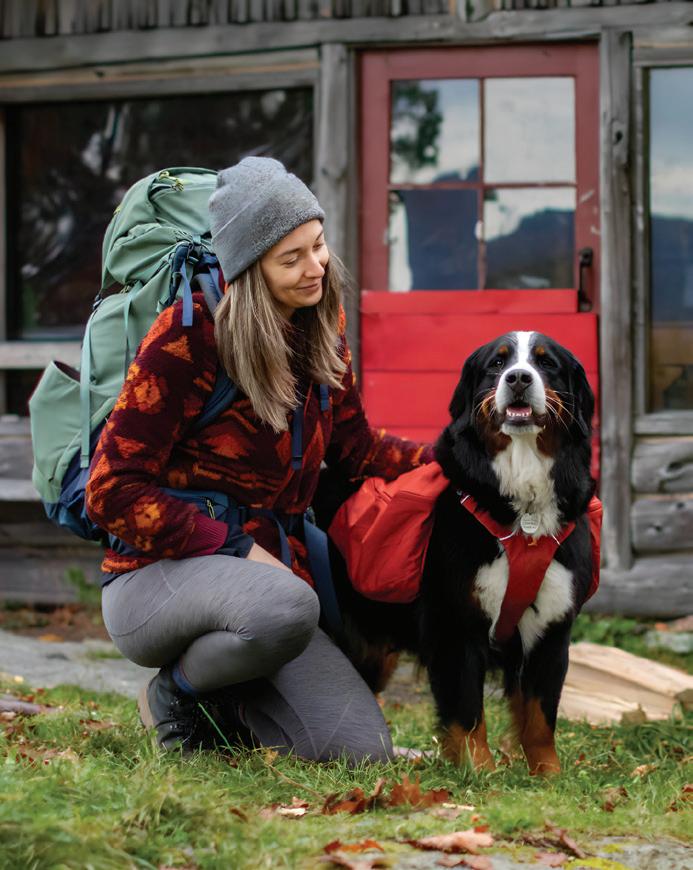

Once all the preparation has been done, get out there, have fun and make memories with your Berner! There is truly nothing better than snuggling with your dog in a cozy tent after a long day of adventuring together.
About the Author: Jessica Moore became involved with Bernese Mountain Dogs just a few years ago. In March 2021 her first Berner, named Hans, came into her life, then her second Berner, Violet, arrived just a few months later. Since then, she has joined her regional club, serves as a photo editor for the club’s quarterly newsletter team and has participated in several club events. She discovered and fell in love with dog sports with her dog Violet. Together they have earned several AKC titles in Rally, Obedience, Trick Dog, FitDog and FastCat. Jessica and Violet earned their BMDCA Active Dog award in October 2023. Jessica plans to continue to learn about, and be involved with, the breed she loves so much.
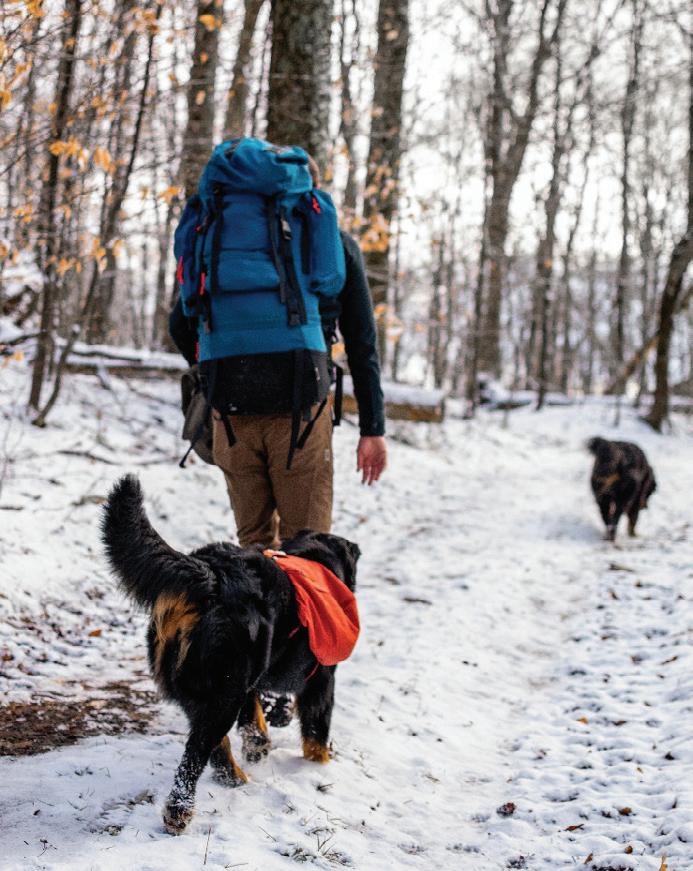

SPRING 2024 ∙ 21
Jessica Moore with Violet (BG# 190440). Photograph by Jordan Fortier.
Violet (BG# 190440), Hans (BG# 197711) and Jordan Fortier out for a hike.
Photograph by Jessica Moore.
Violet (BG# 190440) earned her AKC FitDog Gold title in 2023. Photograph by Jessica Moore.
IS PET INSURANCE WORTH THE INVESTMENT?
BY SUZIE WEIBEL
 Francis (BG# 106343).
Photo by Laura Rose Humes.
Francis (BG# 106343).
Photo by Laura Rose Humes.
Let’s play a game of “Guess how many gummy bears are in the jar.” Only let’s not guess gummy bears. First, let’s guess how many dogs are known household members in the United States. There are over 75 million dogs living (hopefully) as members of a family in the United States.
Now, let’s guess what the average cost of veterinary care was per dog in 2023. The average pet owner paid around $250 in 2023 for routine veterinary care. But when emergencies, illnesses and injuries are averaged into the annual cost for care, the numbers rose to between $700 and $1,500. Remember, we are spreading this average between 75+ million pet dogs, many of which receive not even rudimentary care.
Finally, let’s guess the percentage of dog owners who invest in pet insurance. This is where the numbers take us on a bit of a roller coaster ride. Over four million dogs are covered by insurance policies covering illnesses, injury, accidents, congenital and/or chronic conditions and prescriptions. The good news is that this is more than a 25% increase in just one year!
Therefore, pet medical insurance is regulated more like car insurance than human health insurance, since it falls under the category of property and casualty insurance for regulatory purposes.” (This would explain why we have such troubles regulating puppy mills as well, but that is a topic for another time.)
Just like insuring a male driver under the age of 25 to drive an “arrest-me-red” sports car in California will generally result in a more expensive policy, the cost of most pet insurance policies is based on the statistical likelihood for injury or illness based on the age and breed of one’s pet and the location of veterinary services provided. Cynthia Foley explains in The Whole Dog Journal (March 2023, Volume 26 No. 3), “For example, 65% of Golden Retrievers die from cancer compared to a 25% rate in all dogs, according to a June 2022 study . . . . So, yes, insuring your Golden will cost more than a Jack Russell Terrier, one of the least expensive to insure, but it’s not an arbitrary thing.”
Regardless of the monthly cost, pet insurance is pennies on the dollar when some of the issues
Pet medical insurance is regulated more like car insurance than human health insurance, since it falls under the category of property and casualty insurance for regulatory purposes.
The not-so-good news is that this represents less than 5% (about 3% to be more exact) of beloved canine companions.
These numbers matter to us as pet owners for certain. They also matter as breeders. Too many otherwise healthy dogs are euthanized because of injury or illness that is beyond the scope of a pet owner to financially manage. Pet insurance is intended to be the remedy for such an unseemly scenario. Because there is such great variance in policies, pricing, and coverage we reached out to all-breed handler Heather Blakeman, CPDT-KA, FFCP (Veterinary) who happens to have a soft spot for Bernese Mountain Dogs and is a territory partner associate for Trupanion in Louisville, Kentucky. Blakeman is also licensed by the states of Kentucky and Indiana as a property and casualty insurance agent.
One of the first important things to note about pet insurance, according to Blakeman, is the fundamental difference between health insurance for humans and for pets. “While I certainly consider pets to be family, in the eyes of the law, they are considered property.
that befall our Berners come into play. Emergency surgeries, cancer treatment, hospital stays and prolonged illnesses — all of these can run well into the thousands if not into five figures. Even a policy with a high premium and a very low deductible will not cost what one ill-timed hospital stay might.
Several Berner families have shared with us their own stories of emergencies and how pet insurance policies came to the rescue.
Andrea Bracikowski and her husband returned home from a family wedding in 2020 to find their 7-yearold neutered boy, Francis, experiencing symptoms of bloat after the overnight stay with a friend. Recognizing the signs allowed them to act quickly, and Andrea’s sister (a veterinarian) directed them to the nearest emergency hospital, calling ahead to let the doctor on duty know that Francis was on his way. The doctor performed life-saving surgery on Francis, including an emergency splenectomy, as an abnormality was discovered there upon palpation. Francis was kept overnight and on IV, a 24-hour stay,
SPRING 2024 ∙ 23
with final bills for Francis’ excellent care (which is the ideal, after all — excellent care) settling at $3288.82. Andrea’s employer had offered pet insurance as part of her own employment coverage and, through Nationwide’s Pet Protection and Wellness Plan, $2954.54 was paid out on Francis’ behalf.
This second story is a “Tru Story” of a Canadian Bernese Mountain Dog named Ben. The following are the words of his owner Deanna C. At the time she wrote this testimonial, Trupanion had already paid $21,709.32 in claims for Ben’s treatments:
“I tell everyone that has a pet that Trupanion is the best investment I have ever made! We adopted a Bernese Mountain Dog when he was only 1 year old. He is now 3 and has already needed eye surgery, bladder surgery and has had reoccurring pneumonia for the last nine months. His vet bills are over $20,000, which is certainly more than my husband and I could afford on our own. Ben is part of our family, and we couldn’t imagine what we would do without Trupanion. Trupanion gives us the peace of mind that our dog’s safety and health will never have to be compromised due to financial restrictions. The staff is always so helpful and compassionate. We have direct billing through our vet, so we don’t need to pay up front… I can’t say thank you enough. Trupanion has saved Ben’s life, and we are forever grateful.”
Meredith Jordan, owner of the popular Instagram influencer account @thebernerbunch also shared a bit of her journey with her ever-adorable BARC rescue, Weller. Weller came to Meredith as a puppy, full of personality and hidden faults – both of Weller’s hips were severely dysplastic and needed full replacement.
“I would encourage everyone to at least consider pet insurance. Weller has severe bilateral hip dysplasia that has ultimately led to him needing a total hip replacement on both sides. The cost associated with that surgery is roughly $8,000 per hip where we are located. Based on the plan I chose, my insurance company covered 90% of all eligible costs of the first total hip replacement, and I expect them to do the same with his upcoming surgery as well. They have covered all of Weller’s pre-op and follow up hip radiographs and will continue to do so for the rest of his life (he will have annual hip rads under sedation). They also cover his monthly prescription joint supplement. As a full-time graduate student who is paying out of pocket for tuition, having pet insurance has proven to be invaluable in my situation. I’m so grateful I can devote 100% of my focus on Weller and his recovery without having to worry about how I am going to afford to get him the care he needs.”
I would encourage everyone to at least consider pet insurance.

Convinced yet? If so and you are just at the start of a journey investing in pet insurance, there are a few great tips to keep in mind.
Research. Both Blakeman and The Whole Dog Journal recommend that step number one should be to read the entire policy of several providers while shopping for a plan. Policies are designed, after all, to offer a variety of options for you, the insured.
Some things seem to be consistent regardless of the insurance company or plan. Assume that every plan will have a wait period of between two weeks (typically a time period designated for illnesses) to six months (a designation typical for orthopedic issues.) AKC insurance does cover heritable conditions, but only after a one-year wait period, meaning the pet has gone a full year without an occurrence of the issue in question. These wait periods are fair; after all, if we could all just get insurance after an expensive medical emergency or recurring issue pops up in our dog the very concept of “insurance” would be compromised, and insurance companies would go belly up from extensive payouts.
It is also important to research each policy’s list of exclusions. Most policies will not cover “pre-existing” conditions, defined by Blakeman as “signs, symptoms, and/or diagnoses made prior to enrollment or during waiting periods in a policy.” Common exclusions are costs involved in breeding and pregnancy, costs associated with “normal” pet ownership such as wellness exams and vaccinations, and (read those policies carefully) breed-related issues. Conditions considered incurable may also be excluded. The best information is always that which comes straight from
24 ∙ THE ALPENHORN
The cost of Francis’ (BG# 106343) bloat episode was mostly offset by insurance coverage. Photo by Laura Rose Humes.
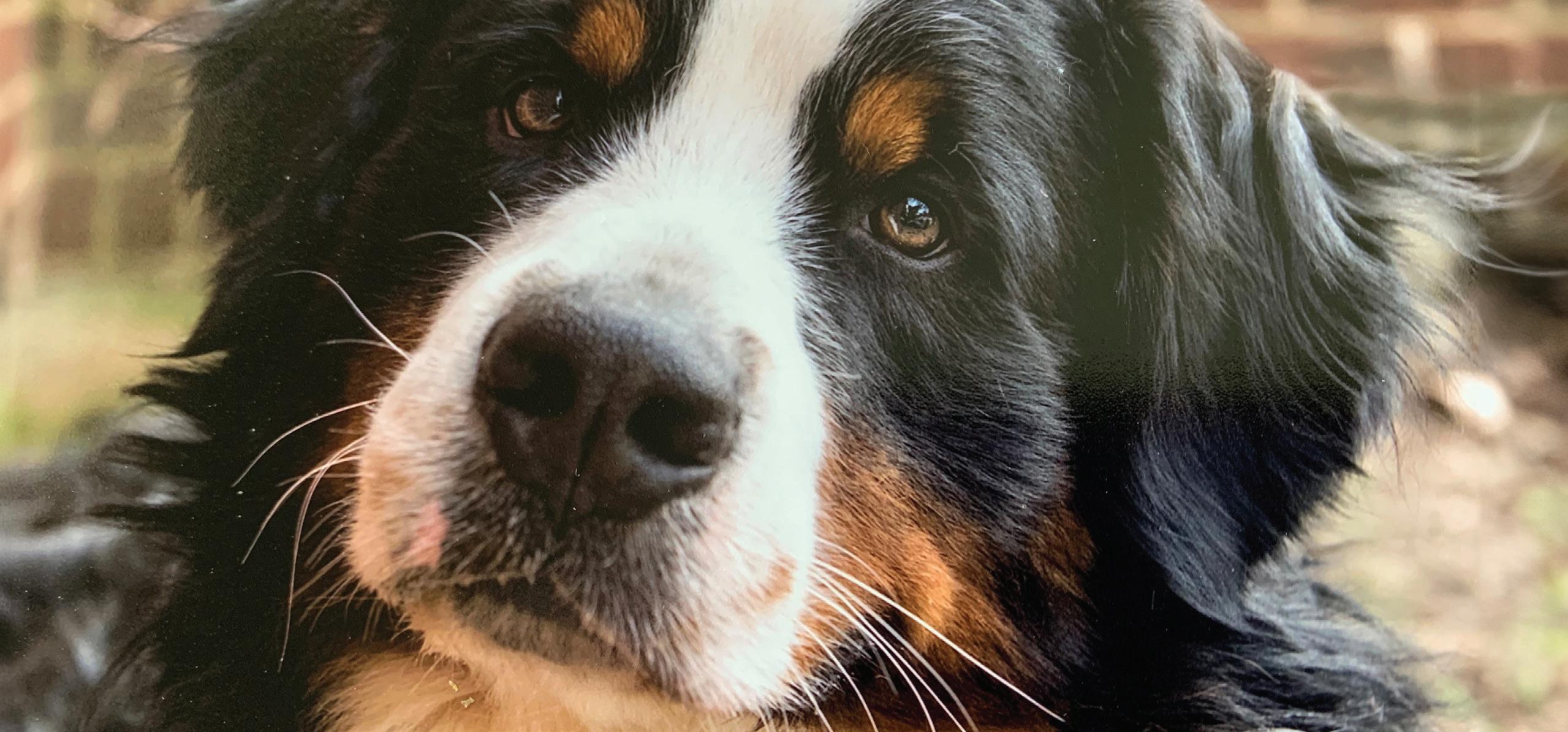
the horse’s mouth; Blakeman suggests if the language in a policy is in any way confusing or does not seem straightforward a phone call to an insurance rep is in order. Be sure to follow up by getting any necessary policy clarifications in writing.
Blakeman says the exclusion policies of most insurance companies makes it imperative that breeders discuss pet insurance early with new puppy owners. “This is why it is so important to discuss insurance with our puppy buyers before they even go home, so they can be covered from day one!” This conversation, of course, is one thing that sets apart conscientious breeding practices from those of backyard programs (and worse).
Be sure to read plans carefully for care requirements. Some companies will not insure pets they deem to be not well-cared for. Initially we may say this is something we are fully on board with, but it’s important to know what each company defines as “necessary care.” Vaccines may fall under the company’s definition of necessary care – vaccines that pet owners or breeders may not be comfortable with. Will the insurance company give titers the same importance they give vaccines? The same may be true of feeding practices or dental care. For example, early in the growth of the therapy dog movement, some therapy dog organizations did not permit certified dogs to be raw fed. Insurance companies may have fine print regarding care requirements and it is important to understand these before signing on. It is also a good idea to be sure a policy covers alternative and holistic treatments if this is a philosophy you rely on for health and wellness.
“I would advise pet owners to read the full policy which they are considering and ask lots of questions prior to enrolling so you fully understand the coverage and exclusions of whatever company you are considering,” Blakeman says. Blakeman prepared the following list of questions for veterinary clinics to help clientele select a pet insurance program that will best suit their needs and work within the participating veterinary clinic’s practices as well so there are no surprises. The list is rather exhaustive and a good list for breeders to add to their toolbelt.
COVERAGE
1. Are there exclusions or limitations by breed?
2. Is there one simple plan or multiple plans with varying coverage limits? What are the policy limits for each plan offered? Are they per year, per condition, for the life of the pet?
3. Are hereditary and congenital conditions covered? If so, are there limits on coverage?
4. Does coverage change when visiting a specialist or emergency hospital?
5. Is dental coverage included? Does it include disease or just accidents?
6. Are all prescription drugs, supplements and nutraceuticals covered? How about prescription food?
7. Is there a coverage option for rehab or alternative therapies? What are the limits?
8. Is wellness care (vaccines, flea and heartworm prevention) an option or mandatory with the policy? Are wellness treatments dictated by a benefit schedule or can your veterinarian determine proper care? Are there limits?
9. Does coverage change if enrolling an adult or senior pet?
SPRING 2024 ∙ 25
CLAIMS
1. Does the provider offer direct payments to veterinary hospitals at checkout?
2. If there are no direct payment options, what is the average time to receive reimbursements?
3. Does the provider offer pre-approval to ensure coverage?
4. What is needed to send in a claim? How long does it take to process?
5. What are the customer service hours? Can you reach a representative after hours or during holidays if a condition is life threatening?
GENERAL
1. What are the waiting periods when you enroll? Are they longer for orthopedic, hereditary or congenital conditions?
2. How does the deductible work? Per condition, per year, per body part or per condition and per year?
3. How flexible are your deductible options? Are you given specific amounts, or can you adjust to best fit your budget? Can you change the deductible without affecting coverage?
4. Can a previously covered condition become pre-existing upon policy renewal or if you change the limit or the deductible?
5. Are there penalties for making changes to your policy?
6. Are premium increases on a predetermined schedule?
7. Are there additional fees to pay your premium monthly?
8. Is there a minimum or maximum age for coverage?
9. Is there a usual and customary charges clause or does the company pay from the invoice?
10. Can your policy be canceled for any reason other than non-payment?
SUGGESTIONS FROM THOSE IN THE KNOW
Blakeman and others who are pet insurance professionals have several common suggestions for those looking into pet insurance. The first and most imperative suggestion is to actually read policies, of course, but the following are also agreed upon:
Insure early. The earlier your dog is insured, the better and for several reasons. Rates obviously increase as a dog ages. Perhaps a better reason to enroll early, however, is the issue of pre-existing conditions which are not covered by most insurance policies. In other words, if you wait until after the age of 3 years to insure your dog (because younger dogs are lower risk, you reason) but your puppy is diagnosed with mild IBD at age 1, trying to insure that same puppy during a flare-up at 18 months may prove futile. Blakeman does point out that her company, is the only one to eschew
what is known in the industry as “birthday pricing,” that is, increasing your premiums simply because the dog ages. “Some companies also adjust the premium once a pet has made claims – Trupanion doesn’t ever increase a pet’s policy because they made a claim or claims. However, this does not mean that you won’t ever see changes in your premium – Trupanion does adjust based on the average cost of veterinary medical care and inflation in your geographic area, which can go up or down. However, with Trupanion, you won’t ever see those premiums change just because your pet is getting older or because they are unlucky.”
Find a deductible and co-pay that works for you. While some of these percentages (70/30, 80/20, 90/10) are standardized across the industry, there are deductible features offered by different insurance companies that may fit you and your pet (or the known issues in your line) better than others. For instance, Embrace offers a “vanishing deductible,” which would be much like the “safe driver rate” offered by some car insurance companies. The longer your pet remains healthy, the lower your deductible drops. The deductible resets, however, once there is a claim. Trupanion, on the other hand, offers a “lifetime deductible,” meaning a deductible is paid only once for any particular illness. A treatment program (such as cancer) that lasts over the course of several years, therefore, is covered by the one initial deductible payment, not yearly. With this feature it’s important to note that multiple deductibles could come due in one year if a dog had multiple health issues. And with other companies it’s important to be sure a deductible is not “per incident,” meaning a deductible payment would come due with every illness, treatment, or injury to your pet even if the treatment was ongoing and for the same illness.
Avoid annual limits. Unless you have a crystal ball, a plan with an annual pay-out limit may look like a money saver, but a big medical emergency occurring at the midway point of the year could leave you paying a huge bill over the course of several months when your insurance taps out. There are better ways to save money. Choose only the riders that you really believe you will use (some insurance policies offer a rider for breeders, and breeding costs are one large bill that are not included in most plans.) Plan on paying for all “normal” preventative care costs out of pocket; payouts for these are minimal and they should be an expected cost that comes with dog ownership anyhow. This would include covering the cost of annual office visits out of pocket.
Look for member discounts. One advantage of working for corporations is that many now include
26 ∙ THE ALPENHORN
The earlier your dog is insured, the better, for several reasons.
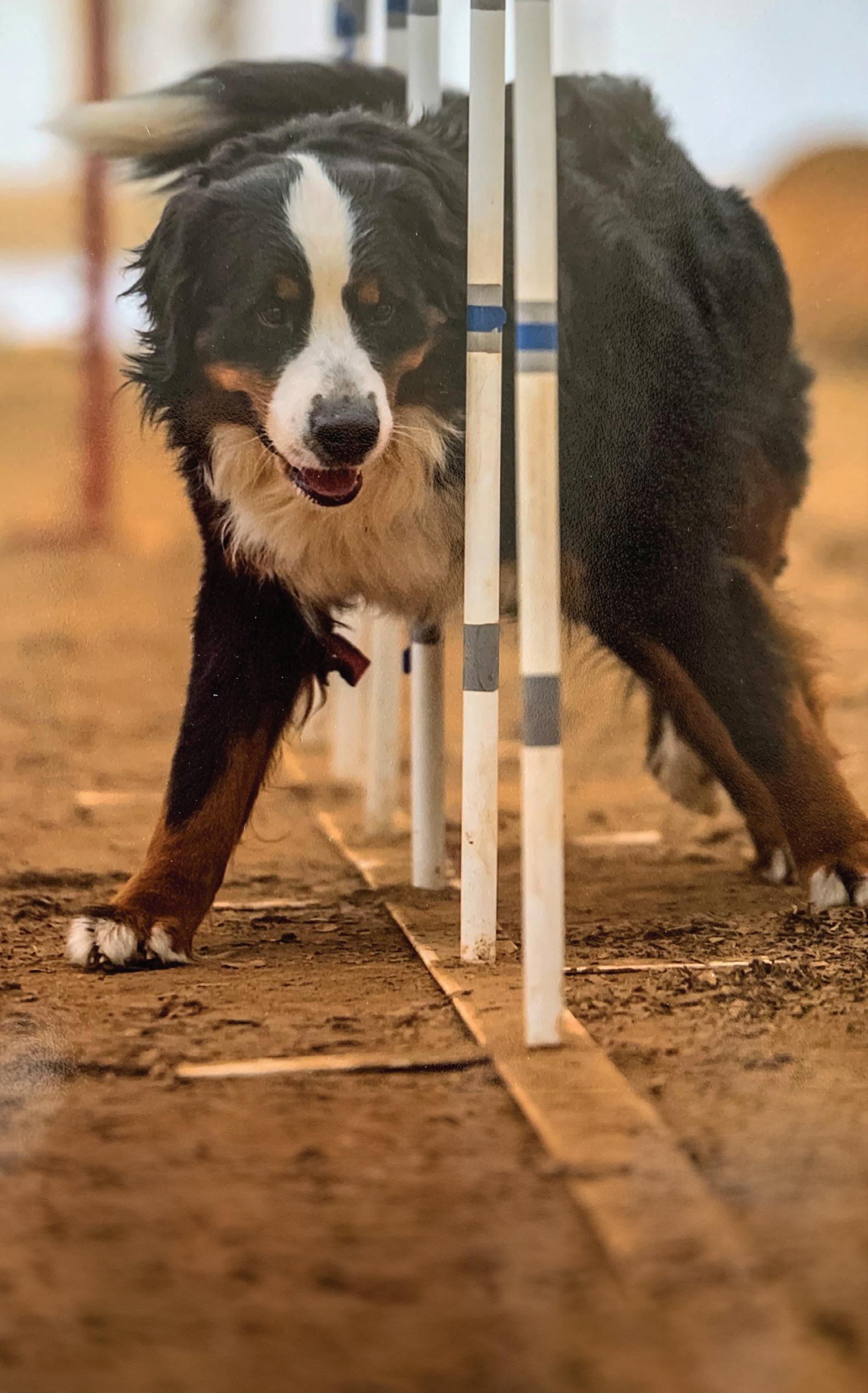
pet coverage in insurance benefit packages. Other organizations offer discounts via membership as well. Check with AAA, AARP, your veteran’s organization, and the insurance provider itself – there may be a discount available by virtue of insuring several pets.
Fulfill your duties of regular care as a responsible pet owner. This one, more or less, goes without saying,
but it is important to remember that insurance companies tend to operate by policy and not by the heartstring. We hear often that the insurance industry is driven by money, but the argument is moot; it simply would not be financially feasible to provide insurance guided by the heart. Policies are in place, and they require pet owners to provide wellness checks and preventative care annually. Reasonable measures may be defined company by company but be sure they are agreed upon and met so that payouts are not contested when injury or illness occur.
Pet insurance is not rocket science. There is a cost involved, and any cost these days does feel like a punch to the gut. And yet pet insurance is a risk/ benefit necessity for many of us. As veterinary costs and the cost of living continue to rise (as projected), it may be more important to the well-being of our dogs than ever before to ensure their health care is affordable for us.
Thank you to Heather Blakeman for taking the time to provide insight into the industry. While we don’t endorse any specific insurance company—there are dozens from which to choose— it’s beneficial to know that for those who breed with a commitment to ethical and conscientious practices, “Trupanion offers invaluable tools and resources available through its Breeder Support Program. This free program enables breeders to send puppies home covered from day one with its ‘Go Home Day Offer’ which waives waiting periods. In addition to providing informational kits for your puppy packs, Trupanion also provides data and insights on your own breeding program directly to you. Look for the Trupanion booth at Westminster and other shows throughout the states and learn more about signing up for Trupanion’s free Breeder Support Program online at https://trupanion. com/ec/breeder.”
For more information on pet insurance options in the US and Canada, visit The North American Pet Health Insurance Association at https://naphia.org/ find-pet-insurance.
SPRING 2024 ∙ 27
Francis (BG# 106343) demonstrating agility. Photo by Laura Rose Humes.
IS ONE THE LONELIEST NUMBER?
RAISING A SINGLETON
Raising a puppy is a lot of work. Fortunately, thanks to their dam and littermates, most puppies learn many lessons on appropriate canine behavior in the whelping box. Their siblings teach them how to play well with others and mom’s attention is amortized over the number of pups in the litter. But what happens if your new little one doesn’t have any littermates to
teach him how to share, and mom has no other pups to dominate her time? Raising a singleton can be a unique, and possibly challenging, experience. We’ve compiled the advice and insight from a number of seasoned, singleton stewards to help you raise your one-of-a-kind puppy.
SINGLETON CONSIDERATIONS
BY DAWN COX, BLACKROCK, BLACKWATER BMDS
How many times have we said, “I would rather have no puppies than one puppy?” I have said it many times. Singleton puppies are a challenge. Below are some things to consider initially.
Mom. Mom will be producing enough milk for a litter and we want to make sure she doesn’t develop mastitis. I feed her a normal diet without any additives that would encourage more milk production. On occasion, and if possible, I have been able to find another litter so additional puppies could be added so mom could feed more than one. This helps her and also the singleton. One time, I had a large litter and a breeder close to me had a singleton, we sent the boys over to the singleton and all was good. But that was truly a lucky break for everyone. If that is not an option, it is super important to make sure mom’s teats stay cool and soft.
Puppy. While the puppy is nursing, I put small stuffed animals in the box. (Years ago, my daughter Meredith collected Beanie Babies and they were the perfect size to snuggle in on either side of the puppy while nursing). This gives the puppy a feeling of littermates
and a sense of competition. As the puppy grows, I swap out the Beanie Babies for larger stuffies.
Weaning. When I have a large litter, I usually start the weaning process between 3-4 weeks to help mom. With a singleton I usually let mom decide when the weaning process should begin. She will usually let the puppy nurse a little longer, which is helpful in several ways. She can begin to discipline the puppy in ways that are usually difficult for her when there are many.
Socialization. This is crucial. With a large litter the puppies will self-discipline. The puppies will play with each other, vie for food and toys and teach each other how to behave. This is where finding other litters is helpful. I once had a singleton puppy at the same time as another breeder. We scheduled play dates so they could rough house with each other without the risk of injury. You can also try to let the puppy play with other dogs in the household, as long as it is supervised.
All in all, raising a singleton can be just as much work, if not more, than a regular size litter, which is why I always say better none that one.

SINGLET
ACE, THE SINGLETON
BY CANDY KONICKI AND JERRY HUGHES
Having a singleton pup definitely requires a different approach to raising a litter. First, it was a C-section, and, in our case, with a first-time mom. As it turned out, Carly was a good mom and cared for her baby immediately. We thought she’d lick the fur off of him! As he got older, she did play with him but as teeth came in that changed. We gave him stuffed animals from day one.
As a breeder, you need to focus on acting like a littermate. We would pull him off mom as he nursed like a littermate might do. We had to watch how much he nursed. A singleton can enjoy all the milk and can get pretty chubby. As he switched to a food bowl we took the bowl and pushed it away to let him work his way back in again acting like a littermate.
Ace was very independent and stubborn and did what he wanted to. He had not learned how to “play nice” and he would get very rough. We’d pull on his ears and tail and correct him with gentle shaking just like mom. He really needed to be taught how to play. Biting was his biggest issue and he could draw blood! We were fortunate we had other dogs. Cheers was 10 months older than Ace and he was a smaller dog so he made a good playmate for Ace. He was probably the best one to teach him exactly how it felt to get bit!
A lot of time was spent playing and training. He loved time spent with me no matter what we were doing. We were disappointed it was Carly’s only puppy ever, however, as “Hutch” (Dr. Robert Hutchinson, repro vet) said, “you never know, this singleton could be your Best in Show winner!”
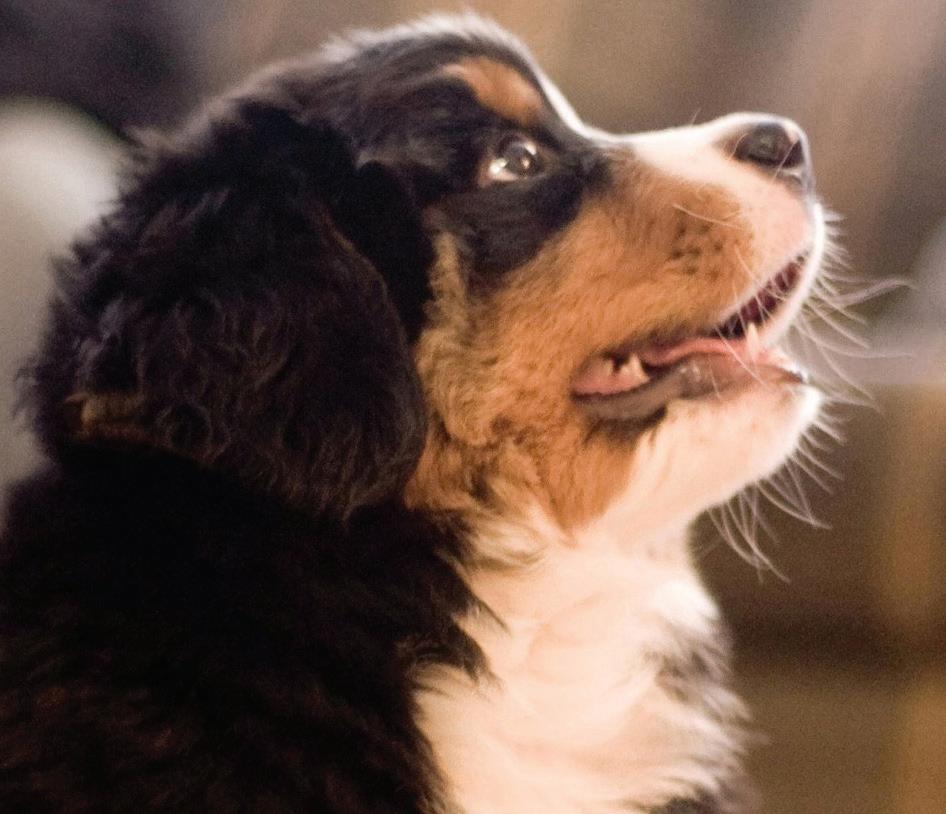
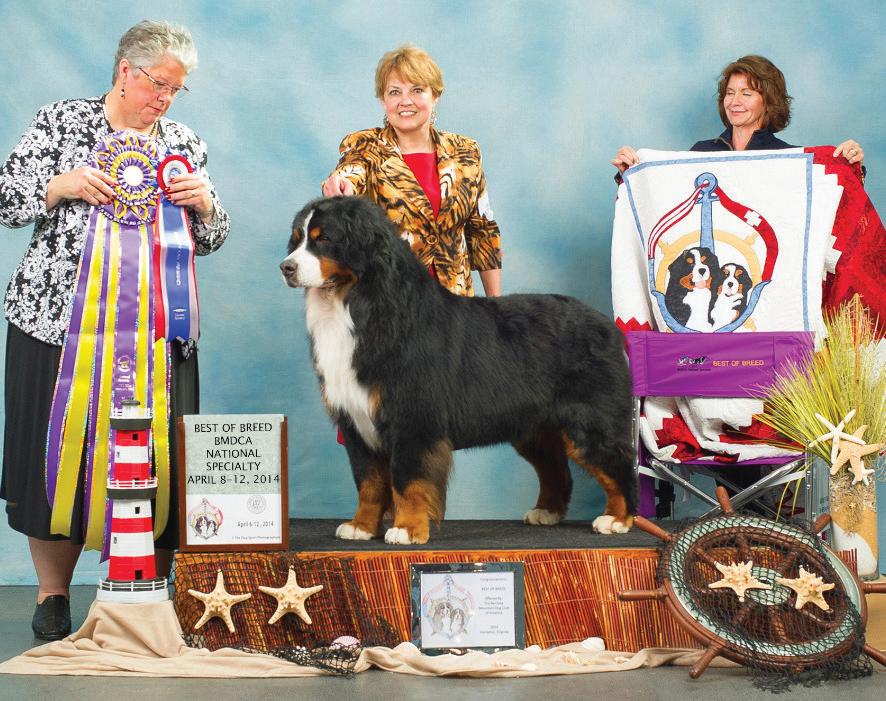

As a breeder, you need to focus on acting like a littermate.
SINGLET
NS
“Ace” (BG# 72452) was an independent and stubborn puppy!
Photo by Tom Atkian.
BIS BISS OHBIS GCHG/CKC BISS CH Little Mtn’s 1 Shot Deal From Windy Knob, “Ace” (BG# 72452) wins BOB at the 2014 BMDCA National Specialty. Photo by The Dog Sport Photographers.
BG Litter 60520. Photo by Dee McDuffee.
RAISING SINGLETONS
BY STACY SLADE
Raising singletons is fun! I love the bond I have with my singletons because I get to spend so much time with just one puppy; they basically become part of my pack. Early on there are a few things you need to do to help them out because they don’t have littermates.
Make sure you help them latch on to different nipples. I rotate them on the back 4-6 nipples to help mom out and to avoid mastitis. Sometimes they need help staying latched on since they don’t have littermates holding them up to nurse, I help hold them in place early on.
When mom’s milk drops, I make sure to add an egg crate topper, stuffies and blankets to the whelping box simulating littermates. This ensures that the puppy starts to learn to crawl over things, and to develop motor skills and muscle development. And, because they have free reign of the milk bar, it’s important to get them moving around the whelping box so they don’t become a swimmer puppy. They need to develop muscle and use their legs frequently.
The most important thing I have learned with singletons is to make sure to keep them warm on all sides. Laying them on a heating pad is not enough; that leaves three sides of the body exposed to cooler air. They need to be covered. I use small fleece receiving blankets to cover them, being careful to help mom in and out of the box as she may not see the baby. My singletons also spend more time in the warming box than regular litters do since it is easier to keep them warm in a smaller space.
At about 3 weeks old, I bring the puppy out with me in the main room to make sure they are socialized and part of the activity in my household. Of course, they are in my lap or arms and safe from the big dogs or they hang out with mom on the floor on a blanket, keeping their safety the priority.
It is important to ensure singletons have a lot of noisy interactive toys that have flashing lights or movement, to simulate littermates. Most of my singletons have had the opportunity to visit other litters of a similar age, regardless of the breed. It is good socialization for them to learn about other puppies, bite inhibition, touch, play and exploring with other puppies. It is important to remove the mom from the other litter as she may not be so keen on an interloper that doesn’t belong.
My singletons have been some of my favorite puppies! They can be more demanding and need more
At about 3 weeks old I bring the puppy out with me in the main room to make sure they are socialized and part of the activity in my household.
structure, consistency, training and boundaries set early. Without bite inhibition help from littermates it’s important to be on top of mouthing/biting. Placing singletons with experienced homes has been a priority to me so I know they have an experienced home to start them off right.
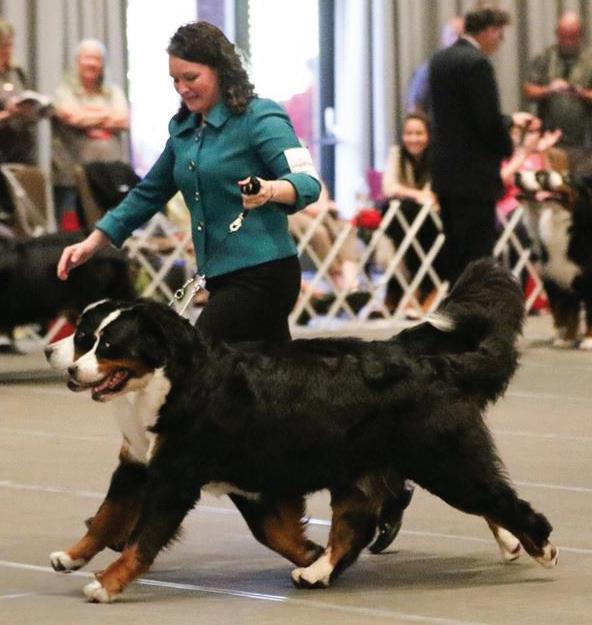
30 ∙ THE ALPENHORN
CH Sevens The Power of One, "Baron" (BG# 98588), GCH Sevens One in a Million CD RN NDD, "Tally" (BG# 73267) — two singletons (mother, son) together in perfect synchrony. Photo by Chris Stefanac.
MY TWO SINGLETONS
BY DEE MCDUFFEE, HAUSFUL BMDS
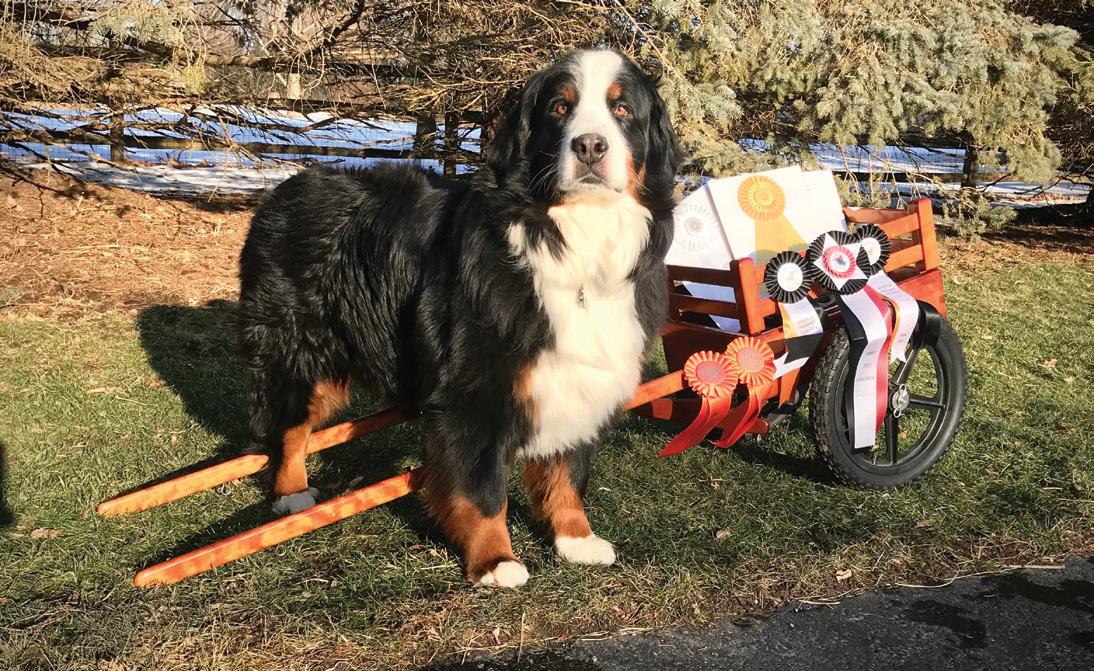
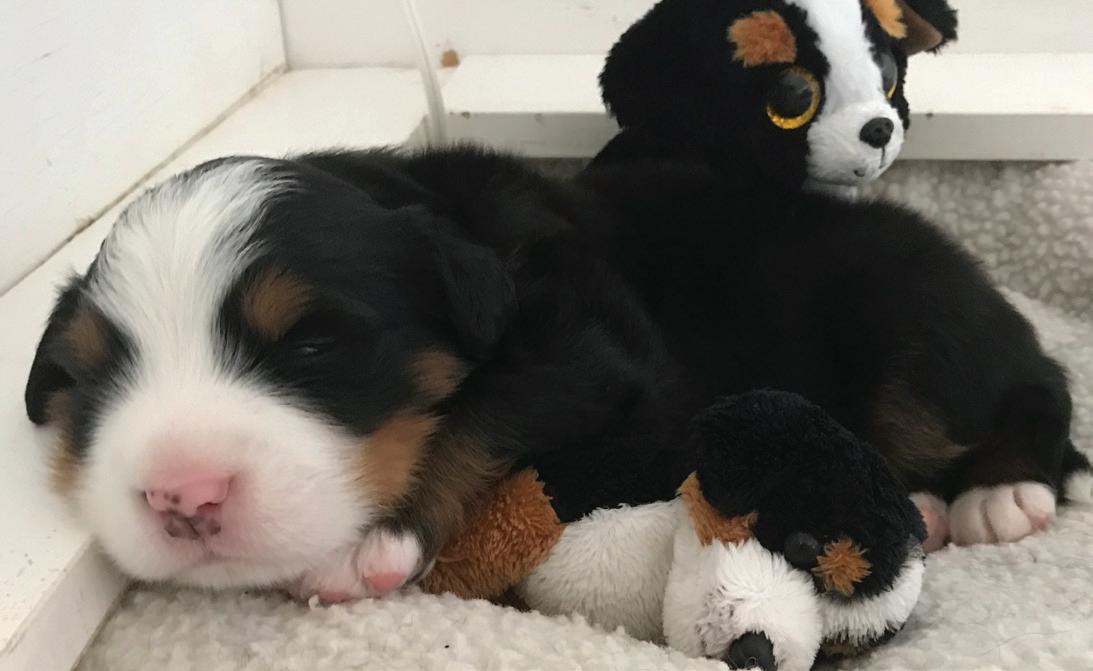
I’ve had two singletons to date and have used the same method with both of them! Although they matured to have different personalities, Vino grew up to be a multiple group placing, grand champion versatility dog and Caymus is his neighborhood’s favorite “big bear!”
When the singletons were born, and not with mom, I put them in a small fluffy cat bed with a lot of stuffed toys their size. The bigger they got, the bigger the
stuffed toys were. I rubbed the toys on my adult dogs to give them a different dog scent. When they were standing and moving around the whelping box (at approximately 2 weeks old), I started playing with them using the stuffed toys. When they were sturdy and strong (at approximately 5 weeks old), under a watchful eye, I put them with my adult dogs to play and be part of a pack. Socializing is very important, so I found people in my area that had puppies that were about the same age to have puppy play dates with.
KEEPING SINGLETONS
BY ANNETTE MCLAUGHLIN, HARMONY BMD
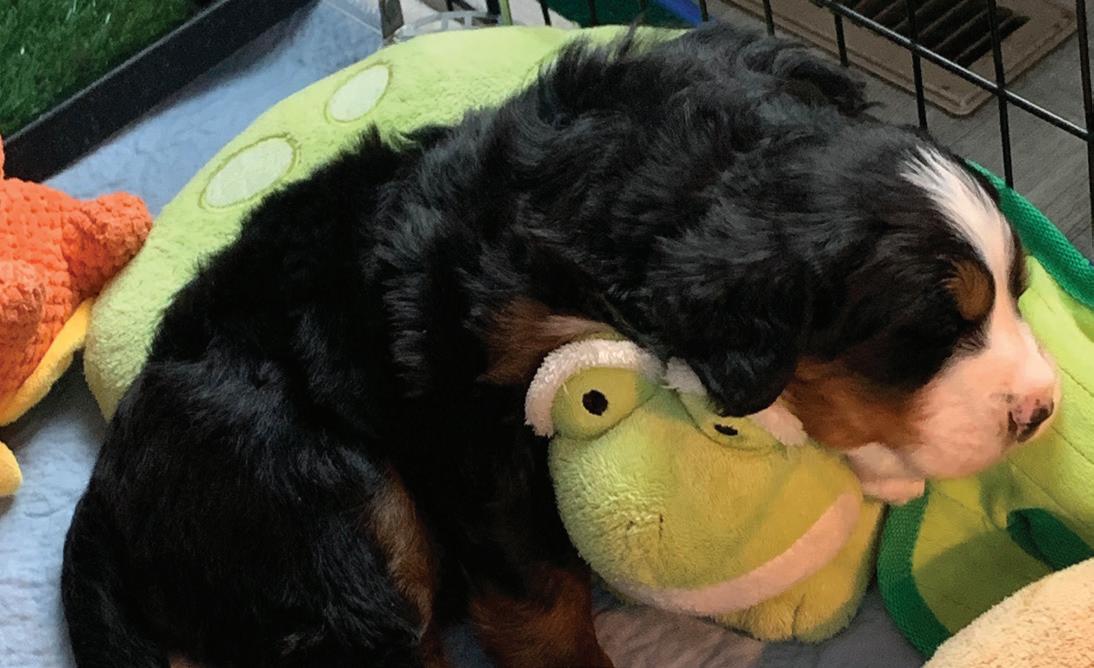
(BG# 209267). “When you just need a friend to snuggle.”
Photo by Annette McLaughlin.
I have been very lucky to have had only two singletons. Both I kept and both have been wonderful dogs!
One of the things I did was to be sure they had “siblings” to crawl over and cuddle with. These were stuffed toys, black socks filled with microwaveable warming bags/rice and warming discs. The puppy needs to work to get to mama and I would even move them as if they had been ‘knocked off’ the milk bar by
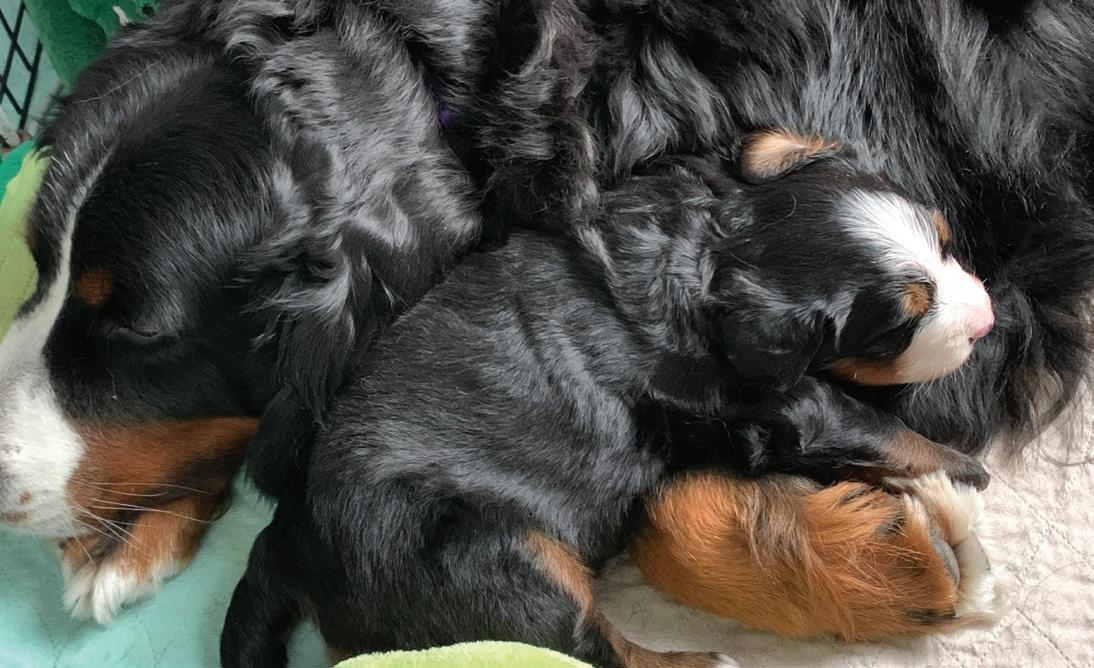
140794), “Mam’s
a sibling LOL. Singles can just get too chubby, so it is important they have to work for their meals when old enough. Be sure to rotate the milk bar too (or move puppy around) so mama gets emptied well. I also was lucky in that I had a young dog at the time I had each singleton so they became great playmates and were always so gentle. I also used lots of activity toys to feed at least one meal when older, again to make them work for it.
SPRING 2024 ∙ 31
Vino (BG# 123099). Photo by Dee McDuffee.
Chiffon
Caymus (BG# 166642). Photo by Dee McDuffee.
Patsy (BG#
girl.” Photo by Annette McLaughlin.
SINGLETON TIPS
BY STACY TEMPLES
A lot of people get worried when they find out there is a singleton coming. Singletons need to have extra socializing and stimulation, but because there is only one of them to focus on, it can be easier.
These are some of the things I do with an only puppy. Early on when the puppy can latch on and is nursing well, I place some soft stuffed animals in with the puppy along mom’s belly during nursing. This pushes a puppy to learn to move her body around the toys and find milk. You can exchange toys for larger “pretend littermates” as the puppy grows.
It’s important to keep a singleton warm when mom needs a break. I use the high-sided small round fluffy cat beds for puppies and the heated pink discs inside under a cover. When the puppy cannot be contained any longer, I will set this inside a laundry basket that has a heating pad in the bottom with towels on top of it. Later they will sleep and snuggle in the same bed as it goes wherever the pup does.
I carry my baby puppies around a lot when doing light chores, so they can experience different smells and rooms, and they also get to meet my other older dogs. Singletons get all the hugs and a lot of extra cuddling and bonding time.
Because they don’t have littermates, it’s really important for a single puppy to see other dogs and to play with other puppies (even if they are other breeds), so they learn that they are actually dogs. I start this when the singleton puppy is about three or four weeks of age and is starting to get up on their feet and move around. The puppy goes in a small pen (with a blanket and some toys) for short periods of time to start meeting the other family dogs. The other dogs can greet and visit through the pen and the puppy can watch the big dogs. Next, the single puppy will get to play in a small area with one or two safe, gentle dogs. It helps if you have a bitch (other than mom) that has strong maternal instincts. It’s a good way for a puppy to learn to share, and to learn manners. I also contact other breeder friends with puppies to arrange playdates so the singleton can chew and wrestle with other puppies and learn dog behaviors. A singleton needs to play and be with other dogs and puppies so they can learn how to act around dogs, and the correct ways to chew and bite and to communicate appropriate dog language.
There have been a few times when I had two litters overlap with one being a singleton, and the moms
would end up co-mothering both litters. In this case the cousins became littermates. If you do this, you have to work into it gradually when the pups are a little bit older and the mothers are completely comfortable.
When my last single puppy Summer was almost 5 weeks old, her first car trip was to visit a friend and her two puppy-loving old male German Pinschers. They were all equally fascinated with each other. She also got to roll in their plush grassy yard which I don’t have. I do take all my litters out on trips in the car but with just one puppy it’s a lot easier to get them out more often and to have more experiences and adventures.
I have raised eight singleton puppies over the past 30 years. Some have been show dogs and champions and some have earned working titles. They have all been well-loved family pets. With extra work, they have been well-adjusted and grew up to be normal dogs.
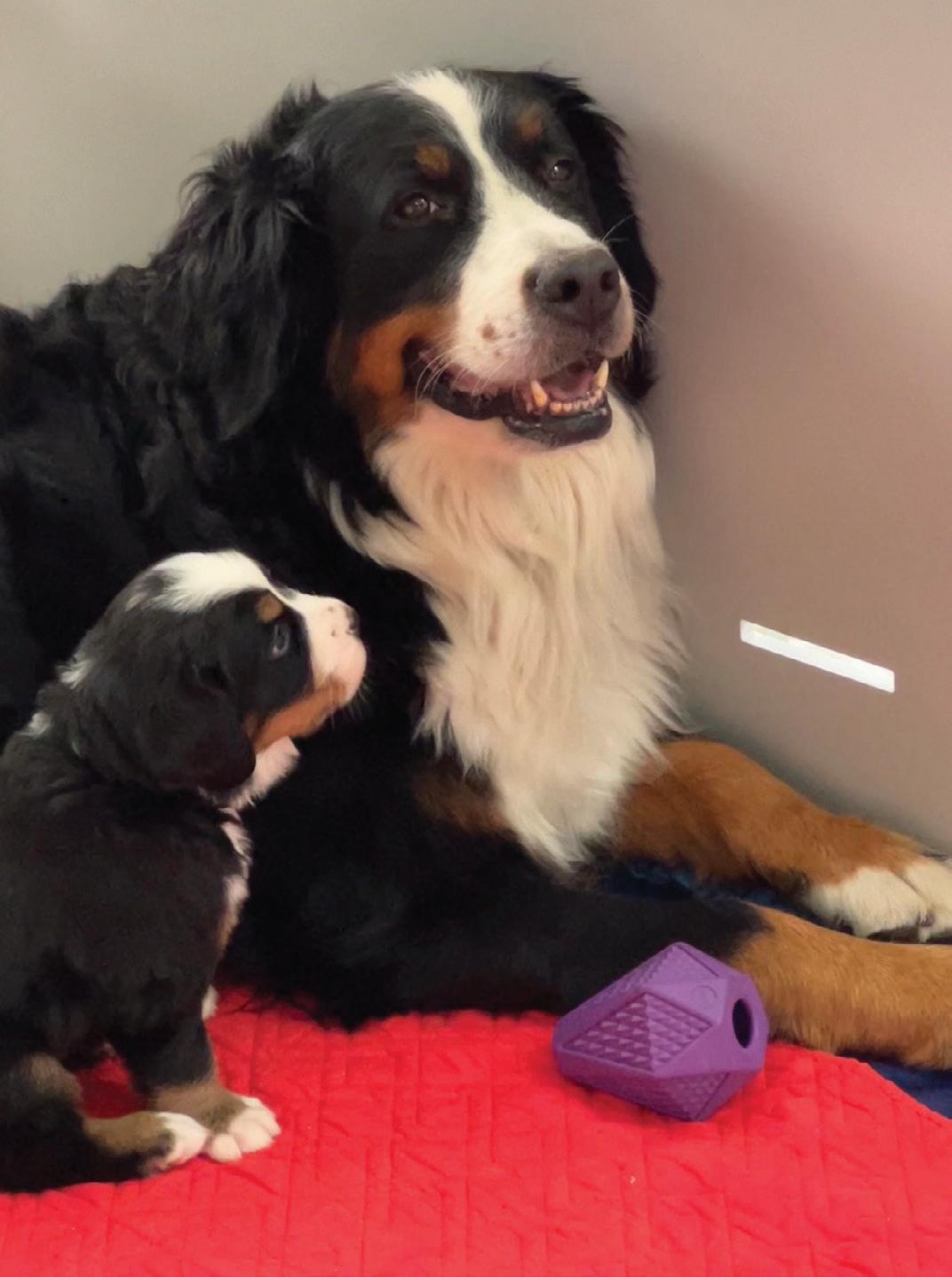
32 ∙ THE ALPENHORN
Lisle (BG# 156618) and Summer (BG# 206982). Photo by Stacy Temples.
THE INDOMITABLE MORK
BY ROBIN HAMME
Just before Christmas in 2013, the long-awaited call came that changed our lives. Our friend and Berner breeder, Fara Bushnell, had a puppy for us! She described this little girl as “very special” and added, “Oh, by the way, she’s a single.” Having heard worrisome stories about raising singletons, we asked Fara if she thought this puppy was a good match for us. I sensed Fara smiling with a knowing twinkle in her eyes when she simply replied, “Yes.” She ended the conversation by sharing that she’d named the puppy Mork in honor of Robin Williams who had just passed.
In early January I drove to Lexington, Kentucky, in frigid, stormy weather mentally musing to myself, “I wonder if this is a prelude of what’s to come.” Later that day I met Mork, who stole my heart. Simply put, she was a force. I’ve never encountered a puppy so self-assured, fearless, inquisitive, active and wickedly smart. She exuded an air of “bring it on.”
The next day, before Mork and I left for home, Fara shared two more tidbits about Mork. Her dam, call name O No!, had tired of Mork early on and Mork’s nursemaid, constant companion, and “partner in crime” was one of Fara’s beloved Australian Shepherds. My eyes widened a bit as I was taking that in. The second thing she shared was, “Do you really want to know why I named her Mork? It’s because she ain’t no Mindy!” I was now both forewarned and intrigued.
From the moment Mork arrived at our mountain home in Flat Rock, North Carolina, she presented us with endless experiences and challenges. In all our years living with Berners, we had never encountered such a dog. Mork knew few boundaries and nothing fazed her. I can remember Darwin, our almost 8-year-old Berner, looking at us with pleading eyes saying, “Can’t we just give her back?” It quickly became clear that we needed help and outside expertise to channel and develop this precocious, prodigy puppy.
IMMERSIVE “PEER” SOCIALIZATION
Being a singleton and raised by an Australian Shepherd, it quickly became clear that Mork needed puppy-to-puppy interaction and socialization. Lucky for us, our friends Dr. B.J. Parsons and Kristen Apodaca had a litter of English Setters not much younger than Mork. Several times a week Mork would spend the day with the English Setter puppies interacting and learning the ropes from her adopted brothers and sisters.
She exuded an air of “bring it on.”
EXERCISE AND EXPLORATION
Mork was tireless and always on the move – an Aussie trait. Just as her keen mind needed constant stimulation, her body demanded lots of exercise and adventure. It was clear that we had a “beauty or beast” situation. Opting for the beauty scenario, our daily routine included two lengthy trips down the mountain to our five-acre field where she could run, explore and just be Mork. The world was her oyster. A vintage Mork story was when she very intentionally flew off the bank of our pond into the frigid water below. Quickly ripping off my coat and boots so I could go in
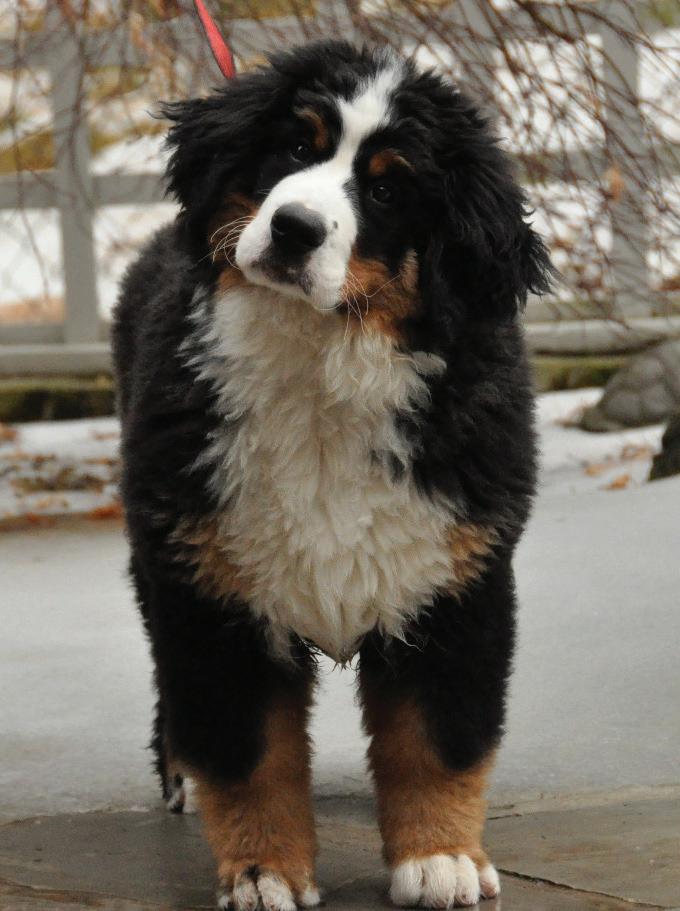
SPRING 2024 ∙ 33
Who doesn’t love an ice storm?! (3-month-old Mork). Mork (BG# 116071) BISS GCHS Can CH Ayehli’s Nanu-Nanu! BN RE TKI NDD JHD-s BMDCA Versatility Award. Photo by Robin Hamme.
after her and hope not join her in drowning, I noticed that she stopped thrashing about and swam to shore. After finding I hadn’t succumbed to a heart attack, I laughed, sputtered and cried. Darwin looked at me as if to say, “I told you.”
CHARM SCHOOL
Next, we needed to feed her insatiable need to learn and do. Kristen, who handled Mork to her Silver Grand Championship, worked with her several times a week in what we called “Charm School.” When Mork mastered the basics preparing her for the world of conformation, Kristen and Mork attended all breed conformation training classes. Before the 2016 National Specialty, Mork and Kristen had earned their Grand Championship and, at the Specialty, Mork and Kristen went Best in Futurity! Mork’s skill, presence, and potential boggled all our minds. We now needed to further expand her world – a realization that led us to performance sports.
UNLEASHING THE “INNER MORK” THROUGH PERFORMANCE SPORTS
Mork was the happiest and easiest to live with when she had a job (another Aussie trait). We teamed up with Kathy Case, our friend and terrific dog trainer, to see if we could fill Mork’s unsatiable need to learn new things and master them at increasing levels of complexity. Mork was never happier. Other than swimming, she loved everything and learned how to perform many sports expertly with focus and determination. Mork and Kathy became known as the “Rocket Girls” earning titles in Obedience, Rally, Draft and Trick Dog. We also worked with Erin Ledbetter to introduce her to Herding, which she absolutely loved. While she titled in sheep, her passion was ducks. Her style was more of a tight-eyed dog than a loose-eyed one, but again that’s no surprise given her Aussie upbringing. All of this culminated in Mork earning her BMDCA Versatility Dog Award.
SUMMARY
In short, while you need to meet every puppy where they are when they come into your life, this is even more true for a singleton. Mork’s unique early puppy life, combined with her extraordinary innate abilities and absolute need for challenge were at first overwhelming. Once we enlisted help and figured out how to channel and unlock the potential of this once-of-a-lifetime dog, our lives were forever changed. The love and joy she gave us are an ever-lasting gift.
While you need to meet every puppy where they are when they come into your life, this is even more true for a singleton.
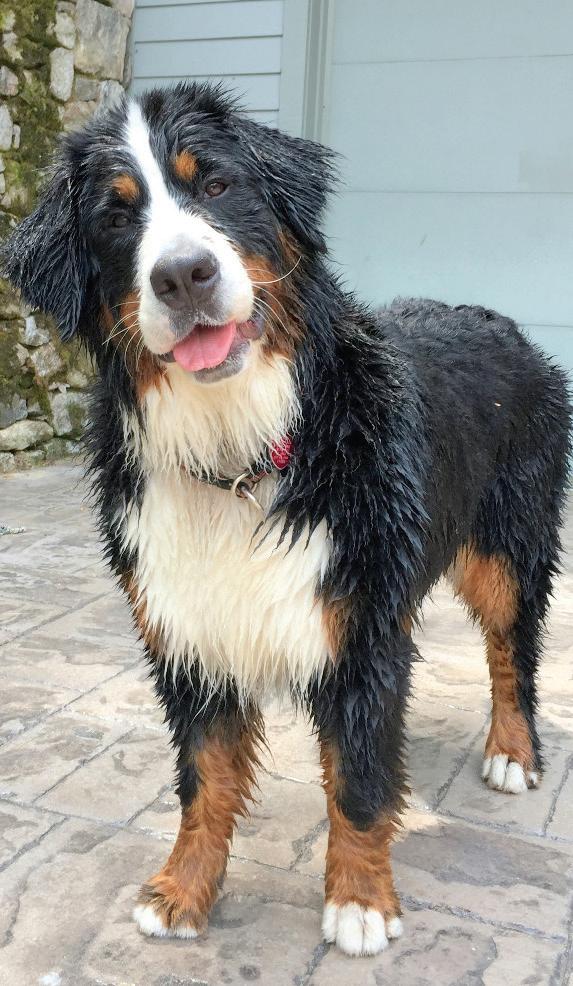
34 ∙ THE ALPENHORN
Mork (BG# 116071). Photo by Robin Hamme.
BMDCA TOP WINNERS NATIONAL OWNER-HANDLED SERIES WORDS FROM

The AKC National Owner-Handled Series is a popular, and competitive, method for non-professional dog owner-handlers to enjoy the sport of conformation dog showing. Here, we showcase several of the BMDCA’s top owner handlers, and their dogs, from 2023.
ADDY CUI AND EMMA: AN NOHS 2023 JOURNEY
BY ADDY CUI
As a dedicated owner handler, I have had the privilege of accompanying my Emma to numerous competitions over the years. Our commendable performance achieving OHBIS last year at the Oakland Kennel Club show stands as a testament to our collective efforts, an outcome which I regard with utmost satisfaction. Central to my approach is the earnest enjoyment of the entire show.
Emma, astutely attuned to my emotional nuances, mirrors my sentiments. Recognizing this, I endeavor to cultivate a serene disposition, envisaging each
evening exercises, I keep them short and interesting for her, thinking of them as a game. Beyond skill refinement, these sessions foster a profound bond between Emma and me, enabling seamless communication and collaboration.
Going to handling classes plays an indispensable role in our show preparation. They provide invaluable exposure to scenarios unattainable within the confines of home, acclimatizing our dogs to unfamiliar stimuli such as human touch and canine interactions. Mastery of these dynamics is pivotal, ensuring composure amidst the flurry of the competition arena.
I endeavor to cultivate a serene disposition, envisaging each competition as a routine training session.
and Emma OHBIS.jpg Caption: Addy Cui and GCHS
153617)
competition as a routine training session. At first, I was super nervous in the ring, always afraid I’d do something wrong, but that was not helping. I realized that I needed to calm down and relax. It is paramount that Emma perceives tranquility in my demeanor, thereby alleviating any apprehension she might experience.
Consistent and engaging daily training sessions are imperative. Emma's regimen entails morning and
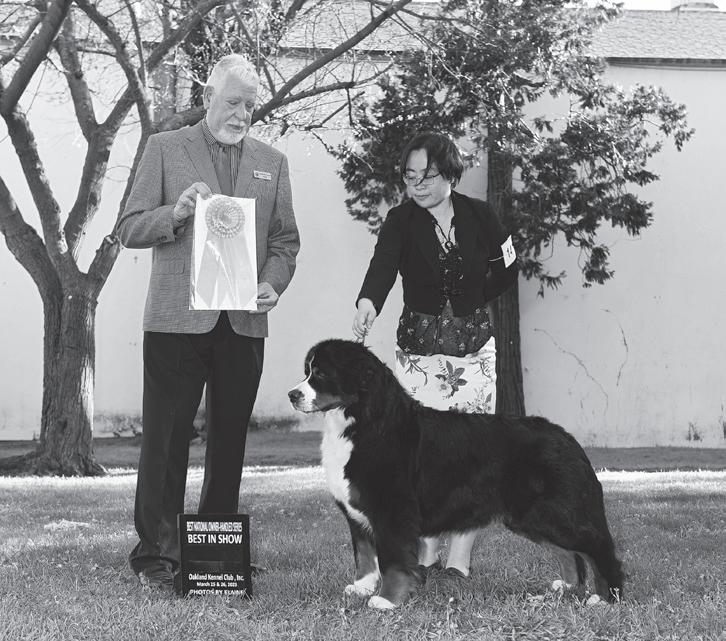
Guided by my mentor's wisdom, I prioritize Emma's enjoyment throughout our show time. It is a fundamental principle that underscores the essence of our participation. Moreover, I extend this ethos to fellow owner handlers, aspiring for them to embrace the joy inherent in the partnership between the handler and their dogs, transforming the show ring into a stage where camaraderie and excellence converge.
SPRING 2024 ∙ 35
Addy
Summers’ Anastasia Treasured Godiva, CD VD NDD (Emma, BG#
take Owner-Handled Best in Show at the Oakland Kennel Club show. Photo credit: Photos by Elaine.
SHERI WRIGHT-WAGNER AND ROARY: 2023 NOHS SERIES
BY SHERI WRIGHT-WAGNER
Roary is my very first conformation show dog and has taken me on the most incredible journey I could’ve ever imagined in the last few years. The first time I checked the box for Owner-Handled, I didn’t know how it worked and had no idea that in 2021, our first year trying it, we’d end up ranking third. In 2022 and 2023, we ranked as the #2 owner-handled team. When I first started, I found it difficult to compete against the professionals and have to say that the NOH series has more than once kept me from getting overly discouraged and giving up on showing. I have met some really great people who I compete with in the NOHS and have encountered so much friendliness and encouragement! Showing in the owner-handled group presents unique challenges, but I value the opportunity to practice and make great memories with my dog in the ring. Despite some VERY long days, (having once even shown outside in the dark with headlights shining on the ring), I have many funny and amazing memories, and more than one nap snuggling with Roary in the back of my van while waiting for groups!
One of the funnier stories was when a sudden judge substitution resulted in a Terrier judge officiating in the
the judge told her that “she wasn’t aware they came in short and long coats in that breed.” It left us both wondering what breed she thought our dogs were! We didn’t place that day, but it still makes me laugh and is just one of many great memories.
The AKC site does a great job explaining scoring in the NOHS, and it’s a lot less complicated than regular classes and groups. There are four levels of Lifetime Achievement in the series: Bronze (250 pts), Silver (500 pts), Gold (1,000 pts) and Platinum (2,000 pts). Roary and I have a total of 3,405 points to date, meaning we have achieved the highest level — Platinum. We have won Owner-Handled Best in Show seven times, Reserve Best in Show twice, and have 87 OwnerHandled group placements!
I am blessed because I have a magnificent dog on the end of my lead and that he’s the reason we’re here. Roary is my heart. I am very thankful to have made so many more wonderful memories with him and many new great friends in other very encouraging owner-handlers!
When I first started, I found it difficult to compete against the professionals and have to say that the NOH series has more than once kept me from getting overly discouraged and giving up on showing.
Sheri and Roary (BG# 149598). Photo by Gail Garand.
OH groups. When I stacked Roary to be examined and the judge turned to look him over, she kindly said, “My, these dogs are all just so big. I’m a terrier judge and don’t know a whole lot about these big dogs.” I replied nicely that I knew my standard very well and asked if she’d like me to explain to her what she should look for. She replied, “Well, maybe someday you should be a judge.” I said, “Hmm, maybe someday.” After I did our go-around, she examined the Swissy behind me, and when the owner came back to get in line she asked me what the judge said to me. I told her, and then she said
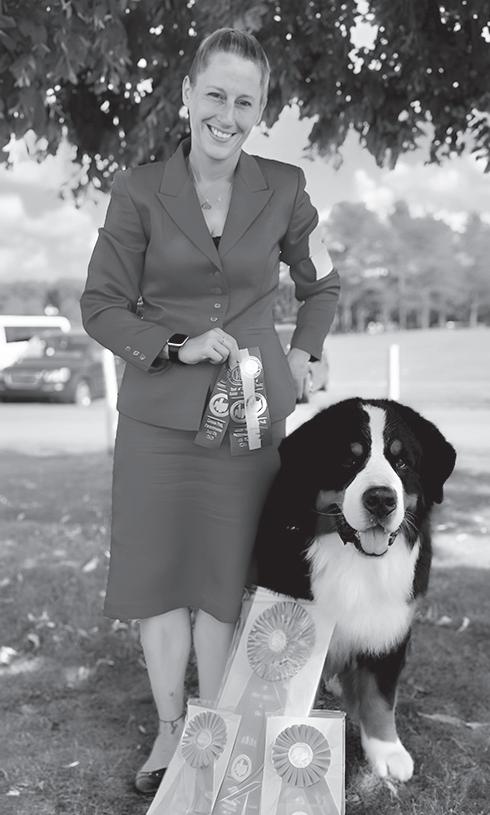

36 ∙ THE ALPENHORN
BETH DENNEHY AND ULLR: COMPETING IN THE NATIONAL OWNER HANDLED SERIES
BY BETH DENNEHY
The AKC National Owner-Handled Series (NOHS) is a great program for advancing your dog presentation skills, no matter what your current handling level is. As a novice or perhaps a new handler, who couldn’t use more time in any ring to practice? Advancing to the NOHS Working Group ring gets you and your dog in front of more judges and around more breeds of dogs. The camaraderie and support found amongst the ownerhandlers is surprisingly deep.
There are so many benefits to showing in the NOHS. The thrill of winning NOHS Best of Breed is just the beginning! Your next stop is the Owner-Handled Working Group ring where you’ll be competing with other breeds. Being invited to compete at the group level, by winning NOHS BOB, is where the education really begins.
Competing in the NOHS gives you and your dog more show ring experience in the group ring — a benefit for both the handler and the dog. Depending on where you live, you may not have access to training facilities, much less conformation dog trainers and classes filled
what is effective, and what to avoid (oh, no — skirt too short!). Learning about other breeds and watching other handlers close up will improve your own presentation skills and get you better prepared to compete in the regular Working Group.
Oftentimes, the NOHS group ring provides the confidence needed to enter the regular group ring. The crowd at the ring entrance can be daunting. Who should you follow and why? In NOHS you may learn where the Berner should (or shouldn’t) be in the lineup for the best visuals and finest performance. You also pick up on how important it is to be the best handler you can be, both physically and mentally.
Another positive aspect about the NOHS group is that often, you and your Berner will show under a completely different judge than the Breed judge you had that day — a bonus! — and for no additional cost, just your time and efforts. You will see different judging styles and preferences and sometimes different ring procedures, but it’s always worth staying for. The more judges you

One of the unforeseen joys found in the NOHS competition is the camaraderie amongst participants.
with various types and sizes of dogs. A lot of dogs aren’t around many different breeds at home and it is sometimes surprising to see their reaction. That boxer puppy who was enthralled with a Berner’s wagging tail — eye opening, cute and certainly precious!
NOHS provides a wonderful opportunity for us as handlers to learn more about the other dogs in the Working Group — at what speed do they move, how are their temperaments, etc. You also get to watch how other owners are handling their dogs, what you like,
can get in front of, the more you will learn about showing your own dog.
The NOHS group ring is a wonderful place to practice free stacks and maybe trying out a new pose, fun trick or method. You get extra bonding time with your dog — another bonus!
One of the unforeseen joys found in the NOHS competition is the camaraderie amongst participants. Grooming and handling tips are exchanged and
SPRING 2024 ∙ 37
acquaintances are made. Some stick around and cheer for their group winner in the NOHS BIS ring; many feel pride (and gain hope) when an owner-handler has success in the regular group ring. “It can be done! ” is a comment often heard with a big win by a fellow owner-handler. Your dog show friends just grew in numbers and became a whole lot more diverse.
Let’s not forget the prizes. Of your non-dog show friends, have any ever asked, “Do you win money?” Well, if you compete successfully in NOHS you may be able to answer, “Yes!” Of course, it’s not a lot of money and not often but it IS possible. Many clubs offer beautiful rosettes and some have designated NOHS awards or match the award being given for the regular group placements. The prize could be a chair, glass art, an embroidered towel or simply a flat ribbon commemorating the win. Big or small, whatever your prize is, it’s always special because you earned it with your dog.
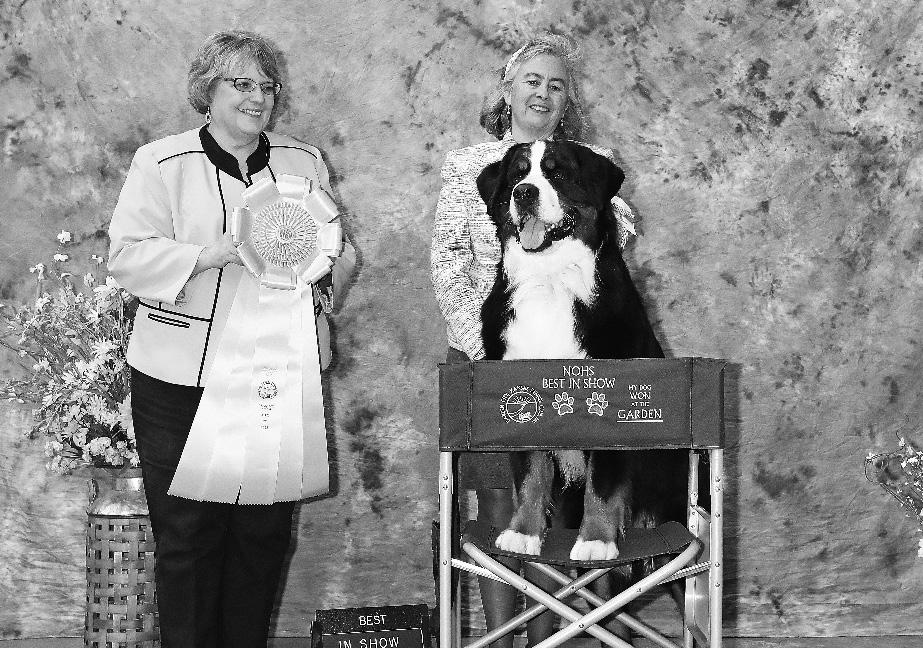
I highly recommend participating in the National Owner-Handled Series. I have been inspired and awed by many incredibly successful owner-handlers who have come before me. Get out there and “check the box” for NOHS. You’ll have fun with your dog, make new friends, win lots of prizes, and heck, you never know who you will inspire along the way.
About the Author: Beth Dennehy has had lots of fun as an owner-handler of “Ulli” (BIS GCHG Windfall Adesa
3 Wire Winter @ Emerald Mtn, CD RN FDC NDD), accompanying him to #1 Lifetime NOHS Berner. They finished 2023 #1 NOHS Bernese Mountain Dog, #2 NOHS Working Group, #25 NOHS All Breeds and #1 BMDCA Versatility Dog. Ulli has won 15 NOHS Best in Show placements and 8 NOHS Reserve BIS. Using her training in the National Owner-Handled Series, Ulli and Beth have also been successful in the regular Working Group, winning one All Breed Best in Show, multiple Best in Specialty Shows and over 30 group wins/ placements in 2022 and 2023. Ulli finished 2023 #2 Breed and #2 All-Breed for Bernese Mountain Dogs.
SASHA AND JODY: OUR NATIONAL OWNER-HANDLED SERIES JOURNEY OF 2023
BY JODY BOGDAN
Every year, the National Owner-Handled Series (NOHS) begins on September 21 and concludes the following year on September 20. Sasha started her first year of showing two months later, in November, at seven months. When showing our dogs, we all dream of a perfect debut. Usually, that would describe having a happy dog holding a stack followed by an easy gait around the ring. For Sasha, that perfect debut was so much more; it turned out to be the exciting first step of our journey in the 2023 NOHS. Over the ten months that followed, we found shared passions and formed new connections within the NOHS that would be unforgettable.
Sasha’s debut in the show ring and the NOHS began that same day in November. She started the day in the six-to-nine month puppy class and finished with her first Owner-Handled Best of Breed, accompanied by her first major and first Best of Breed win over specials. She was in the ring five times that day, marking the beginning of what would be an exciting year.
Over the next ten months, Sasha continued to enjoy showing, savoring special treats, travel and the many adventures of exploring new locations. We had amazing success, accumulating 27 NOHS group
38 ∙ THE ALPENHORN
BIS GCHG Windfall Adesa 3 Wire Winter @ Emerald Mtn, CD RN FDC NDD, “Ullr” (BG# 189433) wins NOHS BIS. Photo by DanPearsonPhoto.com
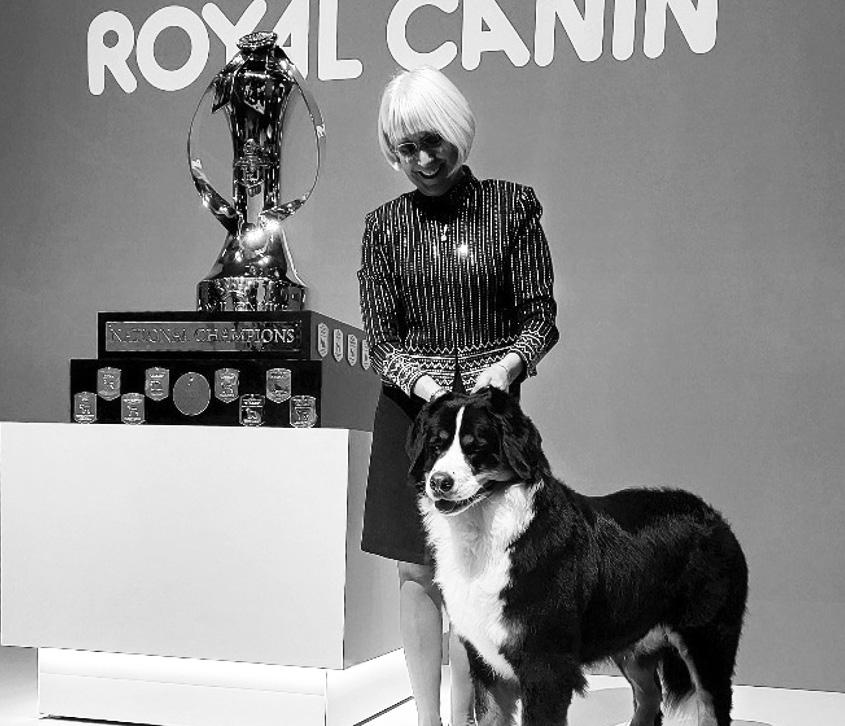
placements, including two Owner- Handled Best In Show awards, and the attainment of NOHS Bronze and Silver Levels of Achievement. At just 17 months, Sasha’s final ranking at the conclusion of the NOHS year was exhilarating – securing third place overall and the top spot among females, serving as a testament not only to her qualities but also to our partnership.
Sasha continued to achieve goals throughout 2023, earning her NOHS Gold Level of Achievement the following month, and her AKC Silver Grand Championship title in December. She concluded the year at the final show with a thrilling Best of Opposite win at the AKC National Championship.
While it was an amazing and memorable journey for us, beyond the accolades and the delight of placing in the group ring beats the heart of the NOHS experience—the camaraderie among participants. The NOHS group ring is a supportive environment where there are cheers for each other’s successes, and an opportunity to build connections with other owner-handlers beyond our breed that results in new conversations and ideas, offering a broader perspective on shared topics.
Our Berners, like Sasha, benefit from these connections as well. We all have witnessed the joy that our Berners have as they recognize each other from a distance. Many have their own BFFs, adding another
While it was an amazing and memorable journey for us, beyond the accolades and the delight of placing in the group ring beats the heart of the NOHS experience—the camaraderie among participants.
layer of excitement that is heartwarming. Embracing this, as well their interest in different breeds, stimulates the socialization of our dogs. For Sasha, in particular, forming a special bond with Sir, a Great Dane, brings delight every time she scans the crowd looking for him, and witnessing her joy when they meet up is touching. Knowing that Sasha feels more at ease when in the ring next to Addie, the Akita, adds a welcome layer of gratification. In the middle of the show environment, having a familiar and calming presence can make a significant difference for both dogs and handlers. It showcases the understanding that goes beyond the surface level of competition and is a welcoming layer of socialization for the dogs and us.
The growth of the NOHS group ring, both in the number of participants and the quality of entries, has been tremendous. Years ago, I participated in the NOHS when there were only small entries in each group. Today, to see that the NOHS has grown to numerous, beautiful entries in their groups is evidence of its success. This is where we, as owners, can compete on a level playing field, celebrating that special connection between ourselves and our dogs. While NOHS success still hinges on breed standards and quality presentation, the extra connection we have as owners is that sparkle of difference. Dressing for success, focusing on our dogs and savoring the moment creates an atmosphere where the love for our Berners shines through.
In 2024, the AKC is introducing a pilot program for regional NOHS events. Per AKC.org, “The AKC will approve up to eight all-breed clubs the honor of holding the first NOHS Regional Events around the country from September 19, 2024 through September 17, 2025.” Find out more at AKC.org.
SPRING 2024 ∙ 39
Jody and Sasha (BG# 209078) win Best of Opposite Sex at the 2023 NOHS Finals, Orlando. Photo by Mark Bogdan.
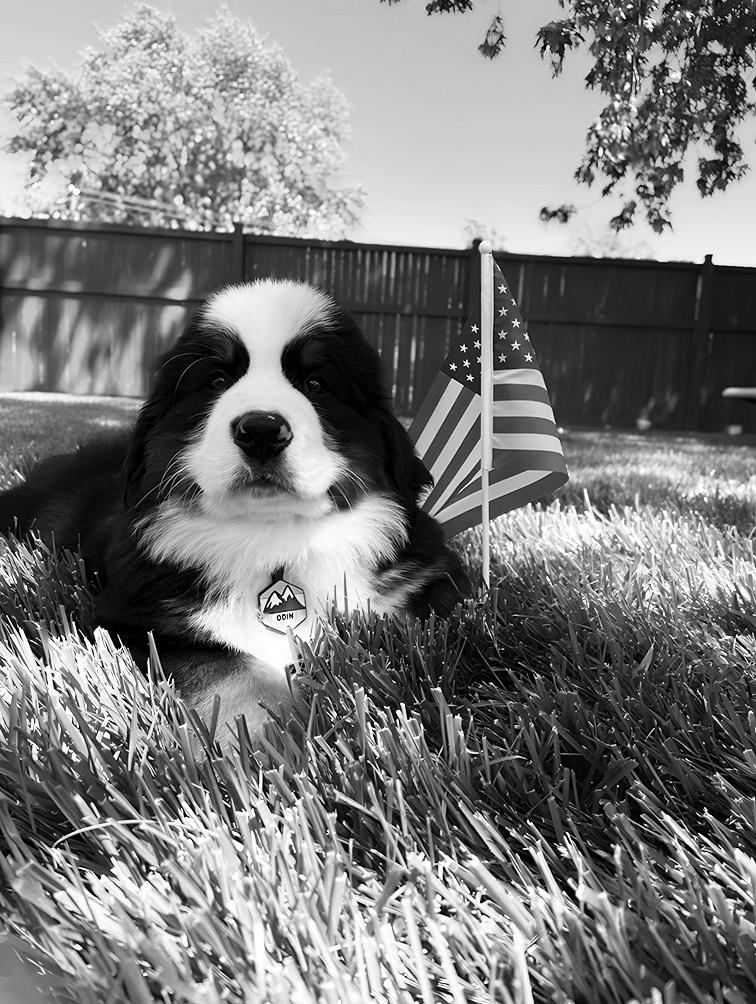
40 ∙ THE ALPENHORN
BG# 205037. Photo by Dee McDuffee.

SPRING 2024 ∙ 41
BG #178671. Photo by Annie McDannold.
WHEN YOU HAVE A UNDERSTANDING KNEE(D) TO KNOW:
CRANIAL CRUCIATE LIGAMENT DISEASE AND RUPTURE IN BERNESE MOUNTAIN DOGS
BY NANCY MELONE, PH.D. THORNCREEK BERNESE, AKC REG’D. EENDENKOOI KOOIKERS
So-called “spontaneous” cranial cruciate ligament (CCL) rupture is the most common orthopedic disease seen in dogs. CCL rupture repair is the most common orthopedic surgery performed by veterinary surgeons. For US dog owners, CCL rupture surgery represents the veterinary procedure of highest economic impact. For example, in 2023, a single-knee TPLO surgery with no complications cost ~$5,900 at a respected specialty clinic in Western Pennsylvania. Even a well-regarded non-surgical solution, a custom brace from Hero, can cost close to $1,000.
While not a breed at extremely high risk, Bernese Mountain Dogs suffer from CCL disease and ruptures. A quick search of the Berner-Garde database indicates that nearly 450 dogs have been identified by their owners as suffering from CCL disease (CCLD) or CCL ruptures (CCLR), with a number of those being bilateral (both knees). Similarly, in 2021, the Bernese Mountain Dog Club of Great Britain conducted a survey focused on cruciate ligament disease. The survey attracted returns from 592 BMDs, and of these 80 (13.4%) had some level of cruciate disease. Of these affected dogs, 52 (65%) had surgery. Around two-thirds were females and of these 91% were spayed females. These results are consistent with risk factors reported generally in the literature and elsewhere in this article.
WHAT IS CRANIAL CRUCIATE LIGAMENT DISEASE/ CANINE CRUCIATE LIGAMENT RUPTURE?
There are two cruciate ligaments, the caudal and cranial ligaments, that cross in the canine knee, forming an X (hence the label “cruciate” or cross). The caudal cruciate ligament attaches to the back of the tibia. The cranial cruciate ligament attaches to the front of the tibia. The two CCLs help stabilize the joint, but the cranial cruciate ligament is instrumental in stabilizing the knee in canines and the ligament most often injured. When the cranial cruciate ligament (CCL) tears, the knee joint is destabilized, wobbles, twists and slides. If there is a partial tear, the dog may limp. Once the tear is complete, the dog may refuse to put any weight on the affected leg. When this happens the sliding and movement of
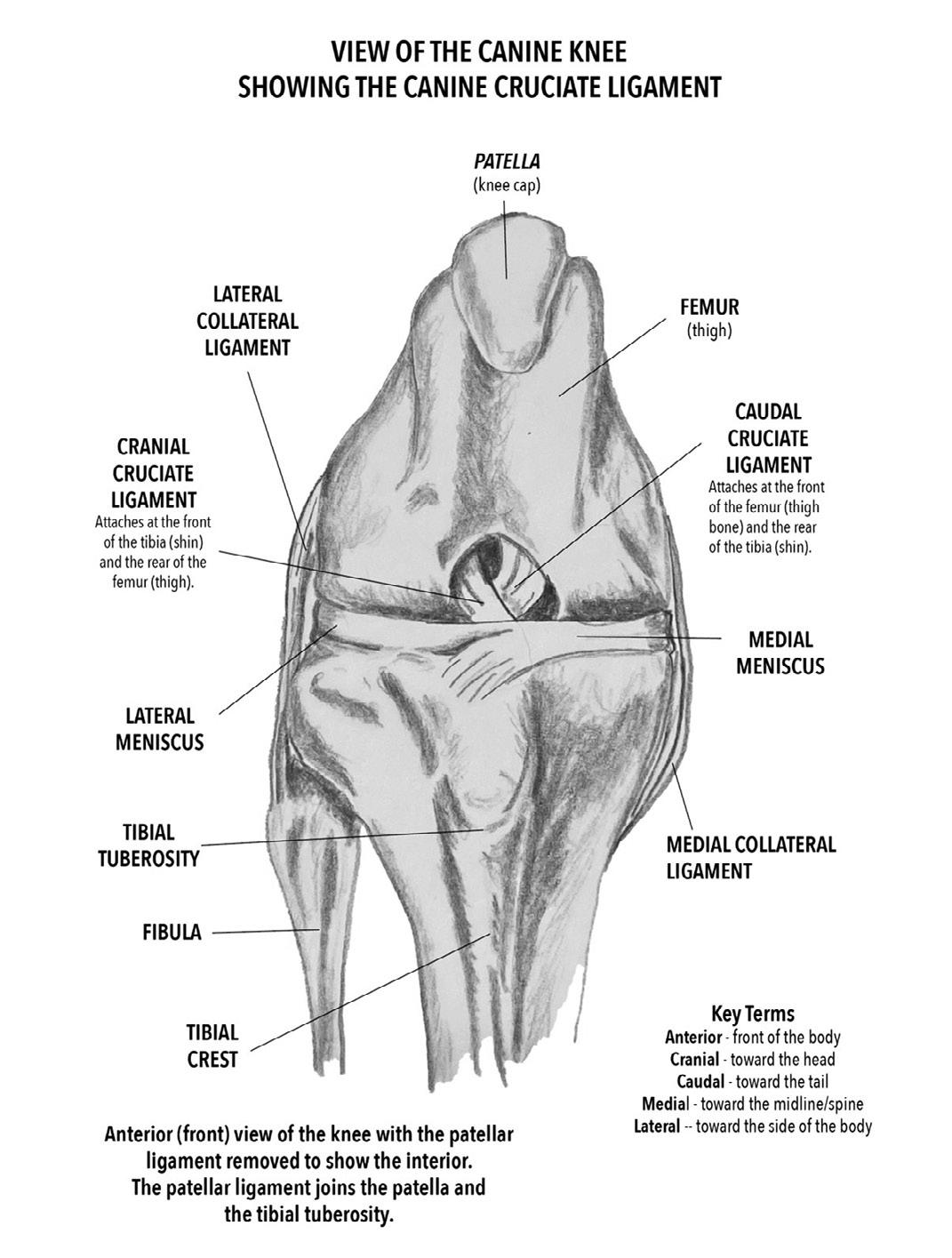
this misaligned joint causes more damage to the joint, including inflammation, pain and osteoarthritis.
Associated with these stifle injuries is the meniscus, a cartilage-like pad between the dog’s femur and tibia. Among other roles, the meniscus functions to absorb shock and bear load. When the CCL is ruptured, the meniscus can be damaged. More often, it is damaged after prolonged instability of the stifle joint. Without the support of the CCL, the femur puts abnormal pressure on the meniscus which can tear or shred it.
The CCL in dogs is often compared to the ACL in humans. While the comparison is useful, the course of the disease in humans and dogs is quite different.
42 ∙ THE ALPENHORN
The canine stifle.. Artist: Nancy Melone.
CCL in dogs tends to degenerate over time until the ligament weakens to such an extent that it ruptures.
Specifically, CCL disease in dogs develops in more complex ways than does ACL disease in humans. ACL tears are usually spontaneous, occurring during sports activities where there are sudden stops or abrupt changes of direction such as in basketball, skiing, hockey, or football. In contrast, the CCL in dogs tends to degenerate over time until the ligament weakens to such an extent that it ruptures (i.e., partial tears become complete tears). The degenerative condition in dogs is called cranial cruciate ligament disease (CCLD). The tear itself is referred to as cranial cruciate ligament rupture (CCLR). The degenerative nature of the disease in dogs in which both limbs are often affected also distinguishes the canine disease from that in humans.
WHAT ARE TYPICAL SYMPTOMS OF CCLR?
When a dog exhibits rear lameness, a CCLR is a reasonable diagnostic hypothesis. Symptoms the dog owner may notice include, but are not limited to, the following:
• hind leg lameness
• muscle atrophy on the affected leg
• reluctance to put weight on the limb
• lifting the limb or holding it to the side
• swelling around the knee
• clicking sounds when walking
• decreased range of motion
• reluctance to exercise
• stiffness after exercise
WHICH DOGS ARE AT RISK OF CCLD OR CCLR?
CCLD/CCLR can occur in many breeds of dogs. Large breed dogs are at higher risk than smaller breed dogs. Active, poorly conditioned dogs are at greater risk. Akitas, American Staffordshire Terriers, Chesapeake Bay Retrievers, Labrador Retrievers, Mastiffs, Newfoundlands, Rottweilers and St. Bernards are breeds that seem to have higher than average risk. All large breed dogs, including Bernese, are susceptible to the disease.
Although the exact cause of CCLD is still under investigation, researchers have looked at various risk factors that may predispose dogs to CCLD. Current evidence points to a complex interplay among conformation, genetics, environment and the mechanics of how a dog moves.
Risk Factors
Risk factors for CCL injuries/disease include the dog’s breed, neuter status, weight, ligament age and activity. Risk factors are typically correlations that are suggestive of cause, but correlation does not identify the direction of a causal linkage (i.e., depending on the factor, it could be a cause or an effect).
Conformation
Conformational risk factors, depending on the breed, are a steep tibial plateau angle (greater than 30%) and narrow relative width of the tibial tuberosity. An associated risk factor for developing an increased tibial plateau angle is sterilization under 12 months of age.
TYPICAL SYMPTOMS OF CCLR
Clicking
Decreased range of motion Reluctance to exercise Stiffness after exercise SPRING 2024 ∙ 43
01 02 03 04 05 06 07 08 09 Hind leg lameness Muscle atrophy on the Reluctance to put weight Lifting the limb or holding affected leg on the limb it to the side Swelling around the knee
sounds when walking
RISK FACTORS FOR CCL INJURIES/DISEASE
Females (an 8% increase) are affected by sterilization more than males (a 5% increase). This tibial plateau angle risk is made much worse by another associated risk factor: overweight.
Sterilization Status
Intact females are twice as likely to develop CCL as intact males; neutering both sexes increases the risk of CCL, but obesity in neutered animals might confound this sterilization risk since sterilized animals are more often obese. Obesity overall increases the risk of CCL by four times. Heavy body weight, whether as a normal feature of the large breed dog or linked to obesity, also increases the risk of ligament failure.
Age
Age is a risk factor in most degenerative joint disease and CCL is no exception. On average, this risk peaks around 8 years old but breeds with a higher prevalence of the disease (e.g., Rottweilers, Boxers) tend to develop ligament degeneration earlier in life.
Physical Fitness
Physical exercise and athletic build are negative risk factors. Dogs that are fit are at less risk. In contrast, dogs that are erratically active but not well conditioned (a canine version of the “weekend warrior”) or dogs in poor physical condition are at increased risk of cruciate injuries.
Genetics
Breed is strongly related to a tendency for CCL injury/ disease, which suggests a possible genetic link. There have been several genes recently identified in dogs with a high risk for CCL ruptures. These genes are related to collagen strength and stability and are involved in extracellular matrix formation. In contrast, another study found no difference in gene expression in dogs with and without CCL disease/ruptures. A third study found another set of genes that were identified in tibial plateau
slope formation and in developing a compressed infrapatellar fat pad, which is a surrogate for stifle osteoarthritis and CCL rupture.
More recently, researchers at the University of Wisconsin (UW) have suggested a genetic mode of inheritance in Labrador retrievers and Newfoundlands. Funded by a grant from the AKC Canine Health Foundation, UW researchers compared DNA samples from more than 1,000 Labradors, some of whom had CCLR and others who were clear. No single gene was responsible for CCLR, rather CCLR appears to depend on thousands of genetic variants. Taken together these variants account for a 62% risk that the dog will develop CCLR in its lifetime. The other 38% depends on environmental influences such as the dog’s weight, physical fitness and other unknown factors. From this work, a genetic test was developed for Labrador retrievers to predict the likelihood that a dog would develop CCLR in its lifetime. While the test is expensive (~$250), it has the potential to be useful in identifying dogs at risk for whom early interventions might be beneficial and in guiding breeding decisions.
These same researchers are currently developing genetic CCLR risk tests for both Rottweilers and Newfoundlands following the same approach used in Labradors, an approach that could be used for other complex disorders. Currently, we do not know the mode of inheritance for CCLD in Bernese Mountain Dogs.
Reduced Vascular Structure in the CCL in Adult Dogs
Microscopic studies of tissue structures in the cruciate ligament show that a young dog’s cruciate ligament contains many blood vessels. Interestingly, at about a year, the blood vessels in the young dog’s CCL disappear, with often only a single blood vessel left. In some dogs there are no blood vessels. Researchers hypothesize that the lack of blood supply to the ligament in adults causes the ligament to fail to regenerate and heal when it is injured. Indeed, researchers found that in examined torn ligaments,
01 Conformation Sterilization Status Age Physical Fitness 02 03 04 44 ∙ THE ALPENHORN
there was both degeneration of the ligament and indications that the ligament had repeatedly tried and failed to heal the tear.
Osteoarthritic Changes
It is rare for ligaments on both knees to rupture simultaneously, however it is common for the CCL on the second knee of a dog to rupture after the first knee rupture. One study reported that around 33% of dogs with a CCL rupture on one knee experienced a rupture on the other knee within a year after the first rupture. Other studies have reported up to 50% experienced a rupture on the other knee with a mean time of 2.5 years between the first and second rupture. When both knees (affected and unaffected) are examined for osteoarthritic changes, any changes in the unaffected knee are considered a risk factor for future rupture. This finding would also tend to support the ligament degeneration process as a risk factor in the aging dog.
HOW ARE CCLR AND CCLD DIAGNOSED?
CCLR is typically diagnosed through a physical exam and a cranial drawer test, which reveals instability of the joint if it slides. Any clicks coming from the joint suggest damage to the meniscus. While the CCL is not visible in an x-ray, they are often taken to look for signs consistent with CCL injury (e.g., joint fluid, cranial tibial displacement, osteoarthritis or bone spurs) and to rule out other possible causes of lameness (e.g., neoplasia).
Ross Palmer, DVM, MA, DACVS at Colorado State University, says that dogs with even subtle lameness tend to lean away from the affected leg while standing. Sitting is often uncomfortable which causes them to abduct the limb (move it away from the body) or shift it cranially (upward toward the head). Dogs with bilateral disease may shift their weight to their forelimbs while sitting or getting up.
Partial tears are known to be more difficult to diagnose because they often reveal cranial drawer instability only when the stifle is flexed. Palmer notes that fibrosis (scarring) or early-stage disease may prevent the detection of palpable instability. Thus, the absence of palpable instability does not necessarily prevent the clinical diagnosis of disease or its surgical treatment. Minimally invasive arthroscopic procedures may be used in diagnosing partial tears.
Dog owners must keep in mind that not all rear leg lameness is indicative of a CCL tear. Other possible alternative diagnoses include but are not limited to hip dysplasia, a ruptured disc, soft tissue cancer, tendon rupture, strains and sprains, a displaced kneecap, ruptured tendons, a bone fracture, osteochondrosis or panosteitis. A veterinarian will attempt to exclude these diagnoses while making a final diagnosis.
CONSERVATIVE OR NON-SURGICAL TREATMENTS
While surgery is generally considered the treatment of choice for restoring functionality, dog owners may choose to treat their dog conservatively or non-surgically for various legitimate reasons, including financial constraints, increased surgical and/or anesthesia risks, the advanced age of the dog, the presence of other medical, orthopedic and/or neurologic disease in the dog and/or the inability of the owner to provide extensive at-home care or supervision after certain surgical procedures. These alternative treatments have a role in managing CCL injuries for dogs who cannot undergo surgery.
Alternative treatments are varied and include but are not limited to custom braces, weight loss programs, stem cell and platelet-rich plasma injections, NSAIDs, corticosteroids, anti-inflammatory supplements, nutraceuticals, class IV low level laser therapy, therapeutic ultrasound, hydrotherapy, physical therapy and TENS/NMES.
Pennsylvania veterinarian, Janine Callen, DVM, reports that she has used PulseVet shockwave therapy successfully facilitating the healing of partial tears. She says that most people are not aware of shockwave as a therapy for CCLR, but it has several advantages over laser including higher energy output, deeper penetration, no risk of burns (it uses sound energy, not light energy), takes fewer sessions (2-3 vs. 10-15 for laser) and has documented results lasting up to 12 months. Several studies have been published on the use of shockwave therapies in treating human athlete injuries, including ACL injuries. The therapy has the advantage of few side effects.
Conservative treatments work best for partial CCL tears because it is sometimes possible for there to be enough scar tissue produced to make the joint stable again.
Ideally, we wish there were comparative studies evaluating the efficacy of these modalities, but there are few such studies. Those that do exist tend to be smaller, non-randomly sampled, survey-based retrospective studies. These characteristics make it difficult to generalize results to larger populations. One evaluative study was published in 2013 in the Journal of the American Veterinary Medical Association, “Short term and Long-term Outcomes for Overweight Dogs with CCLR Treated Surgically or Nonsurgically.” In that study, 40 overweight dogs with unilateral CCLR were randomly assigned to nonsurgical (physical therapy, weight loss and NSAID administration) or surgical (tibial plateau leveling osteotomy) treatment groups; dogs in both groups received the same nonsurgical treatments. Dogs were evaluated immediately before and at 6, 12, 24 and 52 weeks after initiation of treatments via
SPRING 2024 ∙ 45
owner questionnaires, gait analysis and dual-energy x-ray absorptiometry. Dogs in both groups improved, but dogs in the surgical treatment group seemed to have greater improvement. Dogs in both groups lost weight. Surgically treated dogs had a higher probability of a successful outcome (67.7%, 92.6% and 75.0% for 12-, 24- and 52-week evaluations, respectively) versus nonsurgical treatment group dogs (47.1%, 33.3% and 63.6% for 12-, 24- and 52-week evaluations, respectively). Overweight dogs with CCLR treated via surgical and nonsurgical methods had better outcomes than dogs treated via nonsurgical methods alone. However, almost two-thirds of the dogs in the nonsurgical treatment group had a successful outcome at the 52-week evaluation time.
Stem cell and platelet-rich plasma injections were evaluated in, “Partial Cranial Cruciate Ligament Tears
Treated with Stem Cell and Platelet-Rich Plasma Combination Therapy in 36 Dogs: A Retrospective Study,” published in 2016 in Frontiers in Veterinary Science. Thirty-six dogs were studied. For each dog in the study, researchers collected data on symptoms, medical history, physical and orthopedic examination, objective temporospatial gait analyses, radiographs, day 0 and day 90 diagnostic arthroscopy findings, treatment and outcome. A questionnaire, including the validated Helsinki chronic pain index (HCPI), was sent to owners whose dog was known to not have had a tibial plateau leveling osteotomy (TPLO). Stifle arthroscopy findings at 90 days posttreatment were available on 13 of the 36 dogs. In nine dogs, a fully intact CCL with marked neovascularization and a normal fiber pattern was found with all previous regions of disruption healed. One dog revealed significant improvement and received an additional injection. The remaining three dogs had a >50% CCL tear, and a TPLO was performed. Four additional dogs were known to have had a TPLO performed elsewhere. Baseline and day 90
posttreatment objective gait analyses were available on 11 of the 36 dogs. A significant difference was found between the treated limb total pressure index percent (TPI%) at day 0 and day 90 and between the treated limb and (unaffected) limb TPI% at day 0. No significant difference was found between the treated limb and other (unaffected) limb TPI% at day 90.
There is suggestive evidence that these modalities can contribute to healing, pain reduction, inflammation control and mobility. The advantage of these modalities is that they do not remodel the bone as does TPLO or tibial tuberosity advancement (TTA) or center of rotation of angulation (CORA)-based leveling osteotomy (CBLO). Instead, they typically address the ligament and surrounding tissues to improve healing or manage inflammation that leads to osteoarthritis, a risk factor for CCL tears.
SURGICAL TREATMENTS
Currently, surgical stabilization of the stifle joint is considered the gold standard for treatment of CCL ruptures. Surgery does not repair the ligament itself, rather it addresses knee instability and pain. Unlike human ACL surgeries, the dog’s CCL is not replaced with a graft because of the mechanical differences between the two species rooted in structural differences between bipeds and quadrupeds. None of these surgeries completely halts the development of arthritis within the joint, but surgical treatment is thought to produce better functional results than conservative (non-surgical) therapies alone. In contrast to suture-based surgeries, TPLO and TTA require specialized equipment and because of that they are usually performed in referral or specialty clinics. Proper post-operative management by the dog owner is critical in TPLO, TTA and CBLO surgeries since the bone must heal. If the meniscus is damaged it is typically
TYPICAL SURGICAL PROCEDURES RECOMMENDED FOR LARGE BREED DOGS WITH CCL
01
Extra-capsular
Stabilizing
Suture/Lateral
Fabellotibial
Surgery
Tibial Plateau Leveling Osteotomy (TPLO)
Center of Rotation of Angulation (CORA)Based Leveling Osteotomy 02 03 04
Tibial Tuberosity Advancement (TTA)
46 ∙ THE ALPENHORN
addressed by removing damaged parts or performing meniscal release of an intact meniscus during surgery. Meniscal release is still a controversial procedure.
Bone cutting surgeries, called osteotomy-based surgeries, work by changing the biomechanics of the knee joint. They change the way the quadriceps muscles act on the top of the shin bone. In tibial plateau leveling osteotomy (TPLO), this is done by rotating the slope of the shin bone. In tibial tuberosity advancement (TTA), it is done by advancing the attachment of the muscle. Most of these surgeries require extensive postoperative care including activity restriction and physical rehabilitation to obtain the best outcomes. About 90% of dogs undergoing surgery return to good or excellent function following surgery and correct post-operative care. According to veterinary orthopedic surgeon, Anthony Pardo DVM, MS, DACVS at Blue Pearl Pet Hospital, if there are complications, infection is the most frequent complication. It should be noted that dogs who are on any medication that suppresses their immune systems may not be good candidates for any osteotomy surgeries because they are likely to experience delayed bone healing.
Surgical procedures recommended for large breed dogs are typically one of these four procedures.
• Extra-capsular Stabilizing Suture/Lateral Fabellotibial Surgery
• Tibial Plateau Leveling Osteotomy (TPLO)
• Tibial Tuberosity Advancement (TTA)
• Center of Rotation of Angulation (CORA)-Based Leveling Osteotomy
Extra-capsular Stabilizing Suture/ Lateral Fabellotibial Surgery
This procedure tries to mimic the functions of the CCL by placing a heavy-gauge suture across the stifle joint in an orientation that mimics the normal CCL. The suture is placed on the outside of the joint (“extra-capsular”) around the fabella, behind the knee and through a hole drilled in the front of the tibia. Outcomes are very good in dogs weighing less than 30-40 pounds (and in cats). While it is possible to perform this procedure on larger dogs, the results are not as predictable and the suture is more likely to break. This procedure has the advantage in that it is considered easier for veterinarians to learn, is less invasive, does not require specialized equipment or training and is less expensive. As such, it may be more financially and geographically available to more dog owners. The disadvantage is that the suture can break in larger, active dogs.
TPLO (Tibial Plateau Leveling Osteotomy)
Currently, TPLO is considered by many experienced veterinary surgeons to be the most successful stabilization procedure for dogs regardless of their
size. It is distinguished by its success in large dogs. Unlike the previously described procedure that mimics the ligament, TPLO alters the biomechanics by changing the angle at which the femur bears weight on the flat area (plateau) of the tibia. The tibia has a natural slope. The healthy CCL prevents the femur from “sliding” down the slope when the dog puts weight on its leg. When the CCL is ruptured, the femur can freely slide down the slope. In a TPLO procedure, the tibia is cut and rotated to flatten the tibial plateau (the top surface of the tibia) and prevent the femur from sliding backwards. A plate is attached to the inside surface of the tibia to stabilize the osteotomy. After the bone has healed the plate is not needed but it is rarely removed unless there is irritation or infection.
Advantages over suture methods include superior results for both large and small dogs in terms of limb function and athletic mobility. There is also less arthritis progression. Disadvantages include the need to cut the bone and the rare possibility of revision surgery if the implant fails or the bone does not heal.
TTA (Tibial Tuberosity Advancement)
TTA, like TPLO, changes the biomechanics of the stifle joint to compensate for the abnormal forces placed on the joint when the CCL is injured. Instead of rotating the slope of the tibia as in TPLO, TTA changes the angle of the patellar ligament by cutting and repositioning the tibial crest where the patellar ligament attaches. This part of bone is moved a precise distance and stabilized using a titanium or steel plate and screws (see photo later in this article).
Advantages of this more recently developed procedure compared to the TPLO include a smaller, less invasive cut in the bone at an area that is not directly involved in weight bearing and earlier post-operative weight bearing. The primary disadvantage is the lack of longterm studies comparing this procedure to the TPLO and extra-capsular suture. Like TPLO, TTA requires cutting the bone and carries the rare possibility of revision surgery if the implant fails or the bone does not heal. While dogs tend to bear more weight on the limb earlier in the recovery period, dog owners must follow strict post-operative exercise restrictions with their dogs to achieve those results.
Center of Rotation of Angulation (CORA)-Based Leveling Osteotomy (CBLO)
CBLO is a newer tibial plateau leveling procedure that combines the advantages of both TPLO and TTA. The veterinary surgeon can do a tibial osteotomy without cutting the articular surface (i.e., the place where the femur and tibia condyles come together). Like TPLO and TTA, the cut to the bone is stabilized with a CBLO bone plate, locking screws and a headless compression screw.
SPRING 2024 ∙ 47
FOUR MAJOR CONSIDERATIONS TO PONDER WHEN MAKING CCLR TREATMENT DECISIONS
01 02 03 04
The health status and physical condition of the dog
The efficacy of the procedure at restoring functionality and reducing pain
Advantages of CBLO include the ability to add an extracapsular suture, excellent long-term functional results, normal long-term appearance of articular cartilage, rapid healing (6-7 weeks) and the ability to perform the surgery on very young dogs with open growth plates because the CBLO technique is less likely to disrupt these. CBLO is also beneficial in dogs with very steep angles in their knee joints before any surgery.
The primary disadvantage of CBLO is its cost and a lack of broad geographic availability. Not many veterinarians know the procedure currently, which tends to increase the cost of the procedure and decrease its availability. Like other osteotomy surgeries, CBLO involves a much stricter period of exercise rest, with greater potential for serious complications if this is not followed.
WHICH SURGERY IS BEST?
While suture methods are readily available, they are not as suitable or reliable for larger dogs as the more invasive surgeries. In contrast, CBLO is newer, but not broadly available or widely performed now. The two most popular and available surgical treatments for large-breed dogs now are TPLO and TTA. While several independent studies have been done to assess which is better (TPLO vs TTA), they have produced conflicting results. Moreover, many of these studies have design or sampling limitations that call into question some conclusions.
Faced with this confusing situation, researchers often use a method called “meta-analysis” that helps them understand complex phenomena when independent studies have produced conflicting findings. Metaanalysis is an objective examination of published data from many research studies identified through a databased literature search on the same research topic. Using rigorous statistical methods, meta-analysis often reveals patterns hidden in individual studies and can yield conclusions that have a high degree of reliability.
The availability and expertise of the veterinarian performing the procedure
The cost of both the procedure and follow-up
As such, meta-analytic studies often form the basis of much of evidence-based medicine in human medicine.
While we do not have a clear answer to the question of which surgical procedure is better, we do have a metaanalytic study published in the November 2022 issue of Frontiers in Veterinary Science. The article, “Surgical Treatment of Cranial Cruciate Ligament Disease in Dogs Using Tibial Plateau Leveling Osteotomy or Tibial Tuberosity Advancement–A systematic review with a Meta-analytic Approach,” written by researchers in the Department of Small Animal Medicine and Surgery, University of Veterinary Medicine Hannover, Hannover, Germany, analyzes 72 research studies on TPLO vs TTA published during the period 2016 to 2021. The techniques were evaluated using several surgical outcome measures: gait analysis (subjective), gait analysis (objective), osteoarthritis, thigh circumference measurements, goniometry (range of motion), joint stability, pain and complications.
The conclusions are that both TPLO and TTA are effective surgical treatments for naturally occurring CCL disease/rupture. Both approaches provide good outcomes and restore functionality and mobility. One caveat for both approaches is that long-term development of arthritis may be a consideration, and unfortunately there is little follow-up data available now to help the dog owner evaluate the arthritis risk. While there is no clear recommendation for one technique over the other, current evidence indicates that TPLO is preferred regarding certain complications such as surgical site infections. In a separate study, researchers felt that the TTA method might be easier than TPLO for veterinary surgeons to learn. Given the near equivalence of both procedures, the geographic availability of the procedure, the skill of the surgeon in the selected procedure and the infection rates at the hospital should guide your choice between the two.
48 ∙ THE ALPENHORN
Keep your dog fit with regular exercise.
HOW DO I MAKE A RATIONAL TREATMENT DECISION?
There are four major considerations to ponder when making CCLR treatment decisions:
1. The health status and physical condition of the dog.
2. The efficacy of the procedure at restoring functionality and reducing pain.
3. The availability and expertise of the veterinarian performing the procedure.
4. The cost of both the procedure and follow-up.
While surgery is typically considered the gold standard for treatment of CCLR because of associated progressive osteoarthritis, it is not irrational for dog owners to choose non-surgical treatments for various legitimate reasons, including financial constraints, increased surgical and/or anesthetic risks, the advanced age of the dog, the presence of other medical, orthopedic and/or neurologic disease in the dog and/or the inability of the owner to provide extensive at-home care or supervision after certain surgical procedures.
These treatment decisions are unique to each case, and the various options should be discussed in consultation with the dog’s consulting veterinarian. There is no one-size-fits-all solution for every dog. In that spirit, accompanying this article are the commentaries of several Berner owners who were faced with these treatment decisions, their rationales for what they eventually chose and their advice to others based on their experiences.
CAN I DO ANYTHING TO PREVENT CCL RUPTURES?
YES, YOU CAN! The risk factors mentioned previously point to some obvious ways to lower the CCLR risk.
• Manage the dog’s weight.
• Keep the dog conditioned and physically fit.
• Consider leaving the dog intact.
First, obesity is a manipulable risk associated with rupture. Fat dogs are four times more likely to develop CCL injuries than normal-weight dogs. Feed your dog a quality diet and maintain an appropriate weight based on his or her body condition score (BCS). An appropriate weight on a 5-point BCS scale is 3. Five to 6 is acceptable on a 9-point BCS scale. If you do
not know how to assess your dog’s weight using BCS, have your veterinarian teach you. Unlike a regular weight scale, BCS is an individual, dog-specific way to monitor the dog’s weight. For a quick overview of BCS, see https://www.aaha.org/aaha-guidelines/ life-stage-canine-2019/nutritional-assessment/bodyand-muscle-condition-score/ .
Second, fitness matters. Keep your dog fit with regular exercise. This does not require anything extreme. It can involve a combination of regular walks and leash-free exercise in safe, open areas. Avoid any exercise involving sharp turns, abrupt stops or sudden twists because these activities can aggravate a pre-existing partial tear from early ligament degeneration.
Third, decisions on sterilization should consider several factors, including the existence of CCLD in the dog’s breed or possibly in relatives in the pedigree. Intact dogs have a somewhat lower risk of CCLR than sterilized ones. These trade-offs should be considered and discussed with your veterinarian in making sterilization decisions and the timing of those procedures, if elected.
ACKNOWLEDGMENT:
I wish to thank the many Berner “friends” on Facebook from around the world who posted comments about their CCLR experiences. I am particularly grateful to Kelley Neill, Ethel Robles, Tanya Shields, Joyce Walter, Lynne Farrell Washburn and Sue Wilkinson DVM, who took the time to write up their comments formally for this article. I wish to thank my long-time friend and veterinarian, Lawrence Gerson, VMD, who always helps me better clarify my message to dog owners. As always, I deeply appreciate the best and most anal proofreader I know, Timothy McGuire, Ph.D., who daily puts up with my dog habit.
About the Author: Nancy Melone’s articles, published in several breed magazines here and abroad, have won numerous Dog Writers Association of America (DWAA) Maxwell Medallions, a Morris Animal Foundation Advances in Canine Veterinary Medicine Award and multiple American Kennel Club Publication Excellence Awards. She is Editor Emerita of The Alpenhorn and served on the boards of the Berner-Garde Foundation and Bernese Auction Rescue Coalition. Currently she serves on the board of the Nederlandse Kooikerhondje Club of the USA (NKCUSA) and chairs their Health and Genetics Committee. Her PhD is in Information and Decision Science from the University of Minnesota.
SPRING 2024 ∙ 49
A NON- SURGICAL BRACE EXPERIENCE
BDD AGNJ(S) TDX UTD SDN CGN, BMDCC Versatility Dog, BMDCC Working Dog, AKC
RN TDX CGC TKP, SDDA SDE, CARO RE VE WCRI WCRII WCREI (Syrrah)
Berner-Garde: #106352
Sex: Female
DOB: July 15, 2016
Treatment: Brace
Owner: Sue Wilkinson, DVM (Canada)
1. At what age was your dog diagnosed with cranial cruciate ligament disease?
My Syrrah tore her left CCL in March 2022 – she was 8 years, 8 months old at the time. A week previous I had come home and found her limping on her left hind leg. I (of course) went looking for cancer—all bloodwork and radiographs were normal, so we rested her and gave Gabapentin. Three days later my younger boy suffered a GDV, thankfully early intervention and emergency surgery saved his life, but I admit that Syrrah’s improving lameness got put on the back burner for a week. Then I saw her slip on the kitchen floor and come up non-weight bearing on the left, hind leg. I surmised a partial tear or strain, then the fall totaled it. I was relieved when I got a positive clunk of a drawer sign (it wasn’t cancer!!). Syrrah was diagnosed with aseptic meningitis (AM) when she was 9 months old (a littermate was also diagnosed around the same time). Remission was achieved and she was slowly weaned off prednisone. At 19 months old she came into heat (was scheduled for OVH (spay) following the heat). Unfortunately, the hormonal stress relapsed her AM. I took even longer weaning her off the meds. Monitoring bloodwork the following spring found compromised kidney function, which deteriorated within days, leaving her with a stable chronic renal failure, which we attribute to the long-term immune compromised state.
2. What factors did you consider in making your decision about how you would treat the disease?
When she ruptured her cruciate, I knew that surgery was not an option for her. She couldn’t have
NSAIDs due to her chronic renal failure (CRF), and if her AM relapsed she would need to go back on steroids—the risk of implant infection and failure was not something I was willing to risk. Because I am a veterinarian, this decision was a hard one for me—I wanted her fixed!
3. What treatment did you choose and how effective was it in restoring mobility?
I had a neoprene brace in the clinic with a hinged metal support rod. We both hated that, and it frankly was useless. I was hopeful it would tide us over until her custom brace was made. Alas, not to be. Thankfully by Easter we picked up her snazzy custom brace.
Syrrah did great with the brace. She tolerated it very well and her mobility, stifle stability, and muscling improved. She wore the brace all day, pretty much every day, for a good six months (I took it off at night). Then we had a sudden episode of anorexia (now 9 years old, for sure I was looking for the cancer again, and thankfully found none). She lost a ton of weight, and when I put her back on steroids she finally started eating again. It was then that I stopped using the brace. My decision to not pursue surgery for her knee was vindicated (we had three more such episodes). Last month I finally solved the puzzle; she had developed atypical Addison’s disease! She’s not making enough of her own glucocorticoids and needs a daily low dose of prednisone. She’s an eating fiend again and has no further clinical signs. She’s also now receiving Librela™ monthly for her resultant arthritis and has very good quality of life. She’s my first Berner to make it to 10 years; now we’re looking forward to 11!
50 ∙ THE ALPENHORN
Dog’s Name: MBISS(Alt) BIS(Alt) TDCH CH(Alt) Orloff Jungfrau Syrrah PCD CD RE DD
CCLR
TREATMENT EXPERIENCES
4. Given the treatment that you chose and its efficacy, what advice would you offer to owners of dogs with CCLD?
I would, and do, recommend custom braces for clients who, for whatever reason, are not willing/ able to pursue TPLO surgery. Consider the age
and activity level of the dog. For example, I saw a farm dog who had one TPLO and then ruptured the other. The owners were reluctant to spend the money but wanted the dog to be able to go riding with them again. She’s just 3 years old and a wild child. Surgery was their best option, and they eventually saw that.
A TTA EXPERIENCE
Dog’s Name: Sweetwater Farm’s Lucy (Lucy)
Berner-Garde: #125477
Sex: Female
DOB: April 24, 2014
Treatment: TTA
Owner: Kelley Neill (USA)
1. At what age was your dog diagnosed with cranial cruciate ligament disease?
My girl was 4.5 years old when she was diagnosed with a torn CCL.
2. What factors did you consider in making your decision about how you would treat the disease?
My local vet had a vet in the clinic that performed many CCL repairs. He did only TTA surgeries and was not an “orthopedic specialist,” but he performed TTA surgeries successfully weekly or at least rather frequently throughout his career. He did not do TPLO so that was not an option. If I wanted TPLO I had to go to Akron, Toledo or Cleveland. I believe my TTA was about $3,000. The TPLO at the other clinics was more like $4,000+ and I did not have insurance. So, my local vet was closer, and I was confident in his ability. The price played a big factor in my decision.
3. What treatment did you choose and how effective was it in restoring mobility?
I chose the TTA. It was a nightmare. She got an infection inside the joint. I had to take her back for surgery to have her surgically opened again to correct the infection problem. Of course, before this he had only had infection occur twice in all his previous surgeries. She healed but the meniscus tore. I can’t remember if we fixed that or if that got fixed at the time the infection issue was being fixed. At about the halfway point of her recovery, she tore the CCL on her other leg. I did not fix this leg—it healed on its own while she finished recovering from the first
surgery. She then was diagnosed with mammary cancer that spread to the lungs and died at 5.5 years old. It was a nightmare experience for me.
In contrast, my Labrador retriever tore both his CCLs at 6 months. This time we went to MedVet Toledo to a board-certified orthopedic surgeon (I believe that’s what she was). She was amazing. I had the TPLO done on his one leg at a year and the other leg healed on its own. He is 4 now and gets along fine. He runs and plays. The recovery from that surgery was so much that I couldn’t see putting him through it unless he was severely lame again; he isn’t. He might have arthritis when he is older, but the TPLO had no complications. It was great. I don’t know if this was just bad luck or the doctor or what, but I would not choose a TTA again unless I was educated on it from recently educated doctors in the various procedures.
4. Given the treatment that you chose and its efficacy, what advice would you offer to owners of dogs with CCLD?
My advice would be if the dog is over a certain age (I honestly don’t know that number as each dog is different) but probably 5 years old, I would probably choose a brace over a surgery. It’s a hard recovery and the people I have talked to have had their Berners heal okay from the brace. I have seen two heal okay while the other legs were healing from surgery so I can’t imagine it would get any worse with a brace for extra stability.
This is my experience. This was also my first Berner.
SPRING 2024 ∙ 51
TTA EXPERIENCES
Dog’s Name: Emma Alonso
Berner-Garde: Not in Berner Garde
Sex: Female
DOB: January 4, 2014
DOD: December 31, 2019
Treatment: TTA
Owner: Ethel Robles (Mexico)
Dog’s Name: Loretta de Neboa de Meigas
Berner-Garde: #155240
Sex: Female
DOB: October 2, 2015
Treatment: TTA
Owner: Ethel Robles (Mexico)
1. At what age was your dog diagnosed with cranial cruciate ligament disease?
One bitch was diagnosed at 15 months old. She tore only one knee, living to be 6 years old. My second bitch was diagnosed with both legs at 7 years old.
2. What factors did you consider in making your decision about how you would treat the disease?
TTA was the option I was given by the orthopedic surgeon.
3. What treatment did you choose and how effective was it in restoring mobility?
TTA in both cases. It works if we consider that both dogs lived/live a normal life, but the older one experiences some pain if she does a lot of exercise. While the surgery helped somewhat, neither bitch was restored to full mobility after the surgery.
4. Given the treatment that you chose and its efficacy, what advice would you offer to owners of dogs with CCLD?
Treat as soon as possible since the recovery of the surgery is long and requires a lot of care. One leg must be strong enough to support the dog’s weight while the other leg is healing. Give supplements such as chondroitin and glucosamine. Be patient since the recovery is hard for everyone. The dog must be crated for long periods of time; make sure the floor has enough traction to stand up and move—this is the same for any area where the dog must walk.

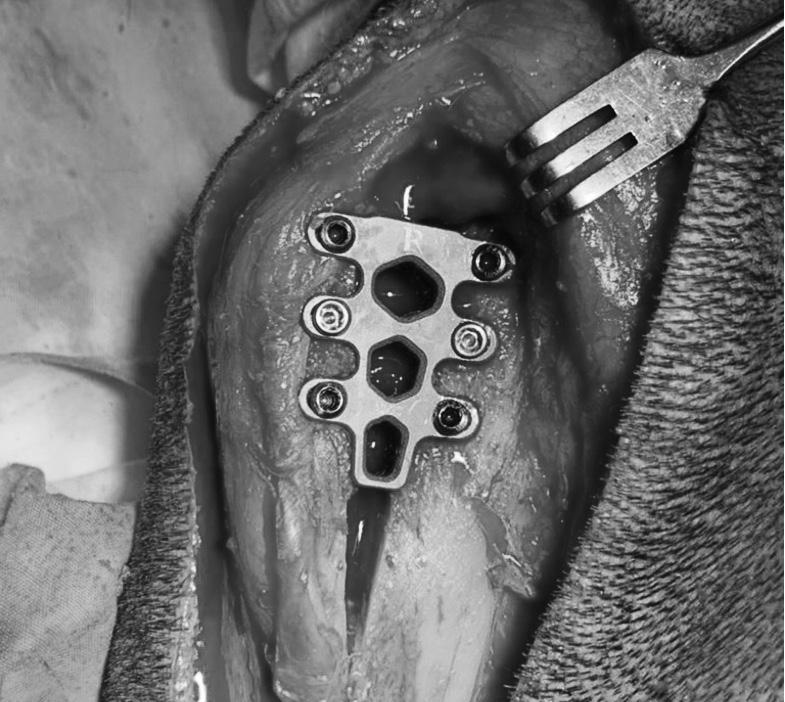
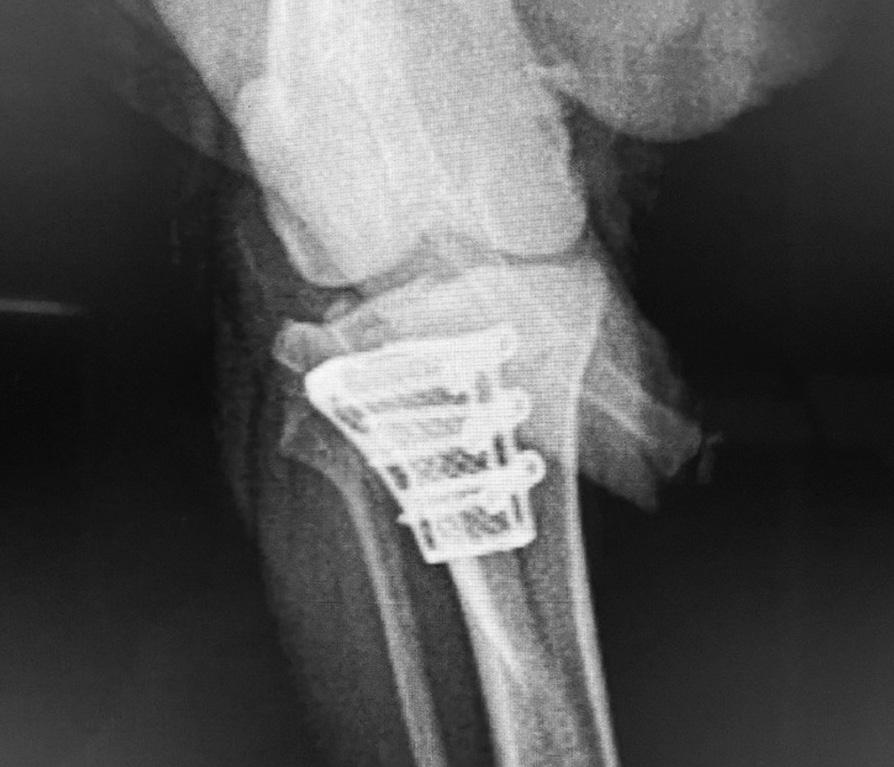
52 ∙ THE ALPENHORN
X-ray prior to surgery showing the angle of the femur and tibia.
Photo Courtesy of Ethel Robles and used with her permission.
TTA plate post-surgical placement. Photo Courtesy of Ethel Robles and used with her permission.
X-ray post TTA surgery. Photo Courtesy of Ethel Robles and used with her permission.
A TTA EXPERIENCE
Dog’s Name: Auseire How It Is.
Call name: Toby
Berner-Garde: #190679
Sex: Male
DOB: November 8, 2020
Treatment: TTA
Owner: Tanya Shields (Ireland)
1. At what age was your dog diagnosed with cranial cruciate ligament disease?
My dog was diagnosed with a tear at 2 years, 8 months old.
My boy was seen and operated on within the week. He came in from outside on Friday night toe tapping the leg. I booked a vet appointment for Monday morning. I was hoping he had just tweaked something and the rest over the weekend might have made a miracle recovery, but I had a good idea it was a cruciate tear. He was operated on that Thursday.
2. What factors did you consider in making your decision about how you would treat the disease?
We followed the orthopedic vet’s advice. Our dog had ruptured the cranial cruciate ligament, but his meniscus was still intact.
3. What treatment did you choose and how effective was it in restoring mobility?
We chose TTA and followed the prescribed rehabilitation plan. The surgery was done in July 2023. He was weight bearing on the leg straight away, and 3-4 months after the surgery he is basically moving soundly now.
4. Given the treatment that you chose and its efficacy, what advice would you offer to owners of dogs with CCLD?
For my dog TTA has worked very well. We followed the advice given regarding containing his space, the time and number of walks a day and the exercises to do and when to do them. He also had under-water treadmill therapy with some physio and laser. At the end of the day, every dog is different and in taking this step to operate on him we had to make sure we did the rehabilitation.
A TTA EXPERIENCE
Dog’s Name: Talk About Highlands (Haley)
Berner-Garde: #51338
Sex: Female
DOB: December 24, 2004
Treatment: TPLO
Owner: Lynne Farrell Washburn (USA)
1. At what age was your dog diagnosed with cranial cruciate ligament disease?
Haley was 6.5 years old when diagnosed. I remember her running through the yard at full speed up to the fence with the other five Berners behind. She came to an abrupt stop and was hit by two other Berners from the side. She yelped in pain, almost instantly becoming non-weight bearing on the right hind leg.
2. What factors did you consider in making your decision about how you would treat the disease?
Haley became non-weight bearing. She was the leader of my pack and was used to being active. I had no experience with the issue. My regular vet explained about a TPLO and referred us to VCA Buffalo Grove, IL. I also had a limited budget.
3. What treatment did you choose and how effective was it in restoring mobility?
I chose TPLO of the right cruciate. After surgery it was noted that it was totally ruptured. After following the detailed rehab instructions, including water rehab, Haley's mobility was completely restored.
4. Given the treatment that you chose and its efficacy, what advice would you offer to owners of dogs with CCLD?
I would recommend asking more questions and obtaining alternative opinions. In Haley's case, I feel I made the right decision. We led an active lifestyle, which she enjoyed, and this allowed her to continue to participate.
SPRING 2024 ∙ 53
TTA EXPERIENCES
Dog’s Name: Swiss Charm Chestnut (Chestnut)
Berner-Garde: #208236
Sex: Female
DOB: July 15, 2016
Treatment: TPLO
Owner: Joyce Walter (USA)
1. At what age was your dog diagnosed with cranial cruciate ligament disease?
First CCL tear, right leg
Chestnut originally started limping in April of 2017. She was treated with gabapentin and watched. In December 2017 she pulled up lame while running and had fully torn her CCL. We did not have surgery until very early January 2018
Second CCL rear left leg
Chestnut tore the left CCL in November 2021. She had it repaired very early January 2022.
2. What factors did you consider in making your decision about how you would treat the disease?
Chestnut has elbow dysplasia in both of her elbows, so we decided to have the repairs done to her knees so that at least the back two legs were functioning fully.
3. What treatment did you choose and how effective was it in restoring mobility?
Both legs were treated with TPLO surgery. The first surgery was done at Chesapeake Orthopedics and
the second one was done at Blue Pearl in Delaware. Both legs are doing great; however, the second leg is much better than the first. She recovered quicker and it appears she has better range of motion. The second surgeon had her up and moving earlier than the first. She had short walks in the yard after just two weeks and was on full walks by nine weeks. The first surgeon did not want even short walks in the yard until four weeks.
4. Given the treatment that you chose and its efficacy, what advice would you offer to owners of dogs with CCLD?
I would recommend this surgery to other owners, especially if they have any other mobility issues to deal with. As with humans, they have learned quite a bit about recovery methods and how important use of the repaired joint as quickly as possible can be. She did require no jumping, no real stairs (we had one to get in and out of the house which the doctor was okay with) and assistance getting up and down for several weeks. She is fully able to move about as she wants. The elbow dysplasia does limit her somewhat, but she is able to walk longer distances and can get up on the couch and bed. Just to let you know, Chestnut has developed some arthritis in her back, likely from the movement issues associated with her elbows and possibly the knees. She is on Galliprant® once a day and moves around better then she has in years.
A PRP EXPERIENCE
Dog’s Name: Daisy Mae Daydream, SBN SCN SIN
Berner-Garde: #106344
Sex: Female
DOB: March 13, 2013
DOD: June 30, 2020
Treatment: Stem Cell/Platelet-Rich-Plasma Therapy
Owners: Cindy and Jesse Loflin (USA)
1. At what age was your dog diagnosed with cranial cruciate ligament disease?
Daisy was 4.7 years old when diagnosed. She was a very active girl, normal weight (82 pounds) and 23
inches tall, with excellent hips and normal elbows. She worked in Novice level agility, nose work and normally ran in our large back yard. She never had any previous injuries or lameness. She was intact at the time of injury. When we noticed the problem was
54 ∙ THE ALPENHORN
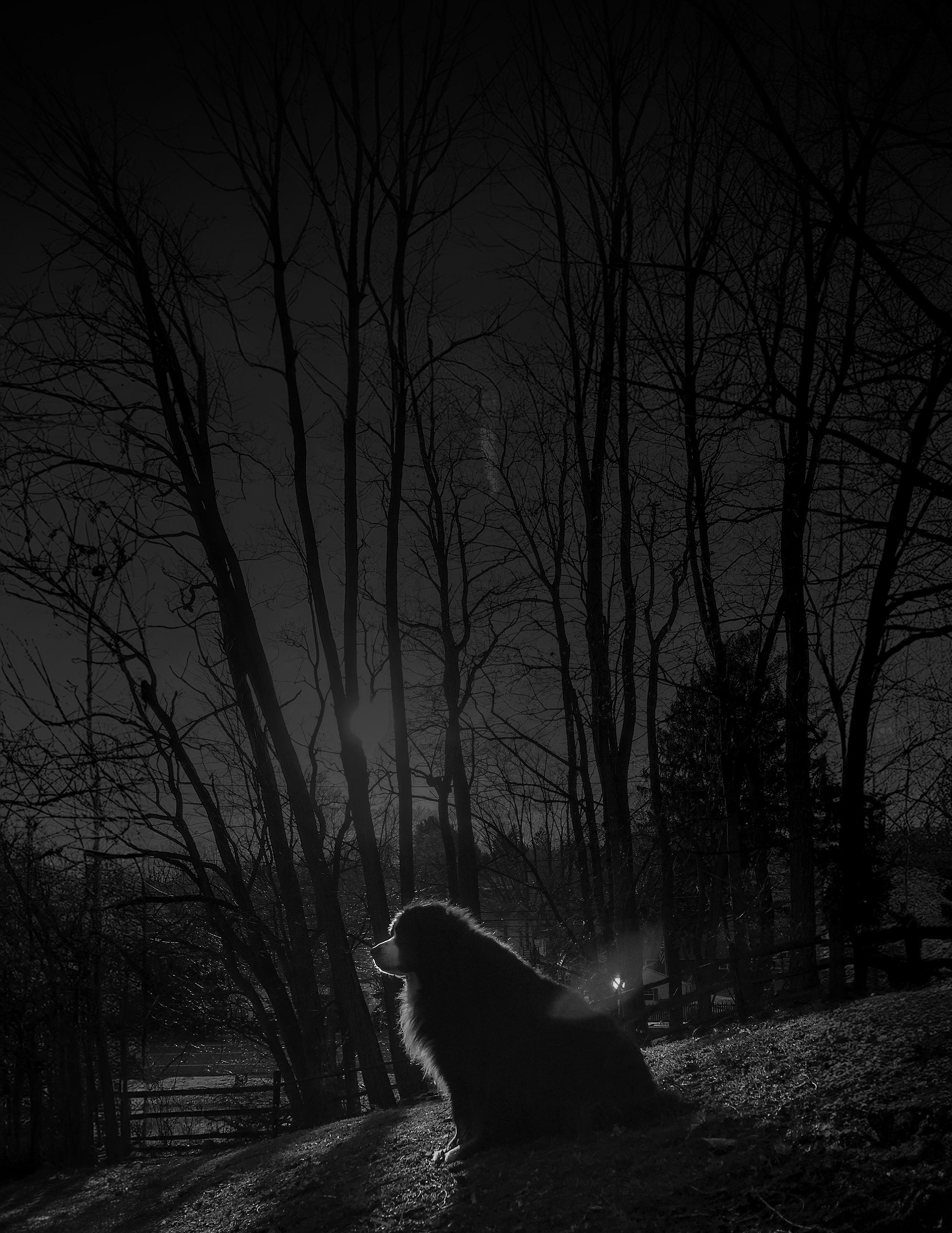
when she and our German Shepherd were running in the backyard. She yelped mid-run and stopped using her right back leg immediately. Initially we suspected a sprain or misstep. We examined her for thorns or another injury. After a few days with no improvement and her failure to use the leg, we took her to our vet. She was diagnosed as having a serious CCL tear that would require intervention.
2. What factors did you consider in making your decision about how you would treat the disease?
Daisy was young, athletic and very active. She was not overweight but had light bone structure. She was in excellent physical condition without a history of lameness. Our veterinarian recommended TPLO if NSAIDS and laser therapy were ineffective. My breeder’s sister, a veterinarian in New York, sent us an article about stem cell therapy for active and athletic dogs. These procedures had been successful in cases such as Daisy’s (young, athletic and not overweight).
3. What treatment did you choose and how effective was it in restoring mobility?
I was resistant to doing TPLO. Some research suggested that dogs undergoing surgical treatments may develop arthritis after a few years. I was uncertain about the complexity of physical therapy required to ensure the best outcome. The cost of TPLO was prohibitive, especially considering the data showing a high probability that a second knee would likely tear later. The second cruciate ligament did tear two years later. I found MediVet Biologics (now Ardent Animal Health) and scheduled an appointment with their staff. They spent considerable
time discussing their procedures with me and describing the positive results they had experienced. At the time, this was the least invasive surgical option available to me and was half the cost of TPLO. We were referred to a local veterinarian who had the stem cell centrifuge to do the procedure. The veterinarian made a small abdominal incision (a 15-minute sedation), extrapolated the cells and injected the injured ligaments with stem cells and plasma several hours later without additional full anesthesia. Daisy came out of the procedure using her leg for the first time in several weeks! The physical therapy amounted to no running or climbing for 40 days. She experienced no muscle atrophy, required minimal pain management and had no scarring. MediVet (now Ardent) banked the cells they did not use and they were available two years later when we had to repeat the procedure on the other knee. The second knee was equally successful, with full recovery.
4. Given the treatment that you chose and its efficacy, what advice would you offer to owners of dogs with CCLD?
I would highly recommend exploring stem cell therapy (her procedures were in 2017 and 2019) and contact Ardent Animal Health for a consult. My original veterinarian was very resistant to this therapy, so Ardent scheduled a second opinion with the veterinarian we chose, who had done 20+ at the time with great success. I'm very glad we chose this option. Daisy regained her mobility 100%. She continued to do agility and nose work, and never developed arthritis or any lingering weakness or pain with either joint.
BG# 71897.
SPRING 2024 ∙ 55
Photo by Beth Schmoyer.
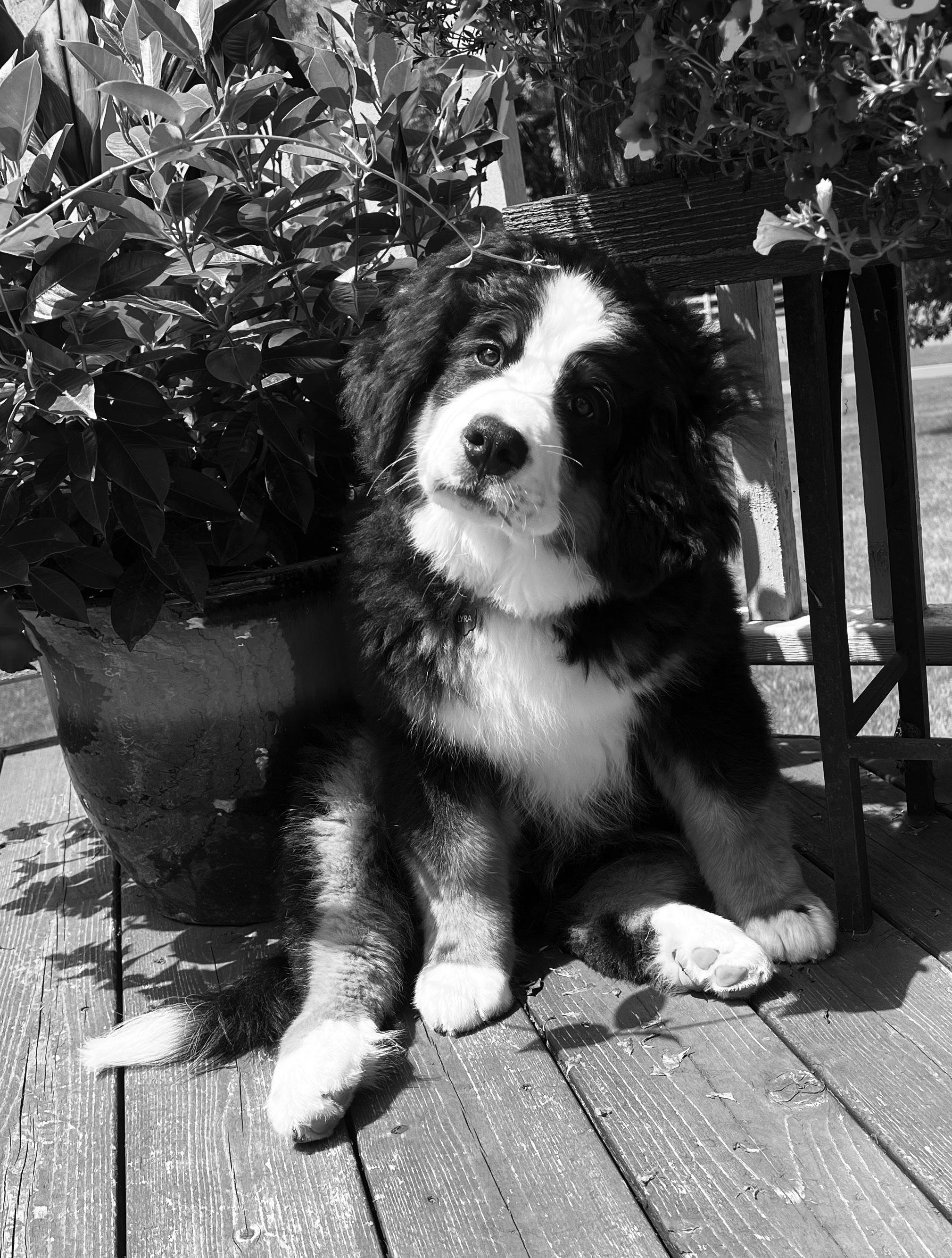
56 ∙ THE ALPENHORN
BG# 205033. Photo by Dee McDuffee.
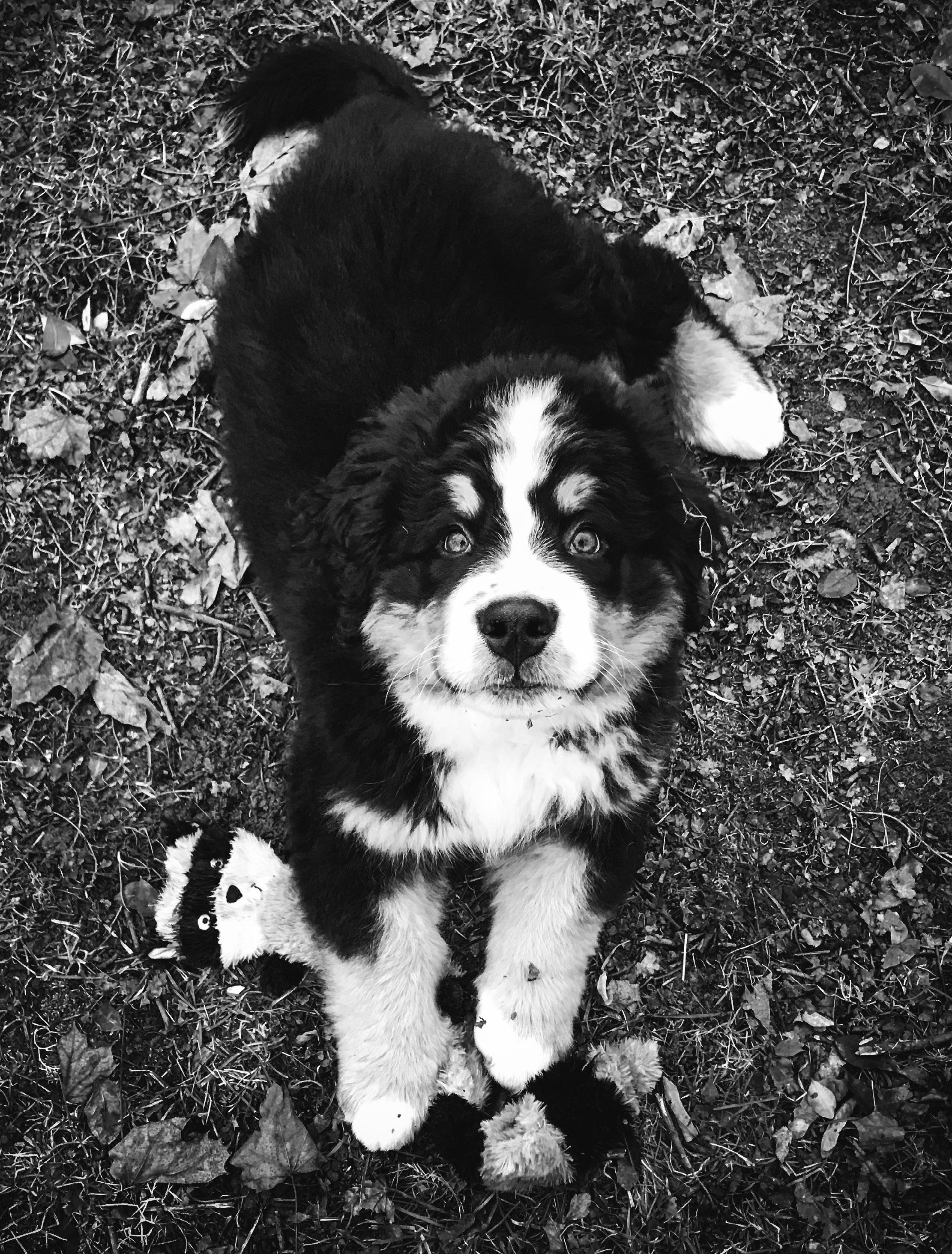
SPRING 2024 ∙ 57
BG# 190014. Photo by Beth Schmoyer.
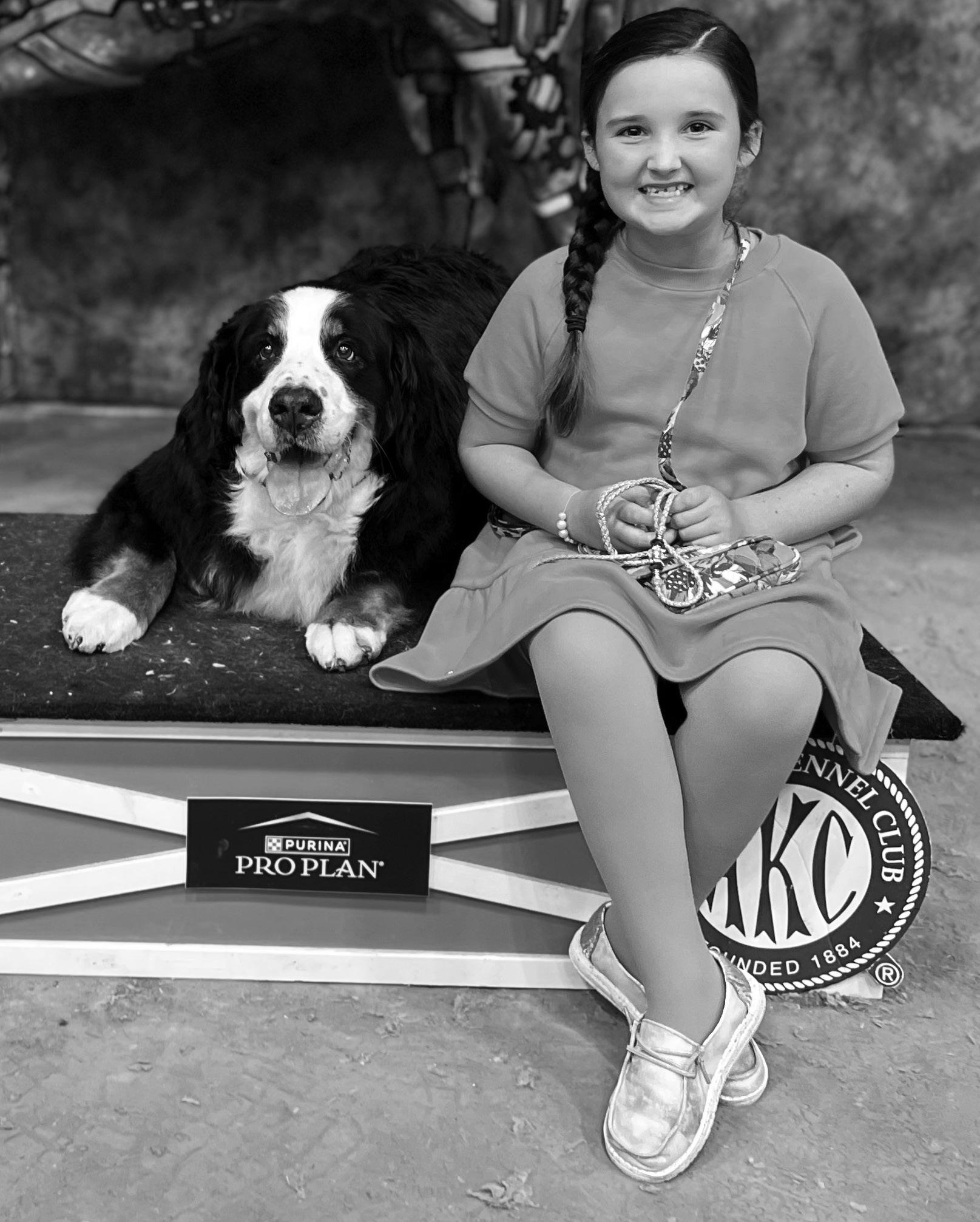
BERNER BUDDIES:
LUCY AND SUTTON MONTGOMERY
BY KERRI MONTGOMERY
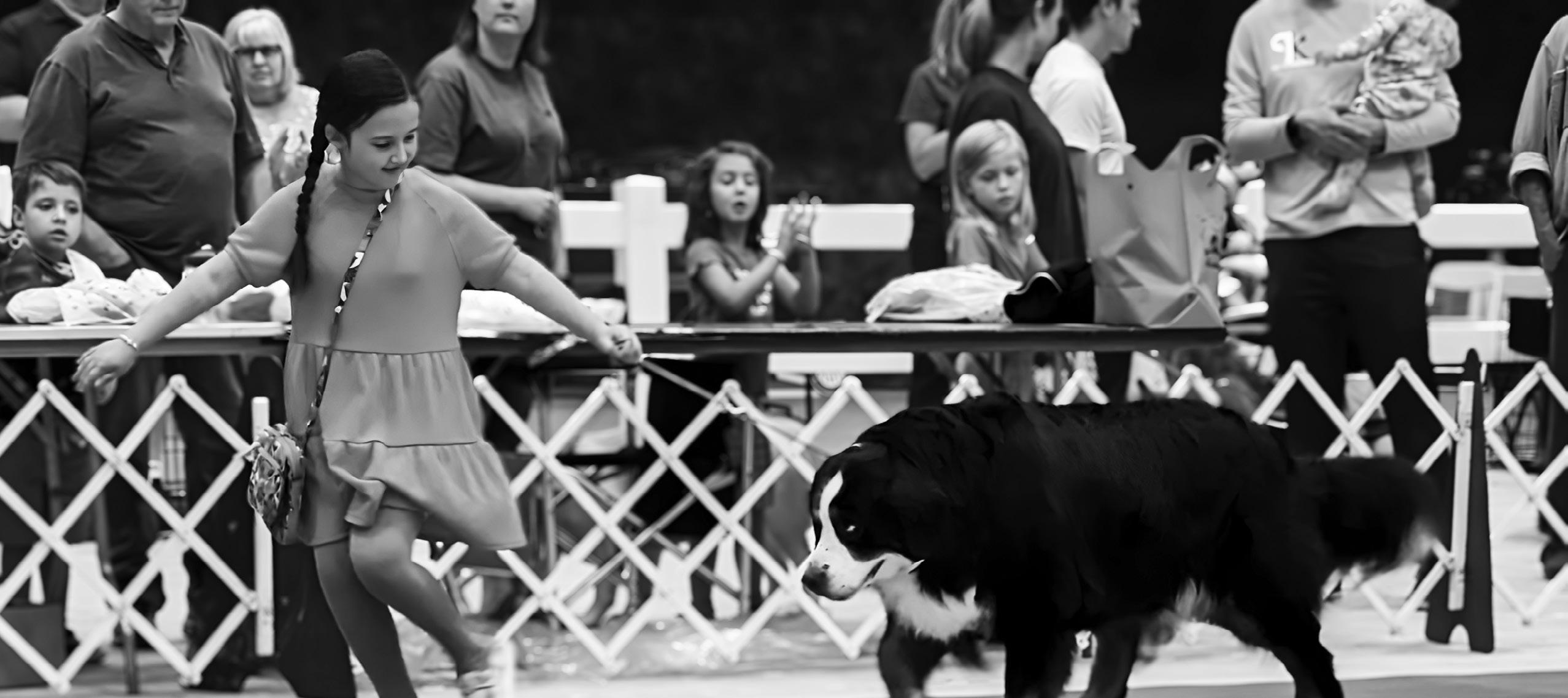
In one central Kentucky classroom there’s a lot of learning happening, but it’s the subject matter that might surprise you.
Seven-year-old Sutton Montgomery loves her Berners dearly and is always ready to share her knowledge of them. She recently teamed up with two fellow classmates to create a Berner education board for her classroom. The poster contains information about Berners’ noses and their lack of pigmentation at birth, bushy tails that should extend just below their hocks and even the flag of Switzerland to highlight the Berners’ Swiss heritage.
Sutton was born into a family of Berner lovers and, at birth, her family included Berners Beyla and Lucy. Beyla was a rescue and Lucy was bred locally. When Sutton’s family lost their dear friend and Berner breeder and mentor, Fara Bushnell, Lucy’s half-brother Wager also joined the crew.
From the beginning, Sutton has wanted to be wherever her dogs were. Rolling on a dog bed, crawling side by side, curled up on the couch together and watching furry paws underneath a highchair waiting on a treat were all common occurrences growing up.
As Sutton and Lucy have grown up alongside one another, their bond has only deepened. Crumbs at the highchair have been traded for command training together with the reward of a frosted mini-wheat or apple slice. Sutton helps with mealtime prep and clean up and assists with Lucy’s daily medications that help maintain a chronic liver issue.
This past fall, Sutton was finally old enough to participate with Lucy in the Bluegrass Classic Dog Show’s PeeWee class. It was with great pride and confidence that Sutton exhibited her veteran Berner. In December, for Lucy’s 11th birthday, her family created a new recipe for a doggy-approved birthday cake, complete with mashed potato frosting and frosted mini wheat details. And this year for her own birthday, Sutton is encouraging all her friends and family to support her favorite rescue and Beyla’s first home — Heart of Michigan Bernese Mountain Dog Rescue.
In addition to Sutton, Lucy has been an amazing protector for Sullivan, Sutton’s older brother. Lucy can be found napping in the central hallway of their home so that she can be aware of comings and goings, even during her naps. Lucy guards the front door and manages the admittance for playdates and neighborhood friends.
At the time of this writing, Sutton and Lucy are making plans to attend this year’s national specialty in Gray
It was with great pride and confidence that Sutton exhibited her veteran Berner.
Summit, Missouri. Sutton hopes you are making plans to be there, too, and will say hello.
In the meantime, Sutton has some Berner tips for other Berner Buddies:
Routine Berner grooming:
1. “Berners have silky ears that should be brushed regularly so they don’t tangle.”
2. “You can use a hair dryer to dry ears and faces because that’s not as loud as the dog dryer.”
3. “At the beach, you should always wash the salt off your dog’s feet. And watch out for sand spurs on the feet, hocks and feathers. They hurt!”
4. “For small dogs use a bathtub, but for Berners use a hose!”
Berner training:
1. “Berners are easy to train.”
2. “Calling your Berner up to bed can be hard, so you can use a treat. The treat lures them.”
Berner Care Tips:
1. “Dogs can’t have grapes, raisins or chocolate.”
2. “Some dogs can have lots of allergies. Lucy is allergic to chicken so we don’t share that!”
3. “Lucy has (chronic) pancreatitis, so we have to be careful and not drop certain foods off the table or leave certain foods on the countertop. Lucy cannot have buttery, greasy or fatty foods; so we don’t share those with her.”
It’s been really special watching my best friend become my daughter’s best friend, too. I’m so proud of how much dog care information Sutton has picked up through our everyday life and by attending dog shows. I’m always grateful for my conformation and rescue friends who take time to answer her questions and encourage her curiosity. I’m thankful for our circle of handler friends who are patient and always exposing her to new breeds or a better, gentler way to do something. It takes a village and I’m really excited to see where our next generation of breed ambassadors or “Berner Buddies,” if you will, will take our breed in the very near future.
SPRING 2024 ∙ 59
Top - Sutton Montgomery has grown up with Lucy (BG# 107475), her Berner best friend. Photo by Kerri Montgomery.
Bottom - Sutton recently showed Lucy (BG# 107475) in the Pee Wee class at the Bluegrass Classic Dog Show in Lexington, Kentucky. Photo by Susan Harrison.
A CONVERSATION WITH THREE PROFESSIONAL TRAINERS ON TRAINING BMDS AND CHOOSING THE RIGHT TRAINER FOR YOUR DOG
BY LARA USILTON
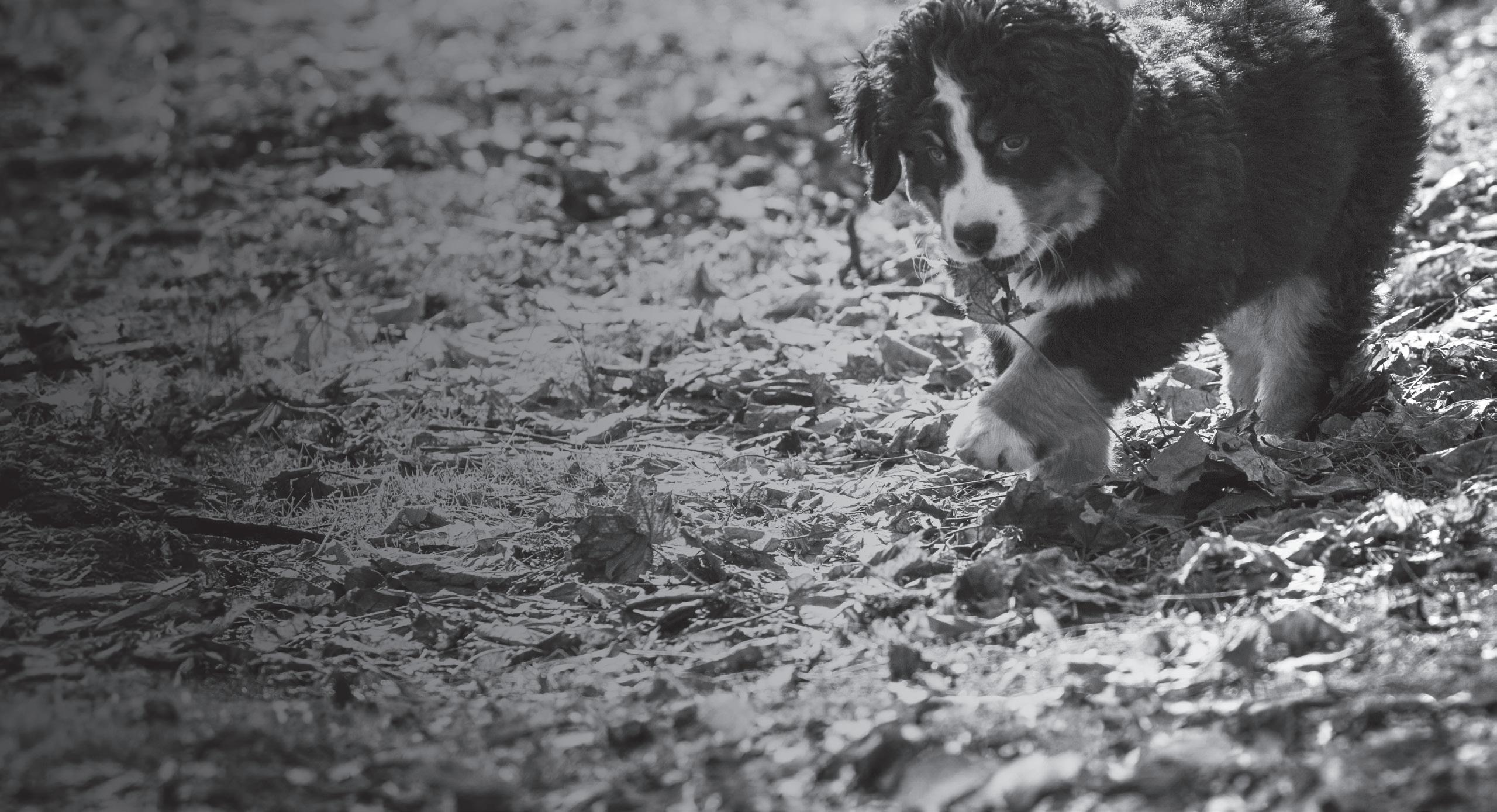
flying successfully around an agility course, and finding the right person to hone your skills is essential for success. We talked with three trainers familiar with Bernese Mountain Dogs, who train in a gamut of events including conformation, performance sports and draft work. Arwen Price, Heather Blakeman and Erin Ledbetter share their tips for success below.
The Alpenhorn (TA): When and why did you become a trainer and why? What are your specialties in dog training?
Price: Before moving to Kentucky, I worked as an assistant horse trainer and loved teaching horseback riding lessons and building the confidence in riders. When I moved out here and began competing with Mattie, I realized that I could apply that same love of teaching to dog sports. I find that is still the focus of my dog training business — people label it dog training, but the vast majority of my job is training people.
Over the last 10 years, my business has grown and now I have a facility that has allowed me to bring in a team of trainers, each with our own specialties. I mostly focus on the competition sport dogs, Maggie and Devin do the pet manners and obedience, and Dr. Kristina works with our difficult behavior cases. As the business owner, I also spend a good portion of my week doing client consultations where I sit down with a new client and their dog to discuss their goals and needs, assess the dog and then I can determine which of our training team will be the correct fit. I have very carefully selected the team I work with and trust each of them to bring their own expertise to the table.
Blakeman: I became a professional dog trainer after many years as a hobby sports trainer, foster volunteer,
to begin a behavior program at the clinic. Over the next few years, I applied for my CPDT-KA (Certified Professional Dog Trainer-Knowledge Assessed) certification through the Certification Council of Professional Dog Trainers while we expanded our program to offer everything from puppy socialization and foundation courses to agility, conformation lessons and veterinary consultations for behavior conditions combined with behavior management, conditioning and training plans. I have always felt immensely rewarded by witnessing the strengthening of relationships between pets and pet parents. Helping owners to communicate and understand their pets so they can have happier and healthier lives together has always been my primary motivation.
Ledbetter: In 2008 I began training the Border Collies at a farm I managed, just for fun. My motivation was just because it was fun and challenging. I consider my specialty to be the fact that I can work with all herding breeds.
TA: What are your philosophies regarding training?
Price: I believe that training should be a positive experience for both the human and the dog. All humans approach training with specific goals, whether it is to eliminate a problem behavior, have a wellmannered pet or to compete in one sport or another. I always try to come into a training session with those goals in mind to help that person see the steps they need to take to achieve that goal. All training can be achieved as long as we are able to break the skills down into pieces that the dog understands and wants to do.
I think the single most important thing to teach our dogs is to enjoy working with us—whether that means
60 ∙ THE ALPENHORN
BG# 106925.
Photo by Beth Schmoyer.

going for a walk in the park calmly or visiting the elderly in a nursing home, free baiting for a judge or running full speed around an agility field. All skills should be something that we have carefully built up in such a way that the dog understands and wants to participate with us.
Blakeman: I adhere to LIMA, “least intrusive, minimally aversive,” guidelines for training, which is defined in the standards of practice and code of ethics of the Certification Council of Professional Dog Trainers, as well as the Fear Free Veterinary Professionals “Fear Free Pledge.” Each of these put the well-being of the dog and preservation of the human-animal bond at the forefront of training ethically. One must consider first the physiology, health and emotional state of the dog before tailoring a comprehensive management and behavior modification plan to address the behavior concern. These philosophies are evidence-based and backed by the American Veterinary Society of Animal Behavior. I also wholeheartedly believe that as in any science-based profession, we are never done learning – continuing education is a critical part of my growth as an individual and supporting continued research and studies is integral to the dog training profession.
Ledbetter: No two dogs are the same, will train the same or will work the same.
TA: How do you know if you’re successful? What are the ingredients for success?
Price: Success is very different depending on the client we are working with. Maybe for one, success is walking into a group class without their dog barking and lunging at other dogs. Maybe for one student, success is winning their class at the rally national championship or competing at the barn hunt national. Another might consider their dog sitting on command a huge success. I think to be a successful trainer you have to know what each student is looking for and how to help them get their dog to that point.
Blakeman: I most enjoy watching my students succeed in their own venues of choice!
Ledbetter: Succes to me is when I can take a green dog and green handler and make a happy, successful team. It takes commitment to training and willingness to accept failure before success.
TA: What are the owner characteristics that make training successful and fun for all? How do you know you’ll be compatible with an owner?
Price: Owners who want to learn and grow with their dogs are the easiest to teach. Owners who are positive and can find joy in the small steps are set up to have much more fun. Dog training is very much a journey,
so being able to celebrate the small successes and small steps towards the goal is really important for an owner. Another thing that is important is that the owner be willing to put in the work. Dog training requires repetition and consistency. If an owner just wants me to wave a magic wand to “fix” the dog — we probably aren’t going to be a good fit. That being said, I do think a lot of what I do is education and managing expectations. I have plenty of owners who walk in the door wanting their dog to have perfect obedience and do exactly what they say, when they say it just because they said so. These owners can either just not be a good fit (and those tend to sort themselves out), or they need to be convinced why positive reinforcement is important in training and what realistic expectations are for a young dog.
Blakeman: Owners who are curious and open to learning and changing their mindset often excel in instruction scenarios. A good sense of humor and assuming the best intentions of your dog go a long way as well! I love the diversity of people I have worked with over the years, and often learn much in turn from them. Owners who are honest, open communicators and can allow themselves to learn to see the world from the perspective of an animal are often the most rewarding to work with, in my experience.
Ledbetter: Someone who understands that this isn't an easy sport and still are willing to put in the training will be the most successful. Trust in your trainer is very important. It's impossible to work with someone who can't trust you to look out for their best interests.
I believe that training should be a positive experience for both the human and the dog. – Arwen Price
SPRING 2024 ∙ 61
TA: What have been your greatest successes training BMDs and why?
Price: I would say that one of my biggest successes was a dog named Scout whose owner came to me because she wanted to do therapy work. I often tell people who come to me wanting to train their dog to be a therapy dog that there is a lot of obedience involved, but dogs really want to do that sort of work or they don’t. And if they don’t love it, no amount of training will make them good therapy dogs. Luckily, Scout was a perfect candidate for therapy work and he adored going up to strangers and loving on them. He soared through his training, passed his test with flying colors and is now visiting hospitals and nursing homes. He just loves to sit by people while they pet him and it is amazing to see the joy he brings to people.
Scout was certainly not my most difficult case or most impressive before and after — but seeing the positive impact that he and his mother have is definitely the most rewarding.
Blakeman: My greatest personal successes related to training Berners has always been the privilege of being a small part of enhancing the lives of the Bernese Mountain Dogs and the ones that love them. The bond between the people and this breed is unlike any other I’ve witnessed — the devotion between the two sides is incredible. To get to be the handler that presents these beautiful animals against the breed ideal in the conformation ring and witness the impact of generations of thoughtful breeding decisions made on health, temperament, breed type and quality is unlike
anything else. To get to see that be recognized and rewarded is thrilling and massively rewarding.
Ledbetter: My greatest successes were training the second and third Berner to earn AHBA herding championships, and the first and second Berners to earn AKC herding championships.
TA: What have been your greatest challenges with BMDs?
Price: I would say one of the biggest challenges of working with Bernese Mountain Dogs is motivating them to want to do the things we ask. They aren’t just going to snap to attention like a border collie and ask over and over what they can do for you today. So, training sessions have to be much more careful to not over-repeat exercises. I use lots of positive reinforcement (praise, pets, treats and/or toys) when working with all dogs, but it is especially important to find what combination of things works to motivate that individual Berner. One Berner might be willing to come when called for big, excited praise and pets, but another might need food rewards to be willing to give up sniffing in the yard. I find that I also have to encourage owners to be very careful with negatives or punishments, because often a Bernese Mountain Dog will just shut down and not want to do anything at all if the owner is negative with them. It can even be more subtle than a verbal correction — if an owner is disappointed in a dog, a Bernese can often read that energy shift and may want to avoid that whole interaction moving forward. It can be very challenging to work out, as each dog is unique and the trainer and owner have to work together to find what motivates that individual dog.
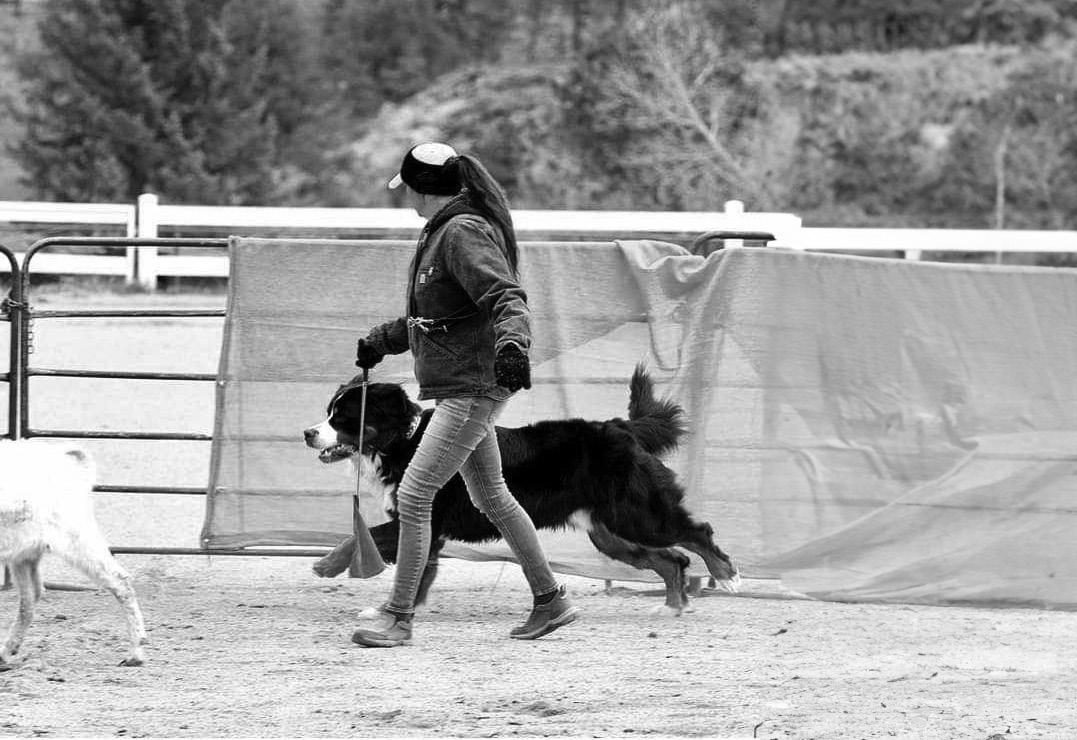
One misconception I hear from owners of Bernese Mountain Dogs a lot is that he/she is “very stubborn.” I personally hate the concept as stubborn indicates that the dog is being willfully malicious in not complying with what the owner wants. Oftentimes my perception of the scenario is that either the dog does not understand what the human wants, or the dog is not properly motivated to do
By far, my greatest recurring BMD-related training challenge is “gracefully” managing 115+ pound “studly” male Bernese Mountain Dogs who think their sole reason for being in or near the ring is to introduce themselves to the beautiful female Berners they know are nearby. Sometimes you must get creative when your charge has reproducing on the brain! Steak and chicken just aren’t as interesting as an attractive and available Berner bachelorette, and teaching a male BMD that breeding doesn’t happen in
Papp (BG# 167777) learning to herd. Photo by Clicking to Capture.
the ring, while also being careful not to have a long-term impact on his ability to “perform” in the appropriate time and place is not necessarily a training challenge I anticipated facing as much as I do. You learn to be creative in managing the environment and the dog in the beginning, and with time and training, desensitization and counterconditioning have a chance at turning them into performing show dogs!
Ledbetter: The livestocks’ reactions can be a challenge when you walk into the area with a Berner. The pressure of their size is intimidating.
TA: What have you learned working with Bernese Mountain Dogs?
Blakeman: I still have so much to learn about the history and future of Bernese Mountain Dogs. I have been thrilled to share the lessons I have learned from this breed’s community with other communities of purebred dog fanciers. The greatest lesson I have taken away from my involvement with BMDs is the community’s commitment to open communication to better the breed through Berner-Garde. I have never met another community of breeders that demonstrates an openness, sincerity and willingness to own and learn from their decisions, while welcoming and educating newcomers to the breed. I continue to share what I have witnessed in the hopes that other breeds will utilize the technology and framework that has been created by the BMDCA to better their own breeds.
Ledbetter: They need purpose, an end goal. True working situations make sense.
TA: What advice do you have for Berner owners researching and selecting a trainer for their dog (both dos and don’ts)?
Price: Searching for a trainer is a bit like shoe shopping. Sometimes you find the perfect fit right away; sometimes you have to try on 20 shoes before you find one you like. I think it is important to keep what is important to you at the forefront of your search — and not give up on training entirely if the first person isn’t a good fit for your family.
Do:
• Schedule consultation appointments. Most trainers will offer a consultation or evaluation option. I highly recommend these as you can meet one-onone with the trainer before committing to a whole program of lessons. I also recommend scheduling several with different local trainers so that you can compare and contrast their approaches, experience level, facilities and your overall comfort with their program.
• Look for trainers who specialize in your specific goals — a trainer who will get you competing in agility might be fantastic at what they do, but he/ she is not likely to be super helpful if you have
an aggressive dog. Or if you want to do therapy work with your dog, the pet obedience trainer is probably not going to be very knowledgeable in those specific skills and needs.
• Ask the trainer about their experience training dogs for your specific problem or goal. If you are looking for a specific sport, ask what titles they have earned in that sport. Ask what titles their students have achieved. If you are looking for help with a specific behavior problem, ask if they have been successful training a dog with that problem.
• Watch the trainer interact with your dog. Does your dog seem comfortable with them and the interaction? Do they have a calm, positive demeanor with your dog?
• Watch the trainer interact with their dog if they have a demonstration portion. Watch the body language of the dog for signs the dog is enjoying the interaction — wagging tail, eye contact with trainer, joyful movements, eagerness to engage and perform exercises. Also watch for body language showing stress — lip licking, yawning, looking behind them/away from the trainer, scratching, quick or fearful movements. If their own dog is working from a place of fear, is that the relationship you want to have with your dog?
• Advocate for your dog. Just because a trainer is an “expert” does not always mean they are right. If you are uncomfortable with their approach with your dog, it is absolutely okay to speak up and advocate for your dog.
Don’t:
• Fall for a flashy website. Many bad trainers hide behind pretty websites full of buzzwords that don’t have any information about how they train or their experience. Instead, look for trainers who highlight their experience and philosophy.
• Commit to a large package without clear expectations. Some unscrupulous “trainers” will sell massive packages up front making big, but unclear promises that seem too good to be true. Spoiler alert: It probably is too good to be true. Make sure the expectation of what the trainer is going to provide is clear before you sign anything.
• Send your dog away to a board and train situation without being involved. I don’t typically recommend board and trains unless in specific situations, and the list of trainers I can trust to send dogs to is miniscule. If you must send the dog away, be sure you can go visit at set points. Also make sure they have a follow up lesson plan — just because the dog behaves for a trainer does not mean it will behave for you.
• Give up if one trainer doesn’t solve your problem. There are many skill levels of trainers, and each one is really, really good in certain areas and with certain types of dogs. If the one you tried didn’t accomplish your goal, don’t just assume your dog can’t do it and you have to just accept that. Try to find another one; there are lots of approaches!
SPRING 2024 ∙ 63
Blakeman: I recommend this article by the American Veterinary Society of Animal Behavior: “How to Choose a Trainer,” https://avsab.org/wp-content/uploads/2018/03/ How_to_Choose_a_Trainer_AVSAB.pdf
Ledbetter: Ask others about their experiences with said trainer. Try more than one trainer. Choose the one who best fits with you and your dog. Don't waste your time with a trainer that refuses to adjust their training to your dog's needs/style.
TA: What credentials/certifications should an owner look for in a trainer?
Price: Dog training is an unregulated industry. Unfortunately, literally anyone could wake up one day, build a website and start selling dog training. There is no required education or licensing. There is no governing body to make sure a trainer has insurance or has any experience working with dogs. So, it is up to the owner to research trainers, ask questions and be involved in the training.
There are various credentialing companies, but I have seen great trainers without any certifications and really bad trainers with lots of certifications. I think it is much more important to ask a trainer where they learned and who they studied under. Write the names of their mentors down and do some research into their methods. See if those philosophies align with your values.
Blakeman: There are many credentials and certifications available and not all are created equal. Some great ones that come to mind are, in no particular order of preference: KPA – CTP (Karen Pryor Academy), IAABC (International Association of Animal Behavior Consultants), CPDT-KA/CPDT-KSA, (Certification Council of Professional Dog Trainers), VSA (Victoria Stillwell Academy), CBATI (Certified Behavior Adjustment Training Instructor). There are many more of course, and there are also going to be instructors out there that are not accredited that may be the right choice in dog sport scenarios, for instance, as long as they are staying current on education and using evidence-based techniques.
Ledbetter: Number one is finding out if they work with loose-eye breeds.
TA: What are some warning signs that a trainer is not a good fit?
Price: The biggest warning sign is that gut response that you are uncomfortable with what the person is doing with your dog. I had one new client walk into my training center from another local program and the dog was wearing shock and prong collars at the same time and the owner had allowed that training method because a person in a position of authority said so. But after talking with her more, she did acknowledge that she felt confused and uncomfortable with the amount of
punishment used by that other program. Her gut told her it was not a good choice, but the “trainer” justified the excessive use of punishment and expected her to go along with it.
A big red flag is when a trainer cannot explain what they are doing or why it will help your dog. Many trainers without much formal education have no idea why they do things a certain way — it’s just the only thing they learned from their mentor/program. I encourage anyone looking for a trainer to ask deeper why and how questions, and if the answers are fluff or nonsensical, find another trainer.
There are many credentials and certifications available and not all are created equal.
– Heather Blakeman

Another very common issue is franchises. I’m not saying all franchises are bad, but most of them are. Many corporations have popped up over the years that build very professional websites that say all the right things and make huge promises. These franchises sell a business to an individual who wants to be a dog trainer, teach them to be a “trainer” in as little as two weeks, and then they are home taking on clients. I would caution anyone looking for a trainer to ask a second and third question before working with a franchise company.
Ledbetter: As I said before and can't stress enough, experience working with multiple breeds that are loose eyed.
TA: How do you “interview” a trainer to know if they are appropriate for you and your dog?
Price: Most trainers will offer a consultation or evaluation appointment. These are an excellent
64 ∙ THE ALPENHORN
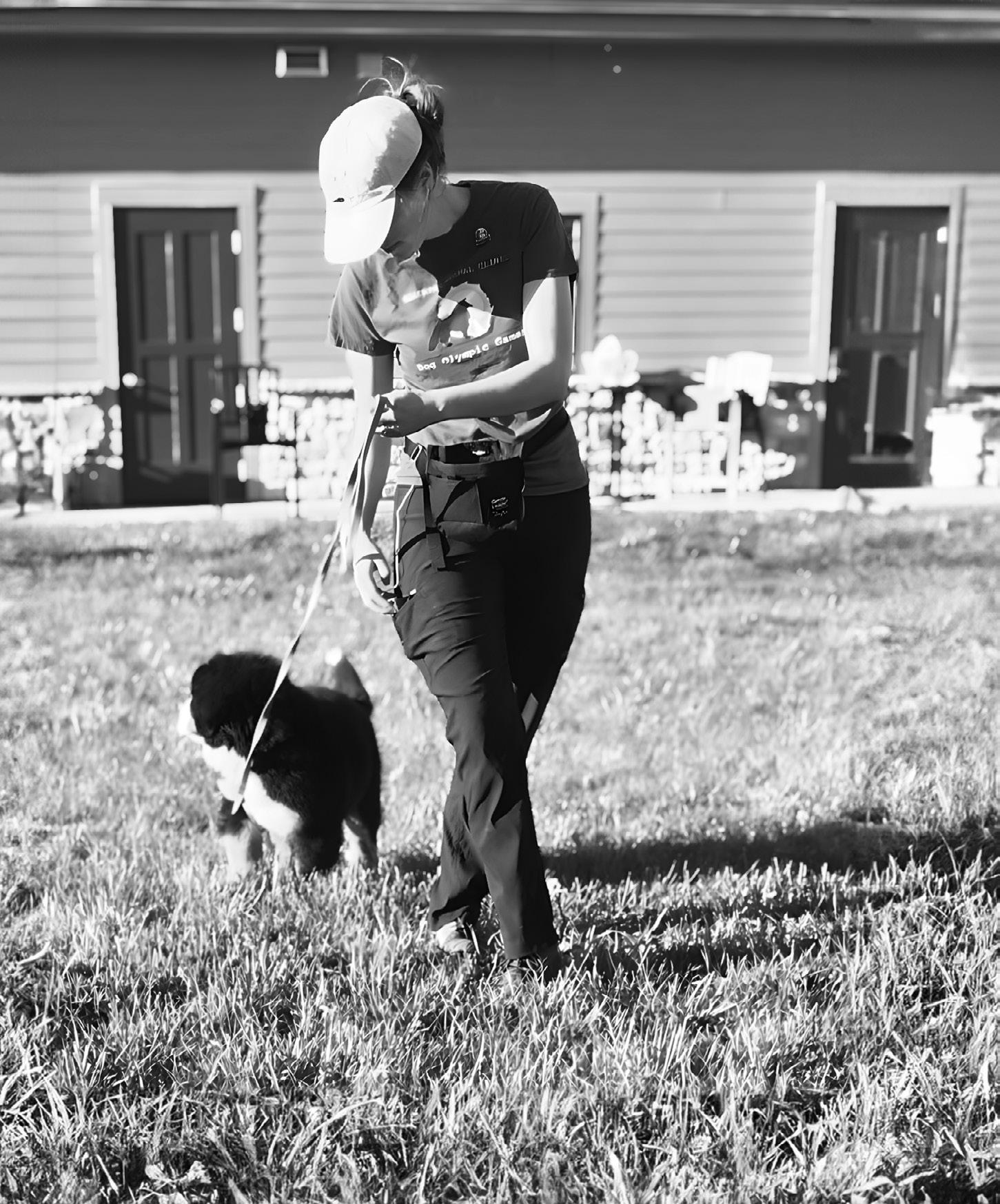
about their philosophy. Use this appointment to ask about the trainer’s experience, when they studied, who they studied under, and what training methods they use.
Ledbetter: First is to ask if they are willing to work with your breed of dog. Second, reach out to others about their experiences with said trainer. Third, attend a clinic or private lesson. Make your decision based on your experience. Remember you are also being interviewed as a potential client. Not all trainers will accept you and your dog.
TA: Is the training “industry” regulated and if so how and by whom?
Blakeman: No and I recommend reviewing Alliance for Professionalism in Dog Training, https://prodogtraineralliance.org for more information on the movement to develop and pass licensing legislation in the U.S.
TA: Are there any industry organizations that can provide a list of reputable trainers?
Price: There are several organizations who provide programs for trainers to prove they have a foundation of
knowledge. Both have websites where you can search for local trainers who have completed their programs:
CCPDT - Certification Council for Professional Dog Trainers
KPA - Karen Pryor Academy
Ledbetter: Yes. AHBA (American Herding Breed Association), AKC (American Kennel Club) and ASCA (Australian Shepherd Club of America) are a few. Trainers can be found on their websites.
TA: If not, how do you recommend a dog owner find a trainer?
Price: Asking your local kennel club is a great place to start. I also highly recommend reaching out to your breeder even if they aren’t local. Many people in the dog industry know each other even if they are not local and your breeder may be able to reach out to friends in your area who can suggest a reputable trainer.
Ledbetter: Asking around is a great way to find a trainer in your area. Facebook is another.
About the Experts: Arwen Price is the owner of Bluegrass Dog Training in Lexington, Kentucky. She has trained dogs for performance sports for about 10 years and competes with her own dogs in agility, barn hunt, scent work, rally, obedience and conformation. She shows and breeds Wire Fox Terriers, Lakeland Terriers and Cairn Terriers.
Heather Blakeman, CPDT-KA, Elite FFCP (Veterinary, Trainer) is the owner of Sunrise Solutions, LLC and an AKC All Breed Junior Showmanship Judge. She has worked in the veterinary community for 19 years and been a part of the dog sport community for 25+ years. In her time teaching group and private classes at veterinary hospitals, she had the pleasure of working with over 800 dogs and their owners. In addition to enjoying performance sports with her personal dogs she handles professionally in AKC conformation – primarily Bernese Mountain Dogs. Some of Heather’s greatest accomplishments include winning three All-Breed BIS on her personal dogs, and many fun national specialty wins on client dogs including several BOSS, BOW, AOM, BVIS, as well as a memorable regional BISS with stunning Berners.
Erin Ledbetter is the owner of Sweetwater farm in Bostic, North Carolina where she has sheep, goats, ducks and geese for use in her training program. She is an AHBA herding judge. She’s been competing since 2010 with many successes that include herding championships on clients’ dogs and her own.
SPRING 2024 ∙ 65
Heather works with 3-month-old Sailor (BG# 155334).
Photo by Lara Usilton.

CHOOSING FLEA AND TICK PROTECTION TO FLEA OR NOT TO FLEA
 BY SUSAN HARRISON, PH.D.
BY SUSAN HARRISON, PH.D.
The sheer number of flea and tick treatment products available today is overwhelming and making an informed decision about which to use on your dog can be difficult. However, many of these products use the same active ingredients, reducing the variables to consider to a more manageable number. There are two methods utilized to kill fleas and ticks: chemical pesticides and insect growth regulators. The pesticides can be grouped into families based on their specific mechanism of action, or their molecular structure, and families are represented by a few different chemicals used in flea and tick control products. While there are differences in the specific mode of action of these classes of chemical pesticides, all kill by overexciting the nervous system of fleas and ticks leading to paralysis and death. The insect growth regulators alter the natural cycle of hormone regulation of normal egg

and larval development or the synthesis of chitin, a major component of the exoskeleton. Pesticides and growth regulators are frequently combined in a single product to affect all life stages of fleas. A third element in some flea and tick protection products are synergists that have no intrinsic insecticidal or acaricidic (tick killing) activity. Synergists act to block the breakdown of the pesticide by the pest, extending the time it is effective. What differentiates flea and tick products is the active ingredient or combination of active ingredients in each product.
The table below is a comprehensive list of the active ingredients in commonly available flea and tick treatments, what they do and do not do, and other active ingredients they might be mixed with to expand their efficacy against these pests.
Tetrachlorvinphos collar1 6 mo kills adult fleas and ticks
Pyrethroids
permethrin (type I) spot-on1 1 mo
• kills adult fleas and ticks on contact or after ingestion
• toxic to everything including mammals
• potential carcinogen alone, S-methoprene
• not recommended for dogs with history of seizures
cyphenothrin (type II) spot-on1 1 mo not used alone, fipronil, S-methoprene
• fleas and ticks do not have to bite to be killed
• cats are extremely sensitive to pyrethroids
deltamethrin (type II) collar1 6 mo* alone, pyriproxyfen, S-methoprene
• blocks breakdown of pyrethroids extending period of activity
• cats are more tolerant to etofenprox than other pyrethroids not used alone, dinotefuran, pyriproxyfen, S-methoprene
etofenprox (non-ester) spot-on1 1 mo not used alone, S-methoprene, piperonyl butoxide, milbemycin oxime, N-octyl bicycloheptene
66 ∙ THE ALPENHORN
ACTIVE INGREDIENT APPLICATION FREQUENCY THE GOOD THE BAD FREQUENCY USED WITH
Pyrethroid Synergists
N-octyl bicycloheptene N/A
piperonyl butoxide N/A
pyriproxyfen N/A
• blocks breakdown of pyrethroids extending period of activity not used alone, see pyrethroids
Fipronil 1 mo
Indoxacarb spot-on1 1 mo
Neonicotinoids
dinotefuran spot-on1 1 wk
• kills adult fleas and ticks on contact or after ingestion
• safe for use on pregnant and lactating bitches alone, cyphenothrin, S-methoprene, permethrin, pyriproxyfen
• kills adult fleas after ingestion
• activity is much lower in mammals
• kills adult fleas on contact or after ingestion
• highly specific to insects
• not effective against ticks alone
• not effective against ticks
imidacloprid chew spot-on1 24 hr alone, moxidectin, permethrin, pyriproxyfen
• nitenpyram safe for use on pregnant and lactating bitches
• very short acting not used alone, fipronil, pyriproxyfen
nitenpyram chew 24-48 hr alone
Isoxazolines
afoxolaner chew 1 mo
• kills adult fleas and ticks
• high specificity for invertebrates
• not recommended for dogs with history of seizures
fluralanar chew spot-on1 8-12 wk alone
lotilaner chew 1 mo alone
• covers largest number of tick species
• fluralaner only effective for 8 weeks against the lone star tick alone, moxidectin, pyrantel pamoate, milbemycin oxime
sarolaner chew 1 mo alone, moxidectin, pyrantel pamoate
SPRING 2024 ∙ 67 ACTIVE INGREDIENT APPLICATION FREQUENCY THE GOOD THE BAD FREQUENCY USED WITH
Insect Growth Regulators
pyriproxyfen N/A
lufenuron N/A
S-methoprene N/A
Macrocyclic Lactones
spinosad (atypical) chew
1 mo
selamectin spot-on2
1 mo
milbemycin oxime chew
1 mo
moxidectin chew
Anthelmintics (additional)
praziquantel
pyrantel pamoate
1 topical 2 absorbed *PetArmor Plus: 1 mo
1 mo
1 mo
1 mo
Tetrachlorvinphos is an organophosphate which, as a family, is among the oldest pesticide treatment used in agriculture and animal husbandry. Tetrachlorvinphos is the only organophosphate used in flea and tick products for dogs today. It is slowly released from impregnated collars, absorbed through the skin, and distributed systemically throughout the body. Tetrachlorvinphos is extremely effective at killing both fleas and ticks, but it is also generally toxic at some level to all animals including humans. It has been associated with a plethora of neurological effects in dogs and humans, especially
• kills flea eggs and larva
• specific to insects
• extremely low toxicity to mammals
• no activity against ticks not used alone, see other pesticides
• kills adult fleas
• kills adult fleas and some ticks species
• prevents heartworm alone
• prevents heartworm
• use with caution on dogs with a history of seizures alone, milbemycin oxime
• kills intestinal worms not used alone, lufenuron, praziquantel
• prevents heartworm
• kills intestinal worms not used alone, sarolaner, afoxolaner, pyrantel pamoate
• kills tapeworm
• kills round and hook worms
• ineffective against whip worms
children. However, as recently as September 2023, the safety of using tetrachlorvinphos in flea and tick products for dogs has been re-evaluated by the EPA with the conclusion that collars now on the market are safe when used as instructed. Note that this is a reversal of earlier recommendations. Some manufacturers have voluntarily taken these collars off the market or redesigned them to reduce the risks when handled by humans.
Pyrethroids are synthetic analogues of pyrethrin, a naturally occurring pesticide found in
68 ∙ THE ALPENHORN ACTIVE INGREDIENT APPLICATION FREQUENCY THE GOOD THE BAD FREQUENCY USED WITH
chrysanthemums. Pyrethroids are effective broadspectrum insecticides and acaricides (tick killers). They are topical chemical pesticides that are not absorbed through the skin and kill fleas and ticks on contact or ingestion. There are two classes of pyrethroids that differ slightly in their chemical structure. Type II pyrethroids are more effective against fleas and ticks than type I pyrethroids but also carry a higher toxicity risk. The neurological toxicity effects in dogs include tremors and seizures, so they are not recommended for dogs with a history of seizures. Cats are much more sensitive to most pyrethroids than dogs and casual contact between a treated dog and a cat may be sufficient to elicit a toxic response in the cat. The non-ester pyrethroid, etofenprox, is tolerated better in cats than other pyrethroids.
Pyrethroid synergists do not kill on their own but enhance the effectiveness of pyrethroids by inhibiting the enzymes in fleas and ticks that break down these chemical pesticides. This extends the period of efficacy of pyrethroids. Pyriproxyfen has activity as both a pyrethroid synergist and an insect growth inhibitor (see below).
Fipronil is a chemical pesticide used in many flea and tick products and has been on the market for some time. It kills fleas and ticks on contact. It becomes sequestered in sebaceous glands and slowly seeps out of these glands covering the skin and hair shafts. It has a higher affinity for the insect version of its neuronal target than the mammalian version and is relatively safe for dogs as well as humans if handled as directed. It is safe for use on pregnant and lactating bitches. Fipronil is very toxic to fish and aquatic invertebrates and its breakdown products even more so. As fipronil is a topical product, environmental contamination is a consideration if your dog swims a lot in ponds.
Neonicotinoids are fast-acting and very efficient at killing adult fleas on contact. Because they are directed at insect-specific nerve cell components, they are not effective against ticks. They are usually combined with other chemical pesticides that are acaricidal. Their specificity for insects also makes them typically non-toxic to dogs, cats and humans. This class of chemical pesticides is very short-acting and is used primarily for killing adult fleas as a first step to eliminating flea infestations on dogs. Imidacloprid and nitenpyram are quickly broken down and are effective for only 24-48 hours and can be reapplied daily. The neonicotinoids are frequently used in combination with pesticides that have longer periods of activity against fleas and/or activity against ticks. Nitenpyram is safe for use on pregnant and lactating bitches.
Indoxacarb kills adult fleas and is unique in the insecticides used in flea and tick products because it requires activation by insect enzymes after ingestion by the flea. It is the metabolites of indoxacarb that are toxic to fleas. In mammals, indoxacarb is broken down into non-toxic metabolites making it especially safe for use on dogs and around humans.
Isoxazolines are among the newest chemical pesticide treatments used in flea and tick protection. They have a greater affinity for invertebrate than for vertebrate nervous systems. They are highly effective at killing fleas and ticks and they are considered effective against the largest number of common tick species throughout the world. Whether this is because of more extensive testing of this class or a true difference in the ability to target more species is unclear. The isoxazolines do carry a risk of neurological toxicity in dogs. Careful consideration should be given to using these in dogs with a history of seizures. All of these are available in a chewable form. Fluralaner is also available in a spot-on that is absorbed through the skin, reducing exposure to humans and the environment.
Insect growth regulators used as pesticides in flea and tick products target the developing flea. They are ineffective against ticks. Two juvenile growth hormone analogues, S-methoprene and pyriproxyfen specifically prevent the development of flea eggs and larvae. Lufenuron inhibits chitin synthesis required for development of the flea exoskeleton. These are combined with chemical pesticides that kill adult fleas, quickly eradicating fleas at all life stages.
Macrocyclic lactones are wide spectrum pesticides that have insecticidal, acaricidal and anthelmintic activities. Except for spinosad, which is only active against adult fleas at the concentration used in flea and tick products, the family members are used primarily for their effect on nematodes to confer protection against heart and intestinal worms. Their killing of fleas, ticks and mites is a bonus. Macrocyclic lactones are relatively safe because of their specificity for nematode and arthropod nervous systems and do not readily cross the blood-brain barrier in vertebrates. There are, however, reports of neurological effects on dogs treated with this class of pesticides on overdose and should be used with caution in dogs with a history of seizures.
Anthelmintics are sometimes combined with flea and tick products for convenience. Anthelmintics can have specificity to distinct types of worms. In addition to the macrocyclic lactones selamectin, milbemycin oxime and moxidectin, pyraziquantal or pyrantel may be used in these combination
SPRING 2024 ∙ 69
Look for the specific product that encompasses your dog’s needs with minimal risk. If you have questions or concerns about the product you are using or thinking of using, talk to your vet.

products. Pyraziquantal kills tapeworms specifically and pyrantel kills most types of intestinal worms.
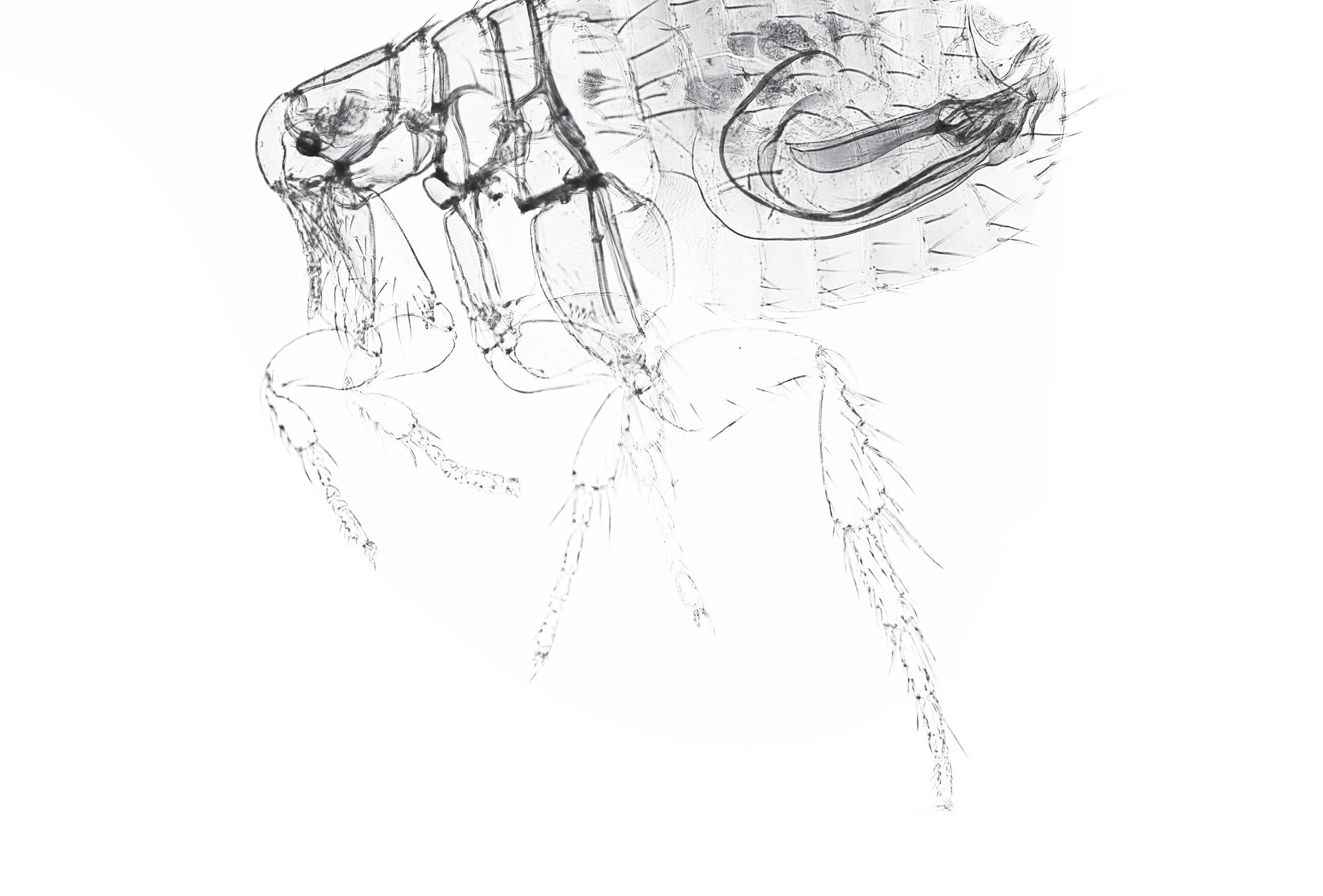
The efficacy and safety have been discussed above for each class of pesticide. All are effective at killing fleas and some are also effective at killing ticks. These pesticides were developed to act on insect versions of their targets in neurons. Fleas are insects. Ticks, on the other hand, are arachnids, more closely related to spiders and scorpions. The degree of similarity between a particular insect and arachnid target determines the effectiveness of a pesticide for each class of pests. That is why all flea treatments are not equally effective at killing ticks.
All flea and tick products are regulated by the FDA or EPA in the U.S. and their counterparts in other countries, and are dosed to be the most effective against their target pests while not causing “unreasonable” adverse effects in humans and other animals. They also have a wide range of safe doses that rely on relative specificity of these pesticides to arthropod versions of the sites they act on and the size difference between pests and dogs. That said, all flea and tick products can produce toxic effects that range outside their intended targets. Overdose is usually due to accidents or user error but can occur under other circumstances that are more related to the mode of application of the pesticide. Careful consideration of the appropriate product to use should be given when treating dogs with known sensitivity and very young, older or infirm dogs.
There are three ways to apply flea and tick products: slow-release collar, spot-on and oral. In addition, there are two types of collar and spot-on treatments: those that translocate over the skin surface and those that are absorbed through
skin. The topical pesticides that are translocated spread over the surface of the skin by mixing with the dog’s body oil and moving with the normal flow of those oils. It usually takes 24-48 hours for a spot-on treatment to cover the entire dog while collars can take a week or more. The pesticide gets sequestered in sebaceous glands and hair follicles in the skin and coats the hair shaft. The benefit of this is that the pesticide can kill fleas and ticks on contact before they bite. The disadvantage of topical treatments is that they get transferred to the environment. This can include you or your child’s hands when you pet your dog and your dog’s bed that might be shared by your child or cat. These behaviors can lead to unintended dermal exposure or ingestion. Your dog will ingest these pesticides when they lick themselves potentially leading to a ‘taste reaction’ including hypersalivation, frothing at the mouth or vomiting. Depending on the amount consumed, these products can have toxic gastrointestinal or nervous system effects. If your cat grooms your dog treated with topical pyrethroids or sleeps in the same bed, your cat could easily overdose as they are much more sensitive to this pesticide family. Spot-on treatments absorbed through the skin and oral treatments require the flea or tick to bite to get exposed to the pesticide. This is a consideration when it comes to tick borne diseases. In most cases, a tick must be attached for at least four hours (tularemia) to 24 hours (Lyme disease, ehrlichiosis, anaplasmosis, Rocky Mountain Spotted Fever) before transmitting the bacteria that cause disease. Frequently the tick dies and drops off the dog before that time, but not always. Some rarer tick-borne diseasecausing viruses (Powassan virus disease) can be transmitted in just a few minutes of attachment. The positive side of systemic flea and tick protection is that it does not contaminate the environment.
70 ∙ THE ALPENHORN
Some newer flea and tick products have both a topical and an oral delivery formulation.
A final consideration to keep in mind is the fact that resistance to pesticides develops in fleas and ticks with time. Older, and therefore, more widely used flea and and tick products, have led to the development of populations of both pests that are resistant to some pesticides. The size of these populations can range from your home, your yard or larger areas depending on the prevalence of pests and the use of a particular pesticide in the area. If you think that your choice of flea and tick protection has lost its efficacy on your dogs, changing to a different pesticide may be warranted.
Faced with the abundance of flea and tick protection products out there, finding the right one for you and your dog can best be approached by putting together the pesticides that make the most sense for what you are trying to accomplish for your dog and what risks you are willing to take for your dog, your family and yourself. Then look for the specific product that encompasses your dog’s needs with minimal risk. If you have questions or concerns about the product you are using or thinking of using, talk to your vet.
Information presented here was compiled from the following websites and published scientific reviews: Environmental Protection Agency (epa.gov)
National Pesticide Information Center (npic.orst.edu)
Science Direct (sciencedirect.com)
Flea and Tick Protection Product Inserts
Zhou, X., Hohman, A. E., & Hsu, W. H. (2022). Current review of isooxazoline ectoparasiticides used in veterinary medicine. J Vet Pharmacol Therap. 45:1-15.
Wismer, T., & Means, C. (2012).Toxicology of newer insecticides in small animals. Veterinary Clinics of North America: Small Animal Practice. 42:2.
About the Author: Susan Harrison earned her Ph.D. from the Graduate School of Biomedical Sciences at Tuft’s University School of Medicine. She has conducted research in neurobiology, reproductive biology, developmental biology and cancer biology. She is currently President of the Bernese Mountain Dog Charitable Foundation, a 501 (c) (3) non-profit organization dedicated to supporting health research, rescue and education as it pertains to the BMD. She and her husband live in the heart of the Bluegrass with their two beautiful Berners.
Bernese Mountain Dog Club of Nashoba Valley
Two Days of Draft Tests in the Historic Coastal Village of Essex, Massachusetts
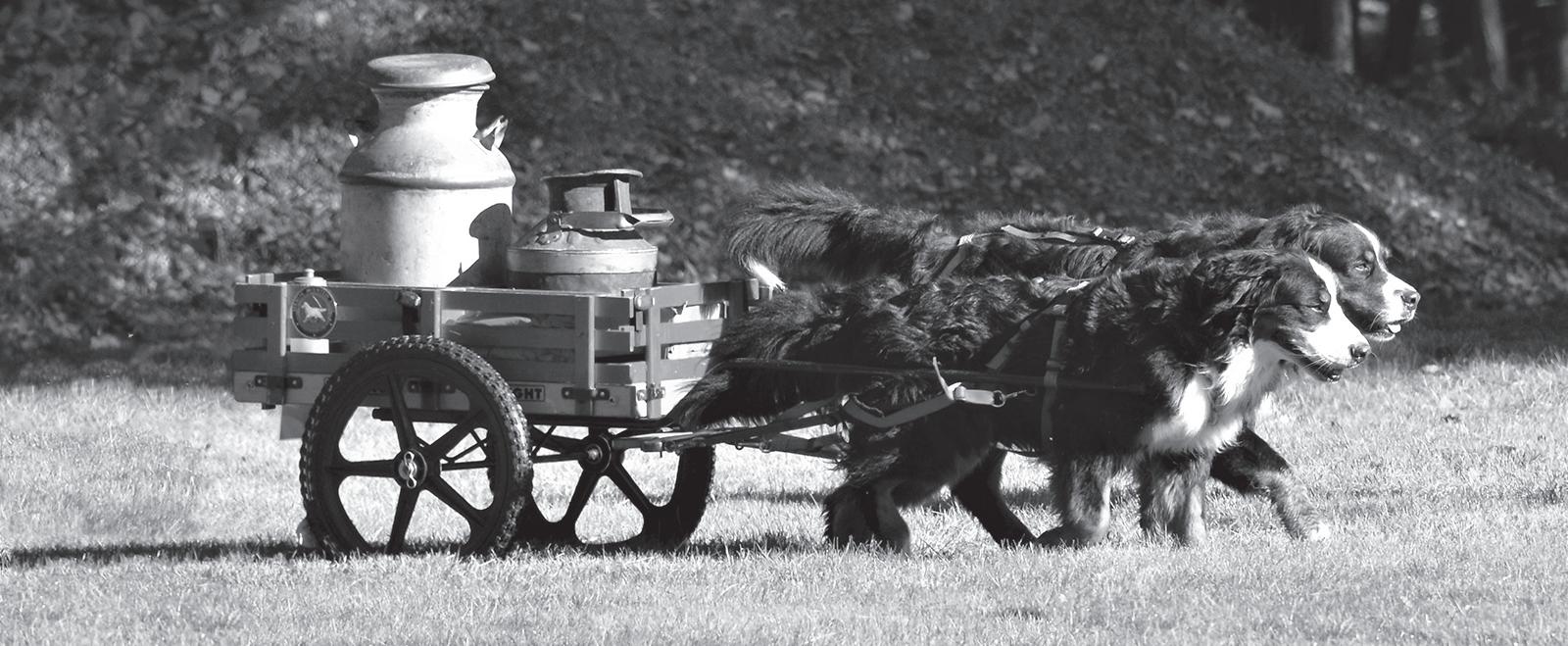
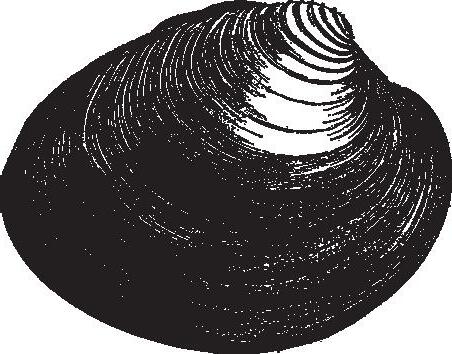
Woodman’s of Essex: birthplace of the fried clam

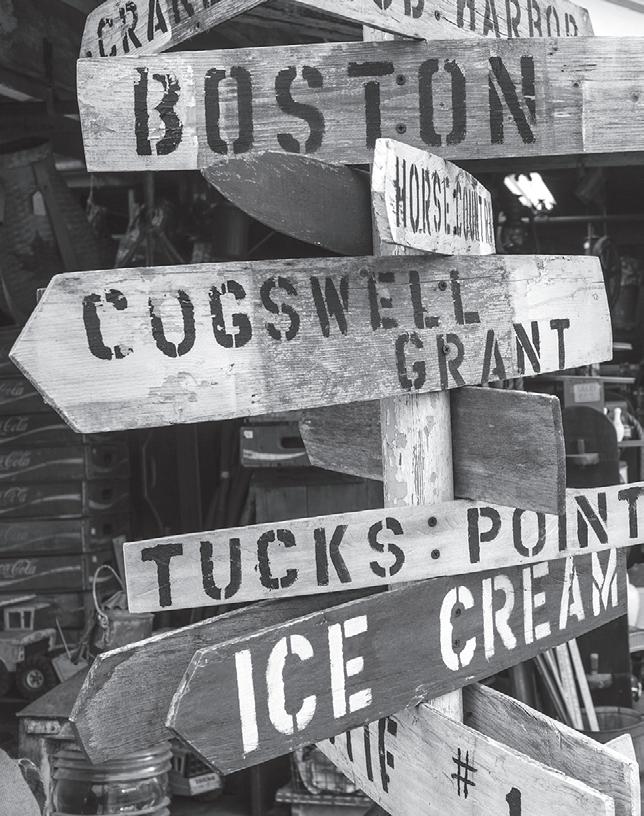
Judges: Jan Burgan, Beth Dennehy Test Chair: Elizabeth Malcolmson Test Secretary: Susan Nowak Tests open to all eligible dogs Entries close Wednesday, October 9 at 6 PM EDT
Saturday, October 19 & Sunday, October 20 Cogswell’s Grant, Essex, Massachusetts
www.bmdcnv.org/events
Remembering Kaibab's Invitation to the Dance (Tristan, left, BG# 100429) and Backcountry Excelsior (Kelyn, right, BG# 142382) Graphic Design: Julie Higgins Mott Photos: left: Alison Jaskiewicz; right: used under license from Shutterstock.com
Photo by Lara Usilton
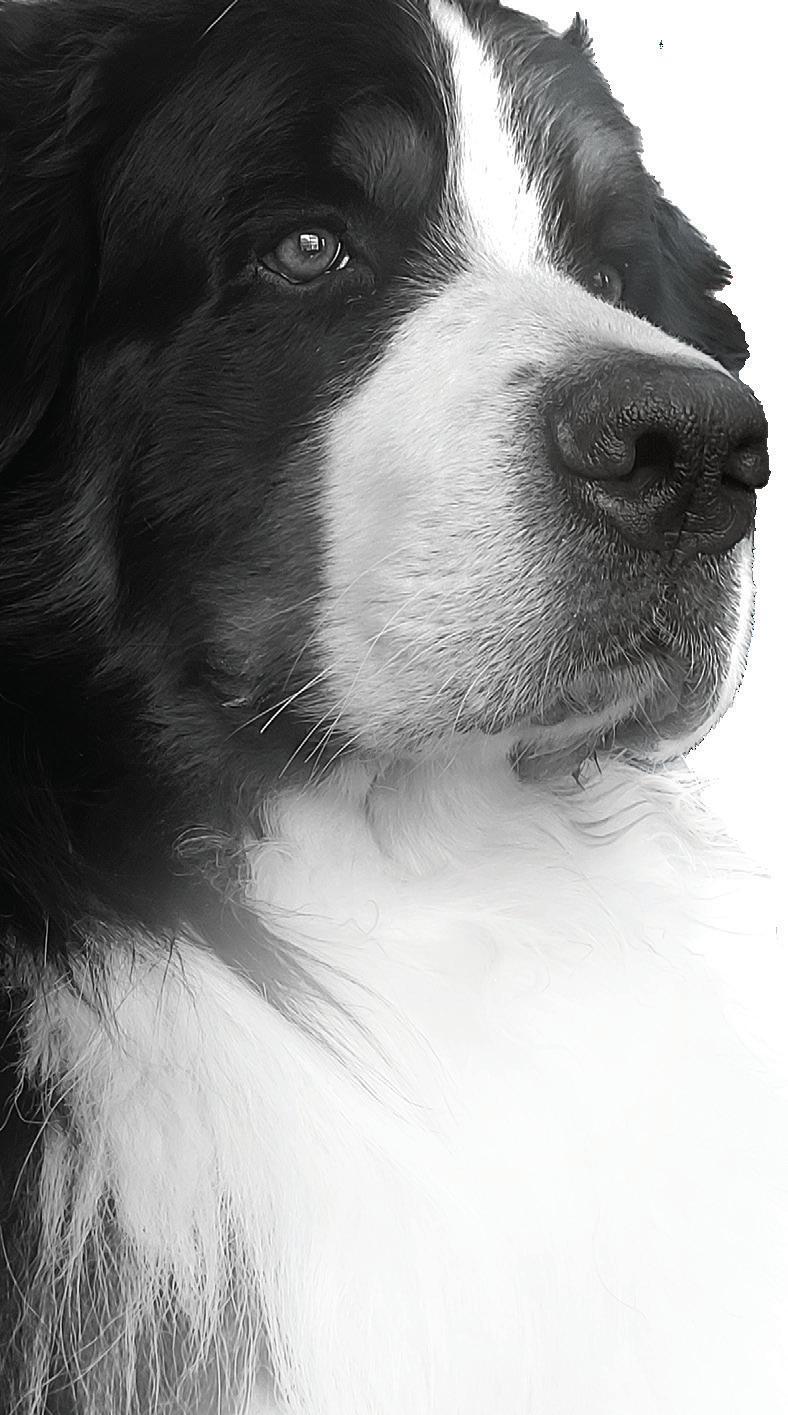
IS YOUR BERNER AFRAID OF NOISE?
 BY ANNIE MCDANNOLD AND ANDREA BRACIKOWSKI, M.D.
BY ANNIE MCDANNOLD AND ANDREA BRACIKOWSKI, M.D.
Case scenario: At an indoor dog show, when my girl was 19 months old, while in the show ring, the building’s transformer blew. There was a very loud bang. Additionally, the lights went out but came back on within a minute. She was a little shaken up initially but recovered quickly. I brought her back to watch the groups show later in the afternoon. She took a nap ringside, showing no fear after the incident. I brought her back to the same show site four months later and she immediately panicked. Ever since we have been working through some pretty major noise aversion. She became afraid of fireworks, thunder and any loud noises. After two years of counter conditioning, she has come a long way. She will always have some noise phobia, but I am glad I had the resources that helped her not feel as afraid. – Annie McDannold
INTRODUCTION
Noise aversion is defined as unwanted behavior in response to normal auditory stimuli. Some studies estimate one-third to one-half of dogs have a degree of noise aversion. Yet, many people are unsure of how to manage it and/or are unaware of the varied modalities that may be helpful. Most dog owners don’t think to discuss noise aversion with their veterinarian to develop a proactive plan to address this important problem.
The cause of noise aversion in dogs is most likely a combination of genetics and the environment. Some dog breeds like gun dogs (e.g. Pointers, Setters, Spaniels) have been bred to be accustomed to the noise of a loud gunshot. In Bernese Mountain Dogs a more likely cause is lack of exposure to loud noises but genetics may play a role. A noxious environmental stimulus such as a loud bang, as in the case scenario {above/at right—we’ll specify once article is in layout}, experienced during a puppy’s vulnerable stage can be life altering. This is referred to as fear-imprinting. There is also a theory that changes in air pressure and atmospheric static electricity may play a role in the fear of thunder/lightning storms.
Age is a factor in the development of noise aversion. Puppies tend to go through multiple fear stages into their adolescence. Being aware of these vulnerable periods can help in the management of noise aversion. As mentioned in the case scenario, the unexpected adverse noise could not have been avoided or anticipated. If a puppy or young dog experiences a mildly unpleasant noise, and if it does not exceed his tolerance threshold, it may have less of an adverse reaction. Alternatively, older dogs who were not fearful of any noises may develop noise phobias possibly related to altered hearing acuity. Noise aversion tends to worsen over time and, if not treated, the behavioral response may become more exaggerated.
COMMON TRIGGERS:
• Fireworks
• Gunshots including air guns and cap guns
• Thunder
• Strong wind storms with or without heavy rain
• Backfiring of a car or truck
• Construction sounds such as a jack hammer
• Smoke detector or other beeping appliance
• Any noise perceived as unpleasant
BEHAVIORS ASSOCIATED WITH NOISE AVERSION
Mild reactions include:
• Tail tucking
• Pinning ears
• Shaking
• Clinging to owner
• Panting
• Drooling
• Pacing
• Hiding
More severe reactions include:
• Attempting to escape and run away
• Panic/extreme agitation
• Destructive behavior
• Self-injurious behavior
• Incontinence
The longer it takes for your dog to recover, the more severe the reaction.
MANAGING AND PREVENTING NOISE AVERSION
Management
Attempting to be proactive and create a safe and comforting environment for your dog is ideal but one can’t always predict the onset of a loud noise. It is okay if
72 ∙ THE ALPENHORN
BG# 155334.

they want to hide as long as it is a safe place. Bring them food and water as well as their bed. If it is time to go out to pee or poop, you can create a treat trail to encourage them. Place treats approximately 1-2 inches apart leading to the open door. Do not force them to go out. A puppy pad may work, too.
When stormy weather is expected, or on notoriously noisy occasions (e.g. July 4th and New Years Eve) start management modalities early. If there is a loud firework suddenly or unexpectedly during a neighbor’s party, begin treatment as soon as possible.
Treatment options:
• Acoustic masking using low frequency sounds. White noise, brown noise or loud music at a high enough volume may mask the sounds. Classical music has been shown to reduce stress and anxiety in sheltered dogs.
• A ThunderShirt has been shown to be effective.
• Remove the dog to a safe place: their crate with a soundproof cover or a heavy moving blanket, wellinsulated basement, shower stall/bathtub
• Be sure they have a collar with identification information in case they get out.
• Adaptil® as a collar, spray or plug in diffuser.
• Comfort your Berner. Some like to be cuddled. Some do not. Try to read your dog’s body language. Stay calm yourself.
• Use a chew toy, puzzles, games, scent work to distract but always with supervision.
• Over the counter and prescription medications/ supplements include the following. Discussion with your veterinarian is required before starting these:
- CBD calming medication (complete spectrum proprietary hemp); requires a prescription in some states
- Zylkene®
- VetriScience® Composure™ Plus
- Benzodiazepines, e.g. Xanax®
- Sileo® (dexmedetomidine oral gel)
- Supplements such as Standard Process Min-Chex®, Rescue® Remedy, Bach Flower drops.
• Consider testing your dog for the optimal dose especially for the strongest medications.
• There are noise blocking wearables made for dogs, such as Mutt Muffs and Rex Specs Ear Pro. These will only be beneficial if your dog will cooperate. They may not block the lower frequencies of thunder and fireworks.
• A fan to mask the noise, the bigger the better!
Prevention
Counter-conditioning and desensitization (CC&D) are techniques used together for behavior modification. Counter-conditioning is a technique in which a stimulus that creates a negative emotional response is paired with a stimulus that elicits a positive emotional response or the dog is engaged in a pleasurable activity (e.g eating food
or treats). Desensitization is defined as a process that gradually extinguishes an emotional response such as fear and/or anxiety.
Desensitization to an unpleasant noise can begin when puppies are young, even in the whelping box. Play noises such as thunder, fireworks and drop a pan on the floor while the puppies are eating. Start with low volume and gradually increase. Observe closely to be sure they do not react with stressful behavior. There are YouTube videos and apps for your phone that can be helpful, also.
Try to be aware of incoming inclement weather and be prepared for known firework displays if possible. As we all know, our dogs hear thunder long before we do!
A veterinary behaviorist may be helpful by providing a comprehensive approach to dogs with severe noise aversion and reactions that do not seem to improve with usual methods. You may consider this book that contains a chapter on noise aversion: “From Fearful to Fear Free: A Positive Program to Free Your Dog From Anxiety, Fear and Phobias” by Marty Becker, et al.
Finally, consider breeding away from dogs with severe noise aversion, particularly if you see the trend in multiple offspring.
CONCLUSION
By recognizing the signs and symptoms of noise aversion, identifying triggers and implementing proactive and reactive strategies, owners can create a supportive environment for their beloved pets. Always consult with veterinary professionals for personalized advice tailored to your dog’s unique needs. Together, we can help our dogs navigate the noisy world with confidence and comfort.
About the Authors: Annie McDannold is an animal lover who has worked as a veterinary technician and dog trainer and is an accomplished photographer. She is active in conformation and has dipped her toes into multiple sports. Annie joined the BMDCA in 2020 and has attended multiple national specialties as both an exhibitor and as a ringside photographer. As well, she took on the website chair position in June 2022. She is owned by a 4-year-old Samoyed, Lumi, and her 3-yearold Berner, Nero.
Andrea Bracikowski, MD is a retired physician having worked 25 years at the Monroe Carel Jr. Children’s Hospital at Vanderbilt in Nashville, Tennessee. She practiced Pediatrics, Pediatric Emergency Medicine and Pediatric Sports Medicine. She acquired her first Bernese Mountain Dog in 1989 and has owned 13 Bernese. Her Berners are beloved family pets and she is involved in conformation, obedience, scent work and agility. She serves as the Chair, BMDCA New Membership Committee. Dr. Bracikowski has had a special interest in canine health as related to the breed. She currently owns three Bernese: Cara Mia, Naldo and Bunty.
SPRING 2024 ∙ 73

SPIRIT'S STORY Part 2
ATYPICAL ADDISON’S DISEASE AND IBD
BY ROBIN HAMME
Jack be nimble, Jack be quick, Jack jump over The candlestick.
PROLOGUE
Spirit’s story was published in The Alpenhorn’s 2023 spring issue. Part 2 of Spirit’s story – his continuing battle with IBD – starts where the original story ended in December 2022. The news shared then was optimistic. “Spirit is a different dog than he was a year ago. It’s our hypothesis that his gut has healed, his allergies are well controlled and his hormones are no longer raging. He looks and feels great, eats with gusto, is at his ideal weight and once again enjoys performance sports. His sense of humor has returned, there’s a sparkle in his eyes and a ready smile on his face.” But life can be fickle; it can turn on a dime. One must be vigilant, nimble and quick.
1 For one of Spirit’s two daily meals, we fed a high grade, raw commercial product that we could secure locally and came frozen. The other meal was a limited ingredient kibble, preferably the “lightly baked” variety so it was easier to digest. We selected at least three proteins (avoiding chicken) for the raw food and three or more varieties (different manufacturer and ingredients) for the kibble meal. For additional “good” calories, we added cooked sweet potato or plain quinoa which we rotated. The goal was to keep the digestive system inflammation at bay by constantly varying his food so that it’s harder for an allergy to develop. We rotated the raw and kibble meals each day.
SPRING – EARLY SUMMER 2023
Generally, Spirit continued to do well, remaining on the diet outlined in the original article. 1 From time to time, however, he’d have a setback, meaning that he’d start leaving food, then skip meals, and for short times just stop eating. During those times, he was worse in the morning. But we remained successful in getting him going again – eating regularly. Until…
In late June 2023 we were on vacation with family and our dogs had come along. We rented a beautiful house on lake front property. Spirit was in seventh heaven swimming, going boating and enjoying the good life with us all. Two days into our vacation he went “off” – really off. In a matter of two days he ceased eating, had severe diarrhea, was lethargic and the happiness had drained from his face. The dog was crashing. He was acutely ill, and we knew we didn’t have time to waste. We left immediately and headed home to seek medical attention.
74 ∙ THE ALPENHORN
Robin Hamme (sitting) with Spirit (BG# 155331), Ruth Nielson and Karyn Beyer. Photo by Clicking to Capture.
In a matter of two days he ceased eating, had severe diarrhea, was lethargic and the happiness had drained from his face. The dog was crashing.
than an occasional bite of banana, apple or carrot, his only food was and continues to be the Royal Canin hydrolyzed products noted above. We switched his monthly anti-parasitic medicine to a liquid one administered by our vet practice which does not contain any meat flavoring. He continues to receive daily allergy meds, CBD, B12, D3 and a suitable probiotic (we use The Wolf by Roots).
But Spirit still had periodic setbacks. At the first inkling that he was going “off,” our vet temporarily increased the frequency of his prednisone to regain control and steady things out. We were all scratching our heads. This just didn’t make sense. We were missing something, but what? The one pattern we saw was he went “off” in periods of stress, such as being away from home.
NOW – JANUARY 2024
In consultation with our long-time vet, we all concurred that Spirit needed a new path forward. His recent food sensitivity / allergy test indicated that he was allergic to almost everything. No longer could we find food, raw or dry, that he could tolerate. The first order of business was to pull him through this crash. Losing him loomed as a very real possibility. Our mantra was, “never again IBD, never again.”
Spirit was immediately switched to a prescription hydrolyzed dog food. We first tried Purina HA, which he didn’t like. We then tried Royal Canin’s Ultimino, which he grew to like. Luckily, Royal Canin also offers hydrolyzed treats, which he loves. In addition to his new food, Spirit was put on prednisone which started at a high, daily dosage. It was a long 10 days, but Spirit finally turned the corner and started eating again. Slowly he began feeling better. Slowly he returned to being Spirit. We had dodged a bullet.
JULY 2023 – EARLY JANUARY 2024
Over the next six months Spirit’s prednisone regimen decreased both in dosage and frequency. He had progressed down to 5 mg every three days and was doing well. We no longer administered his pills in a little bit of cream cheese fearing that could cause a flare up. We became adept at “pilling” him. Other
2 VCA Animal Hospitals, Cushing’s Disease – Testing, https://vcahospitals. com/know-your-pet/cushings-disease-testing
In early January 2024, our vet had an idea. There was one test that we’d never run. (We’d run and rerun every test that could be thought of, and the lab results never yielded any insights or answers.) The test we’d never tried though, was the ACTH stimulation test.
ABOUT THE ACTH STIMULATION TEST
“ACTH is a hormone naturally produced by the pituitary gland (a gland located in the brain). The purpose of ACTH is to tell the adrenal glands when and how much cortisol to produce. As the blood level of cortisol increases, it causes the pituitary gland to decrease its production of ACTH, which results in a lowering of the cortisol level. The ACTH stimulation test mimics this natural stimulatory pathway and demonstrates the capacity of the pet's adrenal glands to produce cortisol in response to an injection of synthetic ACTH. This test requires two blood samples. The first blood sample is taken, then an injection of synthetic ACTH is given, and the second blood sample is taken two hours following the injection. When the cortisol levels in the two samples are compared, they may show a normal response, an exaggerated response or very little response.” 2
ABOUT THE ADRENAL GLAND, CUSHING’S DISEASE, AND ADDISON’S DISEASE
What follows are excerpts from the Merck Veterinary Manual. (https://www.merckvetmanual.com/ dog-owners/hormonal-disorders-of-dogs/disordersof-the-adrenal-glands-in-dogs)
“The adrenal cortex is subdivided into 3 layers, and each layer produces a different set of
SPRING 2024 ∙ 75
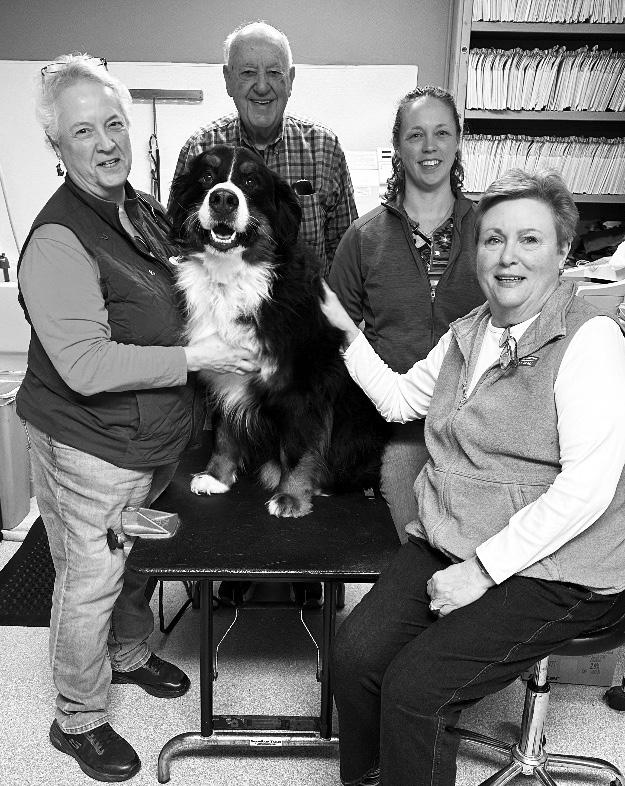
Spirit (BG# 155331) loves his care team. Dr. Parsons and Kristen delivered his litter via C-section and have been a huge part of his life ever since. Kristen showed Spirit to his AKC Grand Championship in 2022. We are so grateful that Dr. Parsons solved the mystery of Spirit’s root cause illness – Atypical Addison’s Disease. From left to right: Dr. B. J. Parsons (Kanuga Animal Clinic, Hendersonville, NC), Spirit, Gene Hamme, Kristen Apodaca (Practice Manager and Veterinary Technician), Robin Hamme. Photo by Tatum Wenzel, Veterinary Assistant.
steroid hormones. The outer layer produces the mineralocorticoids, which help to control the body’s balance of sodium and potassium salts. The middle layer produces glucocorticoids, which are involved in metabolizing nutrients as well as in reducing inflammation and immune responses. The inner layer produces sex hormones such as estrogen, progesterone, and androgens.”
“The adrenal medulla plays an important role in response to stress or low blood sugar (glucose). It releases epinephrine (sometimes also called adrenaline) and norepinephrine, both of which increase heart output, blood pressure, and blood glucose, and slow digestion.”
“Cushing disease, also referred to as hyperadrenocorticism, is a common endocrine disease in adult and aged dogs. The signs result primarily from chronic excess of the hormone
3 Doug Brum, DVM, Atypical Addison’s Disease, https://www.mspca.org/ angell_services/atypical-addisons-disease/
cortisol. Increased cortisol levels in dogs may result from one of several mechanisms. The most common cause (85% to 90% of cases) is a tumor in the pituitary gland. The pituitary tumor produces a hormone that triggers excessive development of the adrenal gland. Less common (10% to 15% of cases) is a tumor in the adrenal glands themselves. Long term use of corticosteroid drugs (for example, to decrease inflammation or treat an immune disorder) can also cause signs of Cushing disease ( see Cushing Disease).”
“Addison disease, also called hypoadrenocorticism, is caused by a deficiency of adrenal gland hormones. It is most common in young to middleaged dogs. The cause is usually not known, but an autoimmune condition in which the body destroys some of its own tissue is likely. The adrenal gland can also be destroyed by other conditions, including medications used to treat Cushing disease and cancer in other parts of the body. Secretion of aldosterone, the main mineralocorticoid hormone, is reduced, which affects the levels of potassium, sodium, and chloride in the blood. Potassium gradually builds up in the blood and, in severe cases, may cause the heart to slow down or beat irregularly. Some dogs have such a slow heart rate (50 beats per minute or lower) that they can become weak or go into shock. Decreased production of glucocorticoids (such as cortisol) results in moderately low blood sugar. Dogs with atypical Addison disease can have low blood levels of cortisol but normal levels of sodium, potassium, and chloride.”
ATYPICAL ADDISON’S DISEASE
You’ll read more about Atypical Addison’s Disease in the companion article by Doug Brum, DVM 3 but an excerpt follows: “Canine glucocorticoid deficient hypoadrenocorticism or “Atypical” Addison’s disease is being identified in our canine population with greater frequency. The term describes dogs with adrenal glands that still produce mineralocorticoids but lack sufficient glucocorticoid production. Atypical Addison’s disease used to be considered a much rarer condition than the classical Addisonian but now is identified in up to 30-45% of dogs diagnosed with the hypoadrenocorticism.”
Spirit’s Diagnosis – Atypical Addison’s Disease: When Spirit’s ACTH stimulation test results returned and the diagnosis was Atypical Addison’s Disease, we were all surprised, but upon reflection, we shouldn’t have been. It’s so Spirit!
76 ∙ THE ALPENHORN
He’s now on a low-dose, maintenance regime of prednisone. When we think he’ll be in a stressful situation (e.g., being away from home), the frequency of his medicine will increase and then be tapered back to his maintenance regime when the stressful situation is over. In terms of future testing, the ACTH stimulation test will be done yearly along with a complete blood panel which will also check his electrolytes.
This is a new ball game for us and we’re early in the process of learning and seeing how things go. We’ll share what we learn along the way.
In the meantime, here’s what we’re doing to share this information with the Berner community and there are important things you can do to help as well:
- Any new health information regarding Spirit will be provided to the Berner-Garde Foundation (BGF) for inclusion in records.
- After reaching out to BGF about this new diagnosis for Spirit, they are adding Atypical Addison’s Disease to their disease selection menu. Currently only Addison’s Disease is included. Thank you, Berner-Garde!
- In addition to bringing Atypical Addison’s Disease and Spirit’s story to the attention of BGF,
I’ve posted information on the Facebook group page for BMD Digestive Issues.
- Please be sure to update your dog’s health information in the Berner-Garde database.
- If your dog has an illness that doesn’t clear up or things just don’t make sense, keep digging. While we thought that IBD was the root cause of Spirit’s problems, it wasn’t. Our digging yielded a further diagnosis of Atypical Addison’s Disease, something we’d never heard of. Perseverance pays off. Be nimble, be quick and never give up.
Together, through the open sharing of information and experiences, we can lick these diseases plaguing our beloved Berners, hopefully improving the quality and longevity of their lives and extending the precious time we have with them.
About the Author: Robin and her husband, Gene, have had Berners since 1993 and joined the BMDCA in 1994. Both are lifetime members, having received the BMDCA Outstanding Service Award. Robin has held various roles in the BMDCA over the decades, some of which include Vice President, creator and editor/ writer of the BMDCA Info Series, Editor-in-Chief of The Alpenhorn and Breed Ambassador. Health, particularly focusing on IBD and its relationship with other diseases, is one of her highest priorities.
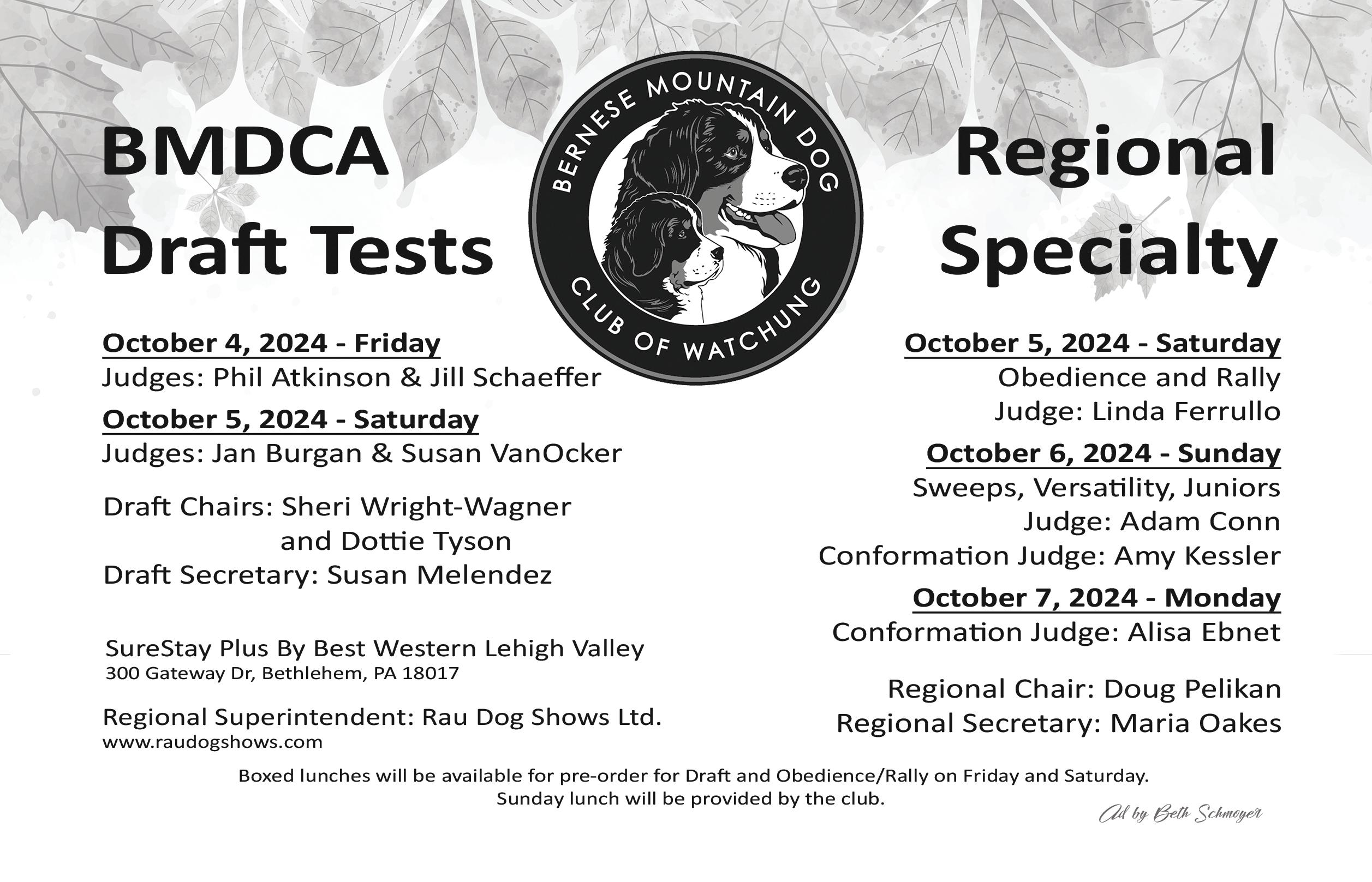
ATYPICAL Addison's Disease
BY DOUG BRUM REPRINTED WITH PERMISSION OF MSPCA-ANGELL
Canine glucocorticoid deficient hypoadrenocorticism or “Atypical” Addison’s disease is being identified in our canine population with greater frequency. The term describes dogs with adrenal glands that still produce mineralocorticoids but lack sufficient glucocorticoid production. Atypical Addison’s disease used to be considered a much rarer condition than the classical Addisonian but now is identified in up to 30-45% of dogs diagnosed with the hypoadrenocortisism. Both types of Addison’s disease still occur with greater frequency in younger dogs with the average age of diagnosis about 4-5 years of age. Female dogs account for about 70% of the cases, and there is a heritable component in Standard Poodles, Bearded Collies, Portuguese Water Dogs, and the Nova Scotia Duck Tolling Retriever.
Atypical Addison dogs usually have more subtle clinical signs and may be more difficult to diagnose. Usually these dogs do not present in a crisis, nor are they severely dehydrated, bradycardic, or in hypovolemic shock as they still have mineralocorticoid function. Their signs are glucocorticoid dependent and subtler. Clinical signs vary but may include, vomiting, diarrhea, anorexia, lethargy, or weight loss. The most typical history we see is a young dog with chronic intermittent histories of gastrointestinal issues. They commonly have episodes or signs that “wax and wane.” Some of these dogs have been sent in for GI work ups including the recommendation for endoscopic biopsies. Atypical Addison’s should be ruled out before endoscopy.
Addison’s disease has often been called the “great imposter” as it can mimic many other diseases and is often difficult to initially diagnose. Since dogs with atypical Addison’s disease still have mineralocorticoid function, they lack the typical electrolyte abnormalities commonly associated with hypoadrenocorticism. Their sodium and potassium values are often normal, so other blood abnormalities need to be noted to guide in the diagnosis. A lack of a stress leukogram in an ill animal is commonly seen in animals with a cortisol deficiency.
More subtle lab abnormalities signs include a mild to moderate hypoalbuminemia, and hypocholesterolemia, once again pointing to GI disease, but decreased cortisol levels can also be the problem. When a young dog presents for only hypercalcemia or eosinophilia, atypical Addison’s needs to be considered. Other dogs, especially toy breeds, may present just with hypoglycemia. A dog could have only one of these lab abnormalities, or multiple. It is important to rule atypical Addison’s out before getting into more extensive work ups in all these conditions.
An excellent, and cost efficient way to rule out atypical Addison’s disease is by running a basal cortisol level. If your patient’s basal cortisol level is over 2 mcg/dl the dog unlikely will have Addison’s disease. Values below 2 mcg/dl don’t diagnose the disease, it just means that the dog could have Addison’s disease and an ACTH stim should be run. Even if the basal cortisol level is at the lowest level detectable for your lab, an ACTH stim needs to be done to diagnose the condition, as some dogs that have very low basal cortisol levels still will have cortisols that stimulate to acceptable levels.
Dogs with Addison’s disease usually have ACTH stims with the pre and post cortisol under 1mcg/dl, but if both values are under 2 mcg/dl, it is diagnostic for Addison’s disease.
Occasionally in dogs that are tested early in disease progression, the cortisol concentrations may be slightly higher. “Flat-line” cortisol responses can be seen when a pre-ACTH cortisol level might be 3 mcg/ dl, and a post-ACTH cortisol might be 3.3 mcg/dl). Retesting these dogs in 4-6 weeks might show more definitive results.
Another factor that could confound a diagnosis is if a dog has received prednisone before doing either a basal cortisol level or an ACTH stim. Giving prednisone prior to doing a cortisol level will falsely increase the measured cortisol, possibly giving a false negative result.
78 ∙ THE ALPENHORN
The key in treating all atypical Addison’s dogs is to give them the smallest amount of prednisone or methylprednisolone to control their clinical signs and minimize any potential side effects of the corticosteroid.
The treatment of glucocorticoid-deficient Addison’s disease involves using the lowest effective dose of prednisone that controls the dog’s clinical signs and minimizes any long-term prednisone side effects. Typically, after initially establishing a diagnosis, higher doses of prednisone may be used (up to 1mg/kg/ day) but these doses may be rapidly decreased to a maintenance dose closer to 0.1-0.2mg/kg/day. All dogs are different, and some dogs need less than 0.1mg/kg/day or only need it every other day. As with typical Addisonian dogs, in stressful situations, the maintenance dose of prednisone is usually doubled.
Sometimes dogs receiving long-term prednisone for the treatment of their disease begin to show side effects of long term prednisone administration (the most common are polyuria/polydipsia/primary polydipsia (PU/PD/PP)) even at fairly low prednisone doses. In these dogs changing prednisone to methylprednisolone may significantly improve their clinical signs.
The key in treating all atypical Addison’s dogs is to give them the smallest amount of prednisone or methylprednisolone to control their clinical
signs and minimize any potential side effects of the corticosteroid. If doses of prednisone significantly higher than 0.2mg/kg/day are needed to control a dog’s clinical signs, then it is possible that the patient may have another disease that the prednisone is treating. The atypical Addison’s dog that had chronic intermittent GI signs, and requires higher doses of prednisone, may also have inflammatory bowel disease (IBD), and the higher doses are actually treating the IBD. Establishing the diagnosis of IBD would allow you to treat the IBD with different modalities, allowing for a smaller dose of prednisone, and thus fewer side effects.
Dogs with atypical Addison’s disease typically live excellent quality lives and the disease does not affect the dogs’ life expectancy. Dogs should be evaluated at least twice a year, and electrolytes should be monitored. It is rare that a dog with glucocorticoid deficient Addison’s will develop classical Addison’s, with electrolyte abnormalities, but it has been reported.
Some have suggested that it is safer to prophylactically give these dogs DOCP to reduce the chance of an Addisonian crisis that could develop if a dog becomes mineralocorticoid deficient as well. Most veterinarians no longer recommend this due to expense and the unlikely event that their disease will progress. Routine monitoring with physical examinations, blood work and client education is usually sufficient.
Remembering atypical Addison’s as a possible cause of many subtle signs or specific lab abnormalities, can save you and your clients extensive diagnostic work ups and significantly improve the quality of life of our patients.
About MSPCA-Angell
One of the first humane organizations in America, founded shortly after the Civil War, the MSPCA-Angell has seen vast changes in society, the environment, and the roles of animals in our lives. It has helped make laws and set standards that have fundamentally shaped our sense of kindness and care for animals –and for one another.
Today, the MSPCA-Angell continues to rescue, shelter, protect, heal, and advocate for more animals than any other American humane organization, giving hands-on care to many thousands of animals each year. We also provide emergency assistance and strategicplanning help for animal-protection groups across the country and around the globe. Through our legislative work, humane-education efforts, and communitybased assistance initiatives, we help create lasting change for animals and people.
SPRING 2024 ∙ 79
WHAT DO THE
JUDGES WANT TO KNOW?
BY NANCY STEWART
Anyone who shows in conformation probably has asked themselves, at some time, “What was that judge thinking?” The partner question to that is “Where did they get that idea? Did anyone educate them?” The answers are of course as diverse as the judges themselves.
All permit and approved judges have gone through the AKC Judging Approval Process. They have been mentored, tested, interviewed and observed. However, the reality of the show ring does not usually follow an ideal template. Hopefully, as each judge goes through the process of being qualified to judge our breed, they have been mentored by one of our parent club approved mentors. Each of these people has been approved by the BMDCA board to act as a mentor. All member judges are automatically approved mentors and serve a valuable role because they have gone through the process and know how important mentoring is to prospective judges.
Since exhibitors are often approached by prospective judges with questions about Bernese Mountain Dogs, we thought it would be useful to discuss what the most asked questions are and how they are addressed by the standard. We asked the parent club approved mentors to weigh in on the most common questions for this discussion.
• The number one question invariably is about markings. At all seminars and judging institutes, we discuss at length the fact that markings are just the icing on the cake. Our standard discusses the ideal markings and this can be interpreted by a new judge as a requirement. A white tail tip does not mean the entire end of the tail is white, but that is how some interpret it. Four white feet are ideal but the amount or lack of white is certainly not what makes a draft dog. The list goes on. Since few Bernese Mountain Dogs have perfect markings, we need to attempt to convey that those variations, mild or major, should not be a deal breaker for a quality dog.
• Many judges ask questions about coat type. The standard states “the coat is thick, moderately long and slightly wavy or straight.” Many judges question the curly coat often seen on younger dogs and the very straight coat sometimes evident on highly groomed animals. We need to emphasize that the dogs need an undercoat to
protect them against harsh weather but that the variations in the topcoat are to be expected. We also try to point out that some handlers are more expert at grooming than others so the coat must be felt to assess quality. Likewise, the standard states that the dogs are to be “shown in natural coat and undue trimming is to be discouraged.” This can be a hard point to get across since conformation showing is often viewed as a beauty contest, but judges need to understand that our working breed is judged on structure, not grooming perfection.
• Proportion is often a question, and appearance can be affected by grooming. We want a dog slightly longer than tall, slightly being a key word. Balance is important in all aspects of our dogs and the 9:10 ratio, and equal front and rear angles are the ideal. Judges need an eye for this balance. Long and low is incorrect, as is tall and square.
• Judges ask about the bite. What to do with a level bite as it is not addressed in the standard. The standard states that the “teeth meet in a
It is important to realize that those judges who are learning about the breed, and those who approach us with questions, are trying their best to understand in order to adjudicate properly.
80 ∙ THE ALPENHORN
scissors bite. An overshot or undershot bite is a serious fault. Dentition is complete.” An otherwise outstanding example of the breed should not be dismissed because of a level or less than perfect bite.
• Judges often question the speed at which our dogs should be moved in the show ring. We try to emphasize that “the natural working gait of the Bernese Mountain Dog is a slow trot. However, in keeping with his use in draft and droving work he is capable of speed and agility” as stated in the standard. This concept appears to be easier for them to recognize in the breed ring than in the groups where speed seems to be king. What is important here is that they understand the value of movement at a working pace on a relatively loose lead.
• Many times we have been asked if certain head types are correct. Our standard contains statements about eyes, expression, ears, skull, lips and bite. In seminars we refer to the illustrations and photos in the Illustrated Standard for judges to view some outstanding heads. We want them to have a mental picture of good head type but realize that there are variations within these guidelines.
• Judges often ask how they should prioritize the different aspects of the breed. There is no point system here. The Bernese Mountain Dog is moderate in most aspects. He is large, sturdy, balanced, intelligent and strong. He must be sound in all physical and mental aspects in order to do his job and be a well-rounded farm dog. Our goal is to help prospective and current judges develop a mental picture of that dog and apply it when judging the breed.
In conclusion, it is important to realize that those judges who are learning about the breed, and those who approach us with questions, are trying their best to understand in order to adjudicate properly. When any exhibitor is approached and has the opportunity for breed discussions with prospective or current judges, we ask that the AKC Standard, Illustrated Standard, and Breed Judging video are the tools utilized to answer those questions.
About the Author: Nancy Stewart has owned Bernese Mountain Dogs since 1985, the same year she joined the BMDCA. Nancy is a past president of the club and has been approved to judge BMDs since 2008. She currently serves as chairman of the Judge's Education Committee.
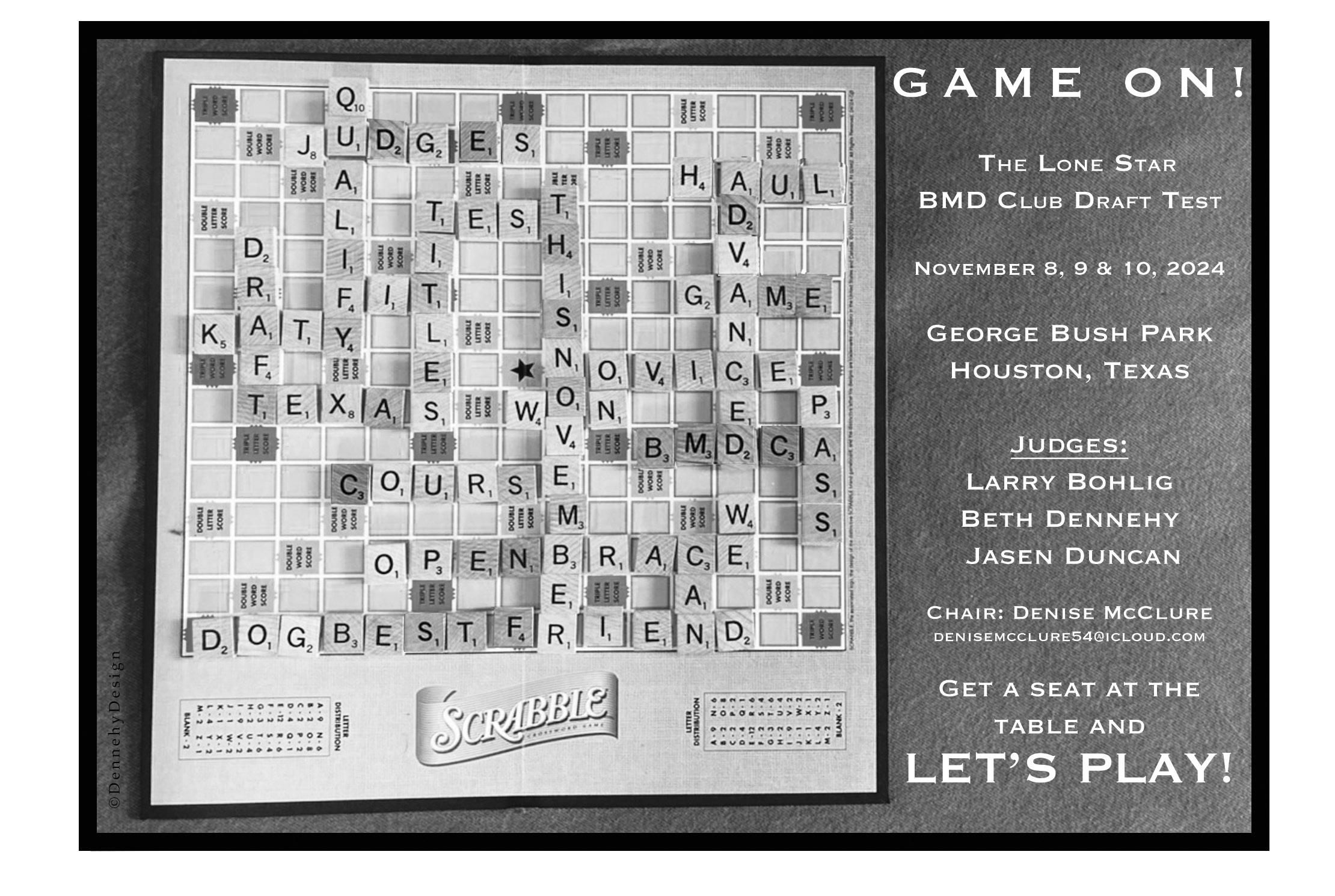
CANINE HEAT STR KE
PREVENTION, SYMPTOMS AND TREATMENT
BY LISA KAUFMAN
HELP YOUR BERNER BEAT THE HEAT
As much as we have a problem dealing with the summer heat and humidity, it is even harder for our Bernese. Dogs are unable to cool themselves like we can. When we get hot, our sweat glands kick in and help us cool ourselves. Dogs don’t have sweat glands; therefore, they pant or drink water to try to cool themselves. Panting isn’t a very efficient way to dissipate heat, and it puts dogs at risk for overheating and heat stroke.
Many Bernese are exceptionally sensitive to heat. It is up to us to keep an eye on our dogs, take steps to help keep them cool, recognize when they are getting overheated and then take quick action to cool them.
Some ways we can help our Bernese beat the heat:
• Always keep fresh, cool water accessible and available to ensure your Berner stays hydrated.
• Take water with you when walking, exercising or traveling with your four-legger.
• Offer water every 15 minutes while walking rather than waiting until you get to your destination.
• Stay indoors in air conditioning during times of extreme heat or humidity. Walk your Berner during the cooler times of the day—early morning or later evening, but never after a meal.
• Be aware of hot pavements because they can quickly burn a dog’s paw pads.
- Keep on grassy surfaces.
- Consider doggy booties to protect sensitive paw pads.
- If the concrete or asphalt is too hot for the back of your hand to tolerate for seven seconds, then it is much too hot for your dog’s paw pads!!
• Fill a kiddie pool with water or find a safe body of water for your Berner to splash around in.
• Give cool treats such as a frozen Kong toy with peanut or almond butter; pupsicle (blend cantaloupe or watermelon or blueberries with unsweetened yogurt or xylitol free peanut butter and freeze).
• Use cooling mats.
• Limit outside time; be sure there is access to shade.
• NEVER leave your dog in a car unattended. Cars can be a deathtrap for dogs; the temperature within a car (even with windows rolled down during the heat of summer) can rise quickly from 80 degrees Fahrenheit to well over 120 degrees Fahrenheit.
- It is illegal to leave dogs in a car unattended in some states and cities.
- Senior dogs, obese dogs and those with chronic heart or lung diseases should be watched closely and kept in the air conditioning.
• Normal dog body temperature is 101° F rectally. If it is 103° F, your dog is getting overheated, and as it climbs, it is an emergency. Rush your dog to a vet immediately!
SUMMER HAZARDS: DEHYDRATION, OVERHEATING AND HEAT STROKE
Overheating is preventable but if it occurs, it can be deadly! It can cause brain swelling, liver or kidney damage and cardiac arrest. As the proteins in the body overheat and denature, bleeding can occur.
• Know the signs of overheating in your Berner:
• Panting increases, tongue becomes longer and wider as the dog gets hotter and hotter
• Bright red tongue
• Extreme drooling
• Dry, pale gums
• Rapid heart rate
• Glazed eyes
• Weakness
• Ataxia/Stumbling
• Lethargy
• Vomiting
• Diarrhea
• Seizures
• Loss of consciousness
The best indicator is his body temperature. Buy a rectal thermometer for your dog and learn how to use it correctly so you can check his temperature.
If you suspect your dog is overheating:
• Move your dog into air conditioning; if you are outside without access to a cool, indoor location, move him to a shaded spot
• Offer water
• Check his rectal temperature
Start cooling your Berner by using cool (not ice cold) water to cool him down. Place him in a kiddie pool or in a body of water, spray water over him, or place wrapped ice packs or bags of frozen veggies in his armpits and groin. Cool wet towels can be used if ice/icepacks/ frozen veggies aren’t available. The cool, wet towels can also be applied to his feet and underbelly. The goal is to bring your dog’s temperature down to 103° F and get him to a veterinarian.
82 ∙ THE ALPENHORN
Overheating is
preventable but if it occurs, it can be deadly!
During the hot summer months, pay extra attention to your furry pal’s comfort to help prevent overheating— enjoy ice cream together, splash in the pool, cozy up to the A/C and remember how blessed you are to have a Berner in your life!
ADDITIONAL INFORMATION:
https://www.akc.org/expert-advice/health/heatstrokein-dogs/
https://www.akc.org/public-education/ resources/general-tips-information/ summer/#:~:text=Heatstroke%20can%20occur%20 and%20lead,in%20a%20hot%2C%20parked%20car.
https://www.akc.org/expert-advice/health/dogsoverheating-signs-symptoms-prevention/ About the Author : Lisa Kaufman has been in the breed since 2002 and has been owned by six Berners so far. She has competed in performance events and dabbled in conformation a bit.
She is on the BMDCA Health Committee, is a BernerGarde operator and trustee, Breed Ambassador and volunteers in other areas.
General Information:
• Dogs do not sweat through their skin like humans – they release heat primarily by panting and they sweat through the foot pads and nose.
• Once the dog’s temperature reaches 106°, damage to the body’s cellular system and organs may become irreversible.
• Heat stroke is a very serious condition that requires immediate medical attention. Once the signs of heat stroke are detected, there is precious little time before serious damage – or even death – can occur.
Side Note: Always remember to be careful when walking your pets on hot surfaces like concrete and blacktop! If they are going to be walking on this please consider paw protection like booties or a product like PawFriction, for example.
Prevention:
• Never leave your pet in a car unattended
• Allow acclimation to exercise on hot days
• Always have access to fresh cool water
• Use cooling mats
• Use cooling vests/coats
• Give access to a fan
Symptoms: Initial
• Unanticipated restlessness
• Heavy panting
• Hyperventilation (deep breathing)
• Increased salivation
• Weakness
• Confusion
• Vomiting or diarrhea
Symptoms: Late Stage
• Obvious paleness or graying of the gums
• More shallow respiratory efforts and eventually slowed or absent breathing efforts
• Vomiting and diarrhea that may be bloody
• Seizures or coma
• Listlessness
• Weakness
• Recumbent
Treatment:
The below was put together by Tori Pinkas Harned, RVT, for her vet clinic and clients.
• It cannot be over emphasized or repeated enough that heat stroke in dogs can quickly turn deadly if not treated immediately and aggressively. Successful treatment requires intensive emergency care at a veterinary clinic.
• Early recognition is the key to treatment success. Call your vet as soon as you suspect an issue and let them know you are on your way.
• Cool your car prior to heading to the vet clinic.
• Offer cool water.
• Use a cooling mat in the car and cooling coat/ vest or a cool wet towel if you do not have these previous items.
• Apply rubbing alcohol or cool water to pads, armpits and groin to help cool the dog.
• Cooling a hyperthermic dog too quickly can cause its blood vessels to restrict (peripheral vasoconstriction), which can impede heat dissipation.
• Do NOT put your dog in an ice bath, as a dog’s temperature must be brought down gradually.
-40 0 -40 80 -20 20 60 100 -30 10 50 90 -10 30 70 110
OVERVIEW
SPRING 2024 ∙ 83
INTERNATIONAL SPOTLIGHT
WORLD UNION OF BERNESE MOUNTAIN DOGS HEALTH SYMPOSIUM
BY PAT LONG
About every two years one of the European Berner clubs hosts the International Working Group, with health representatives from each of the clubs invited to participate. At the same time the club also hosts a health symposium, which is now organized by the World Union of Bernese Mountain Dogs. In 2023 the events were hosted by the Club Suisse du Bouvier Bernois in Divonne-les-Bains, France near Geneva, Switzerland. I was the BMDCA’s health representative and have also been the secretary for the International Working Group since 2007. I have summarized the presentations, which are also available on berner-iwg.org.

Summary of Berner IWG Meeting
HELD WEDNESDAY, AUGUST 23, 2023
WATERLAND ESTATE, AMSTERDAM, NETHERLANDS
Club Representatives present:
Karoline Gsell VSSŌ (Austria)
Martina Kopecká KSSP (Czech Rep)
Inge Bibby DBSK (Denmark)
Steve Green BMDCGB (England)
Christine Malherbe AFBS (France)
Christian Schmid DCBS (Germany)
Kira Martin MBE (Hungary)
Isabella Tosti CIABS (Italy)
Jovita Piskunoviene ŠZMK (Lithuania)
Wendy van Dijk VBSH (Netherlands)
Bjørg Andreassen NBSK (Norway)
Gabriela Manu ACCCE (Romania)
Terézia Gargušová SKSSP (Slovakia)
Birgitte Damsgaard (Sweden), IWG website manager
Toril Melangen SShK (Sweden)
Martha Cehrs KBS (Switzerland), IWG President
Pat Long BMDCA (USA), IWG secretary
Individual Members present:
Gerhard Kunz (Austria)
Carla van Assche (Belgium)
Jens Utke Ramsing (Denmark)
Lisbet Utke Ramsing (Denmark)
Tanya Shields (Ireland)
Silvana Tedeschi (Italy)
Vigdis Løken (Norway)
Norbert Strahl (Spain)
Lori Jodar (USA), representing Berner-Garde
Gary Galunas (USA), representing Berner-Garde
Bodil Strom Holst (Sweden), representing Sweden
University of Agricultural Sciences
Martha Cehrs, presiding.
Pat Long, secretary.
84 ∙ THE ALPENHORN
Members of the BMDCA attend the World Union of Bernese Mountain Dogs. From left to right: Nancy Stewart, Gary Galunas, Karlo LaFoteza, Kris Hayko, Clark Powell, Celia Cueller, Dan Cueller, Sheri WrightWagner, Lori Jodar. Photo courtesy of Lori Jodar.

France
IWG Meeting
1. Martha Cehrs welcomed everyone to the meeting.
2. Agenda has not changed
a. Berner-Garde Presentation
b. Presentations by the club representatives
c. Break
d. Presentation by Dr. Bodil Holst about fertility
e. End at 18:15
f. Dinner at 18:30
3. Berner-Garde presentation by Gary Galunas (he has provided the slides for the IWG website)
a. A chart of the top list of diagnosed health records for the last 10 years was provided
b. International submissions have increased over the last three or four months, probably due to the sale of Ingrus, and their new payment requirement.
c. Questions were raised about the possibility of combining BG and Dogbase, but Dogbase is only available to members, and BG is open to the public.
d. Christian Schmid will talk to Gary about adding their database to BG
e. Agria’s database about cause of death (see https://www.ncbi.nlm.nih.gov/pmc/articles/ PMC1624818/ as an example)
4. Country reports: The meeting then gave a chance for the representatives from each country to contribute updates and news from their countries.
a. Austria (Karoline Gsell) – It’s a small country and club. HS tests are required and required to be open in HSIMS, too few to date. Renal failure is said to be an issue; a questionnaire to breeders was answered by one breeder, who had four affected puppies – two each
from two litters. Longevity is an issue. Education of new and small breeders is important. Big breeders are seen as a negative, but they have known lines for more than two generations. Suggestion from someone - Perhaps calling them long time vs short time breeders would help?
b. Czech Republic (Martina Kopecká) – DNA is taken from each breeding dog and stored. It costs €75. It’s used for registration and to check parentage.
c. Denmark (Inge Bibby) – The club is holding Berner-Garde workshops and seminars, and using mentors.
d. France (Christine Malherbe) – They have a new president and are eager to see how responsive he is to health initiatives.
e. Germany DCBS (Christian Schmid) – 50% of pregnancies didn’t take. They are looking for a research specialist. They think that bitches are losing the puppies when the progesterone level drops during pregnancy. HS is the biggest health problem.
f. Great Britain (Steve Green) – BVA stopped doing hip and elbow evaluations during the COVID lockdown, so breeders began using the Australian AVA system which was ¼ the price, a two day turnaround, so no one is going back to the BVA which makes the EVBs useless. BVA is trying to turn that around. The BMDCGB is also seeing fertility issues.
g. Hungary (Kira Martin) – number of litters and dogs dipped one year; they don’t know why. They have about 25 breeders. It’s hard to get answers, and difficult to get cause of death. They don’t get information on matings. The suggestion was made about
SPRING 2024 ∙ 85
Divonne-les-Bains,
having an objective person collect survey data to avoid suspicions, perhaps online? Gary Galunas made an offer to use the Berner-Garde website.
h. Italy (Isabella Tosti) – They did an online survey of health, nutrition and behavior, with more than 800 responses. Google analytical was used to help show results. The University of Milan is using the data, and a list of results will be provided to the IWG and shared. The most common age of death is 8-10 years.
i. Lithuania (Jovita Piskunovas) – They have many clubs, so breeders may not be in the main club. Information not always shared. They have overused males and a small gene pool. About 50 club members, 7 kennels, maybe 10 breeders outside of the club. They are trying to gather everyone, and are starting a database, but they do not have much information.
j. Holland (Wendy van Dijk) – They have two clubs and about 15% of puppies countrywide are produced by club members. All puppies have to provide DNA, once only for parentage. Every mating has to be reported to the kennel club; breed club doesn’t get the data.
k. Norway (Bjørg Andreassen) – No problem with parentage. Surveys don’t get good results. This year they had a lot of litters with a lot of puppies. They are planning a seminar for new breeders to be run by the health committee and some experienced breeders. They have too few males from the same lines (about 15 males). They need to get more males but it’s expensive. Too many people just use the top winning dogs.
l. Romania (Gabriela Manu) – They have the smallest club in the world. They worry about balance between having rules that are too severe or too permissive. They are urging the use of HS tests. They have no rules about notifying the club about matings and breeders can get pedigrees from any of the regional all-breed clubs, but if they have not done a dysplasia test, they will not receive a pedigree.
m. Slovakia (Terézia Gargušová) – The number of litters and dogs is down. They have too
many new breeders who breed a couple of litters and then stop, and the older breeders are retiring.
n. Sweden (Toril Melangen) – Fertility and reproduction are big issues and the Swedish University has been studying it. The club has information on their home page. Last week a new project began, a survey to study more specific details about whelping.
o. Switzerland (Martha Cehrs) – Long-term health depends on long-term breeders. They have too many short-term breeders. Education is necessary. How can we help without too many rules? Where does regulation stop and education begin?
p. United States (Pat Long) – Pat proposed an international project for the IWG to do. She would like to work with a few of the IWG members to do a survey on female reproductive issues to get some data to find out how big a problem it is for the different countries, then use that to look for research. She plans to do a brief survey about sub-aortic stenosis for the USA and will work with Berner-Garde to do the survey. This will give a good test of whether BG will be a good platform to host a survey about reproductive issues – we will need to assure people that the results will NOT be shared in the BG database; that would be for them to do voluntarily.
5. Martha
a. Until now the IWG has been about exchanging information, and the response this year to the questionnaire was fantastic.
b. Instead of limiting the work to a bi-annual meeting, we can do things together.
c. The World Union pays for the meeting costs at the World Union event, and any research would have to be paid for by the clubs – not the IWG.
6. Short break
7. The next meeting and health symposium is being planned for 2025 in Helsinki.
Martha Cehrs thanked everyone for their attendance and contributions and closed the meeting.
Minutes respectfully submitted by Pat Long.
86 ∙ THE ALPENHORN
PRESENTATION
ON
THE FERTILITY IN THE BERNESE MOUNTAIN DOG
Professor Bodil Ström Holst, associate professor at the Swedish University of Agricultural Sciences
Definitions:
Sperm motility – the ability of the sperm to swim and move
Sperm morphology – the size and shape of the sperm, Abnormal sperm have head or tail defects affecting the ability of the sperm to reach the egg
In a study of male Bernese, the amount, motility, and morphology of the sperm was investigated.
- The findings showed that only 34% of the dogs had more than 60% morphologically normal sperm.
- Dogs over the age of six years showed a decrease in motility of 28%, and a decrease in morphology of 20%.
- 53% of the dogs under the age of 7 years have at least 150 million morphologically normal sperm and 70% motile
- 43% of the ejaculate had an abnormal color indicating prostate problems
- 85% had a biomarker concentration indicating prostatitis
- Prostate disease increases with age
Females were studied in the Pregurine Project
- 47 females in total, 16 of them were Bernese
- While 100% of other breeds ovulated, only 12 out of 15 of the Berners ovulated
- Mating was allowed by 10 out of 11 Berners, 30 out of 31 of the other breeds
- 64% (7/11) of the Berners that ovulated got pregnant, 87% (26/30) of the other breeds; the percentage is even lower if all Berner bitches are included, not just the ones that ovulated
- A drop in progesterone during pregnancy may be the cause of the litter being lost
- Berners have two major problems: not ovulating and not becoming pregnant
See the article “Semen Quality of the Bernese Mountain Dog in Sweden” https://stud.epsilon.slu.se/16913/1/lau_a_210414.pdf
Also, “Factors Affecting Reproductive Performance in the Swedish Bernese Mountain Dog” https://actavetscand.biomedcentral. com/articles/10.1186/s13028-022-00646x#:~:text=With%20advanced%20age%2C%20 bitches%20tend,breed%20%5B3%2C%2018%5D.
THE GENETIC BASIS OF HISTIOCYTIC SARCOMA: PRESENT AND FUTURE APPLICATIONS FOR THE BREEDERS AND VETERINARY AND HUMAN MEDICINE
Dr. Catherine André, Dr. Benoît Hédan from the University of Rennes-CNRS, France
The summary detailing the best use of the Antagene Histiocytic Sarcoma Risk Test is as follows:
• It is helpful for selection and mating based on knowledge
• It is only one criteria among many that can be used to select mates
• To maintain diversity in the breed, do NOT overuse any dogs
• To maintain diversity, use the B and C results as well
• Select away from C slowly over the generations as we increase the numbers of A and B results
Drs. André and Hédan at the University of Rennes in France used hundreds of dogs provided by a great many of the French breeders for their research into histiocytic sarcoma (HS). They found that each generation only about 5% of the males were used, and of these, fewer than 1% produced more than 50% of the next generation.
In humans, there are only about one to five cases of HS reported each year, making Bernese a much better model for a study of methods to treat the disease. The presentation of the disease is the same in humans and canines. Both the BMD and Rottweilers typically have the disseminated form of the disease, while the localized form is typically seen in the Flat Coated Retrievers. A question posed by the researchers: Are the localized and disseminated forms the same disease but at different stages, or is it two different types of disease?
The researchers have found nine markers on five chromosomes that are linked to HS in Berners. One marker on chromosome five is associated with lymphoma, one on 20 is associated with mast cell, one on 14 is only found in unaffected dogs and would seem to be protective against cancer. Numerous risk alleles are needed in order for a dog to get HS. These markers are used for the Antagene HS Risk Test, which is not diagnostic, but is a prediction of HS risk. Having updates on the date and cause of death for the tested dogs is critically important, and a necropsy
SPRING 2024 ∙ 87
helps to verify that data. If people are unable to pay for a necropsy, tumors in formalin can be sent to Dr. Hédan’s lab for analysis.
There is still work to be done. Why are 14% of As affected? Why are 11% of Cs unaffected? There may be other markers on other chromosomes, and as they are found the test will be refined. Other factors play a role, sex hormones or treatment of inflammation for example. But as we breed slowly away from the Cs, we should see an increase in lifespan and a decrease in cancer. Providing them with data from tested dogs will help to improve the test and the breed as well.
The HS Index Mate Selection (HSIMS) tool has been well used, with more than 45,000 dogs and more than 50,000 simulations per year. He stressed that we need to KEEP DIVERSITY; we should not remove C results from the gene pool or overuse A results.
Some of the current research is being used to detect cancer cells with specific mutations in the blood plasma, with the intention of identifying the disease sooner, in order to improve eventual treatment outcomes. There are clinical trials starting soon to determine the effectiveness of using Trametinib, which has been very effective at slowing or stopping the growth of the tumor in the laboratory. If a liquid biopsy can allow detection of the cancer from two to fourteen months prior to seeing any symptoms, then treatment that slows or stops the growth of the tumors becomes even more effective.
THE
VETSUISSE BIOBANK AND NEW INSIGHTS ON THE GENETIC DIVERSITY OF BERNESE MOUNTAIN
DOGS
Prof. Dr. Tosso Leeb, University of Bern
Biological samples needed for research are stored with the Vetsuisse Biobank at the University of Bern and at the University of Zurich. More than a million samples from many animal species are stored in five different collections. Dr. Leeb was drawing his information from the more than 100,000 blood samples stored in the Vet-Gen-Bern collection that are used for genetic research. As of the time of the presentation, there were 3,712 Berner samples in their repository. These samples are predominantly from Swiss dogs and the Swiss BMD population has been almost completely bio-banked since 2012.
Looking at the SOD1 variants for DM, they tested 243 Swiss dogs born in 2019. The results of that analysis were:
Nine at-risk dogs were found, three had two copies of the SOD1-A mutation, and six were compound heterozygotes having one copy of the SOD1-A mutation, and one copy of the SOD1-B mutation. These results were significantly different from what would be expected from a random distribution using the Hardy-Weinberg Equilibrium calculation. In random breeding, 19 dogs with two SOD1 alleles would have been expected, but only nine were observed. This indicates that breeders are using the SOD1 genetic tests to avoid matings that are at risk to produce puppies with two mutant SOD1 alleles. However, there is still room for improvement. In every mating, one of the two breeding dogs should be clear for SOD1-A and SOD1-B.
Research using whole genome sequence data from 33 Bernese (seven each from France, Sweden, and Switzerland, and 12 from the USA) were used to assess the genetic diversity in the breed. The year of birth for these dogs ranged from 1991 to 2019. A map of the results of genetic variation found a great deal of similarity among the European dogs, with some of the USA dogs clustered with them, but more of the USA dogs distributed away from the European cluster. See figure 1 in the article link below.
The full canine genome consists of 2.4 billion base pairs, and the first look at the analysis of these 33 dogs found nearly 13 million variants – so the breed is not completely homozygous. But looking at the data in detail and identifying so-called runs of homozygosity, the estimated coefficient of inbreeding averaged as follows (see figure 2 in the article link below):
- Sweden: 37.5%
- USA: 38.1%
- France: 41.3%
- Switzerland: 42.4%
88 ∙ THE ALPENHORN
Allele Frequency Genotype Frequency Normal 72.0% Clear 47.7% SOD1-A 23.3% Carrier 48.6% SOD1-B 4.7% At Risk 3.7%
This indicates that in each sequenced Berner, about a third of the genome is homozygous. Only two mitochondrial haplotypes were found, and both belong to haplogroup A. This is the most common haplogroup in domestic dogs.
See the full article here: https://www.mdpi.com/20734425/14/3/650
EPIGENETICS AND THE MENTAL HEALTH OF DOGS
Presentation by Dina Berlowitz, KYNOLOGOS AG, Company for Applied Behavioral Research in Dogs, Switzerland
Summary
by Pat Long
The canine genome consists of about 2.1 billion base pairs, which contain about 20,000 genes. The genes make up only about 1.5% of the DNA. Most of the rest of the genome regulates the genes. After all, if each of our cells have the identical genetic code, how does one cell know to be a heart cell and another know to be a skin or liver or brain cell. How do the cells in a caterpillar know to cocoon and then become a butterfly? The cells all have the same genes, but the gene regulation plays a key role.
Epigenetic is the study of the mechanisms that regulate gene activity without altering the genetic code itself. However, some epigenetic patterns can be passed on. Methylation is one epigenetic mechanism in which a methyl molecule attaches to part of the DNA and suppresses the ability of a gene to function. The care of a dam of her litter can influence gene activity. A study of rats showed that when a rat mother gave good care to the rat pups, the pups grew to be calmer and gentler as adults. The methyl group inhibits genes that help the pups respond to stress. If a rat mother was neglectful, the genes responsible for building cortisone receptors in the hippocampus aren’t turned on and the babies have higher blood pressure, higher levels of stress hormones and are more aggressive. Maternal care influences which genes are activated.
In classic heredity, we think of genes being passed from generation to generation. But in epigenetics, changes to the regulating activity can also be passed to the next generation. We know that malnutrition of the dam affects the fetus; the consequences depend
on intensity, timing and duration. And if the fetus’s germ cells are developing at that time (as in females), it can even be passed to the next generation. And if germ cells are affected, the genome can be permanently changed. Tradition is a third type of heredity, in which the learning and experiences of the adult pass to the infants — puppies mimic their mother’s behavior.
Genes are activated by epigenetic control and regulatory process. These processes are influenced by the natural, civil and psychosocial environment of the individual. There is no genetics without epigenetics.
Practical Consequences
We can recognize and avoid common damaging factors and risks during character development. Reducing stress factors on the parent animals helps them to be better parents. Types of stress include driving long distances for breeding or using a strange male that the bitch doesn’t accept. Limited brood care due to disrupting factors can also impact the bitch’s ability to be a nurturing dam. Interference during the birthing process can reduce her willingness to tend to the pups, and the pups need to learn to exert themselves in order to gain confidence.
Sufficient stabilizing of the puppies before they leave the litter can help them as well. Puppies that develop a secure bond to the breeder are better able to bond to others in the future. A good puppy play area helps them to develop muscles and confidence. Establish emotional security by enabling secure bonding. Know the stress signals and avoid actions that cause them: licking, yawning, avoiding eye contact, hiding and many more. Learn canine behavior in order to avoid misinterpretation. Play bows are not play bows. They are an assessment position and can be followed by play, rapid flight or an attack, depending on the situation.
In a new home, one person should be the caregiver to establish a new bond. Avoid overuse of treats; the puppy bonds to the bag of treats and not to the caregiver. Avoid poor puppy play groups. Use activities that help build confidence and resilience. Learning triggers epigenetic changes.
SPRING 2024 ∙ 89
PIEDMONT BERNESE MOUNTAIN DOG CLUB OF
SOUTH CAROLINA
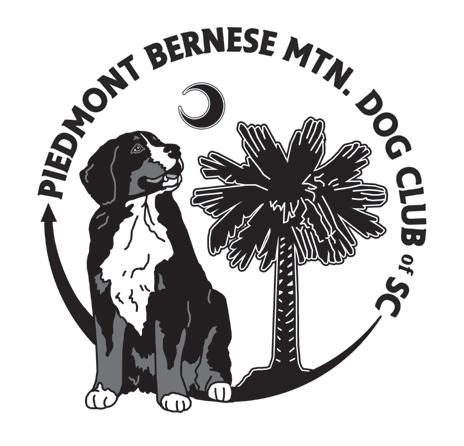
PIEDMONT CLUB ACHIEVES AKC LICENSED STATUS
BY CAROL LYNN FOX AND DAWN HITCHCOCK

HISTORY
The first general meeting of the Piedmont Bernese Mountain Dog Club of South Carolina was held in February 2013 at the home of Dawn Hitchcock in Simpsonville, SC. It was organized by a group of fanciers in upstate South Carolina, recognizing a need for more localized education and fellowship of BMD owners. Those in attendance were Dawn Hitchcock, Stephen Crisp, Jenny and Jim Durrance, Pam and Phil Steude, Dan and Georgia Shively, Venus Slater, Dawn Paine, Amy and Dean Burwell and K.T. Ryan. Dean Burwell shared his technical skills to create our web site and drafted the original by laws.
Jenny Durrance was appointed as president and was instrumental in steering the club as it was formed. Dan Shively was VP and newsletter editor, Dawn Hitchcock, secretary and Stephen Crisp, treasurer. Directors Amy Burwell, Dawn Paine and Venus Slater served to round out the initial board. Also notable, at this first meeting new members would be by invitation only to manage the geographical area of voting members, keeping in mind the goal of attaining AKC licensing and the importance of membership attendance, managing club business and achieving a quorum during voting. The club is no longer by invitation only and we encourage those outside the radius to apply as associate members.
In 2014 an application was made for AKC licensing. With much work still to be done by the members,
the application was accepted and we were assigned a territory with Greenville, SC, at the center. The submitted name, Old South Bernese Mountain Dog Club, was declined. After several attempts at a name for the club, AKC approved Piedmont Bernese Mountain Dog Club of South Carolina. It was also around this time that we decided on a logo.
Our logo mimics the South Carolina flag and features the crescent shape, beloved state palmetto tree and a Berner. (The blue represented the revolutionary war soldiers’ coats and the crescent represented their hats, which signaled to the city of Charleston that the British were coming.)
Our inaugural events included a fun match and walks in beautiful Falls Park in downtown Greenville, SC. The first supported entry was held in July of 2016 in conjunction with the Foothills Cluster in Greenville, SC, under the auspices of the BMDCA with a total entry of 17. The first designated specialty was in July of 2017 held under the auspices of the BMDCA with a total of 23 exhibited. Also that year, we held a draft test in Anderson, SC, chaired by Jenny Durrance.
Another first in 2017 — the club participated in the Poinsettia Christmas parade in downtown Greenville, SC. It’s a nighttime event with bands and floats lit up with lights and around 4,000 spectators. We all felt like we were in the Macy’s Thanksgiving Day parade. Following the parade, a general meeting and party at the home of K.T. Ryan became a tradition.
90 ∙ THE ALPENHORN
BMDCA Regional Club Spotlight
Left to right - Amy Burwell and Claire (BG# 130117), Heidi Giezey and Ali (BG# 108835), Dawn Hitchcock and Boozer (BG# 78259), Dawn Paine and JJ (BG# 144186), Priscilla Sykes and Anya (BG# 74448). Photo by Dan Shively.
This year, 2024, we will be hosting our first specialties as an AKC licensed club the last weekend of July.

It was so much fun that we did this for several years until changes in the starting point of the parade and parking made the logistics of getting dogs and equipment to the parade unfeasible. The annual Christmas party and general meeting continue each year.
The educational day held at the Piedmont Kennel Club’s grounds in Charlotte, North Carolina, began in 2018. Since then, we have an annual educational day in conjunction with the Carolina Working Dog Association.
ACHIEVING AKC LICENSE STATUS
The initial motivation to become an AKC licensed club was so we could host regional conformation specialties as none were being held in the southeast. We also had a future goal of hosting AKC performance and companion events to engage a wider Bernese community.
Part of our licensing challenge was that we were trying to complete our application during the COVID-19 pandemic. This, along with changes AKC made to new club by-law requirements during our application submission process, added to the lengthy approval process for us. Each revision required a rewrite, a vote with a quorum at the next general meeting, resubmitting and waiting for AKC approval.
Holding the B and A matches, required by AKC for licensing, was a bit challenging. The B match was quite simple but the A match, which is held and organized like a regular dog show with pre-entries and a catalog, took more effort. Fortunately, even with only two entries it was approved. The last hurdle was to get our bylaws approved as several revisions were requested by AKC which also required a vote by the general membership prior to those submissions. Ultimately, on September 18, 2023, we received the email from AKC granting us license status and we were OFFICIAL!
MOVING FORWARD
This year, we will be hosting our first specialties as an AKC licensed club the last weekend of July. Two will be designated specialties (where the regular breed judging at an all-breed or group show is the specialty show) and two will be concurrent (an independent specialty on the same date and at the same site as an all-breed or group show).
Currently, PBMDC of SC hosts traditional events including specialties, draft tests and general meetings. With our vision of growing the club and engaging a larger Berner community, our social committee has developed the annual Holiday Walk, Bark & Brew Gatherings and Barktoberfest Campout Weekend.
Christie Sells, Erin Stephens and Dana Gorman have been involved in community engagement. Just as we learn and grow as a club, we continue to add more fun activities combined with education for owners and their dogs while we become an integral part of the Berner community in the Carolinas.
The current board, instrumental in obtaining our AKC license, includes officers Carol Lynn Fox (president), Dawn Hitchcock (vice president), Amy Burwell (secretary), K.T. Ryan (treasurer). Our directors are Dawn Payne, Cleve Owens and Wende Cox. Our club territory includes the greater Greenville, South Carolina area south to Anderson, South Carolina, as well as southwestern North Carolina including Charlotte, Hendersonville and Cashiers, North Carolina.
We are thankful for so much support from the BMDCA, AKC, our board, members and patrons, past and present as we continue to give back and share the passion for our breed.
SPRING 2024 ∙ 91
Doreen McCune and Brie (BG# 110498). Photo by Dan Shively.
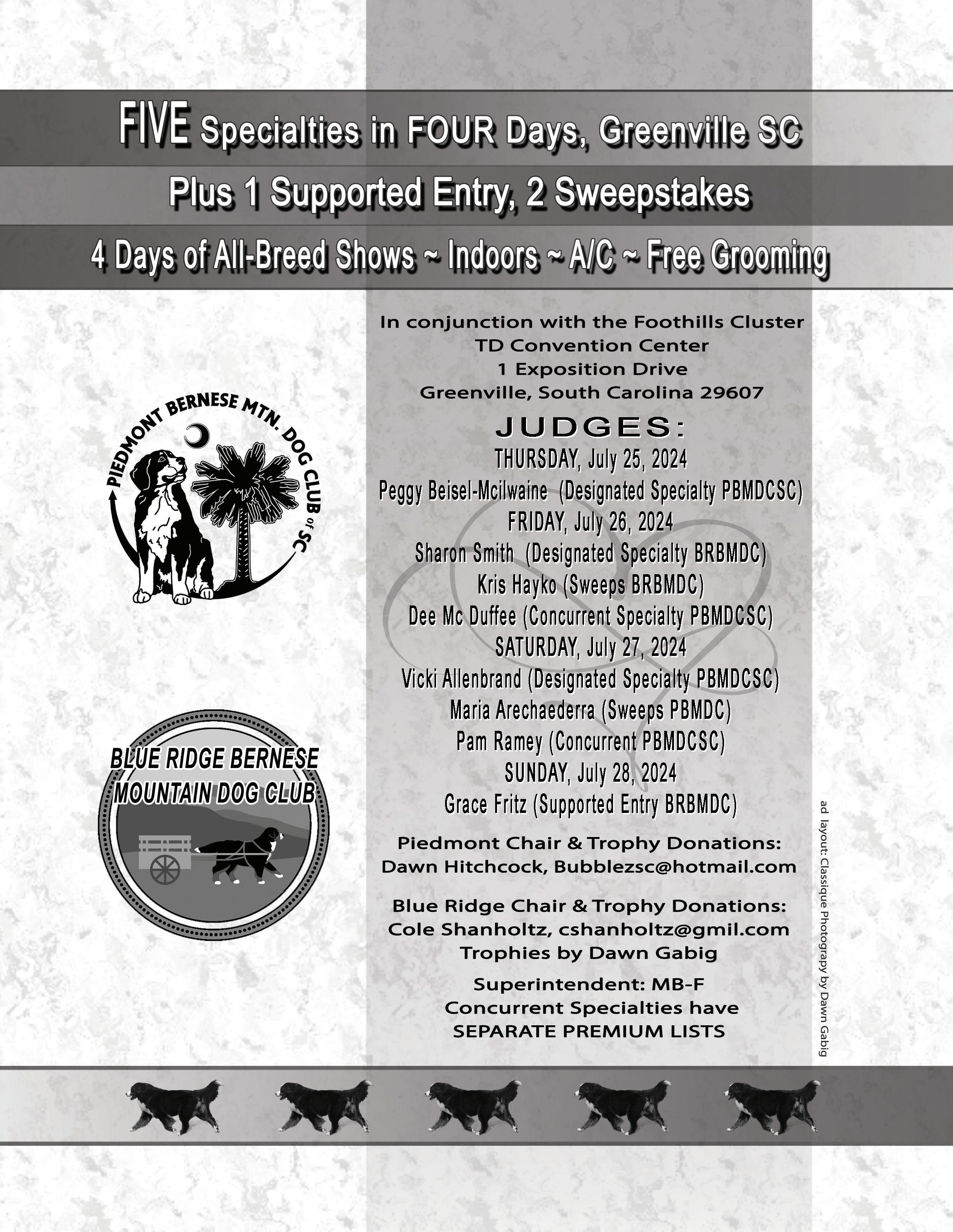
Malignant Hyperthermia HEALTH BEAT
RETROBULBAR ABSCESS
BY TOBY ERLICHMAN, V.M.D.
The anatomy of the dog’s eye orbit differs from ours in that there is a bony floor, but the rest is comprised of connective tissue, an adaptation that allows dogs to open their jaws wide to consume prey. This leaves the orbit very vulnerable to foreign objects such as grass awns (or bristle), sticks, porcupine quills and other pieces of wood that may enter through the roof of the mouth or the conjunctiva and lodge in the orbit. Foreign matter in the orbit of the eye can then lead to an abscess or infection, which may be bacterial or fungal. Younger dogs are generally more affected than older ones due to their propensity to chew sticks.
Signs associated with retrobulbar abscesses may vary and may include any of the following.
• Pain on opening of the mouth which can be quite severe.
• Foul breath
• One-sided nasal discharge
• Fever
• Exophthalmos (protrusion of the eye)
• Enophthalmos (sinking in of the eye)
• Decreased movement of the eye
• Strabismus (misalignment of the eye)
• Reddened eye
• Protrusion of the third eyelid
• Squinting
• Blindness
Foreign matter in the orbit of the eye can then lead to an abscess or infection, which may be bacterial or fungal.
Diagnosis is made by careful examination of the mouth that likely will require sedation or possibly general anesthesia. X-rays and ultrasound may be required to visualize the orbit and the space behind the eye.
Treatment may involve draining the pus that is likely present in the abscess. This is done under general anesthesia with an endotracheal tube in place. An incision is made in the roof of the mouth behind the last molar, a culture may be taken to help determine appropriate treatment and the orbit is carefully flushed to remove the pus and any foreign material present. The area is left open to continue draining. Softened food should be fed for a week or two and treatment will likely last two to four weeks. Sometimes the abscess will resolve with antibiotics and pain management alone.
ANCHOR’S EXPERIENCE WITH RETROBULBAR ABSCESS
BY BARB GIBSON
Anchor and I went through a few very distressing weeks recently. He was in pain and wouldn’t eat. This was a new one to me and I struggled to get answers.
He was 18 months old at the time and in good health. One night he yelped when I gave him his bed-time cookie. The next morning, he yelped when he started to eat his breakfast. It was clear that it hurt to
open his mouth. One eye appeared slightly red, but otherwise there appeared to be nothing wrong.
My local vet examined him and listed the possibilities, most probably a retrobulbar abscess. He had seen five to six cases in recent weeks. He prescribed antibiotics and pain pills. He assured me that the condition usually resolved over a few days with that treatment.
SPRING 2024 ∙ 93
Well, it did not resolve. I couldn’t get the pills into Anchor. Over the years, I’ve used many methods to get dogs to take pills, but this was different. It hurt him to open his mouth. I just wasn’t willing, or able, to force his mouth open and cause pain twice a day. Our problems were compounded by it being summer in Boothbay Harbor and the local veterinary hospital was short staffed. Communication with my vet was difficult to impossible.
Over the next two weeks we went to assorted emergency clinics, where they took five to six hours (again, summer in Maine) to render the same diagnosis and treatment. They just ignored the fact that I couldn’t get pills into him. We finally were able to get the X-rays done to confirm the diagnosis, but that didn’t change their treatment plan. They all mentioned that they have had many similar cases this summer and we even found other dogs in the waiting room with a similar problem.
During this two-week period, Anchor hadn’t been able to eat anything and drank little water. Again, I’ve had quite a bit of experience finding or preparing something that sick dogs will eat. He became quite lethargic.
Finally, I was able to speak to my local vet, who understood my problem and had the local pharmacy compound the medications into a liquid. Anchor’s cheeks were plenty big enough to hold the doses without them spilling all over the floor and he didn’t resist. My vet then sent me to a surgeon who was able to drain the abscess. We continued the antibiotics for six weeks, as directed.
After eight weeks, Anchor was almost back to normal, but he’s had a prolonged period of aversive behavior related to the pain. It was quite a while before he would take treats from my hand or eat kibble out of a bowl. He still won’t go into his crate, where the first painful treat was given, although maybe I haven’t tried hard enough!
I learned a lot of lessons from this experience. But I think the most important has been to know medications can be given in liquid form if they can’t be administered any other way. I am also curious about this problem. It seems very common in the summer in Maine now. I’ve heard it is rare in other areas. I’d like to know if anyone has heard about a lot of cases in their area. If so, please reach out me Bgibson1248@gmail.com.
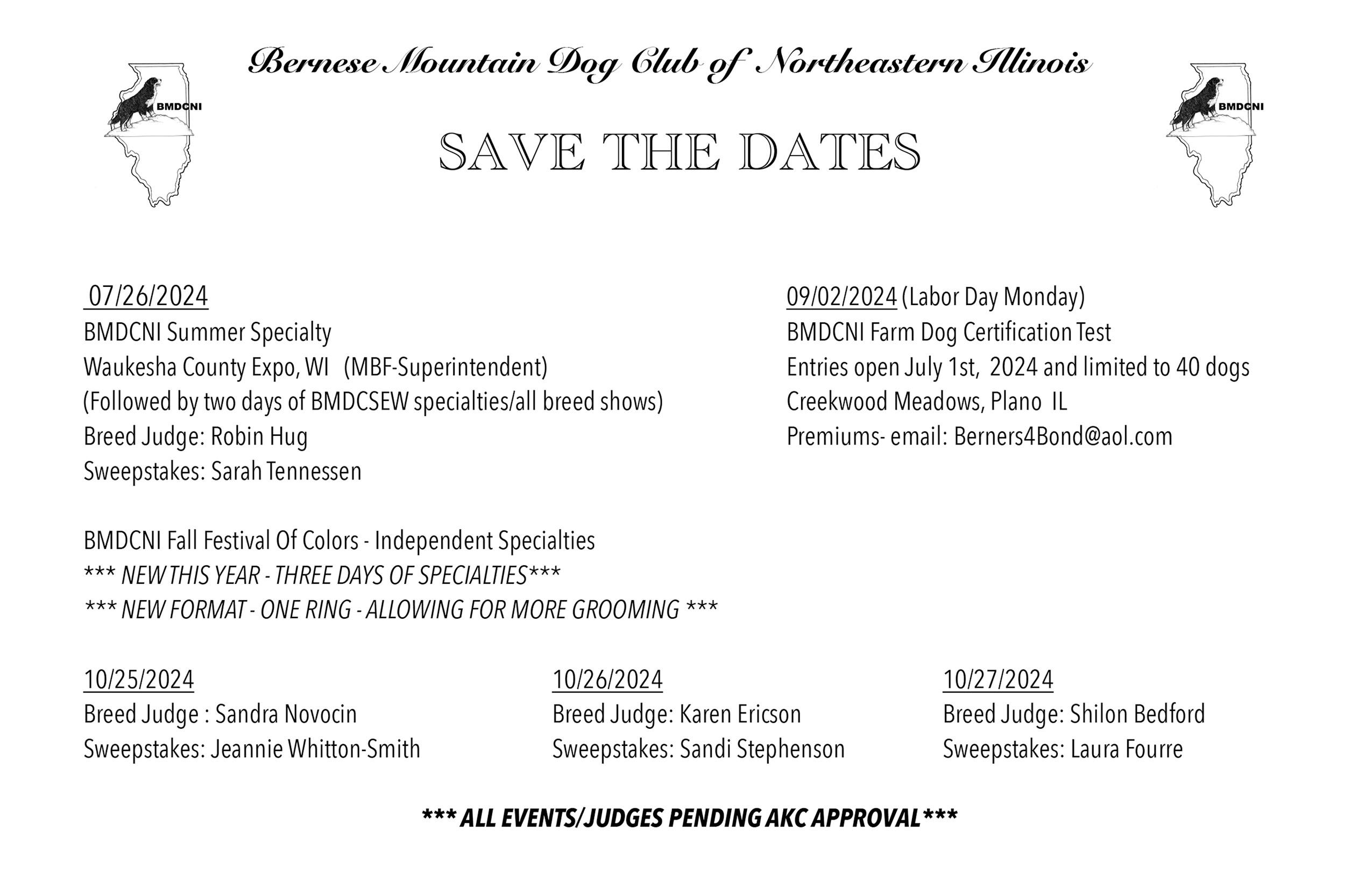
PLEASE WRITE: A NOVEL IN LETTERS
J. Wynn Rousuck
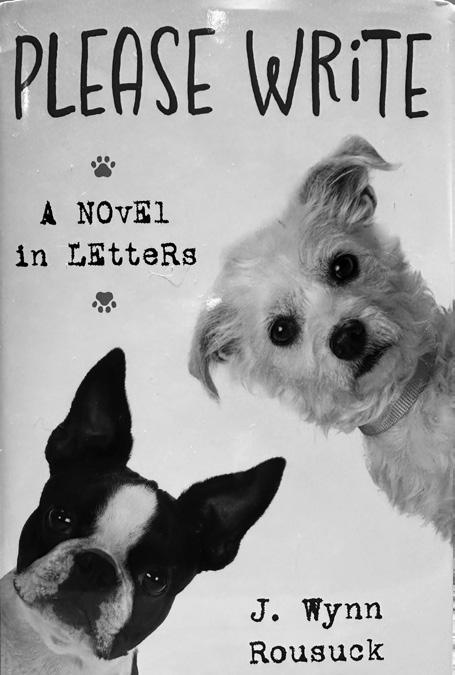

Though it is not a book about a perfect puppy, J. Wynn Rousuck’s “Please Write: A Novel in Letters,” is a perfect puppy book! It is also an ideal choice for The Alpenhorn spring activities/training/ puppies theme.
“Please Write” is about Winslow, a pure-bred Boston Terrier and Zippy, a “whimpering, shivery, muddy mixedbreed puppy.” Zippy is brought home late one cold, rainy evening just after Halloween by Frank. Before the arrival of Zippy, Winslow happily shared his life with Frank, a landscape architect and Pamela, a Baltimore newspaper theater critic.
Winslow, who can read and write, corresponds with Grandma Vivienne, who lives in Cleveland Heights where Pamela grew up. “Please Write: A Novel in Letters” as its name implies, is an epistolary novel, told in letters exchanged each month over the period of three years. Readers, suspend belief here!
Through Winslow’s very amusing perspective, readers learn, or are reminded of what we all know, about bringing a new puppy home; it is a lot of work and can be at times pure chaos! Puppy Zippy, likely part West Highland Terrier and part Jack Russell, is true to her name and genetics. She is very active and impulsive. She has unbridled enthusiasm for everything, especially stalking Winslow, stealing his treats and destroying his favorite toys.
Shortly after Zippy arrives, Winslow complains to Grandma that he and Pamela had been perfectly content with a one-dog household. Grandma
SPRING 2024 ∙ 95 Please Write cover.
“Please Write” is more than a cautionary tale for those looking to bring a puppy into their lives or are new to the dog world. It is a delightful read for experienced dog families as well.
Vivienne knows a lot about all things dog because Pamela’s father was a dog judge. She is a voice of calm and reason. Grandma writes back to Winslow, and sends reassuring letters to puppy Zippy that, at first, Winslow must read to her because she has not learned her letters. Hearing from Winslow about Zippy’s crazy antics on her first days with the family, Grandma Vivienne advises anxious puppy Zippy that she doesn’t have to worry, everyone in the family will come to love her if she follows a few simple house behavior rules. She will tell Pamela to take Zippy to puppy kindergarten.
As she always did for Winslow, Grandma usually writes to explain holidays to Zippy and sends lots of holiday toys and home-baked treats made from recipes created by Pamela’s mother. In several letters to Zippy, Grandma Vivienne refers to herself as Pamela’s former nanny and tells Zippy she now helps take care of Pamela’s recently widowed mother who is a retired artist and volunteers at Pamela’s old school. Grandma provides illustrations and descriptions of dog projects telling the dogs she will suggest that Pamela engage in them too. Grandma Vivienne tells Zippy that she is Pamela’s best friend.
“Please Write” is, at the same time, whimsical and serious. Winslow’s end of letter salutations throughout the book are witty. When he tries to teach Zippy to learn to read and use the typewriter, rather a daunting task, he signs off, “Yours, the pedagogically exasperated.” After Thanksgiving dinner at Pamela’s home, which Grandma Vivienne does not attend, Winslow confides to her that something in the house is amiss. Frank went out after dinner and didn’t come home until the next morning and when he did, “he smelled like the rum cake Uncle Ed baked for us last New Year’s. (I remember that cake because I nibbled some crumbs
off the floor. Unpalatable.)” When Winslow describes the post-Thanksgiving tension in the household, readers will not know whether to laugh or cry.
Zippy enjoys her first winter and holiday season, plus or minus some very scary things like fireworks on New Year’s Eve and getting bathed after romping in a snow/mud mix. As Zippy learns to read and understand what she reads, we can see her naïveté and her excitement about everything new in her letters to Grandma. She explains to Grandma some of the challenges she faces, among them socializing at puppy kindergarten, and some “bad dog” things she does (too many to list, but readers will recognize the actions and commiserate with those affected by them as they read.)
Grandma Vivienne’s kind replies are based on “positive training!” She tells Zippy she needs “someone to help you channel your energies toward good instead of towards mischief.” With proper instruction, and a series of trial-and-error behavioral accidents (again too many to catalog) Zippy does well and readers watch her develop not only general social and obedience skills, but also the talents of being a good traveler and house guest, as well as the competence that enables a dog to do therapy work. She also learns to read cursive writing!
Throughout “Please Write,” many events, some happy and others not, occur in Winslow and Zippy’s life. Grandma Vivienne’s kindness and expertise always help the dogs cope with each new experience in their personal lives. Grandma is there to address their developing domestic concerns and enlighten them about global issues they encounter when they read the newspaper. Most enjoyable are Grandma Vivienne’s explanations of the events of the early 1990s that the dogs witness, but do not
96 ∙ THE ALPENHORN
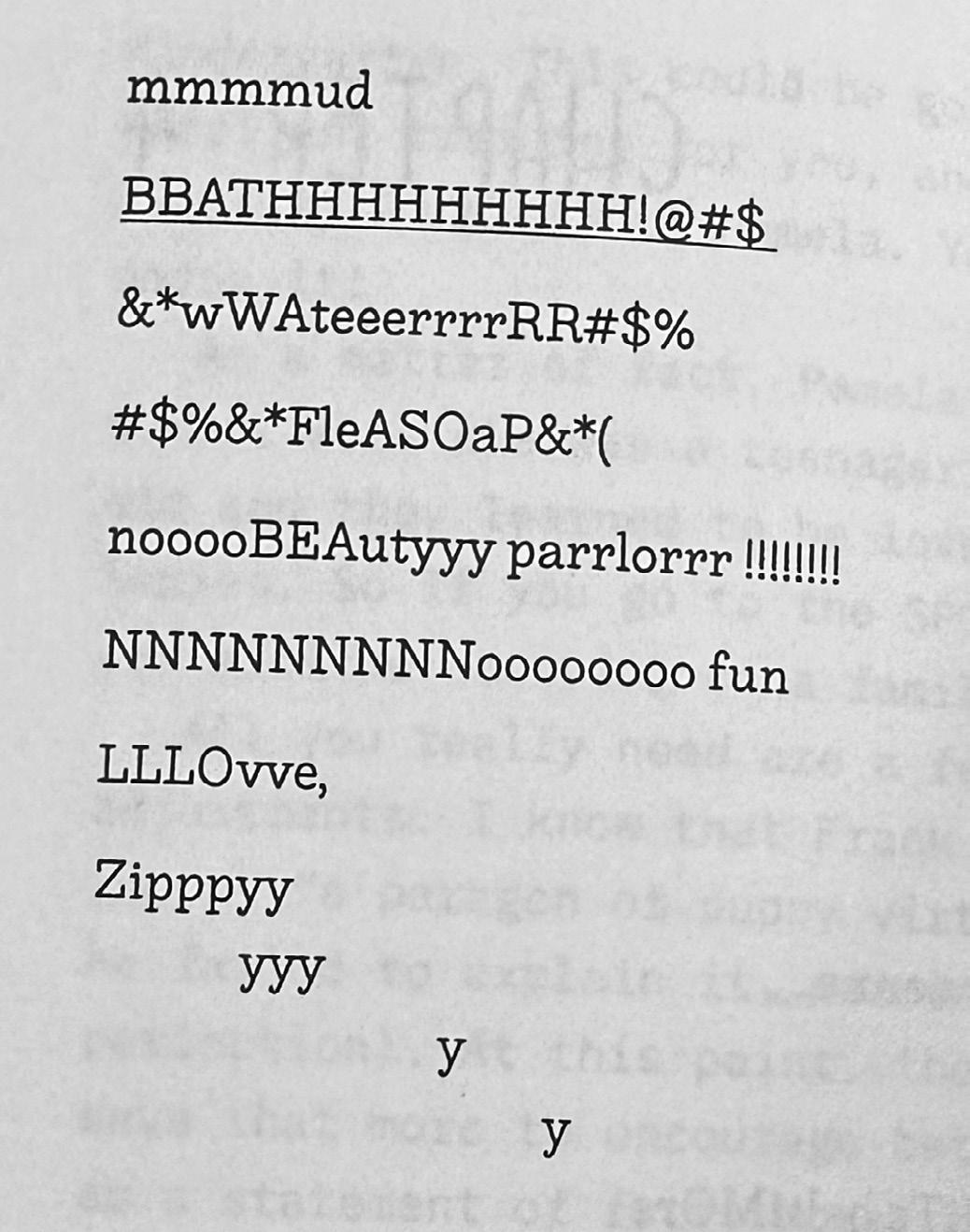
always understand. Author Rousuck chose to set her book in the 1990s before emailing and texting became the most popular communication tools.
“Please Write” is more than a cautionary tale for those looking to bring a puppy into their lives or are new to the dog world. It is a delightful read for experienced dog families as well. As she grows up, Grandma Vivienne teaches Zippy a lot about her world and the very complicated human one. Readers learn along with her.
Because Grandma Vivienne is explaining things to a pup, “Please Write” is a wonderful side-by-side read-aloud for a young person and adult. Zippy learns about showing dogs, agility training and other dog jobs. Grandma instructs Zippy about historical dogs who lived in the White House and provides some civics and politics lessons, too. Zippy is told about dog entertainers, foreign animal customs regulations, food items that are not healthy for dogs to consume and a whole lot more. Zippy’s reactions to what she is taught would certainly initiate some healthy family conversations!
Though small in its number of pages, “Please Write” is a comprehensive book that covers a lot of what dog lovers know and love about our best friends.
It is an introduction to the many activities one can experience with a dog. “Please Write” has many features that include adorable illustrations and simple poems Grandma writes on her birthday and holiday cards. As “Please Write” is as much about the written word as it is about dog culture, it also contains a bibliography of dog related books, films and dog training links. A dog cookbook plays a prominent role in the plot, so author Rousack also includes recipes for all kinds of dog treats. There are even recipes that dogs and their humans can share.
“Please Write” is autobiographical in nature. Author Rousuck, like Pamela is a journalist/ theater critic for the Baltimore Sun. She has shared her life with many dogs, who inspired this novel, and her father, like Pamela’s, was a dog show judge.
The final pages of “Please Write” reveal a secret that is somewhat foreshadowed in Grandma Vivienne’s correspondence. Zippy’s final letters unveil this secret. After having perused those, readers will know the power of the dog-human connection and understand Rousuck’s motivation for writing this funny, beautiful and thought-provoking tale.
About the reviewer: Lori Friedli is a librarian, a citizen of the United States and the Canton of Bern, Switzerland. She loves all of the four-footed. Members of her advisory team, who sit on Mommy’s feet while she reads her books, are Book Berners Älpi and Lumi, who, Mommy says, have extraordinarily good taste in all genres of dog literature.
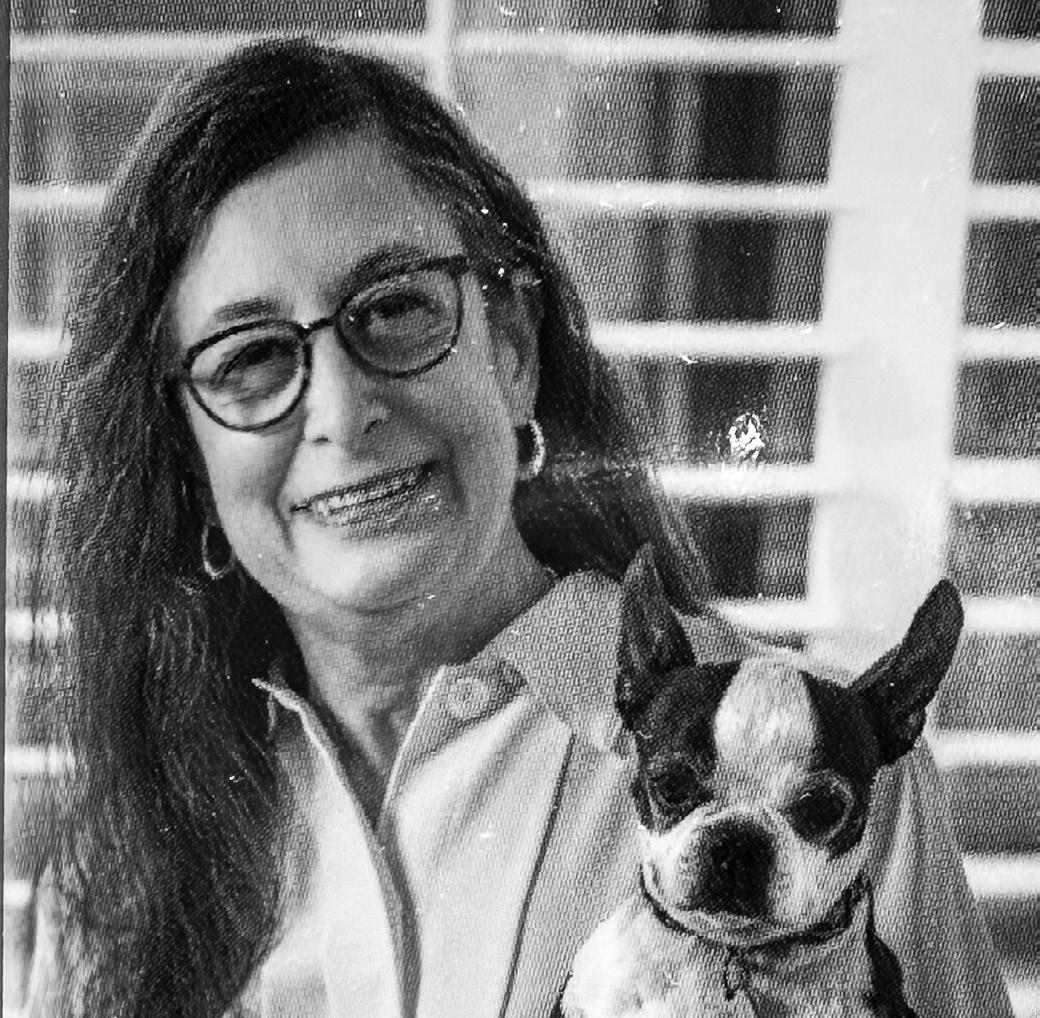
SPRING 2024 ∙ 97
Author photo by Jerry Jackson.
Zippy writing.
FROM THE Archives
The following article appeared in the 2007 February Activities issue of The Alpenhorn.
Reflections on Our Working Past
BY APRIL RIFENBURG
This review of our breed's working history is April's final contribution as BMDCA Obedience Chair. April dedicated 19 years to her job, and I'd suspect that she is not finished contributing to the advancement of the Berner 's working ability. One of the forums that April contributed to activity issues of this magazine is included in this issue.
The job of Obedience Chair was a great way for me to serve the BMDCA. I was appointed to the position starting in June 1987. The preceding chair, Chris Milar, had been elected president. I have enjoyed serving the club in this capacity for 19 years. As I reflect on the past, I am truly amazed with the growth of this beautiful breed and seeing our Bernese participating in a wide variety of working activities.
My first Bernese, Heidi, and I did well in the obedience ring, and she excelled at tracking. She earned her UD in 1985 and TD in 1986. My second Berner, Turbo, and my Labrador both finished CDs and TDs, and were training for CDX and TDX. Berner-Garde was in its infancy. I remember many years of working with the Packards and entering data "for the love of a Berner."
In the early 1980s, AKC working titles consisted of obedience and tracking. Very few Bernese entered advanced obedience trials or tracking tests. Conformation was the rule. Mary Alice Eschweiler and Dina earned the first Bernese UD in 1979. Phyllis Collier and Calypso were the second UD team in 1983. The first TDX dog was Carolyn Gramlich's Bischof in 1985. Cherie Bond and Tabitha earned the second TDX in 1988. By 1993, only two more dogs had earned the TDX.
Heidi was required to jump 34 inches to earn her CDX plus two Utility legs. Watching large dogs jumping and landing at obedience trials brought me to the realization that jumping at that height had to be harmful. We could not get the third Utility leg because she just would not jump the bar jumping the ring, so in 1984 when Heidi was 6-I /2 years old, I decided to wait with the faint hope that AKC would lower the jumps for Bernese.
Much of the general obedience community as well as several breed clubs were concerned about
Much of the general obedience community as well as several breed clubs were concerned about how the repetitions of jumping affected their dog's forelimbs and joints.
98 ∙ THE ALPENHORN
The BMDCA Versatility Dog Award
was introduced in 1996, and the Working Dog and Working
Dog
Excellent Awards appeared in 1999 to honor our working Bernese and encourage owners to earn titles.
how the repetitions of jumping affected their dog's forelimbs and joints. AKC was aware of the discontent. In those days, AKC was extremely rigid about change. Marge Reho, who was serving as Obedience Chair at that time, launched a strategy to lower the jump heights for Berners. She had researched how other successful clubs approached AKC, gathered scientific data from several studies regarding bone density, weight, and force of landing on the canine front assembly, and made a video of sound Berners jumping/landing. The overwhelming facts of her presentation helped convince AKC that the risk of injury was real. In July 1985, the jumps were officially lowered from 1-1/2 times the dog's height at the shoulder (withers) to shoulder height for Berners. Subsequently, Heidi finished her UD with two more legs at 7-1 /2, becoming the third Bernese UD.
During this time, training techniques changed dramatically for the better. In the late 70s and early 80s, it was considered totally wrong to use any kind of food treat for reward! Gradually, as interest in dog training grew, the use of food became more acceptable. Dogs were easier to train, and training
became much more fun. By the late 80s, treats and toys were mainstream. The clicker was born into the dog world. Handlers were developing their own ideas for training techniques. More experts evolved as skills improved. In the early 90s, "positive" training was being embraced not only by obedience competitors but also in pet training classes.
In 1986, Turbo and I explored agility and herding. No titles, of course, back then. But in the 1990s, the working dog community came to life. More people were entering their Berners in obedience trials. Carting was attracting a large following. I became very involved in herding and found my dogs had instinct for moving livestock in cooperation with me. Sierra West BMDC sponsored the first sanctioned AHBA Instinct test for Bemers in 1991 and has been doing so annually since then. Many Berners have been successful in the herding tests. The Colorado club [BMDC of the Rockies] offered the first Herding Instinct test at the BMDCA National Specialty in 1992. Marjorie Cherry and Dunbar earned the first JHD (Junior Herding Dog) in 1997, and Tom Giusti and Duke earned the first HTD (Herding Trial Dog) in 2001 through the American Herding Breed Association.
The draft test proposal developed by the Nashoba Valley club became an official BMDCA Draft title in 1991 with the first official test in Massachusetts. AKC introduced the CGC in 1989 to recognize dogs with good manners. The first CGC test at a national specialty was held in Pennsylvania in 1999. Therapy work expanded and grew with the support of such official registries as TDI (Therapy Dogs International) and Delta Pet Partners.
Agility blossomed, becoming an AKC title in 1994. The first Agility trial at a national specialty was held in Atlanta, Georgia, in 1995. There were nine entries. Freestyle was introduced into the United States as a demonstration sport in 1993. There was not a dry eye in the crowd when Alison Jaskiewicz with Jay Jay and Kris and Clark Osojnicki with Haley and Chalet performed Freestyle routines during the national specialty in 1995. Enthralled spectators demanded a repeat performance the next day. With all the interest and enthusiasm in these new working activities, the BMDCA added a Draft Chair, an Agility Chair, and in 1999 a Herding Chair.
The BMDCA Versatility Dog Award was introduced in 1996, and the Working Dog and Working
SPRING 2024 ∙ 99
Working and performance activities to use these instincts and capa bilities enhance the dogs' physical and mental health.
Dog Excellent Awards appeared in 1999 to honor our working Bernese and encourage owners to earn titles. The AKC developed the VCD (Versatile Companion Dog) award to encourage people to work in the performance fields of obedience, tracking, and agility.
Heidi retired the BMDCA HIT Obedience Challenge Trophy by winning it a third time at the national specialty 1986. It seemed fitting that 10 years later, at the 1996 specialty in San Mateo, I donate the trophy back to the club in Heidi's memory to again be awarded for HIT at national specialties.
An opportunity occurred in 1997 for the BMDCA to approach AKC in regard to lowering the obedience jump height requirements to threefourths of the dog's height at the shoulder. A study of mili tary working dogs jumping cited degenerative changes and injury related to force of landing and weight in relation to jump heights. A letter stating our reasoning and safety concerns was sent to The AKC. The AKC agreed, and in 1998 the new jump height of three-fourths shoulder height for Berners became official.
Our first UDX [Utility Dog Excellent] Bemer teams were Kathy Galotti and Eskie, closely followed by Vilma Kistner Briggs and Java in 1998. In 2002, Trisha Koetter and Stormy further made breed history with the first OTCH [Obedience Trial Champion] title. She also had earned a UDX. Ripple with owner Faye Benson became the first Bernese Champion Tracker (CT) in 2004 when he earned the TDX. He had earned the VST (Variable Surface Tracking) title earlier, the first Berner to achieve that title. Katie Tolve
and Kintla became the first Bernese MACH (Master Agility Champion) team in 2005.
The AKC developed the National Obedience Invitational and the National Agility Championship to showcase the very best working dogs in addition to the National Championships featuring the best conformation dogs.
As a bridge between the CGC test and obedience trials, AKC developed Rally Obedience. Rally became a title in January 2005, encouraging new people into training their dogs, earning titles, and exploring other areas of the performance dog world. Berners have worked in search and rescue, Schutz Hund, backpacking, and skijoring, and as service dogs.
I have enjoyed many activities with my dogs over the years, from tracking and obedience to draft, herding, and agility to conformation to therapy and working demonstrations at clubs and schools. It has all required teamwork. From that experience, I have wanted to help owners to discover the working talents inherent in our versatile Berners. This is a working breed, originally a farm dog, expected to watch out for intruders as well as help the farmer with his tasks. Working and performance activities to use these instincts and capabilities enhance the dogs' physical and mental health. Such activities involving teamwork further strengthen the bond and partnership be tween dog and owner. This partnership is what having a canine companion is all about.
100 ∙ THE ALPENHORN

SPECIALTIES
May 17, 18, & 19: Potomac Valley Bernese Mountain Dog Club designated specialties 1, 2 and 3 at the Howard County Fairgrounds, 2210 Fairgrounds Road, West Friendship, MD. Sweeps Judges: 5/17 Ms. Catherine Donohue, 5/18 Mr. William Hamilton. Conformation Judges: 5/17 Ms. Catherine Burlile, 5/18 Ms. Dee McDuffee, 5/19 Ms. Patricia Trotter. Show secretary: Rau Dog Shows. Contact: Georgeann Reeve, geebryteh20@gmail.com.
SUPPORTED ENTRIES
May 16, 2024: Potomac Valley Bernese Mountain Dog Club in conjunction with the Kennel Club of Anne Arundel, at the Howard County Fairgrounds, 2210 Fairgrounds Road, West Friendship, MD. Judge: Mr. Andrew Ritter. Show Secretary Rau Dog Shows.
BMDCA DRAFT TESTS
May 31, June 1 & 2, 2024: BMDC of Oregon draft tests at Willamette Mission State Park near Salem, OR. Judges: 5/31 Karen Peterson and Jim Maxwell, 6/1 Ruth Nielsen and Karyn Beyer, 6/2 Karyn Beyer and Jim Maxwell. Check bmdco.org for further information.
OTHER EVENTS
June 2, 2024: Mason Dixon BMDC is offering an all-breed health clinic in Exton, PA from 9-2:30. OFA/CERF eye exams, cardio auscultation and echocardiograms can be scheduled via pre-paid appointments. Contact: Babs Winicur, 610-2123189, babswinicur@verizon.net.
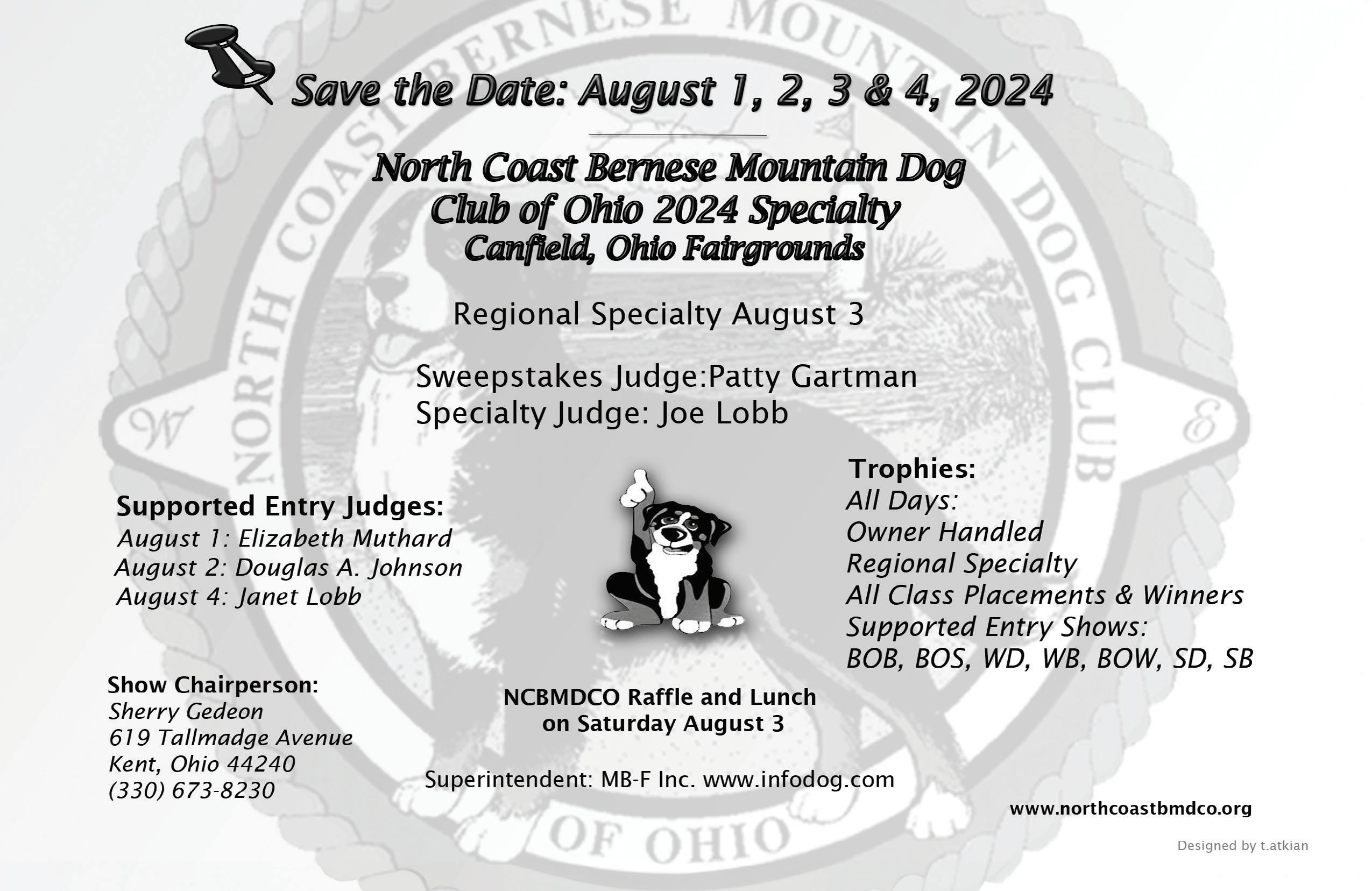
BMDCA EVENTS CALENDAR
BMDCA NEW TITLES

COMPILED BY NICOLE STONITSCH
OCTOBER 1, 2023 – DECEMBER 31, 2023
BMDCA TITLES
ACTIVE DOG
BERN HAUS ON OKA UINSLOU GLORY RE CD BN TKI FDC
NDD Carolyn Smith
OLEKA'S ZOOM FLYING HIGH AT HARTWOOD TKI FDC
NAP OJP NFP BN THDN Julia & Wayne Airgood
HIGHLANDS RACING TO THE LAST DROP AT VERITAS RI BCAT NDD Lynne Farrell Washburn & Buffy CramerHammann
GCH HIGHLANDS FRANKLY I DON'T GIVE A DAMM RN
BDD BCAT Lynne Farrell Washburn & Jessica Anichini
CH VERITAS MAMMA'S EXCUSE TO DRINK BN RA CD TD
ANDD BDD FDC Buffy Cramer-Hammann
CH NASHEM'S LONE SENTINEL AT SUN MOUNTAIN FDC
RN PT NDD Michael & Julia Smith & Sara Karl
GCH MOUNTAINAIRS X-TREME PRIESTESS OF THE GOLDEN FLAME TKA RI FDC NDD Lisa & Duke Monk & Darcy Babb
KAIBAB'S MARGIE MOONSHADOW HOLDEN MY HEART
TKN FDC BCAT RN Toby Erlichman & Mary-Ann Sontag
WILDRIDGE IRRESISTIBLE ADVENTURER TKN FDC RN NDD Laura Waldbaum
OLEKA'S ZINGY BEAUTIFUL VIOLET CD RI FDC TKA FITG BCAT Jessica Moore
SOBREEZE QUEEN'S ROYAL FAVOUR FDC TKN RI BCAT Bonnie Obert
ALGRAND BERNI BOND JAMES BOND RE BN CD FDC NDD Marjorie Geiger, Geoff Huber & Madeline Knowles
HIP-HOP FLYING ANGEL CD BN RA FDC NDD Cherie Bond
WYNDRIFT'S ST. MORITZ POWDER BLITZ BN RN BCAT NDD Elisabet Ellis & Tracey & Chan Keith
BUGZIERE'S SECRET AGENT MAN BN RI FDC NDD Paige Hess & Sue Wellenstein
VERSATILITY
GCHB WINDFALL ADESA 3 WIRE WINTER @ EMERALD
MTN RN FDC CD NDD BETH DENNEY, WILL ROGERS, KRIS
HAYKO & BOBBI KINLEY-BLEWETT
GCH BRAELYNN’S AUGUST SUMMER RISING STAR; BN, CD, RN, FDC, SWN, SCA, SIA, DS, CGC, TKI, BDD HEATHER BERG & DEBORAH LEPOFF
GCH BRIGHTEYE LONE STAR CD RN AXP AJP NFP NDD
WENDY BOEHME & DENISE MCCLURE
CH BACKCOUNTRY ZAMBONI TKN RN BNDD CD LORI
KENNEDY, WENDY BENNETT & JENNIFER JULIAN
CH LICORICE FERN'S BACK IN THE SADDLE TKN TD NDD
SUZANNE M LUSK
CH LAVENDER HILLS TICKET TO TANGIER RI CD NDD
ALICE CLARK & SUSAN PARR
GCHB WINTERGREEN'S EVERY SAILOR'S DREAM BDD
ANDD BN SUSAN VAN OCKER
CH NASHEM'S LONE SENTINEL AT SUN MOUNTAIN FDC
RN PT NDD MICHAEL & JULIA SMITH & SARA KARL
GCH WYNDRIFT'S CHAMPAGNE POWDER DREAMZ TKI
BN RN CD ANDD MDD BNDD CHAN & TRACEY KEITH
GCHG TANZANITE'S INCOMMUNICADO FDC JHDS PT
NDD SHARON MONTVILLE
CH STOCKLI'S JUST SAYIN' NAP NJP NDD VALERIE
HORNEY & LISA IBELSHAUSER
GCHS SUMMERS' ANASTASIA TREASURED GODIVA CD
NDD ADDY CUI & ANNE SUMMERS
GCH TANZANITE'S DEVON AIN'T MISS B-HAVEN TKA FDC
JHDS NDD BRIDGIT PIEFFER & SHARON MONTVILLE
CH SEVENS FOREVER IN A FRENZY TKI RN BN CD NDD
STACY SLADE & KAREN HODGSON
CH SANDPIPER'S MILLION WAYS TO THE WEST TKN FDC
NAP NDD KATHY GRAY
CH PRAIRIEFIRE'S CALL MY AGENT CD NDD WENDY
BOEHME & SHARON JOHNSON
CH MOUNTAINAIR'S ZIPPIN' DOWN THE RED ROAD WITH DAD CD NDD PATTI DAVIEAU & DARCY BABB
CH OLEKA'S SUN SHINES ON DAISY AT BORNEDALE FDC
NFP NAP NDD Kara MacWilliams
VERSATILITY EXCELLENT
GCH OCTOBER'S BEYOND THE STARS BN TKI FDC
RE CDX ANDD MDD BDD Kevin Gasper & Mary Alice
Eschweiler
GCH MAMEMO'S MOET HT RA CD AJP OAP NFP BDD
Lamartine M Simons
GCH LICORICE FERN'S SOLSTICE BOOGIE TKI TDX CD
DD Suzanne Lusk
GCH WAGONTALE'S YOU BETTER SHAPE UP TKA HT PT
RN FDC OJP ANDD ABNDD MBDD Renee Meriaux, Kelley
Van Arsdale & Stacy Temples
GCH RACH LAVENDER HILLS HEY BIG SPENDER CDX BN
RM4 RAE2 FDC SWN TKA ANDD DD Debbie Towndrow
GCH KAIBAB'S JUSTIFIABLY BRIGHT CD RN TDX BNDD
DD Mary-Ann Sontag
102 ∙ THE ALPENHORN

DRAFT
NOVICE DRAFT
Kaibab's Luminosity (D) Alison Jaskiewicz
Brimardell's Connnemara FDC CGCA CGCU TKI (B)
Bridget Pieffer
CH Mountainair's Zippin' Down The Red Road With Dad
CGC (D) Patti Davieau Morgan
CH Nashem's Lone Sentinel At Sun Mountain RN PT FDC
CGC TKN (D) Julia A and Michael Smith
CH Stockli's Just Sayin' NAP NJP (D) Valerie Horney
Charlie Bernesse Di Remata (D) Katerina Cviklova
GCHG CH Tanzanite's Incommunicado PT FDC JHD-s (B)
Sharon Montville
Dockside's Dionysus Son O Zeus RN CGCA (D) Ed Maass
GCH CH Mountainairs X-Treme Priestess Of The Golden Flame RI FDC CGCA CGCU TKA (B) Duke A and Lisa Monk
Asgaard's Nefarious Night Fury CD RE CGC TKA FITG (D)
Martha McCormick
Backcountry Quickstep To Seawind TDU (B) Beth Atkinson
Mesaverdes Coming Home To Mesa (B) Annalissa Johnson
Westbound's Peace N Joy SWN (B) Diane Wold
Still River Countess Rosina RN (D) Kari Doucette
CH Praireland's Thunder On The Mount V Cammcastle
CGC (D) Rob & Debbie Wickham
Kalamity's Terresistible HTAD-I HSAs (B) Dianne Jones
Sandpiper's Flying South For The Winter RN NJP NFP (B)
Robin Windlinger
Wildridge Intrepid Adventurer RN (B) Laura Waldbaum
GCH CH Jura's Tour De 4ce Groot En Mooi (D)
Nick Hengeveld
Von Seagawn's Tuff Enuff CD BN RE PT CGC TKN (B)
Michele Skinner
DRAFT DOG
Kaibab's Life Is A Cabernet TKI NDD (D) Jack and Maria Crifasi
GCH CH Tanzanite's Devon Ain'T Miss B-Haven FDC CGCA
CGCU TKA NDD (B) Bridget Pieffer
Technique Everlore Kiss the Blarney Stone CGC TKN ANDD (B) Susan S & J Michael Thorndike & Yvonne Piefer
Asgaard's Nefarious Night Fury CD RE CGC TKA FITG NDD (D) Martha McCormick
Wildridge Irresistible Adventurer RN FDC CGC TKN NDD (B) Laura Waldbaum
BRACE NOVICE DRAFT DOG
GCH CH Belnois Whitemtns Pemigewasset CD RE FDC
CGC ATT NDD DD (B) Barbara J Beck-Wilczek
Tennescott White Mtns Abenaki Brook CD RE CGC ATT NDD (B) Barbara J Beck-Wilczek
GCH Wintergreen's Lookout For Treasures V Riverwood
CGC NDD (B) Susan Van Ocker
Triple B's Deja Vu All Over Again DD (D) Larry Bohlig
BRACE DRAFT DOG
GCH CH Wyndrift's Champagne Powder Dreamz BN CD
RN CGC TKI MDD ANDD ABNDD (B) Chan and Tracey Keith
Harmony's Shall We Dance CD REI NDD DD BNDD (D)
Dawn Gibbs and Annette M McLaughlin
ADVANCED NOVICE DRAFT DOG
CH Blackrock Xquisite Xtravaganza CD BN RI TKN FDC
NDD BNDD DD BDD (B) Jill E Shaeffer
Trailbound's It's A Sign RN CGC TKN NDD (D) Jessica Ballas
Trillium's Secret Angel BN CGC FDC TKI NDD DD (B)
Deb Schaeffer
Harmony's Shall We Dance CD RI NDD DD BNDD BDD (D)
Dawn Gibbs and Annette M McLaughlin
GCH CH Swiss Silhouette's Yakety Yak Edokan Likes That CD PT CGC TKN DD BNDD (D) Katerina Cviklova
GCH CH Wagontale's You Better Shape Up CD RN HT PT FDC NJP CGC TKA DD ABNDD MBDD (D) Renee Meriaux and Kelley Van Arsdale
Bernie CD BN RN FDC CGC TKN NDD BNDD (D)
Debbie Fields
Brighteye Force Of Nature NAP NJP NDD (B) Carol A Manley
CH Dreamfields Just Playin' With Your Heart CD RI CGC DD BNDD (B) Barbara Hansen
GCH Riverwood's The Fennel Countdown CD FDC CGC NDD (D) Christina Sirico & Samantha Sirico & Laurel Wood
GCH Wintergreen's Lookout For Treasures V Riverwood
CGC NDD (B) Susan Van Ocker
ADVANCED BRACE NOVICE DRAFT DOG
GCH CH Wyndrift's Champagne Powder Dreamz BN CD RN CGC TKI ANDD BNDD MDD (B) Chan and Tracey Keith
GCH CH Mamemo's Moet CD RA HT AXP AJP NFP CGC DD BDD (B) Lamartine M Simons
Bernie CD BN RN FDC CGC TKN NDD BNDD (D)
Debbie Fields
MBISS GCH CH Braelynn's August Summer Rising Star CD BN RN FDC SWN SCA SIA DM DSA CGC TKI DD BDD (B)
Heather Berg
Harmony's Shall We Dance CD RI ANDD DD BDD (D) Dawn Gibbs and Annette M McLaughlin
MASTER DRAFT DOG
CH Blackrock Xquisite Xtravaganza CD BN RI FDC TKN ANDD BNDD DD BDD (B) Jill E Shaeffer
MASTER BRACE DRAFT DOG
Moonlight's Big Ticket Item CD RN FDC CGCA CGCU TKI ATT NDD ABNDD DD BDD (B) Cinthia L Lee
Moonlight's May Your Dream Come True CD RA FDC NJP CGCA CGCU TKI ATT ANDD ABNDD DD BDD (B)
Cinthia L Lee
Sevens Clearly The One RI OAP OJP TKA DD ABNDD BDD (B) Ruth Nielsen
SPRING 2024 ∙ 103

AKC TITLES
CONFORMATION
CHAMPION
CH Alpenspirit Dream On (D); Ellis, Finkbiner, Turbide
CH Aria's Bahama Momma (B); Watson
CH Basia Mille's Teton Mountain Song CGC (D); Boltz, Shanholtz
CH Bernewa's Lord Byron (D); Wehle
CH Bigrock's Devils Blue Nothing But Net TKN (D); Greenwood, Smith
CH Canton Sur Quasar Berning Bright (D); Daily, Dunaway, Sirabo
CH Carma Que's Very Special Agent Dinozzo (B); Schaublin
CH Car-Rae's Peacemaker (B); Dowski, Kelly
CH Cinnabar Twisted Thistle Ale (B); Max
CH Denwood's Gem Twist (D); Austin, Davis
CH Hid'N Oaks I Have A Dream (B); Bussey
CH Highlands Racing To The Last Drop At Veritas BN RI FDC
BCAT CGC TKN (B); Cramer-Hammann, Farrell Washburn
CH Hooligans Limited Edition (D); Yoder
CH Indian Hill's Burning Down The House V Springbrook (B); Gerow
CH Journey's Winter's Kiss Of Alpenglow (B); McNellis, Poulos
CH Kaden's Gift To Dragon's Nest (B); Gould
CH Legendary Spots Maverick (D); Greiner
CH Mesaverdes Coming Home To Mesa (B); Johnson
CH Mountain View Farms Sam The Man ATT (D); Dean, McBee
CH Nashems Zebulon At Mountainair (D); Karl, Sheridan
CH Sajan's Volta (B); Hawkins
CH Smokey Keep's Sleeps With Butterflies
Winterschlaf (B); Rauch
CH Snowbound's Swimsuit Optional (B); Tennessen
CH Snowpaw's Luck Be A Lady V Oleka CGC (B); Melendez
CH Starbourne's Wild Irish Rose (B); Osborn Stratton
CH Steadfast Happy Kaywinnet Lee Frye (B); Flynn
CH Tanzanite Learning Magic Tricks FDC (B); Montville
CH Tennescott Green Mtns Blowin In The Wind RI (B); Bell
CH Thorncreeks Rigatoni (D); Melone
CH Trailbound's Denim & Diamonds (B); Keck
CH Winnetou On Fire From Orsina's Land (D); Melone
CH Xcalibur's N'Chantment (B); Greenwood
GRAND CHAMPION
GCH CH Alpenspirit Money Makes Money (B); Meyers
GCH CH Anastasia Summer Island Dreams (B); Deyette
GCH CH Bigrock's Piece De Resistance At Xcalibur (B); Greenwood, Marsh
GCH CH Blackrock Xquisite Xtravaganza CD BN RI FDC
TKN (B); Shaeffer
GCH CH Canton Sur Summers' Little Runaway BN CGC TKN (B); Kaufman, Sirabo, Summers
GCH CH Frodo Z Gorzyckiej Zagrody (D); Meyer
GCH CH Linsca's Signature Heartland Girl CGC (B); Larsen, Petersen
GCH CH Nashem's Lone Sentinel At Sun Mountain RN PT FDC CGC TKN (D); Karl, Smith
GCH CH Nashems Take A Bough At Mtn Elks PT (B); Karl
GCH CH Thistleridge Pure Imagination (D); Ryan
GCH CH Wagontale's You Better Shape Up CD RN PT FDC NJP DD BDD CGC TKA (D); Meriaux, Temples, Van Arsdale
GRAND CHAMPION BRONZE
GCHB CH Rivermountains 'Round The Campfire BN RA FDC CGC TKA (B); Shelley Timbers & Sandra Forde
GCHB CH Bear-Acres It Ain'T My Fault FDC ATT (B); Dr. Elaine M. Henry & Debbie Wright
GCHB CH Hickory's Perfect Cup O' Joe BCAT SCN SIN (D); Kimberly Rosky & Amy Tucker & Breena Koons
GCHB CH Silverbirch Red Vine For The Win (D); Debby Struempler & Ashley Miller & Sam Struempler
GCHB CH Marsey Dniprovskiy Oskar (D); Laurie Copeland
GCHB CH Tanzanite Jade Glade RN HSAs FDC DD (B); Sharon L Montville
GRAND CHAMPION SILVER
GCHS CH Copeland's A Sashay To Talkabout BCAT CGCA CGCU TKP (B); Jody Bogdan & Laurie Copeland
GCHS CH Swiss Star's Gun Fight At OK Corral SIN CGC (D); Linda Baumbach
GCHS CH Jaberwock's I'Ve Got You My Pretty (B); Jane E Hill
GRAND CHAMPION GOLD
GCHG CH Indian Hill's Forged In Fire V Full Moon RN TKN (D); James Smalley & Joanne Leslie Gerow & Stacy Slade & Gail Buchanan
GCHG CH Windfall Adesa 3 Wire Winter @ Emerald Mtn
CD RN FDC (D); Elisabeth Dennehy & Kris Hayko & Bobbi
Kinley-Blewett
GCHG CH Malicloy Hear Me Roar V Bjorns RI FDC CGC TKN (D); Sheri L Wright-Wagner & Benjamin Taylor & Holly Taylor
GCHG CH Olympusruns Something Wicked This Way
Comes RN DCAT CGCU TKN (B); Mickala Berta & Kim Mann
BMDCA NEW TITLES 104 ∙ THE ALPENHORN

GRAND CHAMPION PLATINUM
GCHP CH Greenway's Timeless Legend V Oleka CGC TKN (D); Renee Gallizzo & Dede Laveran & Lisa Gallizzo
PERFORMANCE
AGILITY
AGILITY COURSE TEST 1 JWW
CH Blackrock Believe In Aristology BN RE ACT2J CGC TKA (D); Carol Minden
AGILITY COURSE TEST 2 JWW
CH Blackrock Believe In Aristology BN RE ACT2J CGC TKA (D); Carol Minden
AGILITY EXCELLENT
Anatar's Let's Raise A Toast CD RN AX AXJ XF (D); Donnelly-Schoffstall
AGILITY EXCELLENT PREFERRED
GCH CH East Coast's Tug On My Heartstrings CD BN RI PT FDC AXP NJP OFP DCAT NBDD CGC (D); Biehl
Kaibab Moonshadow Treasure Cache AXP AJP (D); Miller, Sontag
AGILITY FAST NOVICE
Apex's Lola The Showgirl OAP OJP NF NFP (B); Wiltsek
AGILITY FAST NOVICE PREFERRED
Blackcoral Kelp Diver NFP SWA SCE SEE CGC TKN (D); Candelaria
AGILITY FAST EXCELLENT PREFERRED
Owl Creeks I'M No Angel CD PCD BN RE FDC NAP NJP XFP DCAT CGCA CGCU TKI (B); Friedlander
AGILITY MASTER FAST EXCELLENT PREFERRED
GCH CH East Coast's Peace A My Heart CDX BN RA HSAs FDC MXP2 MJP2 MJPB MFP T2BP DCAT DS DJ CGCA CGCU TKI ATT (B); Dr. Valerie Ann Biehl
EXCELLENT AGILITY JUMPER
Anatar's Let's Raise A Toast CD RN OA AXJ XF (D); Donnelly-Schoffstall
EXCELLENT AGILITY JUMPER PREFERRED
Kaibab Moonshadow Treasure Cache AXP AJP (D); Miller, Sontag
Lavish's Bravery Loyalty And Intelligence RN NAP AJP
SCN SIN CGC (D); Bouaoun, Merriman
MASTER AGILITY EXCELLENT PREFERRED
Brighteye 40-Love CD BN RN MX MXJ MJB MXP NF (B); Schmitz
CH Right On The Edge From Orsina's Land CDX MXP AJP (D); Horney
MASTER AGILITY EXCELLENT PREFERRED 2
Brighteye's Angel Who Answered My Prayers VCD2 BN RM FDC MXP2 MJP XFP DCAT SWM SHDE CGCA CGCU TKI (D); Labani
MACH Tennescott My Huckleberry Friend CD RN MXG
MJG MXP2 MJP MXF T2B (D); Schwartz
MASTER AGILITY EXCELLENT PREFERRED 3
GCH CH East Coast's Peace A My Heart CDX BN RA HSAs
FDC MXP3 MXPB MJP3 MJPB MFP T2BP DCAT DS DJ
CGCA CGCU TKI ATT (B); Biehl
Theodore Taylor MXP3 MXPB MJP2 MJPB OFP ACT1 ACT2J TKI (D); Taylor
MASTER AGILITY EXCELLENT PREFERRED 5
PACH RACH2 Brighteye Blue Brink Of Power & Play VCD3 BN VER RM8 RAE6 TDU MXP5 MXPS MJP5 MJPS PAX XFP T2BP BCAT ACT1 SWN SCE S (D); Van Noort
MASTER AGILITY CHAMPION 2
MACH2 Brighteye Shimmering Gallexi RA FDC MXG MJC TKN (B); Osojnicki
MASTER BRONZE AGILITY PREFERRED
GCH CH East Coast's Peace A My Heart CDX BN RA HSAs
FDC MXP2 MXPB MJP2 MJPB MFP T2BP DCAT DS DJ
CGCA CGCU TKI ATT (B); Biehl
Theodore Taylor MXP2 MXPB MJP OFP ACT1 ACT2J TKI (D); Taylor
MASTER BRONZE JUMPER PREFERRED
Theodore Taylor MXP2 MXPB MJP2 MJPB OFP ACT1
ACT2J TKI (D); Ms. Kirsten Taylor
MASTER EXCELLENT JUMPER PREFERRED
Winridge Hidden Pearl Of Wisdom CD BN RE FDC MXP MJP OFP SWN SEA CGC TKN ATT (D); Saks
SPRING 2024 ∙ 105
BMDCA NEW TITLES

MASTER EXCELLENT JUMPER PREFERRED 2
Theodore Taylor MXP2 MXPB MJP2 OFP ACT1 ACT2J TKI (D); Taylor
MASTER EXCELLENT JUMPER PREFERRED 3
GCH CH East Coast's Peace A My Heart CDX BN RA HSAs FDC MXP2 MXPB MJP3 MJPB MFP T2BP DCAT DS DJ CGCA CGCU TKI ATT (B); Biehl
Theodore Taylor MXP3 MXPB MJP3 MJPB OFP ACT1 ACT2J TKI (D); Taylor
MASTER EXCELLENT JUMPER PREFERRED 6
PACH RACH2 Brighteye Blue Brink Of Power & Play VCD3
BN VER RM8 RAE6 TDU MXP5 MXPS MJP6 MJPS PAX XFP
T2BP BCAT ACT1 SWN SCE S (D); Van Noort
MASTER SILVER AGILITY PREFERRED
PACH RACH2 Brighteye Blue Brink Of Power & Play VCD3
BN VER RM8 RAE6 TDU MXP5 MXPS MJP5 MJPS PAX XFP T2BP BCAT ACT1 SWN SCE S (D); Van Noort
NOVICE AGILITY
Apex's Lola The Showgirl NA NAJ OAP OJP NF NFP (B); Wiltsek
NOVICE AGILITY JUMPER
Apex's Lola The Showgirl NAJ OAP OJP NF NFP (B); Wiltsek
NOVICE AGILITY JUMPER PREFERRED
Brighteye Jumpin Coyote On The Summit BN RN NAP NJP TKN (B); Witulski
NOVICE AGILITY PREFERRED
Backcountry Quickstep to Seawind TDU NAP (B); Atkinson, Bennett
GCH CH Lavender Hills Ticket To Tangier CD RI NAP TKN (B); Clark, Parr
OPEN AGILITY PREFERRED
Lavish's Bravery Loyalty And Intelligence RN OAP AJP SCN SIN CGC (D); Bouaoun, Merriman Oleka's Zoom Flying High At Hartwood CD BN RI FDC OAP OJP NFP THDN CGCA TKI (B); Airgood
OPEN AGILITY JUMPER PREFERRED
Kaibab Moonshadow Treasure Cache OAP OJP (D); Miller, Sontag
GCH CH Wagontale's You Better Shape Up CD RN PT FDC OJP DD BDD CGC TKA (D); Meriaux, Temples, Van Arsdale
PREFERRED AGILITY CHAMPION
GCH CH PACH East Coast's Peace A My Heart CDX BN RA
HSAs FDC MXP3 MXPB MJP3 MJPB PAX MFP T2BP DCAT
DS DJ CGCA CGCU TKI ATT (B); Biehl
PREFERRED AGILITY EXCELLENT
GCH CH PACH East Coast's Peace A My Heart CDX BN RA
HSAs FDC MXP3 MXPB MJP3 MJPB PAX MFP T2BP DCAT
DS DJ CGCA CGCU TKI ATT (B); Biehl
TIME 2 BEAT PREFERRED
GCH CH East Coast's Peace A My Heart CDX BN RA HSAs FDC MXP2 MJP2 MJPB XFP T2BP DCAT DS DJ CGCA
CGCU TKI ATT (B); Biehl
BARN HUNT
OPEN BARN HUNT
Anatar's Perfect Shade Of Purple CD BN RE FDC NAP NJP RATO CGC TKA (B); Kim Perry
FARM DOG
FARM DOG CERTIFIED
Merrimac Mountain Dog Elliot Jay RN FDC BCAT THDN CGCA CGCU TKN (D); Sara Gellatly
Southern Charm Bernese Emmy Rose FDC CGC (B); Sara Gellatly & John King
Basia Mille's River Yarrow Denali FDC CGCA (B); Patricia B Marler & Cole Baldwin Shanholtz
Wildridge Irresistible Adventurer FDC CGC TKN (B); Laura Waldbaum & Ray Waldbaum
FAST CAT®
BCAT
Sunshine's Undeniable Rumor BCAT CGC (D); Sandy Kimble & Harry Kimble & Celia Cuellar
Basia Mille's River Yarrow Denali FDC BCAT CGCA TKN (B); Patricia B Marler & Cole Baldwin Shanholtz
Hausful's Starlit Gateway To The West BCAT CGC TKI ATT VSWE (D); Lauren Miller
Rosa Harvey BCAT (B); Wendy Lee Harvey
CH Sobreeze Kilimanjaro's Glacier Clad Summit BCAT (D); Venus Slater
Sobreeze Kilimanjaro's Rough Around The Edges BCAT (B); Venus Slater
Sobreeze Queen's Royal Favour RI FDC BCAT CGC TKN (B); Bonnie Obert
Squirrely Dan BCAT (D); Tera Holder
106 ∙ THE ALPENHORN

CH Trillium Pendragon's Choice BCAT (D); Laurie B Farley
Trillium's Gimme A Little Wink CD BN BCAT CGC (B); Mary O'Hearn
Wyndrift's St. Moritz Powder Blitz BN RN BCAT CGC (D);
Elisabet Ellis & Chan Keith & Tracey Keith
Bre Harvey BCAT (D); Wendy Lee Harvey
Bugziere's Secret Agent Man BN RI FDC BCAT TKE (D); Paige Hess & Sue Wellenstein
GCHB CH Copeland's A Sashay To Talkabout BCAT CGC TKA (B); Jody Bogdan & Laurie Copeland
Oleka's Zingy Beautiful Violet CD RI FDC BCAT CGC TKA FITG (B); Jessica Moore & Jordan Fortier
Swiss Silhouette's X-Ceptional Doyen FDC BCAT CGCA TKI (D); Joe & Kim Ravida
DCAT
Hoosier Roos Radiant Light Of Camelot RN DCAT CGC (B);
Tim Thompson & Kathryn J Thompson & Jeannie
Whitton-Smith
FIT DOG
FIT DOG BRONZE
Asgaard's Nefarious Night Fury RE CGC TKI FITB (D); Martha McCormick
Oleka's Zingy Beautiful Violet CD RI FDC CGC TKA FITG (B); Jessica Moore & Jordan Fortier
CH Sweet Summer CGC TKN FITB (B); Arlene Adrian & Philip Adrian
Silver Blue Angel's Wondrous Watson FITB (D); Ashlee Puckett
Basia Mille's River Yarrow Denali FDC BCAT CGCA TKN FITB (B); Patricia B Marler & Cole Baldwin Shanholtz
Eur-Am's Life Is A Caberet CD RE FDC CGCA CGCU TKN FITB (B); Linda Collmar
Hausful's Starlit Gateway To The West BCAT CGC TKI ATT VSWE FITB (D); Lauren Miller
Imperator Bernenskie Ranczo FDC CGC FITB (D); Arthur Solvang
Jura's Formal Affair Dancing In The Moonlight RI FDC BCAT SCN SIN SBN SHDN CGCA CGCU TKN ATT VHMA FITB (D); Patricia Wellinger
Trillium's Choice Reign CGC FITB (B); Karen H Bell
FIT DOG SILVER
Mill Creek's Emma Nitro Stout RA FDC CGC FITS (D); Erzsi C Easthon
Oleka's Zingy Beautiful Violet CD RI FDC CGC TKA FITG (B); Jessica Moore & Jordan Fortier
Asgaard's Nefarious Night Fury RE CGC TKI FITS (D); Martha McCormick
FIT DOG GOLD
Oleka's Zingy Beautiful Violet CD RI FDC CGC TKA FITG (B); Jessica Moore & Jordan Fortier
Asgaard's Nefarious Night Fury CD RE CGC TKI FITG (D); Martha McCormick
HERDING
HERDING TESTED
Trillium's Poppin A Favorite Bubbly Bb @ Bespoke HT CGC (B); Deb Schaeffer & Clay Schaeffer
HERDING STARTED COURSE A SHEEP
Kalamity's Terresistible HSAs (B); Jones, Plant
OBEDIENCE
BEGINNER NOVICE
Charlotte IX BN RN CGCA CGCU TKI (B); Shambley
Cor Caroli's Starry Night V Hausful BN BCAT SCN SIN SBN CGC TKN (B); Blaszak
Demitra's Stately Lady Of Kameridge BN RI FDC CGC (B); Koehler
Devons Run For The Roses @ Creekwood BN RA FDC (B); Bond
CH Highlands Racing To The Last Drop At Veritas BN RI FDC BCAT CGC TKN (B); Cramer-Hammann, Farrell Washburn
Lucchese's Bear Hug From Cypress BN CGC TKI (D); McEvoy, Neill, Sirico
Sobreeze Roadhouse Bouncer At Brooknoll BN RI TKN (D); Burgan, Slater
Springbrook Creo's You Make Me Shiv-Er BN (B); Berg, Buchanan, Smalley
CH Swiss Star's In A Class Of His Own V Thistledown BN RI CGC (D); Lindblom Borisch
Trillium's Sweet Solo Singer BN RN CGC TKN (D); Smith Venture Forth Through Autumn Leaves BN RN (D); Dove, Keller, Waltersdorf
COMPANION DOG
Asgaard's Nefarious Night Fury CD RE CGC TKI FITS (D); McCormick
Devons Run For The Roses @ Creekwood CD BN RA FDC (B); Bond
Ebnet's Curious Case Of Cate CD RN BCAT CGC (B); Gilbert
Hickory's Clock Tower Of Bern CD BN RI (B); Hanson, Marty
CH Lavender Hills No Place Like Home CD RN DCAT (B); Prellberg
SPRING 2024 ∙ 107

CH Mountainair's Zippin' Down The Red Road With Dad CD CGCA CGCU (D); Babb, Davieau (Morgan)
Oleka's Que Up Rembrandt At Hartwood CD BN RA FDC NAP NFP CGCA TKI (B); Airgood
Oleka's Zoom Flying High At Hartwood CD BN RI FDC NAP OJP NFP THDN CGCA TKI (B); Airgood
Oleka's Zycie Flora At Rosier CD RN (B); Elders CH Prairiefire's Call My Agent CD (B); Boehme, Johnson
GCH CH Rainier's North Face Of Eiger CD RI AXP OJP CA CGC TKA (D); Dalzell
Rosewood Thanks For The Memory CD RI (D); Stewart
Rubicon's Zeja Vu Debut CD RN SWA SCE SIE SEE (B); LeTourneau, Olson
GCHS CH Summers' Anastasia Treasured Godiva CD (B); Cui, Summers
Tailspins Teal We Meet Again CD BN FDC CGCA (D); DiCanio
Wagontale's Better Watch Out CD RN HT FDC CGC (B); Stachurski, Temples
WitchWays Magical Brew CD RE FDC CGCA CGCU TKN (B); Decker
COMPANION DOG EXCELLENT
GCH CH Blumoon's Charge It To Twelve Oaks CDX RE CGCA (D); Dominy, Keith
Epona's All That Glitters CDX BN GN RM CGCA CGCU (B); Worcester
Lusion Winter Dream CDX BN RM CGCA CGCU (B); Worcester
UTILITY DOG
RACH Mollie Malone UD BN GN GO RM3 RAE4 CGC (B); Eldon
RALLY
RALLY NOVICE
Bama Berner's Vigilant Watcher RN CGC (B); Shrader Bernergardens Majesty Vbelnois BN RN FDC (B); Koehler
Brighteye Dances With The Stars RN NAP OJP (B); Schmitz
Charlotte IX RN CGCA CGCU TKI (B); Shambley
Lady Lucy Lou Of Lost Creek RN CGC (B); Jarrell
Maine's Jardin Des Fleurs RN FDC CGC (B); Spies
Millie XV RN CGC (B); De Arakal
Rosewood Blue Hour RN (D); Nelson
Snowpaw's Thrs Snow Place Like Home RN CGC TKN (B); Henderson
Sunshine's Waiting For Lift Off RN SWE CGC TKI (D); Munson
Trillium's Sweet Solo Singer RN CGC TKN (D); Smith
Venture Forth Through Autumn Leaves RN (D); Dove, Keller, Waltersdorf
Wagontale's Corned Beef And Cabbage RN OJP OFP CGC (D); Cochran
Wildridge Intrepid Adventurer RN (B); Waldbaum
Wildridge Irresistible Adventurer RN FDC CGC TKN (B); Waldbaum
Winrow's Gimmeabreak RN CGC (B); Maliarik
Zenith's Perfect Pearing Zephirin RN PT FDC CGC (B); LeTourneau
RALLY INTERMEDIATE
Deerpark Oso My Cinnamon Girl RI FDC CGC (B); Debi McBee & Dave McBee
North Star's Singing In The Rain CD BN RI TDX TDU FDC
CGC (B); Diane Longstreth & Sherree Bell
Sobreeze Roadhouse Bouncer At Brooknoll RI TKN (D); Jan Burgan & Venus Slater & David Burgan
Swiss Silhouette's Aptly Put CDX BN RI TDX FDC CGC (D); Diane Longstreth & Shelly Leary
H&Z Cricket RI CGC TKN (B); Hana S Sedlmayr
Hickory's Clock Tower Of Bern BN RI (B); Debbie Marty & Peter Hanson & Amy Tucker
Jura's Formal Affair Dancing In The Moonlight RI FDC
BCAT SCN SIN SBN SHDN CGCA CGCU TKN ATT VHMA (D); Patricia Wellinger
CH Lionhearts Bust A Move BN RI BCAT CGC (D); Debbie Lee Brylski
CH Trailbounds Grand Gala CD RI CGC TKN (B); Allison Harding & Michelle Keck & Ray Harding
RALLY ADVANCED
Deerpark's K-Square Kamelot CD BN RA THDX CGCA (D); Jernberg
Devons Run For The Roses @ Creekwood BN RA FDC (B); Bond
CH Ebnet's Bouquet RA BCAT CGC TKN (B); Gilbert
Ebnet's Curious Case Of Cate CD RA BCAT CGC (B); Gilbert
North Star's Singing In The Rain CD BN RA TDX TDU FDC CGC (B); Bell, Longstreth
CH Northforks Does Your Mother Know BN RA CGC TKN (D); Johnson
Oleka's Zycie Flora At Rosier CD RA (B); Elders
Sobreeze Queen's Royal Favour RA FDC BCAT CGC TKN (B); Obert
NEW TITLES 108 ∙ THE ALPENHORN
BMDCA

Swiss Silhouette's Aptly Put CDX BN RA TDX FDC CGC (D); Leary, Longstreth
Winrow's Gilah RA FDC CGC (B); Maliarik
Winrow's Gimmeabreak RA CGC (B); Maliarik
CH Xcalibur's Flip Your Lid BN RA FDC CGCA TKN (D); Decker, Greenwood
RALLY EXCELLENT
CH Blackrock Believe In Aristology BN RE CGC TKA (D); Minden
Devons Run For The Roses @ Creekwood CD BN RE FDC (B); Bond
Hip-Hop Flying Angel CD BN RE FDC CGC (B); Bond
Oleka's Que Up Rembrandt At Hartwood CD BN RE FDC NAP NFP CGCA TKI (B); Airgood
Oleka's Zycie Flora At Rosier CD RE (B); Elders
CH Wagontale's Moonlight Expedition CD RE FDC BCAT TKI (D); Erlichman, VMD
Whisper In My Ear (Whime) CD BN RE FDC CGCA TKN (D); DiCanio
RALLY MASTER
Epona's All That Glitters CD BN GN RM CGCA CGCU (B); Dana Worcester
RALLY MASTER 2
Epona's All That Glitters CDX BN GN RM2 RAE CGCA CGCU (B); Dana Worcester
RALLY ADVANCED EXCELLENT
Epona's All That Glitters CDX BN GN RM RAE CGCA CGCU (B); Worcester
RALLY ADVANCED EXCELLENT 3
Trillium Speri's Sant'Urbano Superiore CD BN RM2 RAE3 FDC SIA SCN DD CGCA TKA (D); Smith
RALLY ADVANCED EXCELLENT 4
RACH Mollie Malone CDX BN GN GO RM3 RAE4 CGC (B); Eldon
RALLY CHAMPION 3
PACH RACH3 Brighteye Blue Brink Of Power & Play VCD3
BN VER RM8 RAE6 TDU MXP5 MXPS MJP6 MJPS PAX XFP
T2BP BCAT ACT1 SWN SCE S (D); Ruth Ann Van Noort
SCENT WORK
SCENT WORK CONTAINER NOVICE
GCH CH Hickory's Perfect Cup O' Joe BCAT SCN SIN (D); Kimberly Rosky & Amy Tucker & Breena Koons
CH Wagontale's Mr Fancy Pants RN FDC SCN SBN CGC
TKN (D); Stacy Temples & Jean Morris
Windfall's U Gotta Cut Footloose! BCAT SCN CGC (B); Kelly D'Annolfo
Bennie See Skip Do It SCN SIN SEN (D); Audrey Jane Koch
Swiss Silhouette's Ice Or Snow, Ready To Go! BCAT SCN SIN SEN CGC (B); Brenda Hallmark & Shelly Leary
SCENT WORK CONTAINER ADVANCED
Chantall Bernesse Di Remata FDC SWN SCA SIA CGC TKN (B); Shelly Leary
Bainbridges Ms Lizzie Paint Your City Of Lights SWN SCA (B); Adrienne Kepp
Brighteye Written In The Stars RN TD SWN SINE SBNE SCA SIA SBA TKN (B); Denise McClure & Deborah Hotze
SCENT WORK CONTAINER EXCELLENT
CH Swiss Silhouette's Redhaven FDC SWA SCE CGCA
CGCU TKN ATT (B); William Leary & Shelly Leary
Kaibab's Kindhearted Buttercup BCAT SWA SCE SEE CGC
TKI (B); Georgia Towle & Mary-Ann Sontag Bowman
CH Lionhearts You Can'T Stop My Jazz BN RI FDC SWA SCE SHDN THD CGCA CGCU TKN (B); Kevin Ross Hays
SCENT WORK INTERIOR NOVICE
Eleanor Nosevelt "Nori" SIN (B); Ms. Shannon Marie Etnyre Licorice Fern's Time Traveler At Swiss Silhouette FDC SIN (B); Shelly Leary & Suzanne Lusk & Bill Leary
Swiss Silhouette's Bone Collector RN FDC SIN SBN CGC (D); Shelly Leary
Cor Caroli's Starry Night V Hausful BCAT SCN SIN CGC TKN (B); Sharon Blaszak & Brian Blaszak
GCH CH Hickory's Perfect Cup O' Joe BCAT SCN SIN (D); Kimberly Rosky & Amy Tucker & Breena Koons
SCENT WORK INTERIOR ADVANCED
Brechbuhler's Miss Mademoiselle SIA CGC (B); Kelsey Gallegos
Chantall Bernesse Di Remata FDC SWN SIA CGC TKN (B); Shelly Leary
Cor Caroli's Starry Night V Hausful BN BCAT SIA SCN SBN CGC TKN (B); Sharon Blaszak & Brian Blaszak
CH Jaberwock's Alice's Secret RN SWN SINE SCA SIA SEA (B); Joanne Brault & Jane E Hill
SPRING 2024 ∙ 109

SCENT WORK INTERIOR ADVANCED ELITE
CH CT Brighteye Stories In The Stars VCD2 RM2 RAE2 MXP
AJP SWNE SWE SIAE SCM SHDM CGC TKN (B); Denise McClure & Deborah Hotze
SCENT WORK EXTERIOR NOVICE
Grace VIII SEN CGCA CGCU TKN (B); Emily Thach & Allen Thach
Ventures Mac Is Sailing To Northcote SCN SEN SHDN (D); Kerry Luderus & Rebecca Dove & Kerry Waltersdorf
SCENT WORK EXTERIOR NOVICE ELITE
CH CT Brighteye Stories In The Stars VCD2 RM2 RAE2 MXP
AJP SWNE SWA SCM SIE SEE SHDM CGC TKN (B); Denise McClure & Deborah Hotze
SCENT WORK EXTERIOR ADVANCED
GCH CH Jura's American Beauty China Cat Sunflower CD RI PT FDC OAP NJP SWN SEA TKI (B); Barbara LeTourneau
SCENT WORK EXTERIOR EXCELLENT
Swiss Star's Winter In Bolder RN SWA SEE (B); Bobbie Hefner & Mary Silveria & Gary Silveria
Kaibab's Kindhearted Buttercup BCAT SWA SCE SEE CGC TKI (B); Georgia Towle & Mary-Ann Sontag Bowman
Starbourne's Queen Of Rock SWA SCE SEE (B); Susan Stratton & April Rifenburg
SCENT WORK EXTERIOR EXCELLENT ELITE
De-Li's Ask Me BN RI SWE SCEE SEEE SIAE SBM (B); Joanne Brault & Lilian Ostermiller
SCENT WORK EXTERIOR MASTER
GCHB CH Jura's Triple Crown Photo Finish CD RN FDC OAP NJP NFP SWA SIM SEM TKN (B); Barbara LeTourneau
Sunshine's Waiting For Lift Off RN SWE SEM CGC TKI (D); Michelle Munson & Celia Cuellar
SCENT WORK BURIED NOVICE
Swiss Silhouette's Bone Collector RN FDC SIN SBN CGC (D); Shelly Leary
Bainbridges Ms Lizzie Paint Your City Of Lights SWN SCA (B); Adrienne Kepp
Cor Caroli's Starry Night V Hausful BCAT SCN SIN SBN CGC TKN (B); Sharon Blaszak & Brian Blaszak
CH Wagontale's Mr Fancy Pants RN FDC SCN SBN CGC TKN (D); Stacy Temples & Jean Morris
SCENT WORK BURIED ADVANCED
Kaibab's Keltic Warrior CD RI FDC DCAT SWA DJ CGC TKN
ATT BN-V (D); Lawrence Duncan & Bea Duncan
Crimson Harvest Ocean To Mtn Peak SWA (B); Lynn P Jones & Lloyd E Jones
SCENT WORK BURIED EXCELLENT
CH CT Brighteye Stories In The Stars VCD2 RM2 RAE2
MXP AJP SWNE SWE SIAE SCM SHDM CGC TKN (B); Denise McClure & Deborah Hotze
SCENT WORK HANDLER DISCRIMINATION ADVANCED
CH Lionhearts You Can't Stop My Jazz BN RI FDC SWA SCE
SHDA THD CGCA CGCU TKN (B); Kevin Ross Hays
SCENT WORK HANDLER DISCRIMINATION MASTER
CH CT Brighteye Stories In The Stars VCD2 RM2 RAE2 MXP
AJP SWA SCNE SINE SBNE SCM SIE SEE SHDM CGC TKN (B); Denise McClure & Deborah Hotze
SCENT WORK NOVICE
Bainbridges Ms Lizzie Paint Your City Of Lights SWN SCA (B); Adrienne Kepp
SCENT WORK NOVICE ELITE
CH CT Brighteye Stories In The Stars VCD2 RM2 RAE2 MXP
AJP SWNE SWA SCM SIE SEE SHDM CGC TKN (B); Denise McClure & Deborah Hotze
SCENT WORK ADVANCED
Crimson Harvest Ocean To Mtn Peak SWA (B); Lynn P Jones & Lloyd E Jones
Kaibab's Keltic Warrior CD RI FDC DCAT SWA DJ CGC TKN
ATT BN-V (D); Lawrence Duncan & Bea Duncan
SCENT WORK EXCELLENT
CH CT Brighteye Stories In The Stars VCD2 RM2 RAE2 MXP
AJP SWNE SWE SIAE SCM SHDM CGC TKN (B); Denise McClure & Deborah Hotze
TRACKING
TRACKING DOG URBAN
Backcountry Quickstep to Seawind TDU (B); Beth Atkinson & Wendy Bennett
110 ∙ THE ALPENHORN
BMDCA NEW TITLES

TRICK DOG
TRICK DOG NOVICE
Algrand Berni Tatiana CGC TKN (B); Victoria Pinkas
Basia Mille's River Yarrow Denali FDC CGCA TKN (B); Patricia B Marler & Cole Baldwin Shanholtz
Castlemtn Miracle Zeke FDC CGC TKN (D); Timothy Lau Jr. & Lexie Lau
Driftless Secret Code TKN (D); Susan Elizabeth Houser & Deanna Scott
CH Ikon Iz Bolshogo Doma CGC TKN (D); Victoria Pinkas
Ravenridge Nala Queen Of Pride Rock CGC TKN (B); Lisa Kaufman
Sweetwater Farms Angel Bear Zurich CGC TKN (D); Indy Isabella Darst
Trailbound's Pennies From Heaven CGC TKN (B); Allison Harding & Ray Harding
Trailbound's Quest For Adventure CGC TKN (D); Randal Lough
Valor's Baking A Party CGC TKN (B); Victoria Pinkas
"Ivy" A League Of Her Own TKN (B); Johanna Zettersten & Rolf Zettersten
CH Aria's No Strings Attached At Tenacity TKN FITS (D); Erica Hartt
Beyla CGC TKN (B); Ms. Briana Lauren Morales
CH Canton Sur Summers' Little Runaway BN CGC TKN (B); Lisa Kaufman & Anne Summers & Dalmiro Sirabo
Joy Loyalty Eos Everestas CGC TKN (D); Wendi Lee Meyer
Millie XV RN CGC TKN (B); Katheryn de Arakal
Swisskiss Its Five O'Clock Somewhere RA TKN (D); Jolene Pasztor
Tenny CGC TKN (B); Megan Fleer
Timpvale And I Call Dibs TKN (B); Dale Shaw & Mary Hulet
Bama Berner's Vigilant Watcher RN CGC TKN (B); Shanna Lee Shrader
Blakener's Jack Of All Trades TKN VHMP (D); Erika Motz & Blakely Dillard & Russell Motz
Bre Harvey BCAT TKN (D); Wendy Lee Harvey
Brighteye Star Walker SWA SCE CGC TKN (D); Sheila Grimm & Deborah Hotze
Coleman's Stout, Barley And Rye CGC TKN (D); Tracey L Coleman
Ebnet's Coach 'Em Up FDC CGC TKN (D); Meredith Gilbert & Alisa Ebnet & Logan Ebnet
Rocko CGC TKN (D); Ms. Chelsea L Rowley
Swiss Star's First Born Blessing CGC TKN (B); Bobbie Hefner & Cindy Barbera & Tony Barbera
Trailbound's Pocono Sunset CGCA TKI (D); Kimberly Peterman & William Peterman
TRICK DOG INTERMEDIATE
Joy Loyalty Eos Everestas CGC TKI (D); Wendi Lee Meyer
Trailbound's Pocono Sunset CGCA TKI (D); Kimberly Peterman & William Peterman
GCHB CH Copeland's A Sashay To Talkabout CGC TKA (B); Jody Bogdan & Laurie Copeland
Lucchese's Bear Hug From Cypress CGC TKI (D); Susan McEvoy & Kelley Neill & Samantha Sirico
TRICK DOG ADVANCED
GCHB CH Copeland's A Sashay To Talkabout CGC TKA (B); Jody Bogdan & Laurie Copeland
Asgaard's Nefarious Night Fury CD RE CGC TKA FITG (D); Martha McCormick
TRICK DOG PERFORMER
GCHB CH Copeland's A Sashay To Talkabout BCAT CGC TKP (B); Jody Bogdan & Laurie Copeland
TEMPERMENT
AKC TEMPERAMENT TEST
GCH CH October's Beyond The Stars CDX BN RE FDC CGCA CGCU TKI ATT (D); Kevin Gasper
Red Rocks Reckless Side HT CGC ATT (D); Gina Van Klompenburg & Angelina Porter
VIRTUAL
VIRTUAL HOME MANNERS PUPPY
Blakener's Jack Of All Trades VHMP (D); Erika Motz & Blakely Dillard & Russell Motz
SPRING 2024 ∙ 111
THE ALPENHORN CONTRIBUTORS, ADVERTISERS AND

ABOUT THE ALPENHORN
The Alpenhorn is published four times per year by the Bernese Mountain Dog Club of America and its many volunteers.
EDITION ISSUE FOCUS
Winter (Jan. - Mar.) ............................... Veterans/ Rescue/ Therapy
Spring (Apr. - June) ............................ Activities/ Training/ Puppies
Summer (July - Sept.) .......................................... National Specialty Fall (Oct. - Dec.) ............................ Health/ Breeding/ Performance
EDITORIAL
Lara Usilton, Editor-in-Chief
AUTHOR, READER AND PHOTO CONTRIBUTIONS
The Alpenhorn editor considers contributor content at any time. Please be aware that authors/photographers do not receive financial compensation for manuscripts/ photographs accepted for publication, and that submission does not guarantee publication. The Alpenhorn publishing decisions are subject to the discretion of magazine staff and the BMDCA Board. Manuscripts/photos can be submitted for consideration at any time and are subject to editing. Photos must be provided in high resolution. Photo release required, photographer will be credited. Manuscripts/photos that have been accepted for publication by The Alpenhorn staff must have been received by The Alpenhorn EIC no later than the following content deadline dates for each issue:
Winter ....................................................................................... Nov. 1
Spring ....................................................................................... Feb. 1
Summer .................................................................................. June 1
Fall ............................................................................................. Aug. 1
*For national specialty-related material, the date will vary by specific national specialty and be announced annually. For all other material, June 1 is the standing deadline date.
Send author, reader and photographic contributions to: Kim Caronia, littleberner@me.com.
SUBSCRIPTIONS
SUBSCRIPTION RATES
- US first-class postage upgrade: add $20 to subscription rate
- Non-member US subscriptions: $55 per year
- International subscriptions: - Canadian subscriptions $75/year; - Mexico and all other international and overseas $95/year
International subscriptions payable in US funds to "BMDCA." Contact the subscription manager for payment details. Single and back issues (as available, US only): $20 including postage. US only missed copies, depending upon availability, will be replaced after the following waiting period: 1st class mail recipients — 30 days after shipping date. Bulk mail recipients — 45 days after shipping date. Mailing of missed copies is subject to $5 postage fee. Missed issues due to incorrect mailing information and unforwarded mail are not eligible for replacement.
Manage your subscription online, or send subscription, single-issue or address change requests to: Kim Caronia, littleberner@me.com.
PURCHASE ADS AND MANAGE SUBSCRIPTIONS ONLINE
PURCHASE ADS: www.bmdca-store.com/Advertising_c_37.html
SUBSCRIPTIONS: www.bmdca-store.com/Subscriptions_c_38.html
ADVERTISING
Michael Pineda, Advertising Design
Joye Neff, Business Manager
ADVERTISING RATES AND AVAILABILITY
(Color ad unless otherwise noted)
Advertisers are solely responsible for the accuracy of claims made within their ads. Inclusion in The Alpenhorn does not imply endorsement of or verification by the BMDCA or the editors.
Non-BMDCA Members: 2x the published ad rate (not eligible for sales).
Regional Club Rates:
Black and white (B/W) one page and half page ads are available to clubs only: One Page...$62.50; Half Page...$37.50.
Regional clubs receive one half page B/W ad free per calendar year for advertising events (no upgrades). Custom design is available to clubs at a reduced fee of $37.50 per ad. Color ads and premium spaces not eligible for club discounts.
501C3 Organizations:
Charitable organizations wishing to advertise in The Alpenhorn will receive the member rate, or sale rate (if applicable) whichever is lower.
Custom Ad Design Fee:
$100 applies for non-camera ready artwork submissions. For more details, please see The Alpenhorn design policy at BMDCA-store.com.
ADVERTISING ORDER PLACEMENT
Contact Michael Pineda regarding ad design: pinedamichael@gmail.com or 317-332-3174. Online reservations and payment can be made anytime.
If mailing payment, please send to: Joye Neff, Business Manager, 108 Minnock Drive, Mars, PA, 16046-1308, joye.neff@gmail.com, 724-799-8399.
Ad Reservation (purchase) Closing Dates:
Due to publishing complexities and the inconsistency of the USPS, The Alpenhorn editor and staff cannot guarantee in-home dates. Please place time-sensitive ads well in advance of your planned event.
SUBSCRIBERS
AD TYPE
RATES Cover ............................................................................................$400 Inside Front Cover ..................................................................... $275 Back Cover ................................................................................... $275 Inside Back Cover ..................................................................... $250 Two Page Spread ........................................................................ $525 One Page .................................................................................... $200 Half Page .................................................................................... $150 Half Page/Promotion/Template ............................................. $100 B/W Dog Memorial with approx. 1.5x2 Photo .......................... $50
Winter ........................................................................................ Nov.
Spring ........................................................................................ Feb.
Summer ............................................................... Specialty Specific Fall ...............................................................................................
1
1
Aug. 1
112 ∙ THE ALPENHORN
BMDCA DIRECTORY

OFFICERS CHAIRS
PRESIDENT
MARJORIE GEIGER
Kalama, WA
360-673-6387 marggeiger@yahoo.com
VICE PRESIDENT
MIREILLE BISCHEL
Walnut Creek, CA
925-947-2361 mireilleken@gmail.com
SECRETARY, RECORDING
KELLEY VAN ARSDALE
Evans, CO, USA 805-551-1756 bmdrecsec@yahoo.com
SECRETARY, CORRESPONDING
KAREN PETERSEN
Kent, WA 818-425-9774 BMDCAcorsec@gmail.com
TREASURER
PAM WEIR
Anderson, IN 46011 765-683-1927 bernergirlin@gmail.com
DIRECTORS
CINDY BECKMAN
San Francisco, CA 94123 (415) 776-8575 blunotebmd@gmail.com
HUNTER CALVELAGE Defiance, OH 419-204-7773 carmaque@yahoo.com
VAL HORNEY Aurora, CO 303-903-5685 valhorney@comcast.net
SARA KARL
Colorado Springs, CO 719-534-9056 karl3106@comcast.net
RUTH NIELSEN
Seattle, WA 206-912-0993 rnielsen@nielsenlaw.com
AKC DELEGATE
SARA KARL
Colorado Springs, CO 719-534-9056 karl3106@comcast.net
AGILITY
KRIS OSOJNICKI 651-351-0319 machberner@gmail.com
ALPENHORN EDITOR-IN-CHIEF
LARA USILTON 859-498-2516 TheAlpenhornEIC@outlook.com
ASSISTANCE AND GUIDANCE
JOANNE PRELBERG 602-717-5658 polarisbmd@gmail.com
AWARDS
RENEE JACQUIER 281-797-2321 RJacq16804@aol.com
BMDCA BULLETIN
CHRISTINA SELLS 828-216-4388 Stanley, NC christinadsels@gmail.com
BMDCA ECOMM Vacant
BMDCA INFO SERIES
ROBIN HAMME
828-699-9722 robinhamme@aol.com
BMDCA THERAPY DOG RESOURCE COMMITTEE
BETH BROOKHOUSE 480-363-8840
mountaingirlbeth@gmail.com
BMDCA YEARBOOK
TERESA DOMINGUEZ 505-750-3842 BMDCAYearbook@gmail.com
BREED AMBASSADORS
WENDY KIRK 307-699-1917 wendy@silverstar.com
BREEDER EDUCATION
HEATHER AUSTIN 412-559-5562 heather@heatheraustin.com
BYLAWS
LINDA DALTON 253-988-0804 kevlin1297@msn.com
DRAFT
JENNIFER BRIGHTBILL 503-358-1071 jbrightbill@me.com
FACEBOOK AND YOUTUBE LISA KAUFMAN lkkaufmann@outlook.com
FINANCE
PAM WEIR, TREASURER 765-683-1927 bernergirlin@gmail.com
FUTURITY
SANDY DUNAWAY 308-995-4149 BMDCAFuturity@gmail.com
HEALTH
PAT LONG
610-389-3089 pat@bmdinfo.com
HEALTH AUCTION COORDINATOR
KIM MCINTYRE 831-484-1808 kimimc333@yahoo.com
HERDING RENEE MERIAUX 805-374-9975 meriaux1@earthlink.net
HISTORIAN GEORGEANN REEVE bmdcaarchives@gmail.com
INTERNATIONAL RELATIONS
TRACEY KEITH 618-236-6475 wyndriftbmd@earthlink.net
JUDGES EDUCATION
NANCY STEWART 602-315-1281 arizonabmd@gmail.com
JUNIOR ADVISOR DEBRA JONES 503-931-2710 lazyjbernese@msn.com
MEDALLION PLAQUE CANDY KONICKI 440-286-5029 lmtndog@aol.com
MEMBERSHIP APPLICATIONS ANDREA BRACIKOWSKI 615-406-9371 bmdcaabracikow@gmail.com
MEMBERSHIP RENEWALS
PAM WEIR 765-683-1927 bernergirlin@gmail.com
OBEDIENCE/RALLY/TRACKING
STEPHANIE BIKSACKY 801-631-4648 dogwoman1976@gmail.com
ONLINE BREEDER DIRECTORY
WENDY KIRK 307-699-1917 wendy@silverstar.com
ONLINE STORE SUSAN HENDERSON 714-993-6898 phender@hotmail.com
RECORDS
GARY GALUNAS 248-641-8581 ggalunas@bernerpaw.com
REGIONAL CLUB COUNCIL LISA BALDWIN 206-368-5455 lisa@shiretech.com
REGIONAL CLUB RELATIONS
SUSAN CARDWELL 928-899-1060 scardwell628@gmail.com
RESCUE
DAWN F. LETRY 469-323-2038 CrystalCreek4@gmail.com
RESCUE GALLERY PATTI FINLEY bmdmemories@att.com
CAROLYN PAIGE cjpage@icloud.com
SPECIALTY COORDINATOR
DOTTIE SCHULTE 970-392-1806 dotties911@aol.com
SPECIALTY DNA ACCOUNTABILITY
RENEE JACQUIER 281-797-2321 RJacq16804@aol.com
SURVEY / EVOTE
MARY-ANN SONTAG 406-777-7308 msontag@qwest.net
TOP TWENTY SARA KARL 719-534-9056 karl3106@aol.com
WAYS AND MEANS
JON WEIR 765-683-1927
bmdcawandm@gmail.com
WEBSITE ANNIE MCDANNOLD 502-517-1961 bmdcawebsite@gmail.com
SPRING 2024 ∙ 113
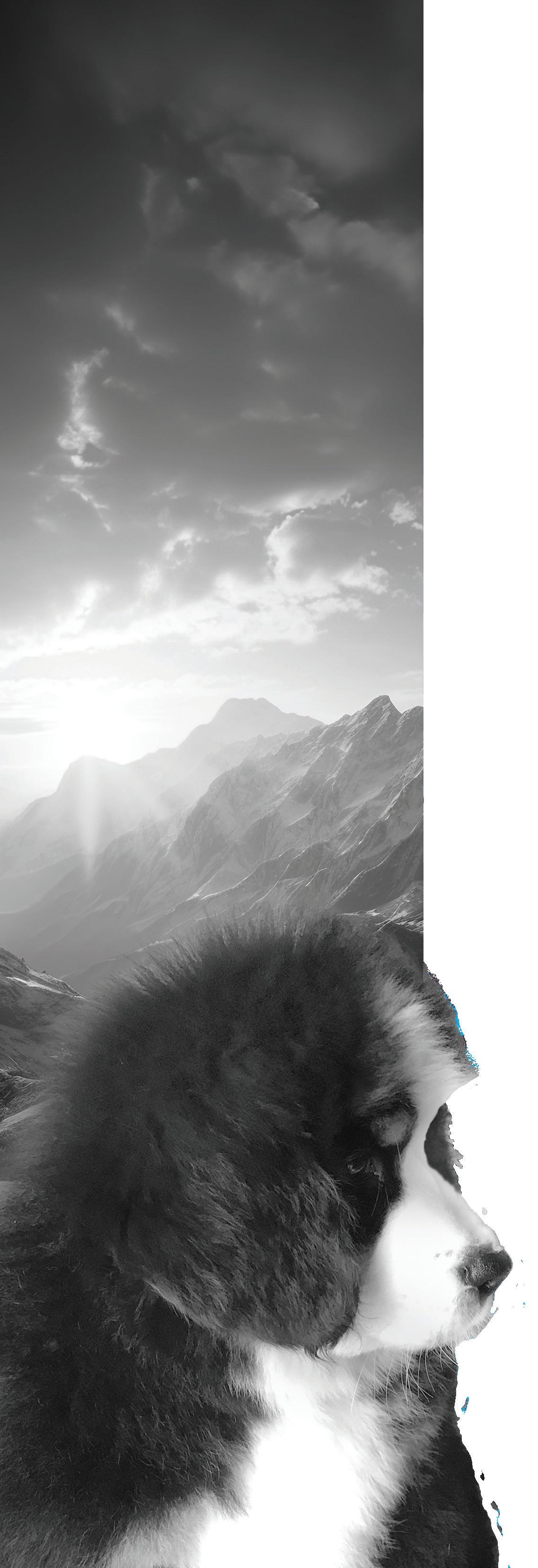
BERNESE MOUNTAIN DOGS
Multi Group Winning/Placing GCHS Swiss Stars Gun
Fight At The OK Corral SIN CGC
CH Lavender Hills No Place Like Home CD RN DCAT
NDD BMDCA Versatility Dog
GCH Jura’s American Beauty China Cat Sunflower
RI CD PT NJP OAP SWN SEA HRD-1 TKI FDC
RATN NDD AD VD WD
GCh Ch Nashems Diamond In The Ruff TKI FDC PT RE
HSAs CD SWN SIA SEA OAP XJP HRD-1s HTAD -1s
GCH CH Mamemo’s Moet CD RA HT AXP AJP NFP CGC
NDD ANBDD DD BDD
GCH CH Wagontale’s You Better Shape Up CD RN PT
FDC OJP CGC TKA BMDCA Grand Master Draft Dog,
BMDCA Working Dog BMDCA Versatility Dog Excellent
BIS MBISS GCHG Windfall Adesa 3 Wire Winter @
Emerald Mtn CD RN FDC NDD
MBISS GCHG Trailbound's Jumpin Jack Flash
April Rifenburg Starbourne Bernese
50th BMDCA National Specialty
Bernese Mountain Dog Club of Nashoba Valley
BMDCA Draft Tests Regional Specialty
The Lone Star BMD Club Draft Test
Piedmont BMDC and Blue Ridge BMDC Specialty Shows
Bernese Mountain Dog Club of Northeastern Illinois Events
North Coast Bernese Mountain Dog Club of Ohio
2024 Specialty
CLUB ADVERTISING AND MORE 1 2 3 3 3 17 19 115 116
12-13 71 77 81 92 94 101 ADVERTISER'S INDEX
BG# 205033. Photo by Dee McDuffee.
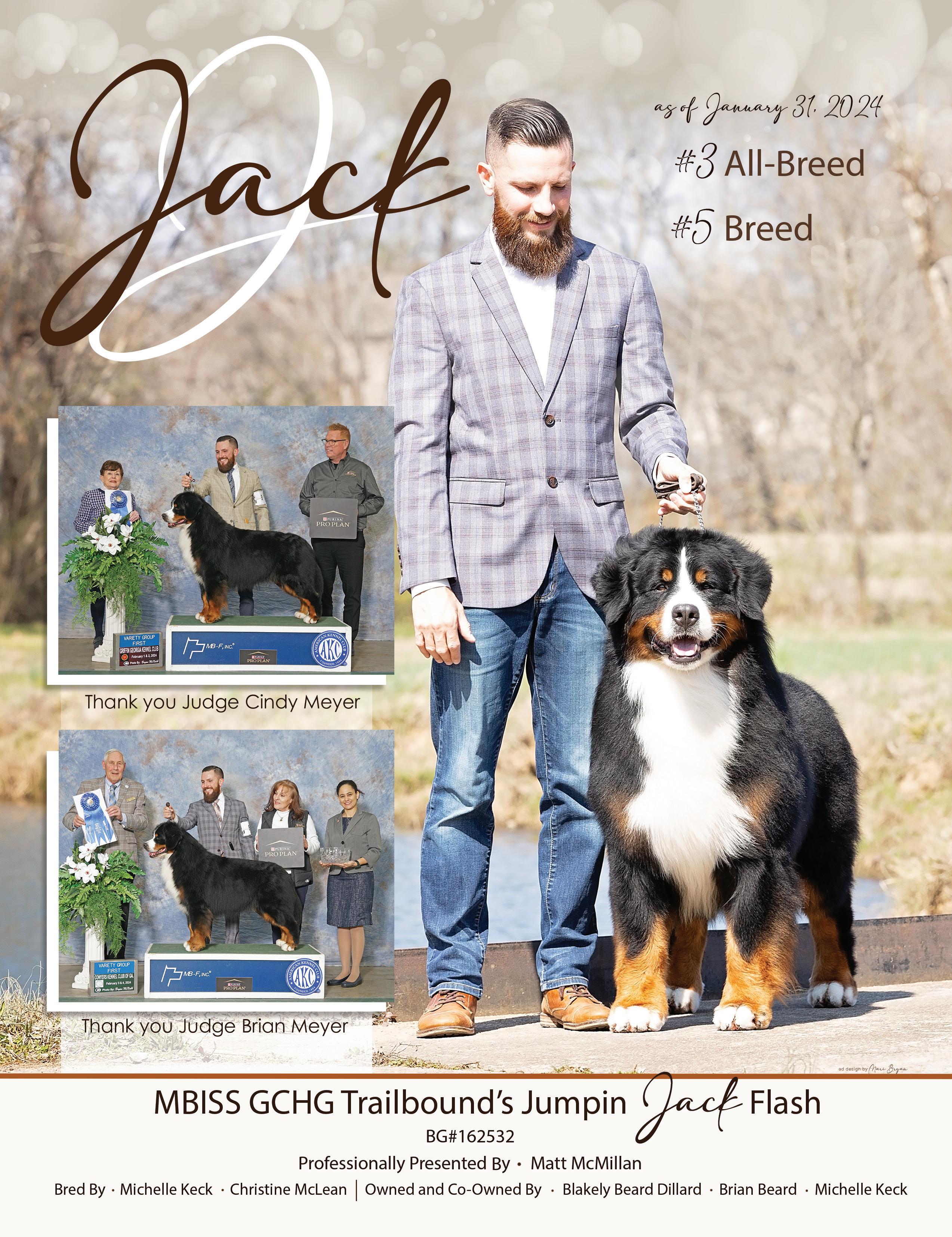
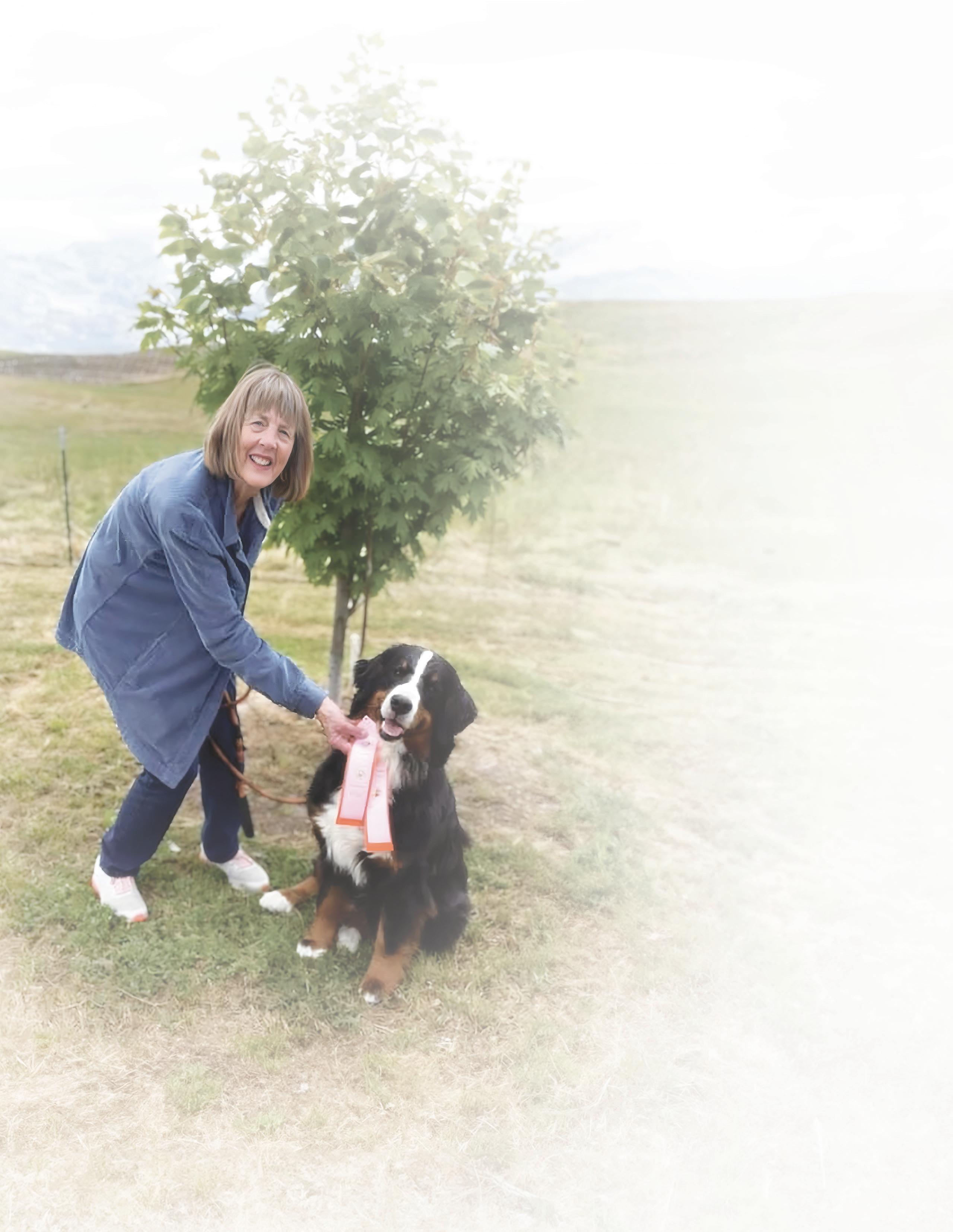
IN HONOR & MEMORY OF STARBOURNE BERNESE
April Rifenburg
BG#188218
DESIGNED BY MICHAEL PINEDA










 Addison with Astra (BG# 207344). Photo by Images by Kit.
Addison with Astra (BG# 207344). Photo by Images by Kit.


















 Francis (BG# 106343).
Photo by Laura Rose Humes.
Francis (BG# 106343).
Photo by Laura Rose Humes.







































 BY SUSAN HARRISON, PH.D.
BY SUSAN HARRISON, PH.D.







 BY ANNIE MCDANNOLD AND ANDREA BRACIKOWSKI, M.D.
BY ANNIE MCDANNOLD AND ANDREA BRACIKOWSKI, M.D.
































